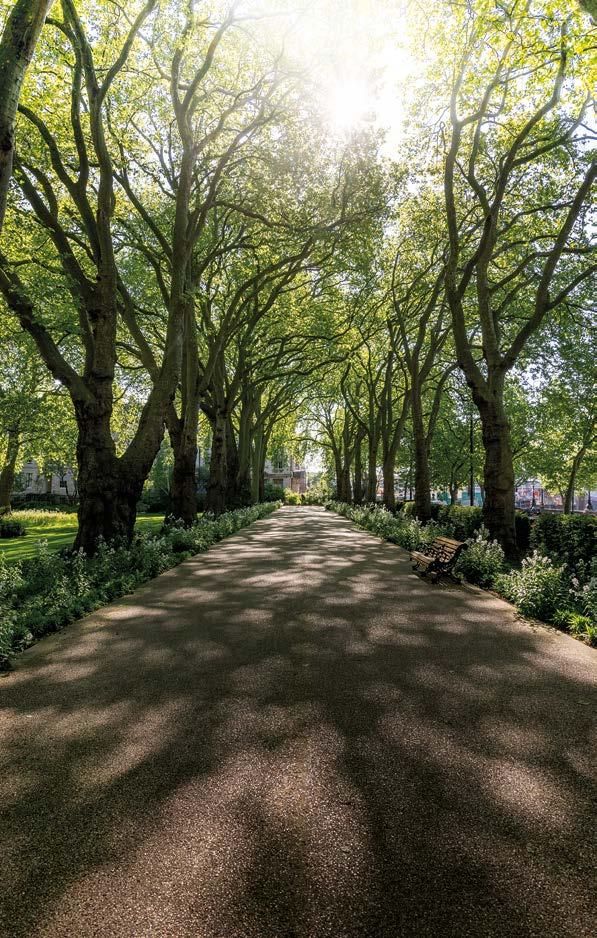 Sir Robert Francis KC
Sir Robert Francis KC
 Sir Robert Francis KC
Sir Robert Francis KC
YEARBOOK

“TheCHRISTOPH ESCHENBACH


Inner Temple Yearbook 2023–2024
Treasurer:
Sir Robert Francis KC
Reader:
The Hon Mr Justice Michael Soole
Reader Elect: Richard Salter KC
Sub-Treasurer:
Greg Dorey CVO
Treasury Office: Inner Temple, London EC4Y 7HL 020 7797 8250 yearbook@innertemple.org.uk innertemple.org.uk
Master of the Yearbook: Minka Braun
Editor: Lily Walker-Parr
Assistant Editor: Henrietta Amodio
Yearbook Managers: Nadia Ruiz
Desk Editors: Carolyn Dodds, Sandra Alvarez
Archivist: Celia Pilkington
Education & Training Editorial Team: Julia Armfield
Photographs:
Garlinda Birkbeck
Miranda Parry Photography
The Inner Temple photograph archive
Yearbook Design: Jon Ashby | Noun Ltd, 10 Kingshill Court, High Wycombe, Buckinghamshire HP13 5FN wearenoun.com
Brandworld Design: SomeOne, 67 Leonard Street, London EC2A 4QS someoneinlondon.com
Advertising:
HTDL Ltd htdl.co.uk
Printed by:
John Good Limited, Progress House, Butlers Leap, Rugby CV21 3RQ, johngood.com
FROM THE EDITOR



Welcome to the Inner Temple Yearbook 2023–2024.
I feel grateful and daunted in equal measure to take up the mantle from Emma Hynes as Editor of the Yearbook. After accepting the kind offer, I was told that it is customary to occupy the role for three years (although Emma managed four), so do forgive me any amateur slip-ups while I settle in.
This edition marks the end of a particularly busy year for the Inn, as all systems are go once again following the pandemic and completion of Project Pegasus. Members have returned to the Inn en masse to enjoy lunches and dinners in Hall, events and training in the new education facilities, and refreshments at the Pegasus Bar. Inner Temple has also welcomed a new LGBTQ+ Society, questioned the status quo in its popular ‘Social Context of the Law’ lecture series, and continues to attract new talent to the Bar through its extensive outreach work.
In reviewing this edition, I am reminded that our Inn is not only a tranquil and picturesque oasis in the heart of a bustling city, but also a professional home which remains a constant source of support and community for all its members. It is easy to forget the large network of skilled staff and volunteers who work hard to keep the Inn running, and it is to them that I wish to dedicate this issue.
My thanks also to all who have contributed to the 2023–24 Yearbook, particularly to Master Minka Braun, Henrietta Amodio, Nadia Ruiz and the wider editorial team.
I am excited to be able to contribute in a small way to this archive of the Inn’s activities and truly hope that you enjoy the read. Until next year,
Lily Walker-Parr 5RB


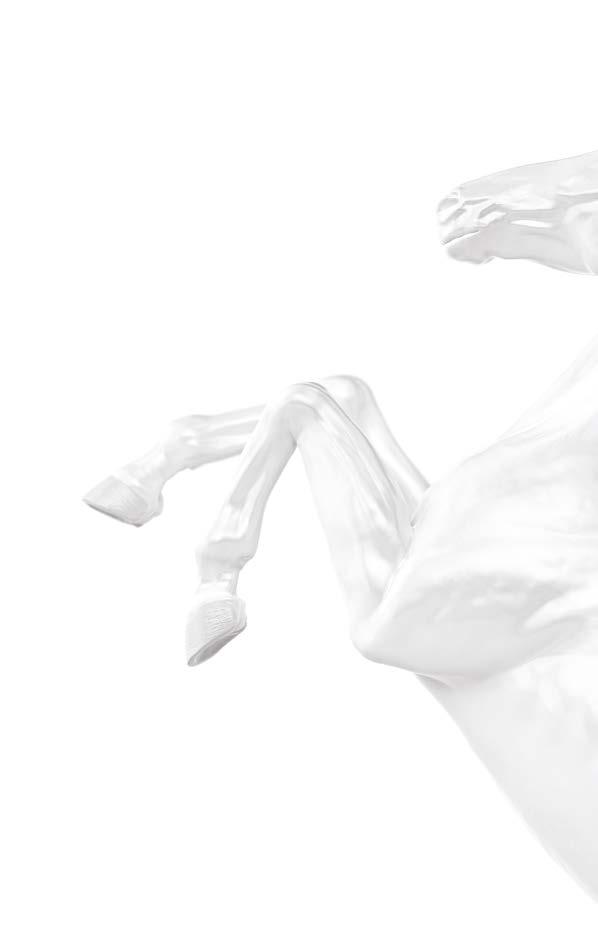








FROM THE TREASURER
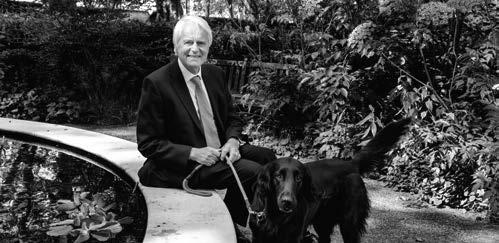
CALL TO THE BAR
I write this shortly after the Trinity Term Call Night, as always an inspiring occasion. 102 students were called to the Bar in the presence of over 300 enthusiastic supporters, at least a few of whom were probably too young to remember the event, all proudly witnessing a momentous event for them all. Their deafening ovation showed the wonderful support in emotions and resources that so many of our students enjoy. It was such a pleasure to meet parents, partners and friends afterwards and to share their joy and pride in their loved one’s achievement. And once again there were many members from countries outside the UK – 20 to be precise – among those called.
VISIT TO INDIA
We are a relatively small profession, but the Call ceremony reminded us of the esteem in which the Bar of England and Wales is held across the world and, associated with that, the rule of law as recognised and applied here. That was confirmed on our trip to India in February when we visited Delhi and Goa to meet senior legal professional and judicial leaders, and to attend the Commonwealth Law Conference. Visiting the Supreme Court of India and the Delhi High Court allowed us to appreciate the impact of the common law in the world’s largest democracy as well as the challenges and opportunities provided by its application in the context of a written constitution, and a society of such a wide range of political, religious and cultural perspectives. Likewise at the Commonwealth Law Conference we were able to renew old acquaintances and make new ones from across the member states. It was fascinating to hear the different perspectives on shared challenges, and the very different, sometimes alarming context in which some of our colleagues must work and need our support. I confess it was also enormous fun to meet so many talented, energetic and hospitable people! What were the messages I brought home? First, there is much we can learn from these visits. For example, the commitment in India to a technological revolution in the way litigation is conducted, under the inspirational leadership of the Chief Justice of India, Dhananjaya Y Chandrachud, from e-filing to live streaming of proceedings https://ecourts.gov.in/ecourts_ home. Second, there is significant interest in fostering
reciprocal arrangements for practising in each other’s jurisdictions. Thirdly, and not least, the Pegasus Scholarship scheme, among other initiatives, and contact with our members practising in their home jurisdictions encourage mutual support for the rule of law. Given the challenges to judicial independence, access to representation and professional freedom, mutual understanding and collaboration has never been more important.
TIMING OF CALL
Back home there is an increasing focus around what is now called the Timing of Call. Call to the Bar is but one stage in the arduous journey to entitlement to appear in the courts of England and Wales. In 2021/22 there were 2,178 students (of whom 980 were overseas students) on the Bar Course, a 45 per cent increase from 2017/18. The overall success rate on the Bar Course between 2011 and 2019 averaged 78 per cent. Because of the shortage of pupillages, and the desire of many candidates to practise in their home countries a large number of those who are called the Bar never go on to obtain a practising certificate. This means that currently there are 17,538 practising barristers registered with the Bar Standards Board and some 57,700 barristers who have no practising certificate but have been called to the Bar and are therefore subject to regulation by the BSB. Arguably this causes confusion for the public about what services a barrister can provide.
This has led to renewed discussion on the criteria for being called to the Bar. One argument is that only those who have completed pupillage should be entitled to be called, postponing the entitlement to describe oneself as a barrister to that point. Others argue that this, certainly on its own, will not solve the problems of allowing numbers to undergo the stress and expense of the Bar course massively in excess of the numbers who will end up in practice. The debate has been going on for at least 40 years but may well come to a head quite soon as the regulators have expressed interest in it. Therefore, all members in this country or elsewhere who care about the future of the profession should interest themselves in the discussions which will be taking place. The Inn, through the Executive Committee, with the help of a working group that has been set up will be considering the matter in depth during the rest of this year.
 Sir Robert Francis KC © Garlinda Birkbeck
Sir Robert Francis KC © Garlinda Birkbeck
THE LIFE OF THE INN
I have been fortunate to be Treasurer for the first full year of our being able to enjoy the facilities of the two new upper floors of the Treasury Building. All visitors have been unanimous in their praise for what they see. It is so rewarding to see how excellently the design has blended the new with the old, making the most of our history and our ambition and our drive to promote and support a profession which is responsive to the needs of our times. This has all undoubtedly enhanced the experience for people attending the many events that have taken place this year.
Highlights for me have included the Social Context of the Law seminars ably assembled by Master Geoffrey Nice, which have addressed the topics of refugees’ human rights, whether the country’s constitution can survive recent challenges, and whether the adversarial system is fit for purpose. It says much for the Inn’s standing that these events can attract participants of national and international standing, such as Professor Gillian Triggs, Assistant General Secretary of the United Nations, The Rt Hon Lord Bonomy LLD, former justice of the Supreme Court Scotland, and of the International Criminal Tribunal for the Former Yugoslavia, and Professor Sir John Curtice FRSA FRSE FBA, well known predictor of our election results, to name but a few. The Inn’s societies have been busy, too, with a particular favourite of mine being the talk organised by the LGBTQ+ Society and given by Master Kirby (Mr Justice Michael Kirby AC CMG, formerly of the High Court of Australia) strikingly titled Sodomy Law: the UK’s Persisting Legacy and the Great Quandary. All these events showed how successful our new and comfortable lecture theatre is as a venue, and how we now reach a wide, even international audience through live streaming some events. An honourable mention is also due to the tremendous efforts of the Drama and Debating Societies and the impressive performances of so many students.
Finally, it has been great fun to meet our members on Circuit at the various dinners arranged in collaboration with the Masters of the Circuits. I value these occasions as great opportunities to learn about circuit life and what the Inn can do the support them.
The social life of the Inn has returned to full speed. All our dinners, receptions and other events have been oversubscribed and shown off the great skills of our wonderful catering team for whom no demand is too difficult. The Garden has been a constant source of pleasure to me and many others with the partial ‘rewilding’ producing new and attractive surroundings for birds and insects – as well as humans and the occasional dog! The Garden Party was enjoyed by all, even if the Handel theme turned out to involve more water from a downpour than we had bargained for!
EDUCATION AND TRAINING
The Inn has continued to perform outstandingly in the duty imposed on us by James I of educating and training our members, old and new. As was the core purpose of the Pegasus Project we have been hosting ICCA sessions and students as and when required and we and they can be justly proud of their hugely impressive results. The success rate for ICCA students is spectacular: of those sitting the exam in April this year, 91 per cent of ICCA candidates sitting the criminal law exam for the first time passed (average for all providers 69 per cent) with 84 per cent against an average of 62.4 per cent for the civil paper.
I must make a special mention of the contribution the Library continues to make to the work of all our members. It remains a marvellously tranquil and welcoming place in which to study and I have been pleased to note that the numbers using it have markedly increased since before the redevelopment of the Treasury Building. The advice and online services make its learning readily accessible to everyone.
Our volunteer advocacy trainers have provided sterling service at advocacy weekends in and outside the Inn, all the while continuing to insist on the highest standards for themselves. Yet again our volunteer scholarship interviewers have performed wonders in interviewing all scholarship candidates. This year we interviewed 337 candidates for Bar Scholarships and awarded 120 scholarships. In addition to the actual interviews all volunteers were asked to undertake EDI training. This tremendous effort demonstrates the immense commitment we share to increase social mobility, inclusion and diversity at the Bar.
THE FUTURE
So, what does the future hold? On a parochial level I look forward to supporting the Inn’s work with students, pupils, newly qualified barristers and established practitioners. The increased range of activities mean we will need as many volunteers as possible. If you have not thought of contributing to the Inn in this way before, now is the time to do so – you are needed! I also look forward to promoting our links with the Caribbean and the US on our visit to Trinidad, Barbados and Washington in October, to fill some of the gap left by the forced cancellation of Master Deborah Taylor’s tour last year following the death of Her Majesty the Late Queen Elizabeth II.
As an Inn we are aware there are many challenges ahead. Following the pandemic, it is no secret that many barristers’ working patterns have changed and with that comes a need to look at whether the professional accommodation we provide meets their needs The requirements of chambers who spend more time working from home will be different. The greater appreciation of the access needs of some of our colleagues will cause us to look again at what can be done to meet them. We have begun a dialogue with the City of London planning authorities to explore possibilities for enhancing access to listed buildings on our estate.
I have already mentioned the issue of the timing of Call. I anticipate this may lead to a wider discussion about access to the profession and what we can do to enhance it. If we do not find ways of achieving that for ourselves we may find solutions are imposed on us.
Finally we live in times in which the value of the rule of law in a democratic society, and of lawyers’ place in that, is increasingly questioned both in this country and overseas. We should all regard it as a professional duty to explain to all who will listen, and even more so those who do not, why what we as a profession do is so important in the interests of society as a whole.
THANKS
None of what I have described nor the many activities that I have not would be possible without the dedicated and loyal work of our staff under the leadership of Greg, Henrietta, Richard, David, Gail, Rob, Pete, Sean, Vicky and Bob, with special thanks to Jennie and Wanda without whom nothing on the Treasurer’s (and I suspect Sub-Treasurer’s) diary would ever be attended to!
It remains a great privilege to be your Treasurer and I am looking forward to seeing as many as possible of you during the rest of the year. My only regret is that it is going so quickly!
Sir Robert Francis KC Master Treasurer
NBJ are proud to have delivered the complex specialist joinery package for Project Pegasus, providing high quality woodwork to the Inner Temple library, learning and training facilities for generations to come.



The Inn’s two equally stunning rooms, the Boswell and Chaucer, are available every day and are located on the third floor of 3 Dr Johnson’s Buildings which was built in 1858 by the architect Sydney Smirke.
Whether you are in town for business or pleasure, our accommodation, along with the Pegasus Bar which is open Monday-Friday, o ers respite from a long day of meetings or sightseeing.
Choose from the four-poster luxury of the Chaucer or the more modern Boswell with views overlooking Temple Church.
020 7797 8230 | venuehire@innertemple.org.uk | innertemplevenuehire.co.uk
per room per night
MEMBERSHIP OF THE INNER TEMPLE


The Honourable Society of the Inner Temple is proud of its history as a professional and collegiate community and its core purpose of providing education for students, pupils and established barristers.

MEMBERSHIP BENEFITS:
Subsidised training in a state of the art lecture theatre and modern training rooms
Use of the Inn’s Library and reciprocal arrangement with the other Inn’s Libraries
Access to the Inn’s subsidised collegiate and networking events
Access to lectures eg Reader’s Lectures and Social Context of the Law
Access to the Inn’s professional societies eg History Society, LGBTQ+ Society, Inns of Court Alliance for Women, Employed Bar Forum
Eligibility for Pegasus Scholarships (up to five years in practice)
Eligibility for the Paris Bar Exchange (up to seven years in practice)
Subscription to the digital quarterly newsletter – Innerview
Subscription to the Yearbook
Member discount on hire of the Inn’s rooms for private events

Sponsored discount on hire of the Inn’s rooms for legally related events
Subsidised lunch in Hall from Monday – Friday during term time
Student discount of 20 per cent off lunch in Hall (excluding drinks)
Student discount of 20 per cent off food in the Pegasus Bar (excluding drinks)
Use of the Inn’s Garden (subject to terms & conditions)
Use of the Inn’s Car Park (subject to terms & conditions)
Eligibility to marry in the Temple Church
Access to the Inns of Court Societies: Bar Lawn Tennis, Bar Golfing Society, Bar Choral Society
Access to discounts at the Smithfield
Nursery and Tiny Tree Day Nursery
Access to members’ overnight accommodation booking portal
For further details: innertemple.org.uk/members
 Lecture Theatre © James Brittain
Hall © James Brittain Library © James Brittain
Lecture Theatre © James Brittain
Hall © James Brittain Library © James Brittain

WE’RE GOING WHERE THE SUN SHINES BRIGHTLY…
SO WHY DO TREASURERS AND THE SUB-TREASURER TRAVEL ABROAD EVERY YEAR ON BEHALF OF THE INN?
By the Sub-Treasurer Deborah
Deborah
In my time Treasurers have visited Singapore and Washington in 2018; Mauritius, Malaysia, Singapore and Washington in 2019; Washington in 2022; and Delhi and Goa (the latter for a Commonwealth Lawyers Conference) in 2023, with a visit to Barbados; Trinidad and Tobago; and Washington still to come at the time of writing The international programme was disrupted by the pandemic and last year a joint Amity Visit with Gray’s Inn to the US and an Inner Temple visit to four Caribbean countries were cancelled because of the sad death of Her Majesty The Late Queen two days before we were due to set out. In the past there have been visits to even more exotic locations.
These visits are not based on the random wishes of successive Treasurers The equivalent of a ‘business case’ is prepared when deciding where a Treasurer might visit This is carefully considered by the International Committee, at least since 2017 when it was established, who might endorse it but might equally suggest an alternative itinerary, which they believe might be of more practical benefit to the Inn. Affordability is an issue too, of course, and the Finance Sub-Committee also play a role when determining the international budget for the following year

Supreme Court of India 2023
How do we select where Treasurers should visit? The whereabouts of Inner Temple members, alumni for want of a better word, is one criterion. Nationality is not the same as current location and sadly not all our members stay in touch or update us on changes of address. But broadly, by location, our top ten countries are Malaysia, Singapore, Ireland, India, the USA, Mauritius, Pakistan, Australia, the Bahamas and Bangladesh. In some jurisdictions we have Overseas, Honorary and Academic Masters of the Bench in very senior positions. In Malaysia, Singapore and Mauritius we have very active alumni associations in place and there is a longstanding history of useful two-way visits with the American Inns of Court (our visits to Washington are usually in the context of attending their annual Celebration of Excellence at the US Supreme Court, which is a valuable networking opportunity).
In some jurisdictions we have Overseas, Honorary and Academic Masters of the Bench in very senior positions.
 Master
Taylor, Emilia Clegg, Sub-Treasurer at AIC 2022
Master
Taylor, Emilia Clegg, Sub-Treasurer at AIC 2022

But alongside keeping in touch with our alumni, these visits are also about making new contacts; telling them about the role of the Inns of Court; and discussing with them issues such as the rule of law, ethical legal practice or judicial independence. This is never a question of preaching, but always about exchanging best practice. In some areas we may feel we are thought leaders, but in others we have much to learn from what is happening in other jurisdictions – such as impressive technological advancements in the Indian courts. In some locations our Treasurers give speeches or presentations to students or other audiences. For example, in 2019, Master Anthony Hughes gave several speeches on making the rule of law a daily reality and our current Treasurer spoke about assisted dying and building a healthy nation earlier this year. Sometimes the visits tie in with incoming visits to Inner Temple from overseas jurisdictions.
This is never a question of preaching, but always about exchanging best practice. In some areas we may feel we are thought leaders, but in others we have much to learn from what is happening in other jurisdictions.


These visits are opportunities too to market Inner Temple as a venue in London for events that overseas jurisdictions might be contemplating; to promote UK legal products, lawyers and the use of London as a location for legal transactions; as well as to supplement the work of the Bar Council and – as appropriate – the Law Society in making the case for opening up the global legal services market. We are not primarily recruiting students, but where a talented international student is considering a career at the Bar of England and Wales it may be possible to offer relevant advice. And we can provide information (which is regularly sought from us) about how qualified foreign lawyers can practise at the Bar of England and Wales, either by transferring or by applying for temporary Call to act in specific cases in England and Wales. Treasurers can often also identify suitable candidates to become Overseas, Honorary or Academic Benchers on such visits or detect suitable opportunities to consider advocacy or other forms of training. We can advertise initiatives such as The Inner Temple Triennial Book Prize, which is steadily gaining international prominence. And when it comes to a big global initiative, such as the 800th anniversary of Magna Carta in 2015, it is no use starting preparations at the last minute – the contacts to make things happen must be in place well in advance.
We are now regularly reporting on Treasurers’ overseas visits, so we have a permanent record of itineraries, what has been achieved, who has been met, and so on. This gives the International and Executive Committees an opportunity to evaluate the visits and determine what works well and what does not. The visits can be quite hard work – the schedules are often packed and the logistics demanding: the overall exercise is often very tiring. They can also be fascinating glimpses into how legal business is done elsewhere, as well as an opportunity to connect with the Inn’s members overseas. But Treasurers do not take these visits on for their entertainment value!
Greg Dorey CVO Sub-Treasurer
 Master Treasurer at the Delhi High Court 2023
Master Elizabeth Gloster on a panel at AIC 2018
Master Treasurer at the Hingorani Foundation Event 2023
Master Treasurer at the Delhi High Court 2023
Master Elizabeth Gloster on a panel at AIC 2018
Master Treasurer at the Hingorani Foundation Event 2023
THE SOCIAL CONTEXT OF THE LAW: IS IT BETTER TO REVIEW OR MONITOR TERROR LAWS? THE UK
AND AUSTRALIAN POSITIONS COMPARED
From a Social Context of the Law discussion held on 20 November 2022 between Jonathan Hall KC and Dr James Renwick AM CSC SC, moderated by Master Rory Phillips

Rory Phillips KC: Welcome to the latest in our Social Context of the Law series. Today, our topic is terrorism, or to be more precise, the legislation that states have introduced to deal with terrorism in its various manifestations. And sharpening our focus further, we’re going to concentrate on two democratic states with much in common, including shared history and values, but with distinct cultures and constitutional arrangements, namely the United Kingdom and Australia. Both states have, of course, had to confront the problem of terrorism, domestically and internationally, and both have turned to the independent Bar to undertake the scrutiny of existing or proposed legislation in this field. However, their approaches have been different, such differences extending, as we’ll hear, considerably beyond the language used to describe the two roles: Reviewer in the UK, Monitor in Australia.
This evening we’re very fortunate to have with us both a distinguished former occupant of the Australian position of Independent National Security Legislation Monitor, Professor James Renwick, and also the current Independent Reviewer of Terrorism Legislation in this country, Jonathan Hall KC.

Let me give them both the very briefest of introductions. James Renwick is on record as wanting first to be a poet. However, he took his father’s advice and turned to law. After working in government, he was called to the Bar in 1996 and developed a wide-ranging practice in constitutional, administrative, and commercial law. He became senior counsel in 2011, he has a doctorate in constitutional law from Sydney University, and since 2012 has been adjunct professor at the Australian National University in Canberra. He became Australia’s third Independent National Security Legislation Monitor in 2017, and served until 2020, issuing a number of reports on a wide range of topics during his tenure. I should add that he is a long-time naval reservist, and in 2019, was awarded the Conspicuous Service Cross.
Jonathan Hall was called to the Bar in 1994, took silk in 2014 and is a member of 6KBW College Hill. And like many able criminal practitioners, he has expanded his practice into the fields of public, and specifically national security, law. He was first appointed as the UK’s Independent Reviewer in 2019 and was reappointed earlier this year. He has published reports, articles, and responses on a wide variety of issues in addition to his annual reports – his most recent response being to the public consultation on the vexed topic of non-jury trials in Northern Ireland.

Jonathan Hall KC: I’m bound to say I approached this topic with neuralgic sensitivity, because as James Renwick will no doubt quickly and very justly point out, perhaps by reference to the unlawful prorogation of parliament under Boris Johnson, or the quick turnover of recent governments, that relying on convention and practice is rarely enough. And what he would be referring to is the difference between our roles, and certainly a difference that is important to lawyers. When he was the Reviewer, James not only had staff and premises, but he had a whole statute, the Independent National Security Legislation Monitor Act 2010, which defines his job and gave him powers to carry it out. The position here is very different.
A single section of the Terrorism Act 2006 requires the government to appoint a person who must deliver an annual report for eventual submission to parliament, and that’s it. So, the effectiveness of the Reviewer in the UK depends upon past practice and convention, and the relationship that each Reviewer has with the government, the police, parliament, the public, the media, and so on. The truth is that if I asked for secret information relevant to my job, and the government or the police refused to let me see it, I could not invoke a statutory power to compel them to do that. That is something that James could have done – I don’t know whether he ever had to do it, but he certainly had that arrow in his quiver.
The effectiveness of the Reviewer in the UK depends upon past practice and convention, and the relationship that each Reviewer has with the government, the police, parliament, the public, the media, and so on.
By contrast, I could only invoke the role itself, as it has become defined by Reviewers of the stature of Lord Carlile, who took the role on after 2000, Lord Anderson, and Max Hill, now the Director of Public Prosecutions (DPP). And I could say to the government: “Has it come to this? And how do you think parliament, or the media would respond if they found out that you were keeping things back from the terrorism Reviewer?” I haven’t had any problems, but that would be what I would have to fall back on.
I’ve mentioned the media twice now, and deliberately so. Having less formality, the UK Reviewer has been free to develop his/her role. When the first terrorism attack took place after my appointment in 2019, I remember requests for radio interviews coming in from the Radio 4 Today programme, and David Anderson texting me to say, “Over to you.” And it has become an outward-facing role. Very different from Australia. When I was appointed, I picked up the 3,000 or so Twitter followers that Max Hill had attracted since he took over from David, and like them I tweet about terrorism. That’s how Rory, I suspect, knows about what I said last week about non-jury trials. Very different from Australia.
In 2020, the government started to promote a series of counterterrorism Bills on terrorist offenders in prison and on release. And I was being asked for my views behind the scenes, but I thought: “If I have got views on legislation going through parliament, why not publish some of those views?” So, I’ve started the practice of publishing notes on counterterrorism legislation on my website, advertised via Twitter, and these are very frequently picked up and cited in parliamentary debates. Again, very different, I think, from Australia. Indeed, there’s no piece of counterterrorism legislation on the statute books, or counterterrorism Bill that’s currently presented to parliament, where an MP, or a Peer, or a parliamentary committee, or a journalist, or an NGO, or a member of the public, cannot in principle contact me and get, hopefully, an informed and certainly independent view. Of course, I’m not saying the UK system is perfect, and it wouldn’t be for everyone. Fundamentally, in the UK, it comes down to a simple duty to do an annual review of the terrorism Acts. This brings a sort of completeness in having to compile a 200-page document every year on how terrorism laws operate.
By contrast, I’ve noticed that the first Australian Monitor, Brett Walker SC, did lay down a comprehensive analysis of some of the more contentious Australian counterterrorism powers in his first annual report, and believe me, there were a lot. In 2019, researchers calculated that between 2002 and 2007 in Australia, a new counterterrorism law was passed every six or seven weeks. But since then, the annual reports of the Australian Monitor have shrunk to about 20 to 30 pages, not including annexes, setting out more or less what the Monitor has done in that year. In fact, over the last few years, it seems to me that the real function of the Australian Monitor is to produce reviews that are focused on particular topics. And I think that observation is consistent with the analysis by the academic Jessie Blackburn, who has written extensively about our respective roles.
So, the glory of James’s very distinguished three-year term was his review of the Telecommunications and Other Legislation Amendment (Assistance and Access) Act 2018. This was an Act that underpins their ability to do the spookier end of telecommunications spy work. It was an Act that, even when it was passed by the Australian Parliament, was known to be unsatisfactory because of a lack of parliamentary scrutiny, and it was passed to James to review after its enactment by this powerful intelligence committee. It’s a brilliant report, and I could also point out James’ fantastic review of sentencing of child terrorist offenders, or of citizenship loss, but there was, on his watch, no review of the whole landscape of terrorism legislation. So, I’ll end my remarks with a general comment and a mischievous comment.
The general comment is that the UK Reviewer, my role, is able to speak publicly and independently about terrorism generally, to inform the debate generally, and to inform debate specifically when bills are before parliament, whereas the Australian Monitor has more formal powers, but a narrower output. The mischievous comment, and this is where I’ll end, is that the Australian Monitor role may even have an adverse effect on Australian counterterrorism legislation, because the Australian Parliament knows that, after it is enacted, un-thought-through legislation, it could in principle, ask the Australian Monitor to pick up the pieces.

Dr James Renwick SC: Let me answer the question posed in the debate immediately. It is better to monitor than it is to review. It’s good to review, but it’s important to do both, not least because of the support each role gives to the other. So, may I immediately acknowledge with thanks the remarkable quartet of Reviewers, three of whom are here tonight, that you’ve had since 2001. Before coming to four key differences between the roles, all where I think we might have the edge, can I give you a couple of bits of context you may not be aware of, and one of them is that in Australia, it’s almost a pastime to see a problem and pass a law.
It is better to monitor than it is to
review. It’s good to review, but it’s important to do both, not least because of the support each role gives to the other.
Since 9/11, we have passed over 130 counterterrorism and national security laws. I read with wry amusement what Lord Justice Haddon-Cave said last year that English law has become increasingly complex, unclear, and inaccessible. And then I looked at the figures: 50 to 70 statutes a year, admittedly some quite long, enacted in Britain. In Australia, we last passed about 70 laws in 1955. In recent years, we generally present over 200, sometimes up to 250 bills, and enact more than 150. So that’s one important difference, and it’s relevant to the question of whether you comment on bills.
Another substantive difference is that when you have a terrorist act which results in death, you punish it or you prosecute it as murder, whereas we prosecute it as terrorism. On the threat of terrorism, I agree there’s a risk of overstating it, but I think one thing we have in common is neither the Reviewer nor Monitor have ever been guilty of that. Whether you take radical Islamist terrorism, or the strange collection of people who make up extreme right-wing terrorist groups, they are not an existential threat to either nation. Whereas espionage and foreign interference are increasing threats to our nations. Of course, I’m not downplaying the horror of terrorism.
Coming then to the strengths of the Monitor role over that of the Reviewer. And I call in aid here the view of the French philosopher who once said, “Yes, yes, I know it works in practice, but the question is, does it work in principle?” It seems to me there are four advantages the Monitors have over the Reviewers.
The first, and critically, is: Monitors have public hearings and Reviewers don’t. And so, very simply, the format was you would announce an inquiry, you would invite submissions, and then you would quiz the agencies in a confidential session. The other thing, for those of you here who are interested in persuasion, and public policy, is the language of criticism. When I did a public hearing, I would set out my tentative views and say something like: “I’m inclined to think that the law does or doesn’t pass muster by reference to the statutory tests of proportionality, necessity, and proper protection of human rights.” And by using that not-soconfrontational language, I felt that was more effective.
The second advantage is not commenting on bills. You can see by the number of bills that if I and my predecessors had spent our time commenting on bills, we would have got nothing else done. And that’s just a function of how many are passed. The second point of practicality is the time between when a bill was introduced, and when it became law, has ever decreased over time. The Bali bombing in 2002: 88 Australians killed out of 200. It took six to nine months to
pass through the legislative process. After the Christchurch attacks in more recent years – an Australian terrorist attacking people in mosques – we passed a law within a week, outlawing live streaming of terrorist attacks. And so, as a practical matter, even if the Monitor wanted to get involved in commenting on bills, you’d simply be run over.
Two other points: the power to obtain relevant material. I do think this is important, and it’s not just a matter of convention. Now, it is true I only once had a problem with an agency head who I thought was getting a little bit overenthusiastic and suggesting he wouldn’t give me what I was entitled to. So, I said to him, “If what you’re saying is you want the comfort of a subpoena, I’m happy to give you one. Is that what you would like?” And he said, “Oh, we always comply with the law!” And I said, “Of course!”
So, it is actually useful to have those powers, and a good test is what the Republic of Ireland are looking at the minute. They’re proposing to set up an Examiner. I put in a submission saying I thought it was really important they had statutory powers. I think the current version of the Bill suggests the intelligence agencies in the Republic of Ireland could refuse to give the Examiner material. I think that’s a fundamental flaw, if that were to go forward. And it just seems to me that – and this is the point about convention – conventions sometimes do break down when you most need them.
And the fourth and final point is this: under the Monitor Act, the government had an obligation to publish, or to table in parliament, the public report. I could also do a secret report, which I did on a couple of occasions. But the public report had to be tabled within 14 days. A report was done. It was in the public debate. It got things moving. Here, as I understand the practice, the government tends to withhold the tabling of the report until it has also come up with its response. And it just seems to me there is a risk that that involves pulling the teeth out of the report. So, it seems to me, that as David (Lord Anderson of Ipswich KC) said, respected independent regulators continue to play a vital and distinguished role, that in an age where trust depends on verification rather than reputation, trust by proxy isn’t enough. Hence the importance of clear law, fair procedures, rights compliance, and transparency. Exactly, I would say, and at least until that is done, it is better to monitor than review.
Respected independent regulators continue to play a vital and distinguished role, that in an age where trust depends on verification rather than reputation, trust by proxy isn’t enough. Hence the importance of clear law, fair procedures, rights compliance, and transparency.
Jonathan Hall KC 6KBW
Independent Reviewer of Terrorism Legislation
Dr James Renwick AM CSC SC
Former Independent National Security Legislation Monitor of Australia, Honorary Professor of Law at the Australian National University
Rory Phillips KC 3VB Master of the Bench
For the full video recording: innertemple.org.uk/terrorlaws
Picture your event here!
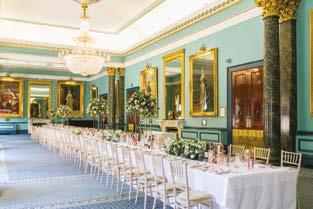


SEARCYS VENUE COLLECTION
A business event or a celebration, a get-together or a birthday party, a meeting or a private dinner. Since 1847.
SPEAK TO SEARCYS EVENTS TEAM 020 7101 0220 | EXCLUSIVE.EVENTS@SEARCYS.CO.UK

SEARCYS GIFTS
Perfect for any occasion – from dining and afternoon tea experiences, to Searcys Champagne and English Sparkling Wine and signature tea sets.
THE INNER TEMPLE LGBTQ+ SOCIETY


The Inner Temple LGBTQ+ Society has been established with the principal objective of encouraging visibility and facilitating an inclusive social environment for the Inn’s LGBTQ+ members and allies. The Society itself is a self-sustaining, membership-led initiative and will seek to arrange a limited number of events and networking activities each year.
Membership of the Society is open to all members of the Inn, including students, and staff, of any sexual orientation, gender identity, gender expression or any other characteristic.
The Society is overseen by Master Jeremy Richardson (His Honour Judge Jeremy Richardson KC), Recorder of Sheffield and member of the Equality, Diversity and Inclusivity Sub-Committee.

The Society’s Officers for 2023 are:
PRESIDENT:
Dr S Chelvan
33 Bedford Row, Call 1999
LIBRARIAN:
Master Craig Hassall Park Square Barristers, Call 1999
TREASURER:
Cameron Stocks
Gatehouse Chambers, Call 2015
SECRETARY:
Ife Kubler-Agyemang Doughty Street Chambers, Call 2018
STUDENT AND PUPIL LIAISON OFFICER: Mohamed Hussein Iman Student member
LGBTQ+ dinner September 2022Membership of the Society is open to all members of the Inn, including students, and staff, of any sexual orientation, gender identity, gender expression or any other characteristic.


For more information and to register as a member of the LGBTQ+ Society: innertemple.typeform.com/lgbtqsociety
 The Joint Inner and Middle Temple LGBTGQ+ reception on 22 June 2023
Master Jeremy Richardson speaking at the LGBTQ+ dinner in September 2022
The Joint Inner and Middle Temple LGBTGQ+ reception on 22 June 2023
Master Jeremy Richardson speaking at the LGBTQ+ dinner in September 2022
AAN ELIZABETHAN MYSTERY: THE LEVER CANON LAW MANUSCRIPT AT INNER TEMPLE
By Master Norman DoeYou might be familiar with modern mystery novels set in Tudor England – such as CJ Sansom’s series featuring Matthew Shardlake of Lincoln’s Inn; SJ Parris’ blockbusters with Giordano Bruno and Queen Elizabeth’s spy-ring; and then Edward Marston’s Nicholas Bracewell, theatre manager in Elizabethan London.
We have our own Elizabethan mystery at Inner Temple Library: a manuscript on the canon and ecclesiastical law of the Church of England, which regulated so much of people’s lives from baptism to burial, from marriage to wills. The title in the manuscript is: The assertions of Ralph Lever touching the canon law. Lever was born c. 1530 and died in 1585. These 55 years are crucial in the evolution of English ecclesiastical law. It was the hot topic. Under Henry VIII, parliament enacted statutes: to terminate the papal jurisdiction in England; to withdraw England from the European continental Church of Rome; to establish the Church of England as an independent national church; and to assert the royal supremacy in matters ecclesiastical. It was the Brexit of its day.
However – and Brexit legislation mirrored this – to fill the legal vacuum left by the demise of Rome, the Submission of the Clergy Act 1533 allowed the pre-existing Roman canon law to continue to apply to the new English Church (if not repugnant to the laws of the realm) and until reviewed by a royal commission.
No commission was appointed. Parliament provided for a review in 1535, 1543, and 1549; and by 1553, a commission had compiled a new code – the Reformatio Legum Ecclesiasticarum; but the project lapsed with the return of England to Rome under Mary I. The draft code was resurrected when the Church was re-established under Elizabeth I and published in 1571, but parliament rejected it. The 1533 Act, revived on Elizabeth’s accession, also provided for the clergy Convocations of Canterbury and York to make law, with royal assent, in the form of canons. But it wasn’t until 1603/4 that Convocations made a new code of canons approved by James I – hardy things – they were not revised till the 1960s.
Also, in 1563, Convocation endorsed the Thirty-Nine Articles of Religion, and as the years unfolded parliament enacted many anti-Roman Catholic laws. The new Elizabethan church settlement was summed up famously by Richard Hooker (Master of the Temple in the 1580s) in his Laws of Ecclesiastical Polity

These landmarks provide the legal setting for our Inner Temple manuscript. Ralph Lever was born in Lancashire, the fifth of seven sons. After Eton, like three of his brothers, he entered St John’s College, Cambridge: BA 1548 and, after becoming a fellow 1549, MA in 1551. A Protestant reformer, he was exiled under Mary. On return, he resumed his fellowship and later married.
Lever had wide interests. In 1563, he wrote a book about a board game “for the honest recreation of students and other sober persons in passing the tediousness of time to the release of their labours and exercise of their wits”. He wrote another in 1573 – The Art of Reason, Rightly Termed Witcraft: “a perfect way to argue and dispute” on Aristotelian lines; it is one of the earliest books on logic in English.
He wrote another in 1573 –
The Art of Reason, Rightly Termed Witcraft: “a perfect way to argue and dispute” on Aristotelian lines; it is one of the earliest books on logic in English.
A colleague at St John’s (its master) was James Pilkington, also a Lancastrian, a reformer in exile, and Bishop of Durham from 1561. He appointed Lever as his chaplain, Rector of Washington, Archdeacon of Northumberland, and Prebend at Durham Cathedral. In 1572, Lever challenged the latter’s episcopal visitation articles, was summoned to court, but resigned as archdeacon to avoid censure.
A commissary on Pilkington’s death, in 1577 Lever is at loggerheads with the dean and chapter over leases. He resigns his offices to be Master of Sherburn Hospital. Founded by the Bishop of Durham 1181 for leper monks, and rebuilt as alms-houses, Lever secured an Act of Parliament 1585 to: incorporate the hospital; allow the bishop to make rules for it and appoint its master; and oblige the master to nominate the brethren who took an oath to obey the bishop’s rules.
In 1583, Lever also sought reform of the cathedral statutes at Durham that, according to him, were “defective in sundry points touching religion and government”. But the dean and chapter were hostile, and Lever died in 1585 before his new scheme was considered. He was buried in the cathedral.
Alongside trying to reform Durham cathedral statutes, and securing the Act of Parliament for Sherburn Hospital, it would not be surprising if Lever turned his attention to the national ecclesiastical law. Hence the tract, full title: The assertions of Ralph Lever touching the canon law, the English papists and the ecclesiastical officers of this realm, with his most humble petition to her majesty for redress. The Inner Temple text is among its Petyt manuscripts bequeathed to the Inn in 1707 by William Petyt, Keeper of the Records in the Tower of London, Treasurer here 1701–02, and buried at the Temple Church. But the collection gives no date for the tract, though the dates of neighbouring manuscripts in the volume – also on church affairs – range from 1573 to 1580. The text is not signed by Lever, so we assume it is a copy, copyist unknown.
Questions arise about the date and authorship of the tract. Conway Davies’ catalogue of Inner Temple manuscripts (published 1972) lists the tract but is silent as to date. Davies (a Welsh historian from Llanelli) made notes on the Petyt manuscripts, now among his papers at the National Library of Wales. The notes to the Lever tract are the same as those published in his 1972 catalogue – except that he has ‘nd’, presumably for ‘no date’, which does not appear in his published catalogue. The Bodleian Library did a full search of all their online and published catalogues, but this has not traced any reference to a manuscript matching Lever’s; Cambridge University Library did the same – again, no trace.
Beyond these catalogues, scholars have dealt a little with the tract as part of their wider studies, but they differ on its date, authorship, and classification.
First, John Strype (d. 1737), in his Annals of the Reformation in England (1725), dates it to 1562, and presents it among “Papers prepared” for the Convocation of 1563. He describes Lever as “a learned canonist” who wrote the tract to regulate the canonists, canon law, the abuse of excommunication, and “the unjust dealings” of some judges. But Strype did not find Lever at that Convocation, “or that it came before the synod”, though he presents it as being “agreeable to the matters… relating…to a reformation of things amiss in the church, and very probably offered in this juncture”. Strype then gives the title and text without further comment. Lambeth Palace Library has no record that the tract is among their collections relating to the Convocation of 1563.

Second, is the great modern historian of the canons of the Church of England, Gerald Bray. On the basis of the Petyt manuscript at The Inner Temple, in 1998 Bray dated the tract to 1563, though Bray refers in a footnote to the tract as it appears in Strype (who dates it 1562). Bray does not mention Conway Davies.
Bray places the tract firmly in the reformers’ camp. He says, it was not written by a “canonical fundamentalist” for whom canon law had the same status as doctrine. The reformers protested against such a view and Bray writes: “No-one put it more clearly than the anonymous canonist whose assertions have come down to us as the work of Ralph Lever”. Yet, Bray then says the tract is “attributed to Ralph Lever, though it seems virtually certain he did not write it”.
Crucially, Bray gives no reason for this claim, though he describes Lever as “a convinced protestant…unhappy with the pro-Genevan tendencies of a number of the returned Marian exiles”. Like Strype, Bray links the tract to the 1563 Convocation which had “a clear desire for a reform of the ecclesiastical laws along what would later be called ‘puritan’ lines”. However, later Bray also states: “Nor is it known when it was composed, though it must have been in or shortly after 1563”. Bray then gives a brief overview of themes in the tract.
Third, another date, another classification. In 2008, David Marcombe dated the tract to 12 January 1585, citing The York Book at Durham University Library. Indeed, Marcombe had argued in his 1973 doctorate, on the history of the Dean and Chapter of Durham Cathedral, that Strype had “incorrectly” dated it to 1562. For Marcombe the year 1585 makes sense because the 1580s coincide with Lever’s proposals for legal reform at Sherburn Hospital and Durham Cathedral.
The York Book is now in Durham Cathedral Archive. In it is a manuscript of Lever’s petition with the same heading as that at The Inner Temple. The heading is followed by the date 12 January 1584, not 1585. But this date is inserted by a different and later hand to that in the manuscript itself. However, unlike The Inner Temple’s “Ralph Lever” appears at the end of the Durham manuscript in the same hand as that of the manuscript itself, not in the hand of the date, as if it were signed by Lever. But the manuscript is a copy, so it is not his signature.

AFrom Durham to London: The National Archives. The State Papers show that Lever petitioned the Privy Council once in 1577 (the Durham dispute over leases), twice in 1582, once in 1583, and a fourth of uncertain date (all to resolve a dispute with the Bishop of Durham), and in 1585, on the bill for Sherburn Hospital. There is no sign of our petition. Charlotte Smith at the National Archives sums up: “no definitive answer but, based on the patterns of correspondence, 1562/3 looks too early; but circa 1585 would make sense”.
Back to Marcombe. He thinks Lever was the author; and had “sometimes radical Protestant beliefs”; engaged in “chronic contentiousness”; and “approved of continental Protestantism”. But he believed the English Church sacramentally and doctrinally authentic; and thought the Calvinist church polity in Geneva and other reformed churches was “not so fit for our state as our own”. Also, Lever was “a staunch opponent of Catholicism” and “of the continued use of canon law”, considering those who “upheld the canon law [as] Papists and traitors”.
However, Lever and his work are rather less puritanreformist than these scholars portray. Our manuscript has 21 paragraphs, each contains numerous assertions. Once more, it deals with canon law; English Roman Catholics; and church officers. There are small differences in wording between our manuscript and that at Durham; and the Durham manuscript has two more paragraphs, ie, 23 in all.
Most of his assertions are orthodox, they simply articulate the ecclesiastical law of Elizabethan England in statutes, canons, and so on; but he does not expressly cite any of them. Also, while Strype and Bray style Lever a “canonist”, he was not trained in canon law: the faculties of canon law at Oxford and Cambridge were dissolved under Henry VIII. Nor was he a civil lawyer; he neither trained in civil law at university nor practised law in the church courts. Though as Archdeacon of Northumberland he presided as judge in his archdeacon’s court.
First, the canon law. By this, Lever means the Roman canon law. On the one hand, he criticises it: “The canon law… made by the church of Rome is in exceeding many points contrary to the written Word of God and repugnant to the positive laws of this realm”. It “does chiefly… establish the bishop of Rome his usurped… authority over all Christendom”. And it “breeds… superstition and a certain security that there is no further increase of faith required, but to believe as the church of Rome believes – it is rightly termed ‘the pope’s laws’”. But Lever gives no specific examples of how these offend scripture or English law.
On the other hand, Lever accepts that some papal canon law is rooted in the Bible and natural law, and it applies in England as part of the law of the realm. A more nuanced stance than Marcombe’s. Lever writes: “the rules, ordinances and decrees…in the books of the canon law and yet have warrant by the Holy Scriptures and by the laws of nature, and thereupon are in force here at this day, being established by act of parliament to this end, that justice may be ministered to all her majesty’s subjects, ought not to be named, reputed or taken by [those] subjects for foreign or popish laws, but for good and wholesome English laws”.
In this assertion, Lever’s ‘act of parliament’ is the Submission of the Clergy Act 1533, revived by Elizabeth in 1559. The passage is hugely significant, it is one of the first recorded Elizabethan statements that papal law continued to apply in England on the basis of that statute – a view common among later ecclesiastical lawyers, alongside the idea that papal law applied here before and after the 1533 Act on the basis of its reception in England, as held in Caudrey’s Case (1591).
Lever is not as radical as other reformers, like William Stoughton (d 1612), a civil lawyer favouring a presbyterian system of church polity: “the papal and foreign canon law is already taken away and ought not to be used in England”. Lever is more like Richard Cosin, Dean of Arches in the 1580s, who defended the English Church against presbyterianism and, like Hooker, cited many works by continental Roman jurists as well as medieval papal law.
Second, Lever on Roman Catholics. He writes, anyone who “believes the church of Rome…to be the true church of God,” and that it “does not err…in making of canons, laws and decrees, and in commanding the same to be…kept of all Christian nations, is a papist” and “not to be taken…as a subject in the church and commonwealth of England”. Likewise, anyone who professes “to be a loyal subject to Queen Elizabeth, and yet believes…the Church of England…is not…to be taken for, the true church of God” is no “member” of that Church.
Lever then defines the Church of England as “reformed by the written Word of God and established by public authority”; in it the sacraments are “rightly administered”, the gospel “truly preached” and liturgy “duly set forth according” to scripture. This all echoes the 39 Articles and Hooker – not the Calvinists.
Lever then defines the Church of England as “reformed by the written Word of God and established by public authority”; in it the sacraments are “rightly administered”, the gospel “truly preached” and liturgy “duly set forth according” to scripture.
Third, ecclesiastical officers. At the outset, he asserts the rule of law: church officers’ decisions must be authorised by law; but Lever (like Hooker) has a pluralistic view of law. In decision-making “the officer ought to assure himself to have warrant by the written Word of God, by the law of nature, by the law of nations, and by the positive laws of this realm”. Failure to do so derogates “from the law” and from the “legal authority” of the Crown, and in turn offends God.
As a result, all “officers and magistrates ought daily to meditate upon Holy Scripture and by it be directed in all their public affairs” and when “they…make laws”. Why? “For then does God stand in the congregation of princes and is judge among them when he directs them by his Holy Spirit and…holy word”.
Lever also opposes discretionary power under the law, “The commonwealth…is best governed that has most of her causes determined by law and fewest matters left to the judgment of her officers and governors”. Lever presages Dicey here.
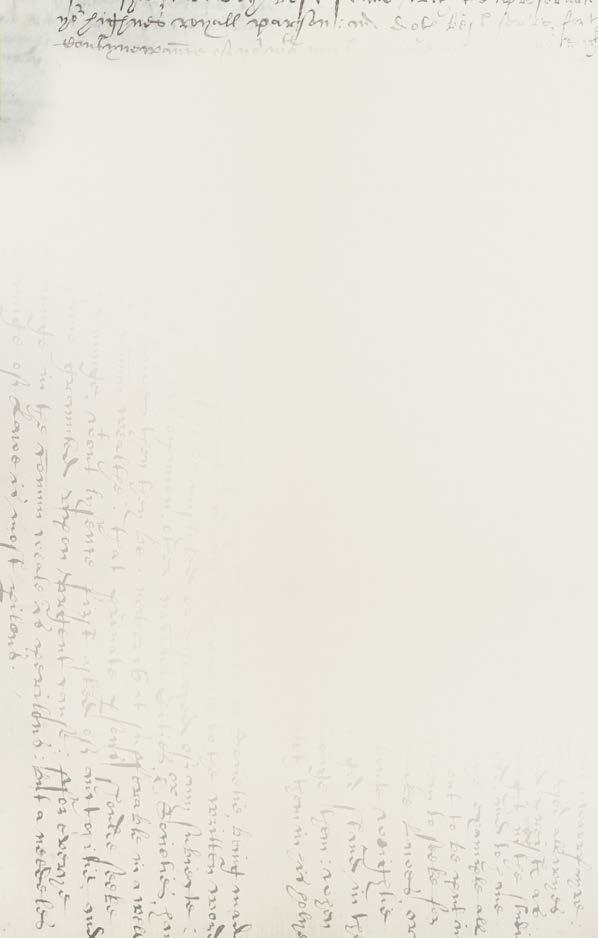
Fourth, positive laws made by humans – they must pertain to matters on which scripture is indifferent; they must not conflict with scripture; the subject must obey them; positive laws may be changed only by lawful authority; and, as to legal reform, he says, a frequent and “needless change of law is most perilous”
The Durham manuscript here has an extra paragraph: “The equity of human laws is not impeached by the corruption of the judge”, echoing the 39 Articles: receiving the sacraments is not affected by the unworthiness of the minister.
Lever ends his discussion of positive law with an assertion about the purpose of all laws; it is highly theocratic: “The end of all laws, both divine and human, and the chiefest care that all princes, magistrates and lawgivers ought to have is this, to see the people of God to be taught, to give Caesar that is due to Caesar, and to God that is due to God”. These ideas too represent basic Anglicanism.
Fifth, he criticises, “bishops, their chancellors and other ecclesiastical officers” for excommunicating people “contrary to the written Word of God” and “such rules in the canon law…at this day in force by the positive laws of this realm”. Rather, the censure may be imposed only with “sufficient cause”; if “fault” is established; and by a “proceeding in law”. Or else, it is “contrary to all divine and human laws”, and “the conscience” of those censured “is free afore God”.
Excommunication was often the subject of reform at this time. The Canterbury Convocation in 1563, passed articles about delays attendant on it; in 1580, it heard an argument “concerning [its] reforming”; and in 1584, it passed a canon for the “reforming” of “some abuses in excommunication”. Obviously, the years involved in these reforms do not particularly help us in dating the Lever tract.
Sixth, the Court of Delegates, since 1533, the final appeal court in spiritual matters. Lever’s criticisms are: there was no appeal against a Delegates’ decision; its judges “misuse the sacred chair of justice”; and they do so without the “the fear of God”, the trust the Queen “did repose in them”, and “to great annoyance” of many. Some contemporaries of Lever also criticised the court, because, for instance, its judges did not usually give reasons for their decisions. But Lever is not as radical as Calvinists like Stoughton who sought its abolition. Finally, Lever’s petition: “For redress of all inconveniences and mischiefs which hereupon have happened…since the last parliament…your most humble suppliant makes petition to your most excellent majesty that such order be taken by this parliament assembled as does best agree to your majesty’s laws already established” etc. The petition seeks better administration of the law rather than reform of law itself. The Durham version of the petition is longer than this.
Excommunication was often the subject of reform at this time. The Canterbury Convocation in 1563, passed articles about delays attendant on it.
Petitions to parliament from this period, in its archives, were destroyed in the fire of 1834. Nor is our petition in parliament’s journals. So, for the date of 1562 or 1563 (Strype, Bray), the ‘last’ parliament was in 1559, which passed statutes on Lever’s topics, including those reviving the 1533 Act on Roman canon law and the Delegates Court, the Act of Supremacy, and the Treason Act. Also, as Lever notes, since that parliament there had been problems with its laws. “This parliament”, then, could that of 1563 summoned, as its record says, to uphold religion “notwithstanding that at the last parliament a law was made for good order to be observed in the same but yet…not executed” and to make new “plain, few, and brief” laws (also in Lever). Again, the parliament of 1563 addressed Lever’s topics: royal supremacy; treason; and excommunication.
Alternatively, if the Lever tract is from 1584/5, as Marcombe claims, then the relevant parliaments would be those of 1580 (the last parliament) and 1584 (this parliament). The 1580 parliament passed statutes requiring obedience to the crown, on recusancy, and on sedition. These subjects, too, continued to be problematic. The 1584 parliament considered a bill to ‘overthrow’ the church courts and it enacted statutes on the safety of the monarch, Jesuits, and pardons.
In short, the parliamentary agenda and legislation for 1563 and 1584 both contain subjects addressed by Lever and so seem not to help us to date his tract.
To sum up our Elizabethan mystery, Lever was a Protestant reformer, but entangled himself in the establishment, using it to reform his cathedral and hospital. The tract in The Inner Temple manuscript is difficult to date: 1562/3 or 1584/5.
Assuming Lever wrote it, his work on ecclesiastical law is mostly that of a classical Elizabethan Anglican; there is more in it of Hooker than Travers. He criticises the administration of the law rather than the law itself. Above all, it is significant because it is one of the earliest statements of the continuing applicability of Roman canon law in England under parliamentary statute.
What Shardlake, Bruno, and Bracewell would have thought of Lever and the tract, I know not. What is certain is this: the Lever manuscript is just one of scores of such items in the ecclesiastical collections at The Inner Temple library; to-date these items have not been studied as we have studied the Lever text here; and identifying and exploring these items, at the Inn, will enhance greatly our understanding of the turbulent history of the interplay between law and religion.
Norman Doe LLD Academic Bencher Professor of Law, Cardiff University Chancellor of the Diocese of Bangor
This is a shortened version of a lecture he gave at the Temple Church, 28 February 2023. Thanks are due to Master Mark Hatcher; and to Rob Hodgson and Michael Frost of Inner Temple Library who displayed the manuscript there. Matthew McMurray and Andrew Gray at Durham University Library, and Professor Charlotte Smith at the National Archives. The lecture is an up-dated version of N. Doe, Rediscovering Anglican Priest-Jurists: V – Ralph Lever (c. 1530–1585), 25 Ecclesiastical Law Journal (2023) 66–80.
For the full video recording: https://youtube.com/live/3SBQDz4ll9U
READER’S LECTURE SERIES: EXPERTS: LOVE OR LOATH?
By Master Robert AkenheadFrom a Reader’s Lecture held on 3 October 2022
Sir Robert Akenhead: I’ve come across every type of expert, good, bad, indifferent. If occasionally during this talk there are more memories of the bad ones, that is only because the experiences were more amusing with hindsight. And there is only so much praise that you can make of a good expert.
In the UK, there is a rule of court called CPR Part 35. It highlights the overriding duty owed by any expert, which is to the court. It specifically states: “Expert evidence should be the independent product of the expert uninfluenced by the pressures of litigation. Experts should assist the court by providing objective, unbiased opinions on matters within their expertise. The expert should not assume the role of an advocate.” There are different practices in the different fields of law which the specialist Bars in this country have regard to. There are protocols and guides applicable in medical or clinical negligence, different provisions in family court proceedings, different from those in the technology and construction field, in which I specialise.
It’s clear that the courts, particularly over the last five to ten years, are taking an increasingly robust line, mostly pre-trial, in relation to the admissibility and other aspects of expert evidence. There’s been a fairly recent case in the Technology and Construction Court – Dana UK Axle v Freudenberg – which actually excluded expert evidence at the trial, when it emerged that there was extensive non-compliance with the relevant guide. Mrs Justice Joanna Smith said: “The establishment of a level playing field in cases involving experts requires careful oversight and control on the part of the lawyers instructing those experts, all the more so in cases involving experts from other jurisdictions, who may not be familiar with the rules that apply in this jurisdiction. For reasons which have not been explained, there has been no such oversight or control over the experts in this case.” That was on one side. “So, the provision of expert evidence,” she said, “is a matter of permission from the court, not an absolute right, and such permission presupposes compliance, in all material respects, with the rules. I agree with counsel’s submission that the use of experts only works when everyone plays by the same rules. If the rules are flouted, the level playing field abandoned, and the need for transparency ignored, as has occurred in this case, then the fair administration of justice is put directly at risk.”

Obviously, experts need relevant expertise in their chosen fields – that, you might have thought, was a given. The relevant expertise does not necessarily involve degrees or doctorates or even memberships of relevant institutions. In my early days at the Bar, I was acting for a large firm of London City solicitors who’d employed some contractors to put in a mechanical electrical air conditioning in their big City offices, and things had gone wrong, and they employed an expert who was phenomenally helpful to me as we prepared the case. He produced a draft report which looked very good, but it contained a list of qualifications at the end, some of which I just simply didn’t recognise. I then asked him what they were, and it emerged that every single one of about 15 qualifications were ones you buy. Everything he was saying was perfectly sensible. I said: “What actually is your expertise?” And he said: “Well, all I’ve got is 40 years in the mechanical and electrical contracting business.” “Well, we’ll put that in, that is your expertise.” Because the report was good, it went in, and the opposition collapsed, and the case settled.
It’s clear that the courts, particularly over the last five to ten years, are taking an increasingly robust line, mostly pre-trial, in relation to the admissibility and other aspects of expert evidence.
So apart from expertise, a key factor is independence and impartiality. There’s nothing worse than the expert who starts being an advocate for his or her client and is in effect a ‘gun for hire’. The expert world is big business now, with large international firms competing for the work. Back in the day, a lot of experts, including medical experts, often came to it towards the end of their career almost as a part-time, pre- or post-retirement job. Lots of experience, but there are problems with that in that you can, as an expert, get out of date. But these large conglomerate firms can give rise to other problems, not least of which is conflict. Of course, there’s a dichotomy, isn’t there? Is an expert required to be independent partly because they’re paid – employed by one side or the other. And the expert owes the contractual duty to the clients to exercise reasonable care and skill. So, it’s a difficult one. And there will be conflicts from time to time, but decent experts should be prepared early in the case to start indicating if they have very real doubts about their client’s case in the area which he or she has been asked to talk about.


So, experts need to have the right qualifications. You would have thought that might be obvious. Medical, accounting, engineer, architect, other types of experts giving evidence about professional negligence, are often asked whether they have practical experience in whatever field they’re giving evidence about. Sometimes experts are overqualified. And some experts are Jacks-of-all-trades, so they’ve got lots of qualifications, and one or more of them might be relevant to the matter at issue, but they’ve never really done much on any aspect of their qualifications. When I was a judge, I considered it useful in my judgments to summarise my views about the experts in different disciplines. This was to explain to the parties who read the judgement why I preferred the evidence of one expert over another, rather than just a blanket conclusion that I preferred Dr X over Professor Y. A number of judges do that, and I think it’s a fair thing to do for the parties
Inevitably, lawyers, solicitors and barristers will be involved in the selection of experts. Nothing wrong with that as such, and potential experts will be asked questions identifying what their broad approach on the issues in a given case is. And it’s unsurprising because it’s a rare case in which a party introduces an expert whose evidence is against his or her own client. Once selected, the experts will often play a material part in the pleading of a material case, or defence, or the production of memorials in arbitration. But there is a dividing line between what the solicitors and barristers should be allowed to do, and shouldn’t simply tell the expert, “This is what you must put in your expert report.” Of course, it’s all privileged, it’s all behind closed doors, and it’s almost impossible, but very occasionally it comes out where an expert has been heard to say, “That’s what I was told to say.” It undermines the credibility of the party. There is a dividing line, which sometimes gets obscured.
Inevitably, lawyers, solicitors and barristers will be involved in the selection of experts. Nothing wrong with that as such, and potential experts will be asked questions identifying what their broad approach on the issues in a given case is. And it’s unsurprising because it’s a rare case in which a party introduces an expert whose evidence is against his or her own client.
We come now to technology, not just because I was in the Technology and Construction Court. As many of you will know, you get a lot of technology coming into the giving of expert evidence. It’s easy to have computer runs that tell you all the answers. “The computer says no”, and maybe the case goes your way. “Computer says yes”, it may not. Object lesson is where your expert, or you as expert, rely upon computer workings, make sure that you’re not open to that sort of attack. Because there, in court or an arbitration, you’re not going to be able to get your computer out, put the correct input in, run the computer and say: “Oh, there you go, it still shows something, not as bad as I thought, but...” You’re not going to be able to do that. It’s going to be too late in almost every case. Also, judges have got to be careful about running software themselves. When I was head of the Technology and Construction Court I was not as good as my ten-year-old granddaughter is now. And the problem is transparency, because if you do – I can use some of these systems that I come across – you never quite know the input that there has been which you haven’t checked. And there are often thousands of pieces of input.
I’m now going to draw matters to a conclusion. So, experts and practices that engage experts can be a minefield. Experts proving not to be properly qualified, experts acting as advocates. Once they’re on the witness stand, there’s not very much you can do if they’re going AWOL and away from the prepared speech. There’s not much you can do as counsel. And if you jump in and say, “I must ask you to stop”, that’s not really going to help if it’s your own witness. In fact, you won’t really be allowed to do it. So, you have experts under the thumbs of their legal and client teams, experts changing their mind, experts occasionally not doing a good, professional, and independent job. Truth is, of course, that probably the large majority of experts are decent people with the right qualifications, who behave independently and impartially. Judges have to decide who’s right and who’s wrong.
Sir Robert Akenhead Retired High Court Judge Master of the Bench
For the full video recording: innertemple.org.uk/loveorloathe

IN CELEBRATION OF THE CORONATION OF HIS MAJESTY KING CHARLES III
On 10 May, the Inn arranged a special service of Choral Evensong at the Temple Church to celebrate the Coronation of His Majesty King Charles III, followed by a joint reception hosted by the Treasurer, and the Treasurer of Middle Temple, The Rt Hon Lord Lloyd-Jones.
To commemorate the Coronation, the two Inns commissioned an illustrated Loyal Address in which they expressed their gratitude for Her Late Majesty Queen Elizabeth II’s devotion to the nation, and their loyalty and support to the new monarch as His Majesty embarks on his reign.










 Master Treasurer’s address
The Temple Church Choir
Members in colourful traditional dress
Master Treasurer’s address
The Temple Church Choir
Members in colourful traditional dress
THE KNIGHTS TEMPLARS: THE FIRST CITY BANKERS?
By Master Gregory Jones
INTRODUCTION
A pilgrim visiting Jerusalem in 1172 puzzled: “It is not easy for anyone to gain an idea of the power and wealth of the Templars – for they, and the Hospitallers, have taken possession of almost all of the cities and villages within which Judea was once enriched… and have built castles everywhere and filled them with garrisons, besides the very many and, indeed, numberless estates which they are known to possess in other lands.” In that very same year, Henry II (1133–1189) entrusted to the Templars the so-called ‘care money’ deposited for the murder of Thomas Becket (1119–1170), enough to pay for the support of 200 knights in the Holy Land for a year. How was it that the Templars, committed to a life of frugality and abstinence, had become Europe’s wealthiest bankers?
THE REASONS WHY
Crusading was costly. At the Battle of Harim in 1164, only seven of the 67 Templars survived, and at La Forbie in 1244, only 33 out of 300 knights lived. Replacement costs were the equivalent to a ninth of the French monarchy’s annual income. Such costs impacted particularly hard upon the weaker kingdoms of Europe that had to look for loans. The Templars attracted a steady stream of recruits, many of whom handed over all their worldly possessions upon entry into the order. With pilgrims and would-be crusaders desperate for cash, the Templars began offering loans. In the case of a customer’s death, the Templars would also scoop up as executors of their estate. However, it was Pope Innocent II’s Bull of 1139, Omne datum optimum, that really kick-started the brothers’ rise from donated rags to vast riches. It not only exempted the Templars from paying a tenth of their produce in tithes, but also allowed them to collect tithes of their own. Their preceptories earned similar concessions from local lords across Europe, allowing them to levy tolls and customs on fairs and markets.
As monks, the Templars had the habit of obedience. Their oaths led to prudent lending. As celibates, they had no personal or dynastic ambitions to threaten jittery royal princes. Thus, with their financial acumen, Templars were often made royal almoners by European kings. Although they were monastic, owing obedience to their grand master and fealty to the Pope, nonetheless, it seems to have been accepted that they could work for monarchs whose interests diverged from each other and from those of the Pope. Under Phillip II (1165–1223), the Templars ran the French royal treasury, increasing revenues by 120 per cent. In various countries the Knights Templars formed much of national public service from time to time. Their financial network stretched beyond royalty. During the papal schism, Pope Alexander III (1159–1181) relied heavily on Templar loans and administrative services to stay afloat. When Pope Innocent III (1198–1216) rolled out proportional taxes in 1198, requiring the clergy to help fund the Crusades, he tasked the Templars with collecting funds and transporting them safely to the Holy Land. As knights they could take on miliary duties that could physically secure property and wealth. Prior to the military orders, monasteries had traditionally guarded valuables and had been able to lend money. The Templars owned strongholds in the west and in the Crusader States providing a fantastic international and local branch network. The Knights Templars were secure in all senses of the word.

PIONEERS OF BANKING AND FINANCIAL SERVICES
By the 1240s, the Order was providing diverse banking and financial services. In England and France, the Order gave safe storage for sensitive diplomatic documents – some of which could be used as collateral against loans. During the reign of Henry III (1207–1272), the royal treasury was deposited at the Temple, and for part of his reign Henry III even resided there whilst receiving sophisticated financial services. He repaid a substantial loan to the Count of Flanders in annual instalments, drawn from funds deposited at the Templar’s branch in Flanders, making another payment to the Byzantine Emperor by using his account at the Templar branch in Constantinople. Provision was also made for nonroyal merchants to use the ‘New Temple’ in London and Paris for depositing their valuables. The Temple in Paris even sent out statements to important clients several times a year detailing the movements within their accounts. According to Frank Sanello, “Even Muslim rulers enjoyed the services of their nominal enemy and borrowed heavily from these fiscal wizards.”
The Templars also distributed pensions promised by monarchs to wartime allies. King John’s (1166–1216) allies would not trust him and insisted on brokered deals guaranteed through the Templars.
The Order also developed annuities and pensions responding to land donations made conditional upon the provision being made for a man, wife, family etc. until they died. These pension packages also included unique extras of not only spiritual salvation but the protection of the Templars in a violent age. Debt guarantee was also provided since church institutions were readier to loan to the Crown if the Temple secured the loan. These loans could be exceptionally large. Louis VII (1120–1180) borrowed such copious amounts to finance his two-year crusade he almost bankrupted the Order. It soon revised its lending policies, requiring debtors to pledge security against their loans. This could take many forms. When King John’s excommunication was lifted in 1213, he borrowed nine marks of gold from the Templars for an offering of absolution and 2,100 marks shortly before signing the Magna Carta, with another 2,000 later that year, to pay his soldiers in Poitou and Gascony. King John placed his Crown Jewels in Temple Church effectively pawning them to the Templars.

All religious orders lent money, but Christians were generally not allowed to charge interest – the practice known as ‘usury.’ The Templars found other ways of covering the cost of a loan. In Aragon, loans were made on the security of an income from the land or benefice, or that the produce of the land did not count towards repayment of the loan, and it was often agreed that the Order could deduct part of the sum collected to cover its expenses, as was permitted under cannon law. The Templars instead billed for administrative fees and expenses, or else manipulated the currency exchange. Some Templar loans from southern France included a clause that if the coin depreciated in value between the time of the loan and the repayment then the borrower must add a fixed sum to compensate the lender. As the fixed sum would remain the same however much the coin depreciated, it is likely than an interest charge was buried in this fixed sum. Eventually, they dropped the act, flat out charging England’s Edward I (1272–1307) 5,333 livres, six sous, and eight deniers for, “administration, expenses, and interest.” On some loans they charged an interest rate of ten per cent which was “two per cent lower than the maximum allowed to Christian money lenders in Aragon and half of the Jewish rate.”
All religious orders lent money, but Christians were generally not allowed to charge interest – the practice known as ‘usury’.
The Templars pioneered money transfers and foreign exchange. Raids on Templar money houses were rare but not unknown. One of the most complicated transfers was employed by Pope Gregory IX (1170–1241) in 1249 whereby he used the French Temple to settle his debts; Papal revenues collected in Scotland, Ireland, and England were routed to the Templar house in Paris; allowing the Pope’s creditors to present themselves before the Parisian Templar brothers bearing letters of credit to redeem them for outstanding payments owed to them in Rome.
The Templars thus amassed capital at annual provincial chapter meetings with the aim of sending it to their brothers in the Holy Land but as their reputation spread across Europe, they soon found that even with all the war costs accounted for, they were running at an enormous profit.



TEMPLAR DOWNFALL
The Templar’s fortunes were linked heavily with the success or failure of the Crusades. The fall of Acre in 1291 meant not only that the military order was severely diminished but also that royal households were heavily in debt. With defeat there was inevitable blame and humiliation. The seeds for their downfall combined with their banking success. They lived by different rules – not paying taxes, not bound by the laws and controlling markets. Like the minorities they sought to supplant in banking, the Lombards and the Jews, “they were unpopular and rich” but more peculiarly they also, “did not like women only money” and were seen “as greedy but miserly.” Historian Peter Partner estimates their moveable wealth to have been 150,000 gold florins – equal to half Edward II’s (1284–1327) annual debt. Although this figure is disputed, their wealth was considerable and the debts owed to them by various royals significant. They were also seen as elitist and perhaps even a bit smug: the future King Philip IV (1268–1314) was rejected as a member of the Templar lay order. Philip later got his revenge. Eager to relieve himself of his crushing debt to the Order, and to get his hands on their riches, Philip IV ‘the Fair’ would brutally nationalise the Templar bank coercing the weak Pope Clement V (1264–1314), located in Avignon, into ordering the seizure of all Templar assets. Whilst eventually forwarded onto the Hospitallers, the royals of Europe first dipped their hands into the Order’s wealth.
They lived by different rules –not paying taxes, not bound by the laws and controlling markets.
Most Templars were tortured and executed as heretics. In 2007, the Vatican finally unveiled a book entitled Hearing Against the Knights Templar detailing what took place at Chinon, France in August 1308. It confirmed them innocent of heresy.
Gregory Jones KC Francis Taylor Building Master of the BenchAlderman for the Ward of Farringdon Without

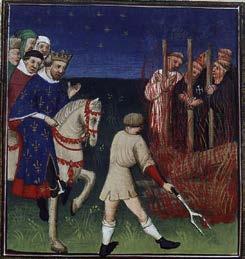
 The Banking Network
Execution of the Knights Templar
The Banking Network
Execution of the Knights Templar

WHAT’S THE POINT?
By The Master of the SilverWhat is the point of the Inner Temple Silver Collection? It is expensive to maintain in good condition; it has to be stored; it has to be checked and examined twice a year and it involves a number of people in cleaning, transporting to and from Hall. If that were the only answer to the question, we would no doubt be strongly advised to dispose of the collection and put the proceeds towards some good cause – supporting students or opening a care home where elderly members of the Inn could decline gracefully in an alcoholic haze!
Of course, it isn’t the only answer and those of you who attended Richard Parson’s talk in February to the Inn’s History Society will have detected a more uplifting answer. It doesn’t have to demonstrate a purpose or have a ‘mission statement’. It exists. It has been added to over centuries and reflects both important events in our history, and also private gifts by generous members of the Inn – some items are decorative; some had a practical use in times past such as salvers, tankards, bone marrow spoons or asparagus tongs and some have a current use and are also decorative. The collection is therefore an accumulation of the Inn’s involvement in the history of the country, our legal system and, importantly, a social history of the members’ involvement in the life of the Inn. Those who were unable to attend Richard’s talk can now get some feel of the collection’s importance to us in his splendid article on page 128.
The answer above does hint at ‘a purpose’ when it comes to adding to what we have been fortunate to inherit. In this century alone, we have enjoyed generous gifts over the Millennium celebrations and various jubilees – decorative table centres and glorious candelabra to help illuminate those occasions when we gather for our collegiate celebrations.
Past Treasurers have been involved in such gifts and also in building up our collection of drinking beakers. Last year, Master Elizabeth Gloster was keen to recognise Her Late Majesty Queen Elizabeth II’s Platinum Jubilee and commissioned the creation of what we needed to make up to the required number.


The collection is therefore an accumulation of the Inn’s involvement in the history of the country, our legal system and, importantly, a social history of the members’ involvement in the life of the Inn.
Special occasions, such as a jubilee, enjoy an extra essay mark and these beakers look magnificent with a beautifully clear set of marks, together with the dates of Her Late Majesty’s reign as you can see in the photographs. We are hugely grateful to Master Elizabeth Gloster for her generous gift to the Inn in such a memorable year. Perhaps in a hundred or so years’ time someone will enjoy drinking from a slightly battered silver beaker and realise it was given to celebrate the longest reign of one our monarchs. Or, I suppose, wonder why we supported a monarchy for so long when most of the rest of the world chose to support an elected president. Maybe they will also wonder at the origins of dining and the teaching of Law.
His Honour Michael Lawson Master of the SilverCELEBRATE THE LIFE: MASTER PATRICK MADDAMS HON FRIBA
4 April 1951–23 October 2022
A tribute by the Master of the Temple at the funeral of Patrick Maddams, held on Friday 10 November at the Church of St Mary’s Walberton, East Sussex
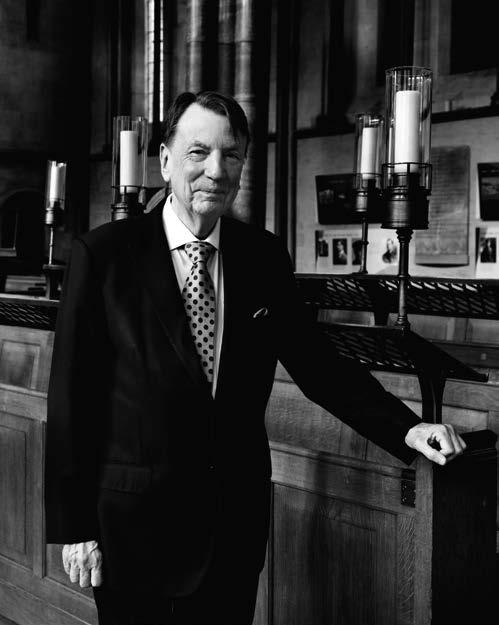
In the autumn of 2005 a new Sub-Treasurer, Chief Executive, arrived in Inner Temple. He established himself, I think almost on his very first evening, in the Inn’s own Pegasus Café. And there he greeted his new colleagues, chatted, laughed, and enjoyed a glass.
We soon discovered that Belinda was in the Inn too. Yes, of course. And what a delight. She was a wonderful presence, to enliven the Inn.
Rather less expected, on that very first evening in Peg, was the arrival of a ten year old girl with long curly dark hair who strode into the bar, declared “I will have a coke, please” and sat down to join us. Cecilia had arrived!
We did not have just a new Sub-Treasurer in the Inn, but a new family. It was a joy.
And for the next 12 years, Patrick was at the centre of the Inn’s life, every part of it. Everything in his past career seemed to come to its happiest fruition.
We did not have just a new
Sub-Treasurer in the Inn, but a new family.
It
was a joy. And for the next 12 years, Patrick was at the centre of the Inn’s life, every part of it.
Architecture: He was a Fellow of the Royal Institute of British Architects; and was now in charge of one of the loveliest and most historic ensemble of buildings in London.
Law: He moved from Beachcroft to The Inner Temple, from one side of the legal profession to the other, in a seamless segue.
Business: Simply, doing business. He was just the person to negotiate the sale of the vast Mitre Court complex to Apex Hotels, at a pivotal – frankly rather dangerous – moment in the markets. And he did it, triumphantly. His mother’s remarkable business skills had become his own!
Music: He had been CEO of the Royal Academy of Music; and now had the Temple Church, already one of London’s great musical centres, in his bailiwick, and all the potential of The Inner Temple itself to explore and realise. He loved it.
Travel: Patrick, it seemed, was never off an aeroplane. He had caught the bug as a student, on a greyhound bus around the USA. And for the Inn, he visited at least 12 countries on four continents. (And strangest of all, when Patrick was not involved himself, Bob, his brother, was in the frame. How many people are there who cannot come on a pilgrimage to Ethiopia themselves but happen to have a brother who has filmed there for years?)
And all of this in a collegiate setting, where friendships, shared aims, and a happy social life inform and animate almost everything.
We have the best and most grateful possible memories of Patrick’s tenure. We believe – and we certainly hope – that Patrick as well had found in the Temple his natural home, and that on his retirement he took with him over a decade of wonderful memories too.
And Cecilia, I hope you realise that amid all this his real pride was in you. We got regular updates – of school, then university – and occasionally, you would be in Hall for lunch and we were agog, catching up with your dancing, your year in Spain, your field-trips, and your launch upon your teaching career. No wonder Patrick was proud of you, and of all that you were already achieving. It is a real pleasure that we still have good reason to see Belinda and yourself in the Temple.
What an honour it was, for us, that Patrick’s last kind contribution to the life of the Temple was the performance, just weeks ago, of all six Cello Suites by Bach on a single day. It was magical, from beginning to end. We were able to arrange a live-stream of some of the performances. We are very touched, that Patrick was able to listen to this miraculous music in the hospice.
What an honour it was, for us, that Patrick’s last kind contribution to the life of the Temple was the performance, just weeks ago, of all six Cello Suites by Bach on a single day. It was magical, from beginning to end.
Patrick described himself as a lapsed Catholic. Perhaps he had, indeed, rather fallen out of love with the Catholic God. But he had certainly not fallen out of love with Church – as a place of generosity, warmth of heart, and welcome. It was exactly where he belonged. He was the best of friends to the Temple Church and to all of us who work there. The first service we could do for him, before he even arrived at Sub-Treasurer, was at the death of his father, in his father’s honour. We certainly hope that the last such service we can offer to Patrick will be a service of thanksgiving for his own life, in the Temple Church. It will be a privilege for us, to remember him there and to give thanks for all the years of service, of friendship, and of warm-hearted goodwill that he gave so generously to the Inn and all its members.
Cecilia, Bob, Belinda, you are surrounded by love today: by the love of everyone here at Walberton; and of everyone far afield – in this country, Ireland, the USA, Canada, and Africa – who misses Patrick and who cares for you. We are thinking of you all; you, with Patrick, are in the prayers and in the hearts of so many people, and will be for months and years to come.
We are thinking of you all; you, with Patrick, are in the prayers and in the hearts of so many people, and will be for months and years to come.
Patrick had an extraordinary memory. He seemed to know every poem by Ogden Nash by heart, and would recite them with immense verve, and have us in fits of laughter. But he knew other texts by heart too. Not least his own school song, which he seemed always to treasure:
Salve, Regina, Mater misericordiæ, vita, dulcedo, et spes nostra, salve.
Hail, holy Queen, Mother of Mercy, Hail our life, our sweetness and our hope.
Turn, most gracious advocate, Your eyes of mercy toward us; And after this our exile, Show unto us the blessed fruit of your womb, Jesus. Pray for Patrick and for us all, that he and we, all of us, in the end, may be made worthy of the promises of Christ. May Patrick rest in peace, and rise in glory.
The Rev’d Robin Griffith Jones Master of the Temple
THE SOCIAL CONTEXT OF THE LAW: GLOBAL RESPONSES TO THE FORCIBLY DISPLACED:
FREEDOM OF MOVEMENT OR CONTROL BY NUMBERS? WHOSE RIGHTS? WHOSE DUTIES?
From a Social Context of the Law discussion held on 20 February 2023 between Dr Gillian Triggs and Master Alexander Downer, moderated by Master Geoffrey Nice

Sir Geoffrey Nice KC: The Social Context of the Law series aims to deal with contemporary and sometimes controversial issues by drawing on the skills available to us to discuss these issues. I dare say for many of us, for much of our lives, ‘refugee’ when it turned up in conversation or in a newspaper or on the television was a subject that had to do with other people in faraway places. But no longer. In our country and in many other countries, refugees are a constant recurring issue. And indeed, in our country we know that because the interaction of refugees and unlawful immigrants who crossed the channel is actually going to be a hot topic on at least one of the manifestos of the two, at present, major parties in our country, and the issues are by no means simple. Is one refugee the same as any other kind of refugee, or are they all of different categories? Why are they refugees at all?
Our two speakers are Dr Gillian Triggs, an Assistant Secretary General of the United Nations and an Assistant High Commissioner for Refugees, and The Hon Alexander Downer AC, a politician and diplomat who now has a senior position at King’s College.

Dr Gillian Triggs: I’m pleased to have the opportunity to say how much we value in the UN Refugee Agency the work of the legal profession. They provide pro bono work, they provide advice, they support us, and they support individual refugees seeking international protection. And we’re deeply appreciative of it because ultimately, we do need to go back to those fundamental principles of international law.
I’d like to take us right back to the Universal Declaration of Human Rights in 1948. Article 14 talks about everyone having the right to seek and to enjoy asylum from persecution. Well, that was picked up in 1951 with the Refugee Convention itself. And that’s at a time when it was recognised there were about two million people forcibly displaced in Europe, and that something needed to be done. Two fundamental principles were adopted, with historical foundations. One, that people should have a right to seek asylum from persecution. Secondly, and a non-derogable principle of international customary law, that no person may ever be returned to a place of conflict and danger.

The High Commissioner has reported this last year 103 million people forcibly displaced globally within the mandate of the UN Refugee Agency, about 32 million of them refugees, probably many more now. What has been the response by states? What is the UNHCR doing to respond to these enormous challenges? What are the drivers for displacement? Unfortunately, those root causes are the same all over the world: poverty, inequality, discrimination, persecution, increasingly the impact of climate change, but overwhelmingly, conflicts.
We have seen that the Ukraine war, almost an old-fashioned war, has led to eight million people displaced into the border areas, with six million displaced within Ukraine itself. But let’s put that into context. Because we also have protracted conflicts: Syria, the 12th year; Afghanistan, more than 40 years; the Sahel; six million internally displaced in the Democratic Republic of the Congo; Ethiopia, the poster child for peace, erupts in yet another civil war; continued displacement from South Sudan. And 850,000 people have fled Myanmar, Rohingya, finding protection in Bangladesh. And most recently, Haiti again erupting in civil war, leading to further onward movement up through north Central America and into the United States and Canada.
But another relevant fact is that 80 per cent of refugees, people who’ve crossed borders to seek protection, are in fact hosted and protected by some of the poorest and low-income developing countries in the world. And that is really what has created the impetus, globally, to find a solution. In 2018, it was felt that the Refugee Convention itself was not enough. We had to think more broadly, we had to take a whole of society approach. And that led to the Global Compact on Refugees (GCR), its twin being the Global Compact on Migration. The Compact on Refugees adopted a new approach, almost a revolutionary one – that the burdens and responsibilities for refugees should be shared equitably across the globe. It’s not a legal document, it’s not a treaty, it doesn’t bring legal obligations, although 181 states voted for it in the General Assembly, but what it does do is to create a sense of consensus around the principle that we can no longer continue on the path that we’ve taken, with the numbers of people displaced and refugees having doubled in the last 10 years, and it’s highly probable that those numbers will double again in five years.
This voluntary compact involves the banks, the World Bank, the Regional Development Banks, the private sector. It was to involve the voices of refugees themselves, to involve religious groups, and national civil society and international civil organisations. During these last few years, and in that environment of an aspirational attempt at global compact, we’ve had very real changes in the approach to dealing with people leaving their country irregularly. I’ve never seen such a rejection of the normative principles of refugee law.
Countries now will explicitly push back boats, they will deny rescue at sea, they will refuse disembarkation, and they will do so contrary to not only the principles of refugee law, but the ancient law of the sea or maritime law. And we have increased rejection, closing borders, the misuse of health borders – health measures to close borders – and we have a strong resistance now at a popular level, a public level. There are some good practices, and we at the UNHCR really try to focus on those. We’ve seen very positive practices of countries keeping their borders open, allowing numbers to come through. But we’ve also seen some significant digression in support for those fundamental principles.
So, the question I’d like to finish with is what is the UNHCR doing about it? We are trying to use the idea of principled pragmatism, we cannot ignore the concerns that countries have about protecting their borders and about the sheer numbers, about the concerns of citizens. We have to understand that, and we have to find a way of responding. We know some countries say the asylum systems are broken. I don’t think that’s true. But nonetheless, they are undeniably being abused. And they lead to overly complex legal systems, clogging up the courts, sometimes for years. In brief, what we’re trying to do is to talk to governments about strengthening regular pathways in order to preserve the asylum space for those cases where most reasonable people accept the obligation to provide protection to people genuinely in need of asylum. We’re also looking at labour mobility, trying to encourage governments to improve access to labour. One of the ironies is that many of the European and North American countries are ageing, and they need labour, they need people to assist with health care, but also to work in other industries: the hospitality industry, in construction, in agriculture. The other work that we’re doing is working with the development banks, because the international legal system, the international environment, through the UN, is increasingly saying: “We can’t keep doing what we’ve been doing.”
We’ve got to find some solutions that deal with root causes, and that means development, it means private investment, it means stabilising populations where they are, maybe looking at regional approaches to giving people the relevant information to make sure they go down the right channels, whether it’s access to labour, education, family reunion, or whether it’s that they need protection from persecution, from conflict, from crime, and the impact of crime leading to displacement. I conclude by saying how important the legal profession is to understanding the complexity of this environment, to ensuring clear messages, and to supporting innovations, new ideas. We need fresh ideas if we are really going to cope with what are likely to be increased movements of peoples as they seek, sometimes, a better life, but very often simply protection from persecution and from conflict.
Two fundamental principles were adopted, with historical foundations. One, that people should have a right to seek asylum from persecution. Secondly, and a non-derogable principle of international customary law, that no person may ever be returned to a place of conflict and danger.

The Hon Alexander Downer AC: This issue of immigration is a ‘wicked problem’. The fact is that, particularly in liberal democracies of a Western nature, there is huge demand to migrate to those countries. And that is very much the case with this country, which has a large number of migrants. It is certainly the case in the United States and Canada, and it’s very definitely the case with Australia as well. These liberal democratic governments are all elected by the people of their country, and so this is one of the many issues that they have to manage.
Should a country take the view that anybody who wants to come to that country to live, to migrate, should be allowed to? And that is a really fundamental question that you need to answer. I mean, some of you will think that anybody who wants to come to the UK should be able to, that the UK should have open borders, that borders are an anachronism. And some people in Australia and in the United States, and so on, might think that. The fact is that the vast majority of people in all of our countries don’t think that. Don’t draw the wrong conclusion from that: I think on the whole they are persuaded that migration is a good thing. I would say, in Australia, the concept of accepting migrants is reasonably popular. And most of them, with the exception of about three per cent of the population, are the descendants of migrants or are migrants. And in this country, I think public opinion is likely to be rather similar, that people are on the whole happy enough with the concept of migration, but they’re not happy with the idea that you would have no limit to the number of migrants you took, that in other words, you would just have an open border.
Australia does take about 160,000 migrants a year – the bigger percentage of those, around 60 per cent of them, are skilled migrants. So, they’re migrants who come to fill vacancies. At the moment, Australia is desperately recruiting doctors and nurses from the UK, as the UK desperately tries to hang on to these people. The second category is family reunion. There are different sub-categories of family reunion, but the most significant is when people marry in Australia. And thirdly, there are refugees. Australia has a refugee resettlement programme – it takes around 20,000 refugees that it resettles, mainly through the UNHCR. They are vetted, these people, particularly from a security point of view. But the Australian government takes the view that it has to carry some of the burden of looking after these people. Because looking after them doesn’t necessarily mean they have to become migrants. But Australia says: “Well, we’ll allow 20,000 a year of these people, it is of course a very small percentage of them all, to resettle in Australia, not just to resettle temporarily but to come as migrants.”
In addition to that, Australia did have a system of Temporary Protection Visas where people can come to Australia if they need protection, temporarily until the need for protection is no longer necessary, in which case they could return home. That was very effectively used by Australia for the Albanian Kosovars at the time of the Kosovo War. Australia took 15,000 or so Albanian Kosovars; when the war was over, they were sent back again. Australia, though, takes the view that there are only so many people the country can take. That if we took more, that would put public services under substantial strain. It would generate community controversy, and if the immigration programme broke down and became uncontrolled, and incomprehensible to the public, then public support for immigration would decline, and we would lose the support that we’ve had for a very long time for immigration. And that is an incredibly important point to consider: the politics of immigration, including the politics of looking after refugees.
So, this brings me back to what we can do to help displaced people over and above giving some of them Temporary Protection Visas, over and above allowing some of them to migrate to our countries. What else can we do? And a very big percentage of them, about 80 per cent of externally displaced people, are in the surrounding countries. And actually, there are very few countries which host most of these people and they are largely poor countries. That isn’t because people are flocking to poor countries, that’s because they happen to be the neighbouring countries of the places where these conflicts are taking place. So, the challenge is to look after those people – as best we possibly can – without destroying our own immigration programmes at home. And that is a question really of foreign aid, of working through the UNHCR and other organisations working with the host governments.
People are happy enough […] with the concept of migration, but they’re not happy with the idea that you would have no limit to the number of migrants you took, that in other words, you would just have an open border.
So, I just wanted to get you to think about how you would manage an immigration programme, what you do if large numbers of people turn up, if you like, uninvited, as happened in Germany? Well, they were invited, I guess, by Angela Merkel. But a large number of people just turned up. What happens, as happened in the case of Germany back in 2016, was huge public resistance to seemingly uncontrolled migration into Germany. And in a liberal democracy you have to take into consideration public opinion, and how you manage public opinion. Because Angela Merkel had to reverse a policy because of the public reaction, and the huge flood of votes that went to the more extremist political parties, in particular Alternative für Deutschland, became something of a concern for not just Germany but more broadly for the European Union and the family of European countries. That, I think, is a lesson as to how carefully these issues have to be managed. And I shall end on one note about the UK and immigration –I think it’s very hard to understand the British government’s immigration policy. I don’t want to make what could be interpreted as a party political point here, at the expense of the government, but they have been in power for over 12 years, and not once in those 12 years have I ever thought they had a very coherent approach to immigration. Yes, there’s the small boats issue. They want to stop the small boats, that’s entirely understandable. They’re not coming from Afghanistan or Syria, these boats are being launched in France. Now, obviously, it’s a racket going on with people smugglers – you can see that from the large number of Albanians that have come. But the British government has found it very hard to deal with that issue, and at the same time has found it very hard to come up with a coherent strategy for people being able as refugees to resettle in the UK.
Dr Gillian Triggs
Assistant Secretary General for the United Nations Assistant High Commissioner for Protection (UN HC for Refugees Filippo Grandi)
The Hon Alexander Downer AC International School of Government King’s College Academic Master of the Bench
Sir Geoffrey Nice KC Chair of the China Tribunal and the Uyghur Tribunal Master of the Bench
For the full video recording: innertemple.org.uk/globalresponses
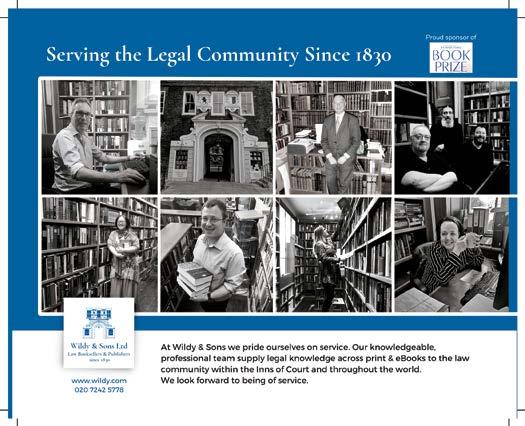

Drink and dine at the Pegasus Bar & Restaurant
Open for drinks and dining fi ve days a week, the Pegasus is the perfect spot to recharge or relax away from the bustling streets of London. From breakfast to dinner, our seasonal menus and fine selection of beverages o er something for everyone.
Alternatively, celebrate all your special occasions with exclusive hire available on weekends between 11am-11pm. Just moments from Temple Church, the Pegasus is a convenient location for pre or post church gatherings and concerts too. 020 7797 8230 | venuehire@innertemple.org.uk | innertemplevenuehire.co.uk

Standing events: Up to 50 guests
Seated events: Up to 40 guests
CELEBRATING OUR RARE BOOKS

The Library’s collections were reinstalled over a year ago, and it has been business as usual ever since … but all was not as it seemed. Behind the scenes, the Library team (and numerous patient researchers) quietly awaited the final piece of the puzzle – the return of the manuscripts and special collections. A treasured selection of the manuscripts was exhibited to accompany a talk by Master John Baker earlier in the year. Now, to celebrate their return, the Library and Archive team would like to focus the (low lumen) spotlight on some of the books from our special collections.


Charles Darwin, On the Origin of Species by Means of Natural Selection, first edition, 1859
Widely regarded as one of the most important and influential scientific books ever written, On the Origin of Species was the first publication of Darwin’s theory of evolution to the general public, following the presentation of papers by Darwin and Alfred Russel Wallace on the subject to the Linnean Society of London on 1 July 1858. Published on 24 November 1859, the first edition of 1,250 copies sold out immediately upon being offered for sale by the publishers. A second edition was published on 7 January 1860.
Simon Hindley
Thomas Bewick, A Quadrupeds

Until recently, I hadn’t seen Thomas Bewick’s super-cute woodcuts. It was only while preparing some colouring pages for our younger guests at the Temple Big Picnic that I really had the chance to truly appreciate them.
Thomas Bewick (1753–1828) was an English wood engraver and author known for his influential publications on natural history. We have a couple of titles in our collection, such as A General History of Quadrupeds and A History of British Birds (1805).
The birds are nice, but my true affections lie with the quadrupeds, which include some fantastical creatures such as the ‘Cameleopard’ (essentially a giraffe but a lot fancier) and a marvellously misshapen walrus (not pictured here, but I encourage you to enquire at the Library). It must be seen to be believed.
Sally McLaren



AWN Pugin, Glossary of Ecclesiastical Ornament and Costume, Compiled from Ancient Authorities and Examples, second edition, 1846
One of the Library’s non-law books of which I am very fond – indeed one of the few that I would like to own myself – is AWN Pugin’s Glossary of Ecclesiastical Ornament and Costume (1846). Firstly, it appeals to my taste for recondite knowledge. How many readers (then or now) would know what a Pax-Brede was? And how many could give the two (entirely different) meanings of the term ‘Ciborium’? Secondly, the highly coloured illustrations (chromolithographs: ‘state of the art’ technology at that date) are magnificent. Pugin’s text – over which he evidently took great pains, quoting from many historical sources – demonstrates in places that he was quite opinionated; here he is on the subject of ‘modern albes’ – an alb being a type of vestment: “[They] are for the most part strange departures from ecclesiastical antiquity. … In Ireland they are indescribably ridiculous … and very often made of uncanonical materials, to suit the caprice or whim of individuals.”
Michael Frost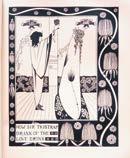
Thomas Malory, Le Morte d’Arthur, second printing, 1909 (Illustrated by Aubrey Beardsley)
Aubrey Beardsley (1872–1898) was commissioned to illustrate this edition of Le Morte d’Arthur in 1893, when he was only 21 years old. This copy is from the second printing of 1909 (limited to 1,500 copies), after which the type was dispersed.
Having read and watched many adaptations of the Arthurian legends, I was excited to learn that we had a copy of Malory’s work in the Library. The book is filled with stories about King Arthur, Guinevere, Lancelot, Merlin, and the Knights of the Round Table. These thrilling adventures sit alongside wonderful illustrations that capture the imagination and make the book as exciting as any modern film.
Tracey Dennis
Georges-Louis Leclerc, Comte de Buffon, Histoire Naturelle des Oiseaux, 1770–1786
The French naturalist, Buffon (1707–1788), was the first to attempt a comprehensive work on natural history with his 44-volume Histoire Naturelle, Générale et Particulière
The copy in the Library’s collection, Histoire Naturelle des Oiseaux, is in ten volumes (1770–1786) and forms a part of that work. The plates are hand coloured.
I have picked a colourful specimen of a parrot from Martinique. I have recently become fascinated with all birdlife, from watching robins, sparrows, magpies and pigeons in my garden, to travelling to wetland and coastal areas looking out for oystercatchers, curlews, turnstones, knots, lapwings and many more.
Tina Williams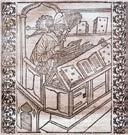


Sebastian Brandt, [Narrenschiff]. Stultifera Nauis, The Ship of Fooles, 1570
Brandt (1458–1521) first published his satirical portrait of an age, Das Narrenschiff, in 1494. A translation by Alexander Barclay was first issued in 1509, and this copy dates from 1570.
Arguably guilty of stockpiling books myself, I am fond of the fact the first ‘Foole’ is the ‘book fool’ who amasses books that he neither reads nor understands; in fact, he is “content on the fayre covering to looke”. Amusingly, the second berth on this ship of fools is reserved for “evill counsailers, judges and men of lawe” …
Of course, a librarian would not choose a book based on the pictures alone, but the woodcuts in Brandt’s Ship of Fooles are a delight.
Rob Hodgson

Miguel de Cervantes, The History of Don-Quichote: the first part, 1612
This first English translation of Part One of Cervantes’ Don Quixote was produced by Thomas Shelton (fl. 1598–1629) and was published in 1612. Unfortunately, only a few good copies, of which this is one, have survived. This book reminds me of my first trip overseas by myself, when I travelled to and stayed on the coast of Andalucía with a trusty copy of Cervantes in hand. I do not quite recall if Don Quixote travels to Andalucía, but the large advertising boards featuring bulls, to be seen on many of the hilltops there, reminded me so much of the windmills he and Sancho Panza encounter on their journey. Memories of the book still burn vividly in my mind, entangled with my own travels in Spain.
James Rowles


John Lewis, The History and Antiquities, Ecclesiastical and Civil, of the Isle of Tenet in Kent, 1723
A particular favourite of mine, this book was written by the antiquary and clergyman John Lewis (1675–1747) and is the first of its kind to explore the richly diverse and ancient history of the Isle of Thanet in Kent, where I grew up. Although it is no longer an island, and is now a popular tourist and relocation destination, Lewis’s History and Antiquities proudly chronicles Thanet’s history as a major Bronze Age and Roman settlement right up to the early 18th century, delving into the area’s harbours, churches, and the everyday lives of its inhabitants. The Inner Temple Library is only one of around a dozen libraries in the UK to hold a copy of this first edition (which, excitingly, was also owned and donated to the Library in 1726 by Master Herbert Jacob, who lived near Thanet), and it is wonderful to have a book in our collections that is historically and personally important to me.
If you want to see more Tenet-related objects around The Inn, look out for the portrait of Gabriel Neve Esq. of Dane Ct. Thannet, Decr. 1743 hanging on the stairs by the second floor in the Treasury building just outside the Library.
Lily Rowe

John Ogilby, Atlases, 1670–1673
John Ogilby (1600–1676), dancing master, theatre impresario, Irish Master of Revels, publisher, and the Royal Cosmographer to King Charles II (1630–85), created the first road atlas of England. The Library is lucky enough to possess his five Atlases, namely those for Japan, Africa, America, China and Asia. These Atlases were funded by lotteries and subscriptions to create ‘a series of Atlases to cover the world’. The first Atlas published was Africa, printed in London in 1670.
Ogilby relied on the anecdotes and explorations of others, having never visited any of the continents and countries depicted. His description of the religious nature of an elephant and its alleged expertise in ancient Greek is charming. The books are rich in illustrations, and Africa also contains the only contemporary biography of Ogilby.
The author lived and worked near The Inner Temple, where Tudor Street is now. He is buried at St Bride’s Church.
Celia Pilkington




The Nuremberg Chronicle is an illustrated encyclopedia of world history, which was published and printed by Anton Koberger and authored by Hartmann Schedel, in Nuremberg in 1494. With a focus on Europe and the Near East, the book divides history into seven ages, including the future apocalypse, and uses biblical, classical, and medieval sources. The 1,809 woodcut illustrations are what The Nuremberg Chronicle is famous for. Designed by Michael Wohlgemut and his stepson Wilhelm Pleydenwurff (although the young Albrecht Dürer may also have contributed, as he worked for them a few years earlier), the combination of inaccurate sources and the lack of direct observation makes for the most entertaining illustrations, including the use of fantastical beings and European skylines for ancient and foreign cities.
Umut Kav
Hartmann Schedel, The Nuremberg Chronicle, 1494THE COIC PUPILLAGE MATCHED FUNDING SCHEME
COIC welcomes applications for matched funding for 2024–2025 and 2025–2026 pupillages.
The COIC Pupillage Matched Funded Scheme (PMF) helps provide additional pupillages in Chambers, and other approved training organisations, predominantly engaged in legally aided work. Encouragingly, a growing number of Chambers are applying for COIC matched funded grants. COIC is set to support 33 pupillages in 2023. This is an impressive improvement on the scheme’s first year of operation in 2014, when it supported 14 pupillages.
How the scheme works
It is a prerequisite of the scheme that chambers understand that matched funded pupillages are in addition to those they would have offered in any event. COIC match pupillage funding already provided by chambers with a total grant of £10,000 for 2024–2025 London pupillages and £8,550 for 2024–2025 out of London pupillages and, £10,900 for 2025–26 London pupillages and £10,000 for 2025–26 out of London pupillages, to fund the first six months of a second pupillage. Chambers are responsible for ensuring that the total pupillage award meets the BSB’s minimum award for the year in question.

3TG Barristers is a medium sized and highly successful London based set specialising in publicly funded criminal law. Despite the abundance of work in Chambers, there are always financial restrictions when it comes to recruitment because of the limitations created by practising in publicly funded criminal work. These limitations were especially acute after the budgetary impact of both the COVID-19 lockdown and the Criminal Bar Association action of 2023. Chambers has come through those difficulties and continues to thrive, consequently it is particularly important for Chambers to continue a programme of expansion at the junior end, by recruiting tenants from those we have trained through pupillage ourselves. Pupillage is a significant investment of both time and money for Chambers, but we understand the significant importance of giving as much opportunity as possible to ensure not only the future of Chambers but the future of the Criminal Bar as a whole. The matched funding scheme allows us to achieve this by increasing the number of pupils we recruit from two to four per year. This simply would not be possible without the financial support provided by the COIC matched funding scheme.
Simon Gledhill Head of Pupillage Committee3TG



How to apply
Applications to match fund 2024–2025 and 2025–2026 pupillages are invited between 4 September and 20 October 2023. Decisions will be communicated during the week commencing 6 November 2023. Online applications can be made at coic.org.uk/pupillage-matched-funding
To find out more please email Hayley Dawes at COIC on hdawes@coic.org.uk
Mrs Justice Lieven Chair of the COIC Pupillage Matched Funding Grants Committee

KBG Chambers is a traditional multidisciplinary set practising in the south-west of England. We have 43 members as a result of a sustained policy of organic growth from pupillage onwards. Chambers is deeply committed to the provision of publicly funded advocacy and advice within our region. Chambers is also committed to an outreach programme within our local Universities and Schools. We have benefitted enormously from matched funding; it has allowed us to increase the number of pupillage offers. The extra pupillages offered have all been followed by offers of tenancy. Matched funding has allowed us to increase the number of practitioners offering publicly funded legal services within our region. Work levels consistently exceed present capacity and matched funding has been critical in supporting our continued growth without having to place any additional financial burden on established practitioners in undertaking publicly funded work. Chambers is enormously grateful for the assistance provided by the matched funding scheme, and we offer a wholehearted support to the scheme in the future.
Deni Mathews Head of Chambers KBG ChambersREADER’S LECTURE SERIES: THE ROLE OF THE MEDICAL EXAMINER
By Dr Suzy Lishman CBEFrom a Reader’s Lecture held on 14 November 2022
My unique experience is as a histopathologist, a coroner’s post-mortem pathologist, a medical examiner and a crematorium medical referee. Medical examiners are senior doctors from any hospital specialty or general practice. An ideal medical examiner service includes doctors from a range of disciplines. All medical examiners are employed by acute trusts in England, and NHS Wales Shared Services Partnership (NHSWSSP) in Wales. Medical examiners review all deaths in hospital and are currently extending their service to cover deaths in the community. One of the important principles is that any medical examiner can review any death, wherever it took place. The aim is that ultimately every death that is not referred to the coroner will be scrutinised by a medical examiner in England and Wales when the system becomes statutory.
Medical examiners seek to answer three questions. Firstly, what did the person die from? This is about making sure that death certificates are accurate. The second question is does the coroner need to be notified of the death? Although the initial intention was that medical examiners would only review deaths that were not referred to the coroner, in practice most deaths are reviewed to ensure that deaths are referred to the coroner in line with the Notification of Deaths Act 2019. The third question is about whether there any clinical governance concerns, which the medical examiner can escalate appropriately.

Medical examiners answer these questions through three key steps. They review the medical record, speak to the attending doctor, and most importantly, speak to the bereaved family. Until medical examiners were introduced, it was entirely possible for patients to die and the family never to hear again from the hospital or from a doctor to explain what happened. We phone the family and tell them what will be written on the death certificate so that they don’t get any surprises when they go to register the death. We explain what the terminology means so that they understand it and we relate it to what they saw happening to their loved one in their final illness. We ask if they have any questions about the certificate, about the care and the deceased person’s last illness and whether they have any concerns.
So, why do we need it? You would think, with all the other safeguards and checks when somebody dies, that we really don’t need medical examiners. The short answer is Harold Shipman. Dame Janet Smith recommended the introduction of medical examiners in her report to the Shipman inquiry. The introduction of medical examiners has also been a recommendation in several inquiry reports since then.
Death certification reform is not new, or at least calls for it are not new. Death certificates were first introduced in 1836. Since then, there have been numerous reviews, and every single one, including a parliamentary Select Committee in 1893, recommended an overhaul. We’re just about getting there now. So, it’s taken a while.
About 10 to 15 years ago, the Department of Health funded pilot sites to trial the medical examiner system to see how it worked, and they looked at seven different areas, including rural and urban sites and locations with a high proportion of faith communities. The biggest of these was Sheffield – over ten years, they reviewed 25,000 deaths. They found possible harm in 10 per cent of cases, but family concerns in only 2.3 per cent. Interestingly they weren’t always the same cases, so medical examiners were identifying concerns that wouldn’t otherwise have been picked up. In eighty-three per cent of cases the wording of the cause of death on the death certificate was changed. About a third required a major change, such as a completely different cause of death.
One consequence of the pilot scheme was no rejection of certificates by the Registrar. When the family take the certificate to register the death, previously about 2 per cent were rejected because there was something wrong with the certificate or further investigation was required. Medical examiners completely removed that, ensuring that the cause of death was correctly formulated, and cases were referred to the coroner if required before the point of registration. This reduces delays and further distress for families. There was a concern that relatives would not want to talk to a new doctor asking them questions around the time of bereavement. But actually, relatives were usually grateful to have that opportunity to ask questions and to speak to someone independent.

The Coroners and Justice Act 2009 put medical examiners in the primary legislation to be employed by local authorities. Medical examiners are still not on a statutory footing. It’s still completely voluntary for trusts. One of the things that held up implementation was the question of who was going to pay for it.
Newspapers talked about ‘death tax’ and ‘tombstone tax’ because the original plan for funding was that cremation forms would be scrapped, and families would pay around £100 for a medical examiner certificate for all deaths, whether burial or cremation. This was not popular, particularly with faith communities where burial was the norm, as it would be a new charge.
There were other reasons for delays, including general elections and Brexit, which reduced the parliamentary time available to pass the legislation required to move to a statutory footing.
Some of the pilot sites continued the offer a medical examiner service, as they had seen the benefits that it brings, and some other sites introduced their own medical examiner service.
Professor Peter Furness, the first Interim National Medical Examiner, was instrumental in developing the early medical examiner service and was Lead Medical Examiner for an early adopter site in Leicester. He funded the service by having medical examiners complete cremation form 5 (the second, confirmatory form), using the income from that to fund the medical examiner service. Before the pandemic, this funding model was rolled out nationally and all trusts were encouraged to develop their own medical examiner services from April 2019. It’s not statutory and took about two years for all trusts to establish a medical examiner office, but we now have 100 per cent coverage, with an office in every acute trust in England. Wales have a slightly different delivery model, with medical examiners sitting outside health boards and a single country-wide service.
In 2019, the first substantive National Medical Examiner was appointed, Dr Alan Fletcher. He was the lead medical examiner for the Sheffield pilot scheme, the most experienced medical examiner in the country as he’d been working on it for ten years. The National Medical Examiner sits within the National Patient Safety Team at NHS England, and his job is to provide professional strategic leadership. The Royal College of Pathologists, the lead college for medical examiners, provides the training for medical examiners and officers. Dr Fletcher is very collaborative and is working with all stakeholders to standardise the way the system is rolled out in the current non-statutory phase.
I mentioned that services were largely funded from the income from cremation form 5 but this form was removed in the easements of the Coronavirus Act 2020. So, all the funding disappeared just when medical examiners were needed most. Thankfully services moved to being centrally funded during the pandemic. It was said that the long-term funding would be revisited in the future. Earlier this year, the Department of Health and Social Care announced that the government would continue to fund the service, which was very welcome news.
The training of medical examiners has two parts. Firstly, we have developed e-learning modules with elearning for healthcare, which is an online e-learning platform. There are 26 core modules looking at the key areas that we feel every medical examiner must know, such as how to write a death certificate, when to refer to the coroner, how to deal with faith deaths, child deaths, organ donation and so on. After completing the e-learning, doctors attend a one-day training course, either in person or online, during which they discuss challenging scenarios that medical examiners may encounter and hear from key speakers including faith and patient representatives, a coroner and a medical examiner officer. Once a doctor has completed both parts of the training, they can join the Royal College of Pathologists as medical examiner members. There is a similar training programme for medical examiner officers, who work closely with medical examiners.
It is important that medical examiners are independent of the clinical team that looks after the patient. So, if any medical examiner has had any involvement whatsoever in the care of a patient, they wouldn’t review the case.
The medical examiner system is very collaborative. We work closely with attending doctors, nurses, midwives, safeguarding teams, tissue viability nurses, and with palliative care teams. And we give a lot of feedback, the majority of which is positive. We collect data about cases reviewed and submit it centrally every quarter, but also review it locally, looking for any trends or themes that we can learn from.
In terms of legislation, the Coronavirus Act ended in March this year, and most of the easements it included came to an end. The Health and Care Act 2022 received royal assent on April 28, and that changed the primary legislation that said medical examiners have to be employed by local authorities and put them into the NHS. Now we can build on that.
The secondary legislation to make all the other changes required for full implementation, such as changes to death registration and the role of the coroner, remains a work in progress. We still haven’t got a date for statutory implementation, but the plan is that everything that’s required for the statutory scheme will be in place before it becomes statutory.
A very important thing that we’re starting to think about is quality assurance of the system. How do we know medical examiners are doing what they’re meant to be doing? What impact are they having? I think this will be an important focus in future years. The big concern is that no action is taken, so we need that feedback loop. It’s all very well us feeding our concerns into existing governance structures, but if we’re just shouting into a black hole, then that’s pointless. We need to be making sure that change is happening as a result of the intelligence that we’re feeding in.
Concerns have been raised about the independence of medical examiners, now that they are employed in the NHS. You could understand that families might say: “Well, you say you’re independent, but you work in the same hospital, and they pay your wages so how independent is that?” But there’s no practical way of getting doctors to work at hospitals that are hours away from the one that they’re based at or their GP practice, and employing doctors outside the NHS is fraught with difficulties. Medical examiners are independent of treating doctors and have an independent line of accountability to Regional Medical Examiners and the National Medical Examiner.
In summary, this has been a long time coming but we are nearly there. I’ve been working on this for over 10 years and others been working on it for longer than that. It’s currently non-statutory, but it’s working remarkably well already. We’ve got a national leadership team and medical examiner offices in all acute trusts now. We’re waiting for the secondary legislation, which we expect to be introduced at some point from April next year.
I’m just going to finish with some feedback from families:
“If the medical examiner hadn’t phoned, I don’t know who else I’d have spoken to.”
“It was brilliant to speak to someone kind, who listen to my concerns and was understanding.”
“It’s like a voice for the person who’s died.”
Dr Suzy Lishman CBE Consultant Histopathologist and Medical Examiner in Peterborough and a past President of the Royal College of Pathologists
For the full video recording: innertemple.org.uk/medicalexaminer
TWO YEARS ON: THE PLIGHT OF AFGHAN WOMEN JUDGES
By The Hon Mrs Justice McGowan DBE
15 August 2023 was the second anniversary of the fall of the government of Afghanistan. There are still occasional news articles, but the world seems to have moved on and international events closer to home, like the appalling situation in Ukraine, has meant that interest in Afghanistan has reduced. For about two dozen women judges, British and Afghan, that level of interest has not reduced at all.
In early 2021, I was asked by Roger Coventry to see if it was possible to set up some form of peer to peer support group through which British women judges could build contact with women judges in Afghanistan. Roger was a British barrister who sat as a High Court Judge overseas and has worked as an advisor to the Foreign, Commonwealth & Development Office (FCDO) in West Africa, Pakistan, Afghanistan and currently in Lebanon.
In 2021, he was working in Kabul. In January two women judges were assassinated on their way to court and the tremendous progress of the previous 20 years began to look a little bit precarious. We had no idea how precarious it actually was. The plan was to establish a system of direct links, usually by WhatsApp or similar, for the judges to discuss matters of common interest and exchange any ideas that might help and support.
The plan was to establish a system of direct links, usually by WhatsApp or similar, for the judges to discuss matters of common interest and exchange any ideas that might help and support.
When the government fell, the fact of being a woman judge gave a licence to the Taliban to hunt them down and assassinate them. The prisons were opened and women judges who had had the temerity to sit in judgement on men were a particular target.
They burned their degree certificates and legal textbooks and went into hiding. They were under constant threat. The judges here spent days and nights trying to maintain contact, to find out if people had managed to get to the airport and safely on to one of the very few flights leaving.
Thankfully some of the 200 plus women judges did get out, though by no means all, and about 20 to 30 arrived in the UK and Ireland.
They came with nothing more than the clothes they were wearing, some had young children, all were terrified. They were given emergency accommodation in hotels around the country. They were bewildered at best, some were traumatised. The efforts of the International Association of Women Judges and the International Bar Association in helping to get the women out were astonishing. Once they were here, the dedication and commitment shown by the British judges has been quite unbelievable. We should all be incredibly proud that women from the United Kingdom Association of Women Judges (UKAWJ) with difficult jobs and personal commitments of their own gave so much time, effort and compassion to help their Afghan colleagues. And it continues.
The women who came were judges from all areas and from all levels of the judiciary from the District Court all the way up to the Supreme Court. A couple had reasonably good English, most did not, and some had none.
They have been helped and supported on a daily basis for the last two years and their stories are remarkable. One has finished a Masters at Oxford. Others are taking different levels of courses. All are being helped with their spoken and written English. Their degrees do not qualify them to undertake post-graduate legal education here but with the help of some firms of solicitors and CILEX some are on the way to qualification.
The Inner Temple and Middle Temple made their own contributions in providing some lap-tops for the women which have been essential to their learning English. The Council of Circuit Judges and the Slynn Foundation have made significant donations which continue to help support their educational and practical needs. We owe an enormous debt to the Lewisham Refugee and Migrant Network for agreeing to take on the burden of holding and distributing the funds.

Two years on and the last woman and her family have only just moved out of a hotel and into permanent accommodation. Most of the women have found jobs, often menial compared to their previous lives but they are working hard. Their children are doing well at school, incredibly so, given what they have been through.
Life here is obviously very difficult. They are refugees, but they are also highly trained women who long to re-qualify; they want to try to find a way to re-build their dignity and professional pride. They are not always welcomed here and for some, their personal security remains a problem. We have tried to protect their privacy and dignity.
Life here is obviously very difficult. They are refugees, but they are also highly trained women who long to re-qualify; they want to try to find a way to re-build their dignity and professional pride.
The friendships between the British judges and their Afghan counterparts started under the most appalling conditions. Those friendships will survive the current problems of finding jobs and housing, whilst learning English and adapting to a very different way of life. The work continues, it may be that a few more women will get here, having spent years in camps, and the UKAWJ will continue to help and befriend them.
The Hon Mrs Justice McGowan DBE High Court Judge Treasurer of Middle Temple 2022
LIFE AT THE BAR IN JAMAICA
By Dionne A Cruickshank
When persons hear the word ‘Jamaica’ “first thing that comes to mind is Sun, Sea, Sex and Sand” which is spot on; but Jamaica is more than that; it is the largest Englishspeaking Caribbean Island in the Western Hemisphere, with a population of 2.8 million. This warm sunny Caribbean Island is home to a legal system rooted in the Westminster model, adopted from its British colonizers, which boasts an independent judiciary in the conduct and maintenance of the rule of law.
HISTORY
Prior to 1973, persons who sought to have a career at the Bar had to undertake a pilgrimage to England to read for the Bar Exams at one of the four Inns namely, The Inner Temple, Middle Temple, Lincoln’s Inn and Gray’s Inn. My late father, Arthur Glen-Roy Cruickshank KC, was a participant of this journey and was called to the Bar by The Inner Temple in 1969. 35 years later I was bestowed the privilege of being called to Bar of England and Wales at The Inner Temple.
In Jamaica, the Legal Profession Act 1972 abolished the two categories of lawyers that were previously known as solicitors and barristers fusing the names and practices of each category, resulting in all persons practising at the Bar being titled Attorneys-at-Law.
EDUCATION
Jamaica is one of the three Caribbean islands that is home to the Law Schools, which are empowered by the Council of Legal Education Act 1974 to deliver legal education and award Legal Education Certificates for persons who qualify to practise law. The Norman Manley Law School (NMLS) in Jamaica is celebrating its 50th anniversary this year, having opened its doors in 1973; NMLS shares the delivery of legal education with the Eugene Dupuch Law School in the Bahamas, and the Hugh Wooding Law School in Trinidad.
EMPLOYMENT
There are three contexts in which attorneys practise at the Bar: (i) Self-employed (sole-practitioners) either with partnerships or with companies, (ii) The Government Service as Prosecuting Clerk of Court, Public Prosecutor in the Office of the Department of Public Prosecution, the Attorney General’s and Solicitor General’s Chambers, The Legal Aid Council, and In-House General Counsel within the Public Bodies,(iii) and Academia, wherein attorneys who are instructed by the NMLS Legal Aid Clinic, teach the practice of Law.

PRACTICE AT THE CRIMINAL BAR
Ironically and interestingly, Jamaica was described under the colonisation of the British in the 1700’s as the “wealthiest and wickedest city in the world”. Today, according to the world population review, Jamaica ranks number ten for having the highest crime rate per 100,000 people at 67.42 per cent. This number has kept practitioners at the Criminal Bar as busy as a well-oiled machine; as the advent of technology, combined with globalisation has cracked open a door for rogues to use technology as a conduit for illicit activity. This has resulted in the proliferation of financial crimes, organized crimes, and gun crimes, with legislators having to enact laws to maintain the rule of law for economic and social stability. The following legislations have been passed to charge and prosecute citizens who have allegedly committed these offences:
I. The Law Reform (Fraudulent Transactions) (Special Provisions) Act, 2013, for lottery scam offences,
II. The Criminal Justice (Suppression of Criminal Organisations) (Amendment) Act, 2021 (commonly called the Anti-Gang legislation)
III. The Bail Act 2022 *
IV. The Firearm Act 2022 *
*The latter was amended to support the former with the Bail Act being amended to make it more difficult to apply for and obtain bail.
POST-LOCKDOWN REVIEW
Like all countries in the global community, Jamaica faced the formidable challenge of the COVID-19 pandemic. The justice system did not escape its clutches; but our stakeholders accelerated the inclusion of remote hearings, with our Bail Applications being heard during the period of lockdown, preserving the constitution and human rights of an accused person. Practice Directions were drafted and implemented, which assisted in this new dimension.
FINAL COURT OF APPEAL
As a member of the Caribbean Commonwealth, Jamaica has its final court of appeal with the Judicial Committee of the Privy Council in the United Kingdom (JCPC), with the most recent case being delivered on the 11 May 2023–[2023]
UKPC14-JCPC 2021/0041 – Court of Appeal Jamaica Tafari Morrison (Appellant) v The King (Respondent) (Jamaica) where the JCPC was sought to determine “whether the appellant’s sentence for wounding with intent was unlawful because it was determined in accordance with a statutory minimum.” –equally of professional significance, was the case which delivered on 9 February 2023–[2023] UKPC6 – JCPC2021/0053Court of Appeal The General Legal Council and another (Applicants) v The Jamaican Bar Association (Respondent) Jamaica. Submissions to the JCPC were to determine “whether the Jamaican Statutory Regime to combat money laundering is constitutional insofar as it applies to attorneys-at-law”.
CARIBBEAN COURT OF JUSTICE
On 14 February 2001, Caribbean countries through the Treaty of Chaguaramas established the Caribbean Court of Justice (CCJ) with signatories being conducted by ten CARICOM Member States: Antigua and Barbuda, Barbados, Belize, Grenada, Guyana, Jamaica, St Kitts and Nevis, St Lucia, Suriname, and Trinidad and Tobago. Two years later, on the 15 February 2003, Dominica, and St Vincent and The Grenadines, signed the agreement, bringing the total number of signatories to 12. The inception of this court sought to concretise the independence and competence of its members in the administration of justice within the Commonwealth Caribbean Countries. Jamaica is seeking to make the Caribbean Court of Justice its final appellate court.
In Jamaica, over the last few years, there has been an increasing fever of debate that the time has come for Jamaica as a post-colonial society to work assiduously to remove the monarch of the United Kingdom as its Head of State; this position was etched in on 23 July 1962, by Order in Council of Jamaica. This enduring discussion is supported by policy makers, the political directorate, and the citizens of Jamaica, as the subject appealing to the monarch, the monarchy, and final appeal court goes hand in hand. The desire for Constitutional Change is to promote and reflect our national motto “Out of many, one people” which would have a head of state reflecting the image of the indigenous people. This would entrench in the mind of every Jamaican the notion of ‘big dreams’ giving each and every Jamaican the hope and ability to hold the highest esteemed office on the island. The present government has established a new Ministry – the Ministry of Legal and Economic Affairs, out of the Office of the Prime Minister, to lead this charge in moving Jamaica from a Westminster system of government to a republican system of government. A referendum is being recommended, similar to what happened in Jamaica in 1960, with the populace voting to stay or leave the West Indian Federation. Jamaica voted to leave, like what was seen in the United Kingdom in 2016, to stay or leave the European Union. Jamaica’s removal of the United Kingdom’s monarch as its Head of State and the severing of ties with the Judicial Committee of the Privy Council may happen during the reign of King Charles III and will finally cut the umbilical cord with colonialisation dating back to 1655.
IN CLOSING
Today, I teach at the NLMS Legal Aid Clinic, the vocational department of the Norman Manley Law School, where we train and prepare our students for the practice of law. Having attained Qualified Teacher Status of England and Wales in 2003, being called to the Bar of England and Wales in 2004, and admitted to the Jamaican Bar in 2005, I have had the privilege, combined with experience to prepare students for the theoretical, practical, and ethical side of ‘life at the Bar’.
Dionne A Cruickshank Law Lecturer/ Attorney-at-Law Norman Manley Law School Legal Aid Clinic Kingston, Jamaica
THE INNS OF COURT ALLIANCE FOR WOMEN: “AN ALLIANCE OF PURPOSE”
By Master Leigh-Ann Mulcahy
The Inns of Court Alliance for Women (ICAW), an all-Inns collaboration led by me for The Inner Temple and fellow coconvenors; Her Honour Judge Khatun Sapnara representing Middle Temple; Lady Justice Nicola Davies representing Gray’s Inn; and Chief Chancery Master Karen Schuman representing Lincoln’s Inn, has continued to build on the work of the Temple Women’s Forum in being live to issues affecting women in the profession and to strengthen links with friends and colleagues in Northern Ireland and Scotland.
On 21 March, the Alliance tackled the issue of judicial bullying, a concern confined not only to women. We were honoured that the former Lord Chief Justice, Lord Burnett of Maldon agreed to be the keynote speaker at our panel discussion at Gray’s Inn to talk about the measures he has taken to deal with judicial bullying. The panel discussion that followed was chaired by Amanda Pinto KC, a former Chair of the Bar, and attended in person and remotely by practitioners from across the United Kingdom and legal practitioners working in India, the Bahamas and South Africa.
The event was introduced by The Rt Hon Lady Justice Nicola Davies DBE, Treasurer of Gray’s Inn and ICAW Co-Convenor, and the distinguished panel included The Rt Hon Lady Justice Ingrid Simler (Chair of the Diversity Committee of the Judges Council), Natasha Wong KC (5KBW), Laurie-Anne Power KC (25 Bedford Row) and Sam Mercer (Head of Policy: Equality & Diversity and CSR of the General Council of the Bar).
Acknowledging the need to tackle judicial bullying, the Lord Chief Justice said that nobody has been able to provide quantitative information about the extent of inappropriate behaviour by judges. That there is a problem cannot be denied, but he urged advocates on the receiving end of inappropriate behaviour to ‘call it out’ in order for something to be done about the problem. While there are systems in place for making official complaints, very rarely do they happen.

Making a distinction between one-off intemperate behaviour and serial offending, the Lord Chief Justice said that a serial offender will be well known by those working in a court and urged advocates to bring behaviour that crosses the line to the attention of local leadership judges and Presiding Judges. The offender needs to know the effect of his or her behaviour on lawyers and witnesses. Though this can be intimidating for a junior practitioner, he recommended using someone more senior to help draw attention to the problem so that something can be done about it.
The Lord Chief Justice went on to talk about the measures being taken to improve the welfare offering to judges and the commissioning of mandatory training for judges to make them aware of the sort of behaviour that causes offence and to inculcate good practice. Rolling out this enormous task demonstrates commitment as well as the recently published Statement of Expected Behaviour for judges, a public document setting out the standards of behaviour expected from all judicial office holders in and outside the hearing room, with each other, staff and users. Judges should treat others fairly and equally; be mindful of their authority and not to abuse it; be aware of how words can affect others; be patient and tolerant; act professionally and with courtesy particularly under pressure and avoid shouting; ensure that no-one is the subject of bias or prejudice; build effective working relationships; welcome and support new colleagues; be open to feedback. The document makes a powerful statement to the judiciary and the world that the issue is taken with the utmost seriousness.
Introducing the panel discussion, Amanda Pinto KC thanked the Lord Chief Justice for taking this issue so seriously, evidenced by his presence and participation in the event. Citing the judicial oath “to do right to all manner of people … without fear or favour, affection or ill-will”, she said that ‘bullying’ is not defined in employment law, making it much more difficult to define especially as it is often a slow process of undermining or belittling behaviour. Recognising that context is important, the aim of the session was to concentrate on the route to positive improvement rather than dwelling on negative conduct which certainly exists.
Seeking to define bullying, panellists agreed that judicial bullying is not simply inappropriate behaviour; bullying on the bench is borne out of an imbalance of power that has the effect of belittling and the loss of confidence in the proper representation of a client due to the effect of bullying. This loss of confidence risks undermining the entire system of justice and will impact retention and diversity in the profession and the judiciary itself. Experiences of inequality and power imbalance experienced by women who are also in an ethnic minority are even more marked as evidenced by data gathered by the Bar Council and through Talk to Spot where anonymous complaints and experience can be logged for research analysis. Scientific evidence shows that a culture of stress has a real impact on health.


Subsequently, the Alliance held its annual networking Garden Party on 27 June 2023 with the Attorney-General as the guest speaker, as further described below. The event has become a very popular opportunity for barristers, solicitors, in-house lawyers, judges, legal academics and students to meet in an informal setting.
LOOKING FORWARD
Plans for the coming year include an event on 2 October 2023 at Middle Temple as part of Black History Month, led by CoConvenor HHJ Khatun Sapnara to focus in particular on black women at the Bar to ensure their voices are heard because the data gathered by the Bar Council shows that they have the greatest disproportionate disadvantage in terms of their career progression and income.
Building on the session in 2022, Foundations for a Fairer Future, in response to the dispiriting report by the Bar Standards Board with quantitative evidence that the gender income gap has widened consistently over the last 20 years, despite an increase in the number of women barristers, the Alliance will be organising a follow-up event to coincide with International Women’s Day.
Though there remains much more to be done to improve equality, this year we celebrate and congratulate The Rt Hon Lady Justice Carr DBE on another hugely significant milestone; her appointment as the first female Lord Chief Justice of England & Wales. We look forward to working with her in the future and to welcoming her to the Alliance’s 2024 networking Garden Party at which she has kindly agreed to speak.
Leigh-Ann Mulcahy KC
ICAW Co-Convenor Fountain Court Chambers Master of the Bench
For further information and for the full video recording of Tackling Judicial Bullying: innertemple.org.uk/your-professional-community/icaw
Talk to Spot: barcouncil.org.uk/support-for-barristers/equalitydiversity-and-inclusion/talk-to-spot.html
Judicial Complaints Investigations Office: complaints.judicialconduct.gov.uk

ATTORNEY GENERAL CELEBRATES WOMEN IN LAW AT ICAW ANNUAL CELEBRATION
Trailblazing women in law – both past and present – were celebrated by Attorney General Victoria Prentis KC as she dedicated her speech at the Inns of Court Alliance for Women’s Celebration to their achievements.
The Attorney was the keynote speaker at the event which took place on 27 June 2023 amongst the stunning backdrop of the Lincoln’s Inn gardens. She addressed more than 500 women, celebrating the achievements of the pioneering women over the past 100 years who have paved the way for women in the profession today.
The Attorney General said:
“Prior to 1919, women were barred from being professionals. Thankfully legislation was introduced to change that and within a few years, the legal profession began to change. By 1922, Dr Ivy Williams was called to the English bar and Carrie Morrison qualified as a solicitor – both landmark firsts.
“Over the years we have seen other trailblazers change the face of the legal profession. The world where judges, silks and pupil masters being dominated by men is disappearing. Diversity leads to better decisions, and this is something I have greatly benefited from in my own career.
“The Government Legal Department’s (GLD) progress is an example that should be upheld. The Treasury Solicitor is a woman, and she is supported by three female Director Generals. GLD is also leading the way in diversity and closing the gender pay gap.
“It is vital that we hold the profession to account for their policies and foster a culture of mutual support – to make sure we secure meaningful change. That is why the Inns of Court Alliance for Women is so important.
“We are still celebrating the important milestone of 100 years of women in law, and I want to congratulate all the women in this great profession of ours who continue to change the legal landscape – for the benefit of us all.”
 © Sally Penni
© Sally Penni

LIBRARY FACILITIES AND SERVICES

The Library is open to all members of The Inner Temple and to members of the other Inns of Court. It is a legal reference Library, staffed by experienced information professionals, which offers users access to a wide range of print and electronic resources in a comfortable working environment.


The Library offers the following facilities and services:
A quiet environment for study
A comprehensive collection of English legal materials, including the most up-to-date editions of major practitioner texts
An extensive archive of old editions of practitioners’ works
Specialist Commonwealth & Scottish collections
Collections which are all on-site and easily accessible
A range of commercial legal research databases
PCs for online research, access to email and word processing
Equipment and software for users with hearing or visual impairment
Free Wi-Fi
Photocopying, scanning and printing facilities
A document supply service
An enquiry service (in person, by telephone and by email)
Assistance with online searching and legal research
Overnight and weekly loans
Legal research training for pupils and students
Legal research FAQs on our website
Tours for students and pupils
Web access to the library catalogues of the four Inns
Current Awareness blog for legal news, changes in legislation and new case law innertemplelibrary.com
Quarterly electronic newsletter
Social media pages with information on Library services, news and events facebook.com/innertemplelibrary and twitter.com/inner_temple
A range of guides available in the Library or for downloading from our website
More information on the Library’s collections, services and contact details can be viewed at www.innertemplelibrary.org.uk

EDUCATION & TRAINING
REFLECTIONS ON THE PAST YEAR
From the Chair of the Education and Training Committee


How fast the year has gone by. When I took over from Master Alison Levitt as Chair of the Education and Training Committee in January 2022, I little knew how eventful the next few months would be. The recent very sad death of Fiona Bartlett, so much loved and missed, after 15 years in charge of the department, had left an immense gap. Fortunately Struan Campbell, who had by then been working with Fiona for many years, ably picked up the reins to ensure the continued smooth operation of this vital function at the heart of the Inn’s activities. Amongst other things, Struan oversaw the department’s move back into its splendid new setting on the completion of Project Pegasus. But then his family circumstances suddenly changed, resulting in Struan, his husband and their family re-locating to the Netherlands in the autumn. The Inn owes Struan a great deal for his leadership in a difficult period of adjustment, and during COVID-19 too. We have been very fortunate in securing Gail Fleming from a post as Head of Education Quality Assurance at the General Dental Council to replace him.
As all who have visited or used the new Education and Training Department facilities will attest, they are magnificent. The new lecture theatre, offices, training rooms and breakout areas have allowed the department to expand and vastly to improve its offering to students and members.
Gail’s appointment in late 2022 coincided with Professor Cheryl Thomas’ decision to step down as Dean at The Inner Temple at the end of May 2023. Those who have been lucky enough to work closely with Master Thomas know how much the Inn owes to her for her great innovation and assistance in getting courses online during the pandemic and in setting up the Inn’s EDI training programme for volunteers, amongst a range of other projects which she initiated and took part in during her time as Dean.
Gail has hit the ground running. With ideas and encouragement from Master Thomas and expertly overseen by David Miller, the department has started a programme for established barristers. Events now in the diary cover a wide range of topics from artificial intelligence to financial planning to the Parole Board. The department hopes to develop the programme further and have sought the views of all established barristers through a survey this summer.
The Inn’s Qualifying Sessions programme continues to receive very positive feedback from external observers appointed by the Council of the Inns of Court (COIC), from students and from the Bar Standards Board (BSB) directly. Together with Julia Armfield, Master Rory Phillips has guided that important barque through some changeable and demanding tidal waters over the past five years.
At Gail’s suggestion, all education committee chairs – myself, Master Phillips (QS), Master Adam Constable (Advocacy), Master Saira Kabir Sheikh (Student Societies) and Master Fiona Jackson (Scholarships) meet regularly to share and discuss issues arising in the different parts of the Education and Training Department whole. We continue to maintain strong links with universities through our Academic Benchers and alumni of Academic Fellows.
This year we launched the Inn’s online EDI training, specially constructed by Master Faisel Sadiq’s working group under the auspices of the EDI Committee. The training has been tailored specifically to volunteering at the Inn; it is full of examples designed to support our volunteers in navigating a host of different situations. A new working group chaired by Master Vanessa Davies is progressing this further, reviewing feedback from those that have completed training and overseeing developments in the online hosting arrangements.
As well as Struan, we have said goodbye and thank you to Helen Gaskell and James Carlberg. In their places we have welcomed Gail, and Jess Brown as Outreach Coordinator.
I cannot end without thanking the Inn’s volunteers. They are an enormously entertaining group of experienced practitioners, great company and with a real commitment to educating and encouraging students and new barristers. If anyone reading this has thought of joining in, I would encourage you to do so as the training days and weekends are invariably great fun. But we recognise that they are time-consuming when there is also the day job to do. We are hugely grateful to everyone who gives up their time, we (literally) could not do it without you.
The Hon Mrs Justice Juliet May Master of the Bench

CONTACT US

JULIA ARMFIELD
Education Programmes Manager (Pre-Pupillage)
jarmfield@innertemple.org.uk 020 7797 8207

GEORGINA EVERATT
Scholarships Manager geveratt@innertemple.org.uk 020 7797 8211

STEPHANIE BAUGHEN
Widening Access Manager
sbaughen@innertemple.org.uk 020 7797 8262

VANESSA BENNETT Education Programmes Manager
vbennett@innertemple.org.uk 020 7797 8261

GAIL FLEMING
Director of Education gfleming@innertemple.org.uk 020 7797 8214

RICHARD LOVERIDGE
Education Operations and Project Manager
rloveridge@innertemple.org.uk 020 7797 8212


JESS BROWN
Outreach Co-ordinator
jbrown@innertemple.org.uk 020 7797 8240

SHAHZADI HUSSEIN
Pegasus Trust Co-ordinator shussain@innertemple.org.uk 020 7797 8210

DAVID MILLER
Education Programmes Manager (Practitioners)
dmiller@innertemple.org.uk 020 7797 8209

MERCY QUAYNOR
Education Co-Ordinator
mquaynor@innertemple.org.uk 020 7797 8253

TIFFANY-ROCHELLE
LOUIS-BYFIELD
Education Engagement Co-Ordinator
tlouis-byfield@innertemple.org.uk 020 7797 8257

KERRY UPHAM
Regional Education Officer
kupham@innertemple.org.uk 020 7797 8189
OUTREACH: A YEAR IN REVIEW 2022–23
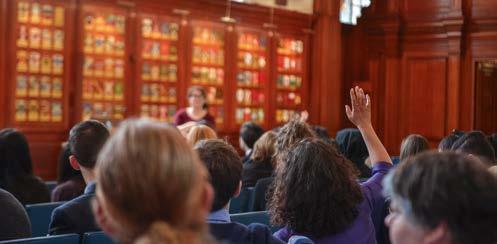
2022–23 has been a hugely exciting year for the Outreach Team, marking the first full academic year since the start of Project Pegasus, in which we were able to run in-person events at the Inn. It has been a fantastic opportunity once again to welcome aspiring barristers to the Treasury Building and showcase the Inn’s brand-new facilities.
Our Insight London event was our first Outreach event to be held at the Inn. We welcomed 69 delegates to The Inner Temple Hall, where they had the opportunity to hear from a panel of our members, each of whom were at a very different stage in their career. We had some fantastic questions from our audience members and there was a real buzz at the networking session which followed it.
This event was followed by four other Insight events held on Circuit in the 2022–23 academic year in Oxford, Cardiff, Manchester and Coventry. We also ran three online events, one of which was held in partnership with the other three Inns. We received hugely positive feedback. Ninety-Three per cent of those who completed the feedback felt they left the event with a greater understanding of how to qualify as a barrister as well as about what a career at the Bar involves. Delegates frequently reported that they felt that Insight events changed their preconceptions about a career in the Bar, and many left the event feeling that the Bar was far more inclusive than they had originally thought.
Delegates frequently reported that they felt that Insight events changed their preconceptions about a career in the Bar.
We were also extremely pleased to be able to hold in-person Discovery Days once again for sixth formers. We are proud to continue our partnership with the Sutton Trust, who run a two-year programme called Pathways to Law for those aspiring to a career in law. In 2022–23 we welcomed 287 sixth formers from the Cardiff, Exeter, Leeds, Liverpool, Leicester, London, Manchester, Newcastle, Oxford and Warwick areas. In addition, 31 Pathways to Law students joined us for an online event. Activities included the opportunity to discuss a legal case with volunteer barristers and to prepare and deliver a plea in mitigation. Our visiting students did an excellent job and our volunteer barristers seemed to have a lot of fun too!
In March 2023, we welcomed 92 undergraduate students to the Inn from universities around the country for the annual Dinner to the Universities. They had the opportunity to network and dine with 73 of our members who kindly agreed to spend their evening sharing their own experiences of a career at the Bar with our guests.
As this academic year draws to an end, we turn our attention to developing the Outreach programme for 2023–24 and there is lots to look forward to. After a brief pause following the challenges of the pandemic, we are thrilled to be re-opening applications to PASS and we will have a brand new cohort starting with us in October. We are also looking forward to piloting a Discovery Day on Circuit with the Sutton Trust. This will take place in Leeds in spring 2024.
We also couldn’t close off this article without saying an enormous thank you to all of you who have given up your time to volunteer at an Outreach event this year. In 2022–23, across all of our events, there have been 280 separate volunteer roles to fill, so we really do mean it when we say we couldn’t do the work we do without your continued generosity. Thank you!

PASS: PARTNERING WITH CHAMBERS


Since 2012, The Inner Temple has been proud to run PASS (Pegasus Access and Support Scheme) which aims to improve access to the profession and to support high achieving aspiring barristers from under-represented backgrounds by providing experiences and developing skills that will support a career at the Bar. We arrange a mini-pupillage for each participant with our partner chambers. We are deeply grateful to all of our partner chambers who accommodate our PASS Scholars for a mini-pupillage and we always welcome hearing from new chambers who would like to support the scheme.
WHO DO WE WORK WITH ON PASS?
In 2020/21 we received 153 applications and accepted 72 onto the programme which is the highest number to date. All successful applicants must attend a state nonmaintained school and meet at least one of the following criteria:
Eligible for Free School Meals when at school Be the first generation to attend university Family eligible
WHAT DO WE OFFER?
The two main components of the PASS programme consist of: A mini-pupillage with one of our partner chambers Skills workshops and webinars designed to build confidence in relation to the profession eg mock interviews, CV workshops, Q&A panels


WHAT’S THE IMPACT?
In 2018/19 over 80 per cent of attendees said the scheme had changed their perception of the Bar and barristers, and they now found the prospect of pursuing a career at the Bar more approachable and achievable. This figure demonstrates how vital it is to support students’ aspirations and create accessible routes into the profession. Feedback we received from scholars after their mini-pupillage solidified how significant PASS is in helping to build professional skills. Participants indicated that they felt more confident that they would be able to pursue a career at the Bar after PASS.

CASE STUDY
We asked Douglas Wotherspoon, a former PASS scholar, to write about his experience on PASS. Since completing PASS Douglas successfully gained a BPTC scholarship from The Inner Temple and secured a pupillage at 9 Bedford Row. Of his placement he said:
Following my successful application [to PASS], I was placed on a mini-pupillage at Ely Place Chambers. I was fortunate enough to see a wide range of chambers work from sitting with a third six pupil in Shoreditch County Court to shadowing a 27 years Call senior junior at Maidstone Combined Court Centre. Notably, I attended the High Court for an injunction hearing which was reported nationally the following day. The take-away moment for me was a piece of advice imparted outside Watford Employment Tribunal which helped shape not only my undergraduate module selection but the type of set I applied to for pupillage and ultimately my future area of practice.”
HOW CAN MY CHAMBERS HELP?
We are not able to run the PASS programme without the generous support of chambers willing to host PASS scholars for a mini-pupillage. All we ask is that you set aside a minipupillage place (or more than one if you can so accommodate!) and we will do the rest of the administration. There is no financial cost to being a PASS chambers.
We are particularly interested in hearing from chambers whose buildings are easily accessible to those with disabilities and those that are located on Circuit. Our PASS scholars come from all over the UK. Whilst we do cover scholars’ travel and accommodation costs, there can be many other reasons why a scholar might not easily be able to travel to London and so by increasing the number of placements we can offer on Circuit, this will help us to improve the accessibility of this programme.

We also welcome chambers who are able to provide virtual placements. Benefits for chambers include:
Flexible approach to dates – we do not have set dates upon which PASS mini-pupillages must take place and are happy to work within your timescales. Some chambers have specific times of year they can offer placements, others particular dates – we will liaise with PASS scholars to ensure their availability matches before allocating them. We cover all travel and accommodation costs for PASS scholars – we know that the cost of attending a mini-pupillage can be a significant barrier for many looking to pursue a career at the Bar, but we also know that this isn’t always easy for chambers to fund. Once the placement has been confirmed we will cover the costs and administration in arranging this. Matching specialism to interest – We ask all of our PASS scholars to provide us with their preferences and interests regarding specialisms. This means that wherever possible we ensure that scholars who are allocated to your chambers will have a significant interest in the area of law you practise. Reduction in administration – The Inner Temple will take on the administration of targeting applicants, reviewing applications and allocating placements. Whilst we would never allocate a scholar without your final say so, this reduces the workload for chambers. Make a difference to somebody’s chances of reaching the Bar – PASS works with prospective barristers who might otherwise find it more difficult to enter the profession.
HOW CAN MY CHAMBERS GET INVOLVED?
If you or your chambers would like to have an informal conversation regarding becoming a partner for PASS or would like any further information please contact: pass@innertemple.org.uk

INNER TEMPLE SCHOLARSHIPS
2022 BAR COURSE AWARDS
PETER TAYLOR SCHOLARSHIP
Bartek Wytrzyszczewski
STEPHEN CHAPMAN AWARD
Alasdair Johnston
PRINCESS ROYAL (5 Awarded)
Rachel Lane, Maud Millar, Lydia Pepper, Ilona Roberts, Alisha Somani
MAJOR SCHOLARSHIPS (20 Awarded)
Marc Alner, Ruari Clark, Bethany Currie, Nisha Joshi, Leo Kirby, Georgina Kuponiyi, Caitlin McLachlan, Katherine McLean, Serena Norman Thomas, Helena Nugent, Roisin Putti, Anna-Marie Robertson, William Robinson, Param Sharda, Betty Shuttleworth, Charlotte Tosti, Ilinca Tuvene, Jesler Francesca van Houdt, Satyam Verma, Henriette Willberg
EXHIBITION SCHOLARSHIPS (104 Awarded)
Zoe Adlam, Zain Ahmed, Busola Ajayi, Maleka Akuany, Katie Allen, Georgia Allen, Sheldon Allen, Andrea Ando, Jessica Ashcroft, Ravina Bahra, Ewan Baxter, Eli Baxter, Hannah Bentwood, Adam Bharmal, Molly Blain, Kinza Bungish, Ellie May Cole, Ellen Coombe, Alex Coombs, Charles Coverman, Alessandra Da Fonte, Aneeka Dhaliwal, William Dobbs, Jade Dobinson-Evans, Georgios-Nikiforos Dougenis, Maddison Dunlevy, Robert Durdin, Dara Eisen, Ronnie Evans, Dara Foody, Anthea Frank, Tuva Fried Nielsen, Charlotte Gamble, James Gamblin, John Good, Rebecca Grant, Eliza Harris, Callum Harvey-McMahon, Matthew Herbert, Stella Higham, Rhiannon Hopcroft, Caitlin Hopwood, Archie Hunter, Mara Ionita, Tusmo Ismail, Millie Jeavons, Sarah John, Iza Kashif, Ammar Kazmi, Marcus Kelly, Chon Kuong, Christopher Long, Oskar Luong, Alexa Magee, Ross Malervy, Richard Matheson, Gary Mayfield, James Miller, Devina Mohanlal, Luca Montag, Alice Morley, Avanthika Nanda Sanjay, Sophia Pascoe, Tanisha Patel, Tobias Pattison, Shanta Phillips, James Piercy, Harry Piercy, Olivia Price, Ayush Ramsooroop, Samantha Richardson, Laura Riches, John Ritzema, Michael Rivelin, Abbi Robinson, Ebony Rose, Eilidh Rowan, Geneva Roy, Sofia Santos, Hartej Saund, Lolly Sawyer, Oliver Sharman, Emily Shaw, Eva Sherratt, Matthew Sherwood, Sherrice Siddique, Aisling Sims, Rohini Singh, Charlene Smith, Gabriel Tan, Victor ten Bosch, Dylan Thakker, Nathan Thompson, Katie Tooley, Hazrat Umar, Lucy Walch, Samuel Wall, Eleanor Walmsley, Kalum Walsh-Wrigley, Jaden Whitehill, Scarlett Wilson, Katherine Wood, Chi Ying Athena, Zara Yusuf.
This year, the Inn received 387 applications for the Bar Course awards and, after allowing for withdrawals, interviewed 337 candidates over two Saturdays in March. We have awarded 131 scholarships and exhibitions, to a total of £1,465,442.00
2023 GDL AWARDS
PRINCESS ROYAL (2 Awarded)
Catherine Churchill and Joel Rosen
MAJOR SCHOLARSHIPS (4 Awarded)
Sylvia Cullen, Sam Hunt, Miranda Rafferty, Jack Sheard
EXHIBITION SCHOLARSHIPS (24 Awarded)
Atharva Argade-Miskin, Lauren Ashton, Alexander Baxter, Amy Bell, Georgia Bentley, Catherine Bentley, Hugh Binnie, Claudia Brooker, Lucy Burgin, Wai Chuen Chan, Samuel Grankin, Tamyah Jones, Lottie Kelly, Isobel Macey-Dare, Barry McTaggart, Kavita Mohanty, Amina Mujkanovic, Patrick Orme, Riona Sedgwick, George Sheldon Grun, Vita Sinclair, Emily Stone, Juliette Thomas, Qingning Zhang

This year, the Inn received 80 applications for the GDL awards and, after allowing for withdrawals, interviewed 77 candidates over 16/17 June 2023. We have awarded 30 scholarships, to a total of £185,900.
SCHOLARSHIPS QUOTES
WHAT DOES BEING AWARDED A SCHOLARSHIP MEAN TO YOU?
Betty Shuttleworth –Major Scholarship
“It is not an understatement to describe being awarded a scholarship as life-changing. Thanks to The Inner Temple, I can now take the next step in my journey to the Bar far sooner than I could have without this support. And, it is an honour to have the endorsement of The Inner Temple as I do so.”
Samantha Richardson –Exhibition Scholarship
“This scholarship enabled me to continue my journey to becoming a barrister. I am a care leaver, mental health survivor, mother and mature student. Without the help and support of The Inner Temple I would not be where I am today. I am emotional as I write this testimonial as I cannot express my gratitude enough for being given this opportunity.”
WHAT WAS YOUR EXPERIENCE OF THE APPLICATION PROCESS?
Tanisha Patel –Exhibition Scholarship
“The written application provided a lot of guidance of what was expected, and I felt the questions asked showed the Inn was interested in learning about me as an individual in addition to my academics. In preparation for the interview, The Inner Temple hosted an information and Q&A evening to answer any questions applicants had and outlined the marking criteria. During the interview, the panel made me feel welcome, and took a real interest in what I had to say.”
Rhiannon Hopcroft –Exhibition Scholarship
“Inner Temple were so welcoming and helpful during the whole process. At no point did I feel frightened, overwhelmed or really stressed. It was an incredibly good experience.”
Scarlett WilsonExhibition Scholarship
“The application process was clear and relatively simple. Applications can often seem convoluted for no particular reason. The Inner Temple scholarship application was clear and concise. This proved to me that The Inner Temple wanted the applicants to succeed. There were no red herrings or needlessly complex questions. I felt that the application genuinely wanted to know my answers to each question. This was extremely refreshing.”


WHAT WAS YOUR EXPERIENCE OF THE SCHOLARSHIP INTERVIEW?
Maleka Akuany –Exhibition Scholarship
“Very pleasant and I always appreciated how the Inn was transparent about what to expect. My interviewers were all welcoming and accommodating.”
Maud Millar –Princess Royal Scholarship
“My experience of the scholarship interview was both challenging and rewarding. Preparing for the interview, reading through published judgments, and discussing complex legal issues with the panel of interviewers were all invigorating experiences that further solidified my commitment to a career at the Bar. On the day, the panel’s diverse backgrounds and expertise added to the richness of the conversation, and their insightful questions made the experience intellectually engaging.”
DO YOU HAVE ANY TIPS OF FUTURE CANDIDATES?
Zoe Adlam –Exhibition Scholarship
“Give yourself enough time with your application as there is more to it than answers so give your references time to respond and edit your answers, so you’re submitting the best form possible. Better to give yourself more time than necessary than to rush the process. Prepare for your interview like an exam – make sure you know your form because you will be asked about it and use the criteria like an exam mark scheme to think about what questions they may ask you.”
Rhiannon Hopcroft –Exhibition Scholarship
“Relax! I truly believe that a calm mindset helped me gain my scholarship. My nerves were calm which allowed me to think clearly and ‘perform’ to the best



QUALIFYING SESSIONS ROUND UP

The Pre-Pupillage team has been exceptionally fortunate over the course of the 2022/2023 academic year to have the help and expertise of a wide array of member volunteers. This year’s QS programme has covered a diverse range of topics and we would not have been able to put together such a varied set of sessions without a dedicated roster of practitioners and judges in place to shape and support them.
The Qualifying Sessions programme for 2022/2023 followed on from the lessons learned in previous years and was consequently held across a variety of platforms, with sessions held in person, online or in hybrid working formats. The department has worked harder than ever to ensure that student members from outside of London are able to access educational events as easily as those living in London, and we consequently held a variety of Circuit-focused sessions online, as well as all-day in-person events at regional hubs in Liverpool, Leeds, Birmingham and Cardiff.
The department has worked harder than ever to ensure that student members from outside of London are able to access educational events as easily as those living in London.
Of particular import, the Inn’s three annual residential weekends rolled out in a different way this year, with the May event – typically held at Crewe Hall – instead moved to the Inn itself, owing to booking clashes surrounding the coronation. The May event, titled ‘Money Laundering’ and concerning financial crime, was the first time a student residential weekend has been held onsite at the Inn, with students and volunteers encouraged to stay at a nearby hotel to add to the sense of residential community. Student feedback on the Inn’s facilities and the overall teaching provided was extremely positive and we are particularly grateful to Master Robin Sellers for organising this event. Running a weekend in an entirely new way has given the Qualifying Sessions committee the opportunity to look into residential weekend formats more broadly for the future and consider what programme and location changes might result in more effective and enjoyable educational content.
A few additional highlights of the year included an exceptional series of EDI-themed panels, including the interactive ’Tackling Harassment’ event, the always-popular online Ethics trainings run by Master Charles Bagot and Master Zachary Bredemear, Master Alistair Hodge’s exceptionally engaging Mooting Masterclass, and the series of excellent lectures held as part of both the Reader’s Lecture Night and Social Context of the Law series.

The Education and Training Department is hugely grateful to all its Bencher and member volunteers, whose time and assistance has been completely invaluable to the running of this year’s Qualifying Sessions programme.
Julia Armfield Education Programmes Manager (Pre-Pupillage)
CIRCUIT EDUCATION DAYS
Our Circuit Education Days give students an opportunity to gain three Qualifying Sessions in one day at a city centre close to their Bar Course Provider. This year the Education Days were composed of an Advocacy Talk (“Ten Ways to annoy a Judge” written by Master Timothy Petts), one-to-one CV and interview sessions with the students,
Birmingham
Held at the Birmingham Malmaison Conference Facilities.
With thanks to HHJ Louise McCabe for delivering our Advocacy Talk, Baldip Singh Aulak for leading the EDI discussion, and to Terri Mason, Eliza Sharron, Dan Tresigne and Ali Tabari for also supporting the CV reviews and mock interview sessions.


Liverpool
Hosted by Master Samantha Hillas at St John’s Buildings.
With thanks to Master Hillas for delivering the Advocacy talk, Nardeen Nemat for talking to the students about Equality and Diversity at the Bar, and to Peta Harrison and DJ Natalie Cuddy for assisting with the students’ CV and interview sessions.



and an Equality Diversity and Inclusion discussion. Many of our sessions were hosted by local chambers for the first time this year also. This gave our Bar Course students a wonderful opportunity to visit a chambers and meet with practitioners in a professional but still informal setting.
Leeds
Hosted by Ashley Lord and Reagan Persaud at Spire Chambers.
With thanks to Ashley Lord and Reagan Persaud for leading our day, delivering the Advocacy and EDI talks, and to Sam Roxborough for providing additional assistance with the one-to-one sessions with the students.



Cardiff
Hosted by Master Rhys Taylor at 30 Park Place.
With thanks to Master Timothy Petts the author and (on this occasion) speaker for our Advocacy talk, Sara Rudman for leading the student discussion on EDI at the Bar, and to Master Rhys Taylor and Jonathan Rees KC for also assisting with the one-to-one mock interview sessions.


We look forward to visiting Nottingham, Newcastle, Manchester and Bristol next year to run our Education Day programme in 2024. If you are interested in being involved, please contact Kerry Upham at kupham@ innertemple.org.uk
FAMILY FINANCE INNER TEMPLE STUDENT
WEEKEND AT CREWE HALL
10–12 February 2023

Over the weekend of 10–12 February 2023 some 56 students of the Inn and a posse of its judges, silks and barristers descended on Crewe Hall, a large, imposing Jacobean mansion just outside Crewe in Cheshire which is now a hotel and spa, to learn about and discuss current issues in family finance law at a weekend organised by Samantha Hillas KC and Paul Infield.
Financial relief on divorce is still guided by the Matrimonial Causes Act 1973, a statute which was passed exactly 50 years ago. It defines what courts can and cannot do but it provides little guidance on what result they should attempt to achieve. As every case falls to be decided on its own individual facts, it can be difficult to identify general guiding principles from the case law which will assist the parties to a divorce in accurately predicting how a court will deal with their particular case. The House of Lords endeavoured to provide some guidance by way of broad statements of principle in the landmark cases of White v White and Miller v Miller; McFarlane v McFarlane, but always under the shadow of the legislation’s direction to the court to consider “all the circumstances of the case”.
Although the decisions of the House of Lords in White and Miller/McFarlane sought to provide a greater degree of coherence to the driving principles the courts should apply, the judicial discretion exercised in financial remedy proceedings remains extremely broad and, in practice, often difficult to predict with any precision. There have been judicial cries for a more predictable system, but any system which limits judicial discretion too far is likely to result in complaints of injustice in ‘hard cases’. The next few years are likely to see considerable debate, both inside and outside the courts, as to how the current system should develop and whether it requires wholesale legislative reform. The tension between ‘predictability’ and ‘fairness’ is likely to be at the heart of this debate.

Over the last 30 years family finance law has expanded massively from a by-water of divorce law into a speciality of its own, and its cases are regularly reported in the press. It is often controversial, with former spouses often complaining that the ‘system’ is unfair, that it gives too much to the other party, that it gives too much discretion to judges, and that it costs too much.
Over the last 30 years family finance law has expanded massively from a by-water of divorce law into a speciality of its own, and its cases are regularly reported in the press.
The problem of dividing one family cake into two has always been an exercise that would have strained even Solomon’s ingenuity, but it is often complicated by issues such as children being educated at private school, the division of pensions (some of which may be defined benefit schemes whilst others are defined contributions ones), the earning capacity of women who have given up or interrupted careers to look after children, and hidden or allegedly hidden assets.
What results should financial relief on divorce attempt to achieve? And how should it carry out that exercise? Is the current system fair or ‘fit for purpose’? Those were some of the issues that we attempted to cover during this weekend.
The weekend began on the Friday evening with a talk by Mr Justice MacDonald (a welcome regular at these events) who gave us a tour d’horizon of some of the issues that affect this area of law.
On the Saturday morning we had a panel of experts in this area – Mr Justice MacDonald, Rhys Taylor of 36 Family, Stephanie Coker of 5 St Andrews Hill, and Ros Bever, a partner at Irwin Mitchell and the Head of its Family Law Team in Manchester – discussing current issues raised in questions both from me in the chair and from students. We dealt with questions such as whether the financial remedy regime in the Matrimonial Causes Act 1973 is fit for purpose; whether financial relief proceedings are biased against men; whether pension sharing orders work well; the philosophy behind Part III of the Matrimonial and Family Proceedings Act 1984, and whether it works satisfactorily in relation to foreign jurisdictions; whether it is right that animals are merely treated as chattels in family finance proceedings; the differences between the way in which the law treats married and unmarried people; whether our current laws for cohabitants are fair and practical and, if not, how they should be changed; whether the Family Procedure Rules are fit for purpose and, if not, how they should be changed; the delays in the family courts; and the difficulties of dealing with Litigants in Person in the family courts. It proved to be a very lively session with some vigorous discussion and some interesting disputes.
The students then spent some time preparing for the Advocacy Exercises after which they had a masterclass in advocacy from Ashley Lord of Spire Barristers and Master Malek Wan Daud of Garden Court Chambers, using the same case that the students were to use to in their Advocacy Exercises on the Sunday. As always, it was both amusing and instructive, with District Judge Nat Cuddy, in particular, showing us that comedy performances are not the monopoly of actors. There followed a session in which the students wrestled with some Ethics Exercises in their groups.

After dinner there was the much-famed quiz, a devilish test of knowledge that has become something of a tradition at these weekends. Assisted by liberal amounts of alcohol and a quizmaster who made Pointless look like University Challenge, the participants struggled through several rounds of mindbending questions at the end of which one of the tables won. I forget which.
The Sunday morning was marked by several bleary-eyed, pale students (and a couple of group leaders) trying to remember the name of the capital of the Ivory Coast. But they were soon thoroughly awoken by the Advocacy Exercises for which they had spent several hours preparing the previous day. The case was a financial dispute between the couple whose disputatious divorce has long entertained The Inner Temple students at these weekends: James William Bond and Jane Bond (now Moneypenny). The main issues concerned whether the wife was now cohabiting with Mr Auric Goldfinger (an issue on which the private investigator, Ernst Stavro Blofeld gave evidence) and whether the husband had underdeclared his earnings from his job as a car salesman. All the students were able to perform some advocacy role – either a speech, an examination in chief, or a crossexamination – and the judges then gave a short judgment followed by some pointers for improvement of the advocacy. Students often ignore our invitations to give feedback on these weekends and on Qualifying Sessions in general. But this weekend was different. We had an unusually large amount of feedback, almost all of which was positive. The weekend was described as “tremendously helpful and well organised” and “a very productive weekend”, and students said that they “learned a great deal”. As generally happens at these weekends, the mixture of hard-edged discussion about real legal issues led by judges and practitioners, the opportunity to socialise with judges and members of the bar, and the informality of the event, was very well received by the students.
Paul Infield 36 Family Master of the Bench
Samantha Hillas KC St Johns Buildings Barristers Chambers Master of the Bench
THE ESTABLISHED BARRISTERS PROGRAMME

Education has always been a vital function of the Inn and what it does for its members, and the re-opening of the Treasury Building last year with our new suite of training rooms has brought this to the very heart of the organization.

In the past however, our provision has traditionally focused on the compulsory training required by student, pupil and newly qualified members as they embark on their careers at the Bar, with far fewer training opportunities beyond the first three years of practice. As any barrister will attest though, learning does not simply stop after these early years at the Bar, and honing skills and keeping knowledge up to date is vital. While The Bar Standards Board (BSB) requires practising barristers to complete and record some Continuing Professional Development (CPD) each year thereafter, high quality training can be difficult to come across.
As part of the Inn’s commitment to making its educational function and facilities available to all members, we are developing a new programme of training events and activities solely for established practitioners. These will sit alongside its long running training sessions on handling vulnerable witnesses, and for those wishing to become pupil supervisors or advocacy trainers for the Inn. We also provide ongoing training for advocacy trainers, such as the session on teaching Case Analysis in June, led by Master Grahame Aldous and Master Ann Ainslie-Wallace, visiting us from Australia.
The Established Barristers programme commenced in January this year and has seen a broad range of events – online and in person – focusing not just on skills for members to use in the courtroom, but also more general topics of use to help manage their practice, wellbeing and develop their careers. The sessions so far have been as follows:
Dealing With Distressing Material/ Secondary Trauma at the Bar
An online panel event featuring practising barristers (Selva Ramasamy KC and Thomas Coke-Smyth) and qualified therapists (Judith Kark and Mary Jackson) which considered how to look after yourself when dealing with cases that involve distressing material and situations, how to identify if they are impacting you in the long term, and how to reduce this impact in a safe and constructive way.
“Beyond The Ten Commandments” – Advanced CrossExamination
More than 40 years after its publication, Irving Younger’s The Art of Cross-Examination (1976) is still one of the best-known and most respected studies on the subject, and his filmed lectures are still used in advocacy training around the world. This entertaining and interactive session with Master Alistair Hodge took each of Younger’s “Ten Commandments” of cross-examination to new levels, providing tips and guidance on advanced cross-examination in both civil and criminal jurisdictions.
Careers Development Panel Session
An online panel discussion session which drew on the experience of our members to give advice on moving chambers and practice area, applying for silk, applying to be a recorder, moving to the Bench earlier than usual, and advice on ‘playing the long game’ – what career decisions to make now to fit in to a long-term plan. The panel comprised Masters Azib, Clarke, Matthewson, Petts and Wood, as well as Daniel Sheridan and District Judge Denise Saunders.
 Vulnerable Witness Training
Vulnerable Witness Training


Communication Skills for Barristers in the Workplace
These practical workshops with professional actors, provided practitioners with the tools and techniques to strengthen their vocal range and quality, manage body language and non verbal signals, control their nerves and help manage stress levels, and build confidence in communication. There were separate groups for those looking to identify and iron out long established bad habits, and those looking to rebuild confidence on returning to the Bar after time away from practice.
The Parole Board: A Force for Good, or Under Siege?
A talk given by His Honour Nicholas Coleman, explaining the role of the Parole Board, reviewing how members of the board approach their task by investigating the risks presented by a prisoner, and considering whether its role may be undermined by ill-considered political decisions and/or public pressure. The talk touched on the cases of Pearce and Bailey, as well as the recent High Court judgement that last year’s hearing reforms by the Lord Chancellor were unlawful.
Accounting and Saving Tax, Mortgages and Financial Planning
A seminar with presenters from Silver Levene Chartered Certified Accountants, Henry Dannell Mortgage Brokers and Fleet Street Wealth, giving information on how to plan financially for now and the future. The speakers touched on how to plan ahead for tax payments, saving tax with pension contributions, recent changes to the Judicial Pension Scheme and how to navigate low-income years for mortgage purposes.

AI and the Law
This fascinating talk by Master Kay Firth-Butterfield explored current developments in AI technology across the globe. While there are extreme benefits from this new development in AI, there are also significant dangers, not least the ever more convincing disinformation affecting our social and political processes. The legal profession will not be immune from the potentially explosive effects of these new technologies, not least in the work they will create for lawyers trying to bring some order to the way these machines operate. The talk suggested ways in which we can harness the best and prepare for the worst of a technology which is like no other.

The sessions so far have been well attended and received by members, but we are keen to ensure that they continue to be as useful and relevant as possible. To that effect, in June the Inn launched its first online survey for established barristers, to canvass their opinion on what would appeal and be most useful to them in terms of ongoing training.
The survey was open until the start of the summer break, and at the time of publication, the results were being studied and analysed to feed into our future planning. If you missed the survey however, it is not too late to let us know what you would like to see on the training programme, or even to volunteer to participate in events yourself – please get in touch with David Miller in the Education Department.
Events currently planned for the autumn term in include a talk on 14 September 2023 entitled Good Practice When Working with Trans People in the Legal System and Courts, and a full-day conference on 25 November 2023 on open source and usergenerated evidence, their authentication and admissibility, and how they have been used in the courtroom globally and in the UK. Issues of accountability and disinformation will be examined, as well as the likely impact of AI on user-generated evidence in criminal proceedings. The day will feature a keynote speech from Eliot Higgins (Bellingcat).
Case Analysis Training AI and the Law
INNER TEMPLE STUDENT SOCIETIES
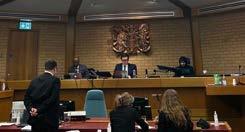
DEBATING SOCIETY
By Colleen Cumbers and Konstantina Nouka (Co Presidents)The Debating Society has had a busy year! We have been able to get back to more in person events without the disruption of last minute changes to COVID-19 restrictions – though train strikes have still kept us on our toes!
We started off the year with an in person social at Pegasus Bar. Plenty of bottles of wine were consumed whilst we chatted to members, new and returning, about the various competitions we had planned for the year. We also started up our weekly debating sessions again, opting to keep these on Zoom to allow members from all over the country to benefit.
We wasted no time in entering our members into a range of competitions. From Durham to LSE, Southampton to KCL, our debaters have been showing off their skills around the country. Internally, we hosted the Rawlinson Cup, which culminated in a very successful final in The Inner Temple, with students picking up a Qualifying Session point for observing the four talented finalists compete in front of a panel of Benchers. A special congratulations to winner Michael Rivelin. We are currently in the knock-out rounds of the Public Speaking Competition and the Debating Shield, both of which are proving equally thrilling. Alongside the competitions, we have ensured that our members are getting the chance to prepare for pupillage applications – with weekly sessions focusing on interview preparation during the pupillage application period – and to unwind – with a Christmas Quiz, post Pupillage Gateway drinks reception in the Luncheon Room, and our upcoming Summer Party, which we are co hosting with ITSA and the Mooting Society.
We are looking forward to an exciting summer, with a talented team of debaters representing The Inner Temple at the Inter-Inns Debating Competition – which we, of course, expect to win! – and the finals of the Public Speaking Competition and Debating Shield.
We would like to thank our committee for their hard work over the year, and our members for their enthusiasm for debating.

INNER TEMPLE STUDENTS’ ASSOCIATION (ITSA)
By Georgia Banks (President)This academic year, ITSA has adapted in a post pandemic world and done its best to accommodate both in-person and remote attendance at events. This has allowed us to ensure our events continue to reach members based both in London and further afield.
The academic year began with a Welcome Event held at the local pub with an encouraging turnout. Although festive spirits were slightly dampened by rail strikes and stormy weather, we were pleased to return to hosting our Christmas Party at The Inner Temple Treasury Building and hope to continue doing so for many years to come! As always, ITSA Burns Night did not disappoint. It was our most successful in person event, with more than 150 attendees enjoying a traditional Scottish dinner and Ceilidh. In March, we entered a team into an Inter-Inn Charity Netball Tournament. ITSA, in a team combined with Middle Temple, won the competition. Most recently, we joined forces with the Debating and Mooting societies to host a joint Summer Party for student members in the Courtyard.
ITSA has continued in its goal of contributing to wider access to the Bar. In January, we hosted five pupillage application panel events focused on different areas of law. These events were open for all Bar students and were hugely popular. Both junior and senior practitioners very kindly gave up their time to assist hundreds of applicants by giving advice on the application process and answering questions. In May, ITSA hosted an online post-application cycle panel event specifically for individuals from minority groups providing advice on dealing with rejection and preparing for future applications. In what is now a yearly tradition, we also held an informational event for Bar Scholarship applicants, which was attended by more than 200 potential scholars. We hope to continue in this goal by hosting an in-person Welcome Event both in London and on Circuit in the new academic year.

Finally, as a student society, we are always looking for ways to help students find ways to develop their skills and experience in their route to the profession. In that vein, ITSA is launching a new annual Essay Competition in the new academic year that will be open to all student members of The Inner Temple. Alongside other prizes, the winning essay will be published in the Yearbook next year and highly commended essays will be published on the ITSA website.
 The Southampton National Moot
The Vis International Commercial Arbitration Moot Team
The Southampton National Moot
The Vis International Commercial Arbitration Moot Team

MOOTING
by Megan Bithel-Vaughan (President)A central focus for the Mooting Society this year has been to increase accessibility and opportunities for our student members.
As such, we have run training courses for novice mooters, formed of four sessions: Introduction to Mooting, Legal Research, Skeleton Arguments and Oral Arguments. These have aimed to improve members’ confidence. Each syllabus has culminated in students participating in, or observing, a moot. This has included a Speed and Training Moot, aiming to give participants the opportunity to practice in an informal environment, as well as partnership moots against Pepperdine University and Notre Dame Law School.
We doubled the capacity of our flagship Lawson Moot, offering 128 student members the opportunity to compete in a five-round knockout competition. We would like to thank all our judges for their feedback, and congratulate our winner, Ruari Clark, and runner-up, Katie McLean.
The Ecclesiastical Law Moot was expanded this year to student members of all Inns. We thank the Ecclesiastical Law Society for the generous sponsorship and congratulate Hugh Jeffrey for winning this competition.
The Commercial Law Moot ran for the second year, kindly sponsored by One Essex Court. From a highly-talented pool of 32 participants, Nicole Terry triumphed.
DRAMA
The Drama Society kicked off the academic year with our annual Christmas pantomime, Rumpolestiltskin: Legally Conned, written by Spike Western, Taylor Blair and Nicole Terry, and directed by Nicole Terry. This legal take on Rumpelstiltskin saw singing, dancing, laughter, and creative use of contract law to defeat the villain throughout three fabulous performances in The Inner Temple’s newly-built lecture theatre from 6–8 December.
In the spring, following the transfer of a number of committee roles, the Society put on its first Spring Show since COVID-19, with a performance of two burlesques of some of Shakespeare’s most famous works. Rosencrantz and Guildenstern, A Tragedy by WS Gilbert and The Cup of Cold Poison, or Romeo and Juliet: A Travestie, by Andrew Halliday, both directed by Paul Goddard, were staged in the Temple Church Courtyard on 22 and 23 May. Both cast and audience got lots of laughs out of the Society’s fanciful and fun-filled take on these comedic parodies.
Following our sold-out run at the Edinburgh Festival Fringe in 2022, the Society is thrilled to be returning to the Festival this August to perform an all new, original play at the Ukrainian Community Centre from 17–19 August. Sanctuary by Debra Stanislawski and Nicole Terry follows a pupil barrister down the rabbit hole the night before her first trial on her feet. Through encountering Wonderland-esque personifications of her own insecurities and selfassurance masquerading as members of the profession, she gains the confidence to advocate effectively for her first client.
The Intervarsity Moot Competition included 18 universities attending the Inn to compete in a one-day knock-out competition. We thank 4 Pump Court and 6KBW for their generous sponsorship, and congratulate the University of Law for winning the competition. It was a pleasure to showcase the incredible facilities and opportunities that being a member of The Inner Temple offers.
We have also sent teams to 16 external competitions, both nationally and internationally.
Our Vis International Commercial Arbitration Moot team competed in Vienna, and the Telders International Law Moot team mooted in the Hague. Congratulations are also owed to our International Criminal Court Moot team, who reached the Quarter Finals in the Hague. Notable national achievements include: Gabriella Cutts and Tomas Higginson won the 4 Pump Court Pride Moot, Guy Lockwood and Carina Wong were runners-up at the University of Leicester Medical Law Moot, and Wiktoria Doniec and Jack Staples-Butler reached the Final of the Southampton National Moot.
This year’s increased participation has demonstrated the talent and formidability of The Inner Temple student members in mooting, skills which we hope they will carry into their future careers.
RACIAL EQUALITY SOCIETY
The main aim of the Racial Equality Society (RES) is to improve the representation on the Bar of ethnic minorities. We work with other societies in order to achieve this. To be a member you have to identify as an ethnic minority, though our main events are open to all. We have had an eventful year.

We are particularly grateful to Grace Brown, Sharnade George, Barbara Mills KC, Julius Nkafu (FCIArb), Master Tunde Okewale, Kitan Ososami, Master Leslie Thomas and the Student Engagement and Support Committee.
27 and 30 September 2022: We had two introductory evenings for members from all circuits in attendance.
25 October 2022: We had an event ‘Black History Month: Health and Wellbeing’.
24 January 2023: We had an event ‘Pupillage Applications 2023: Ethnic Minorities’.
22 May 2023: We took part in an ITSA-led event – ‘Minority groups at the Bar’.
28 July 2023: Wellbeing: Path to the Bar.
The Master with oversight of RES is Dr Tunde Okewale MBE. The current President is Kofo David, the Vice-President is Tahmina Miah, the Secretary General is Pearl Annin, the Social Media Officer is Rebecca Mckenzie and the LGBTQ+ Officer is Ogeh Obioha.
CALL TO THE BAR


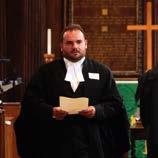



“Being called in the beautiful and historic Temple Church emphasized both the prestige and responsibility that accompanies being called to the Bar. As Master Treasurer noted, this is a pivotal location in English legal history, where the barons confronted King John in 1215, leading to the signing of Magna Carta. Alongside this, the organisation of the ceremony was flawless. My family and I had a fantastic evening!”
Alastair Bloor


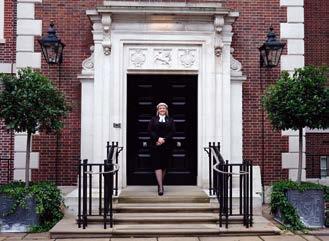

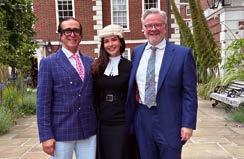
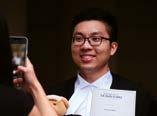

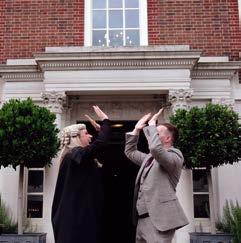

“I cannot put into words how special the Call ceremony was. The Inner Temple was most certainly filled with excitement and anticipation, as we made the transition from law students to barristers. It’s a day I will never forget.”
Creanna Dodson
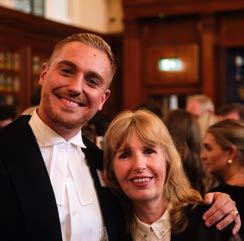
“My Call to the Bar was an amazing and surreal experience and I loved the whole event celebrating this achievement with my family. I will always remember this day and without doubt my most proud moment was being pronounced a barrister.”
Aleshia Manktelow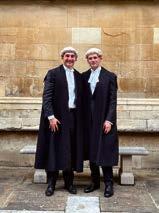


ADVOACY PUPIL PRIZE FINALISTS
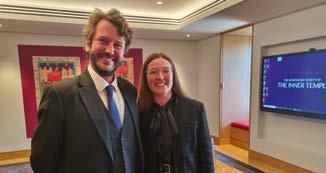 ALEX RYLE
ALEX RYLE
Second Six Pupil
5 King’s Bench Walk, Chambers of Sarah Forshaw KC and Mark Heywood KC
Anyone that thinks they have experienced a steep learning curve should step into the shoes of a secondsix pupil on their first day on their feet. Everyone’s mileage will vary, but it is safe to say that the mixture of excitement, apprehension, and pressure is unique. Having spent hours in the classroom, secured pupillage and spent six months absorbing the advocacy of others, the moment arrives. Silence falls in the courtroom (or, as much silence as there ever is in a regional magistrates’ court). The Judge (or, more likely, the chairperson) turns to face you. “Yes, Mr Ryle.”
How is one to prepare for the moment when the balloon goes up? If you are lucky, as I have been, and are at a chambers that is not only hugely supportive but also provides a brilliant and comprehensive pupillage advocacy training programme of its own, you are already on the right track.
The Inner Temple Pupils’ Advocacy Programme rounds out and expands that other training, finding yourself outside your usual chambers safe space where every face is familiar.
A key skill in practice is to engage with strangers in the shortest time. Moments after meeting one another, we begin with large group case analysis sessions. Those proved invaluable on two levels: for the sparking of ideas
between all the participants, and the chance to meet others of the same level from a colossal range of disciplines. Each barrister has their own method of case preparation, and at this stage all of us are casting around for ideas that may, or may not, work for us. It would be a mistake to think you can only learn from those more experienced than you are. I picked up many valuable tools at these sessions, which I am using in practice as I write. • • • • • •
The Wotton House residential weekend is the culmination and highlight of the course. Having got to know the other pupils, we are all thrust into a fast-turnaround series of workshops, and now it is the new trainers that are strangers to us; at least until the end of the first morning.
It seemed we pupils were outnumbered three-to-one by generous practitioners who had given so freely of their time; many coming straight from court and heading straight back there on the Monday morning. I am sure I speak for all when I say I am hugely grateful to each and every one of them.
Watching yourself on video is an uncomfortable experience, but vital to iron out problems, and to properly assess your advocacy. Dual reviews held for each exercise, live and recorded, also brought the benefit of differing perspectives, with each trainer’s different style and approach.
• • • • • •

Applications day pushed and pulled together the skills practised on the residential weekend with the drafting and presentation of skeleton arguments. A notch closer to the reality of being on your feet in court, with the additional requirement of creating a careful roadmap to support and enhance your argument.
Finally, stepping into the hallowed halls of the Royal Courts of Justice for the mock trials was the second finale of the course. That trial pulled all of the threads together, in real time, in front of a High Court Judge. It was enjoyable, educational and vital in equal measure.
My view has always been that you should learn to be good before you learn to be quick. This comprehensive training worked on precisely those lines, slowly increasing the pressure of time and rapid judgment, as we worked through the exercises. It boosted my confidence and skills and introduced me to many new faces; from the vastly experienced, to those at my own level.
A few weeks later, I found myself defending a short hearing in the Crown Court. It transpired that I was to be prosecuted by my opponent from the mock trial. A small, happy reunion. Ultimately, that for me is what the Bar is all about. The people. It has been a privilege to spend time with a group of such obvious (and faintly terrifying) talent and ability. I look forward to practising alongside them for years to come.
The Finalists – Alex Ryle and Christine O’Connell

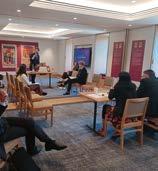
 CHRISTIE O’CONNELL
CHRISTIE O’CONNELL
Advocacy Pupil Prize Finalists
Attended the Inn’s Pupils Advocacy Course in October/November 2022
During the non-practising component of pupillage, pupils are required to complete an advocacy course with the aim of preparing pupils to be ‘on their feet’. Those undertaking pupillage in London and the South East would ordinarily complete a course offered by their Inn. The Inner Temple offers two courses, and I completed the October/ November course. Each inn structures its course differently, but at The Inner Temple, it is spread over several weeks and combines several evening sessions with a residential weekend.
The first few sessions were held in the Inn’s new education and training facilities and focused on preparing us for making closing submissions/speeches and case analysis in both the civil and criminal arenas.
Residential Weekend
The next phase of the advocacy programme saw us travel to Wotton House in Dorking for a residential weekend jam-packed full of activities and training sessions.
After we arrived on Friday morning, we were put into groups of six and sent into our breakout rooms for a session with a trainer from the London Academy of Music and Dramatic Art. Our trainers gave us tips and tricks on how to use acting and presentational
skills to improve our advocacy delivery. Everyone had prepared a three-minute presentation entitled ‘Something that inspires me’. Topics in my group were wide-ranging and included everything from grandparents to pet dogs. I spoke about the rise of the Lionesses during the Euros and the inspiring work they have done for women in football.
After lunch on Friday, we gathered as a whole cohort to listen to presentations on Cross-Examination and preparing skeleton arguments. The day was concluded with an informal dinner in the Evelyn Suite, followed by drinks in the Library Bar.
Saturday started bright and early with an 8.00am breakfast call. We then split back into our groups to get into the nitty-gritty of showing off our skills in delivering closing speeches and witness handling. We were given the opportunity to act as witnesses for other pupils in our group and practise on each other. We received feedback using the Hampel method, a six-step methodology used to give a trainee advocate feedback on a specific area of their performance. The stages include headnote, playback, reason, remedy, demonstration and replay. Each group had one trainer who stayed with them throughout the weekend, and also a roaming trainer who would review a video of your performance and give you further feedback.
On Saturday evening everyone gathered for dinner in the 1877 restaurant. We were thrilled to be joined by The Inner Temple’s current treasurer, Sir Robert Francis KC, who delivered the talk that evening. The night finished with drinks in the bar area. The final day of the residential weekend started with the opportunity to replay our closing speeches from the previous day in our groups, giving us ample opportunity to implement everything we had learnt over the course of the weekend. Then, after a few more witness-handling sessions it was time to head back to London.
Mock Trial
The advocacy training course culminated in an evening of mock trials held in the Royal Courts of Justice. We were given a completely new case in which Bar Course students were brought in to play the witnesses. It was a great opportunity to show off our development and receive some final feedback from our esteemed judges. Overall, the advocacy course was an invaluable experience as it provided the perfect opportunity to develop my skills in an environment where it was acceptable to make mistakes. I finished the programme feeling more confident in my advocacy ability and ready to tackle my Second Six.
HELP WANTED

The education and training provided by The Inner Temple would not be possible without the support and commitment of members, who give up their time to support a wide range of activities including Outreach, Scholarships, Qualifying Sessions and training for pupils and barristers.
WHY IS IT IMPORTANT TO VOLUNTEER WITH THE INN?


Name: Charles Bagot
Volunteers with: Qualifying Sessions, Student Societies, Advocacy Training, Ethics Training, Outreach events, PASS
The secret is that you get out of Inn volunteering as much as you put in. However busy I am, taking a couple of hours out for an outreach event, a mock trial or similar is refreshing and rewarding. You are reminded how fortunate you are to be practising at the Bar and how many people aspire to do so. The insightful questions you are asked by attendees give a valuable opportunity to take stock on your journey to the Bar and your career so far. Why did I choose this/that path; what makes a successful practitioner in such-and-such field; how did I/do I cope with the inevitable setbacks and bumps in the road? Considering and answering varied questions gives a valuable opportunity for some introspection and planning which don’t arise much in the maelstrom of a busy practice. There is vital work to be done to attract and retain a more diverse range of practitioners which genuinely reflect the clients accessing the legal system; so do get involved!


Name: Alastair Hodge
Volunteers with: Qualifying Sessions, Student Schemes, Student Societies, Advocacy Training, Continuing Professional Development
It is essential. As with any other profession, the Bar must deliver, and be seen to be delivering, the best service to its clients and only the continual refreshing of skills and knowledge can achieve this.
We asked some of our members who have helped us from this year to share their experiences of volunteering with us.


Name: Stephen Akinsanya
Volunteers with: Qualifying Sessions, Scholarships
It is absolutely vital to support the Inn as a volunteer. It is a great way of encouraging the next generation of barristers who perhaps are not so confident, or are looking to gain experience from senior practitioners. Working with students and newly qualified barristers keeps one’s advocacy fresh and also connected with the Inn and peers. I enjoy the opportunity to share my own journey as a source of inspiration to those coming behind me.


Name: Geoffrey Payne
Volunteers with: Qualifying Sessions, Student Schemes, Advocacy Training
Volunteering at the Inn is a very great privilege. It is an opportunity to help develop and shape those who will, in turn, come to develop and shape the future of the Bar. It is a real joy to watch students improve, even over the course of a weekend, and to encourage those coming into the profession to be the best they can be. From a selfish point of view, as a relatively newly appointed Circuit Judge, it offers me the chance to stay in touch with practitioners. As a recipient of a scholarship from the Inn and a beneficiary of past advocacy training, it also offers me a chance to contribute something to the future.
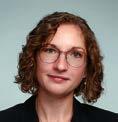

Name: Sharin Diegan
Volunteers with:
Advocacy Training, Outreach Events, Ethics Training
On my first advocacy training weekend for pupils I received positive feedback from Master Martin Griffiths following a session I had taken the lead on – it put into focus the personal benefits of volunteering and how much we stand to gain from giving up our time.


Name: Reagan Persaud
Volunteers with:
Qualifying Sessions, Student Schemes, Outreach Events, Continuing Professional Development
It is about seeing the students grow in confidence and realise that they are good enough to be barristers, irrespective of their backgrounds. It is about making the Bar more accessible. This process makes the volunteering worthwhile.


Name: Darren Dunn
Volunteers with:
Qualifying Sessions, Student Societies, Advocacy Training, Outreach Events
Outreach to sixth formers – seeing a group of teenagers, initially hesitant to engage in discussion on an ethical conundrum, gain confidence so that by the end of the session they were actually surprised at what they now understood and what/how they have advocated a position.


Name: Daniel Sheridan
Volunteers with:
Advocacy Training, Continuing Professional Development
Advocacy is a skill and an art that changes and evolves in line with an individual’s level of experience. It was an opportunity to share with a student barrister the knowledge that the nerves and anxieties we control and manage, with skill and experience, have always been present. Indeed, the mutual realisation, in discussion, that those feelings can fuel our performance and make us better advocates was a great learning moment for me and created a huge sense of ‘connect’ to the learning process.


Name: Rebecca Dix
Volunteers with:
Qualifying Sessions
It is extremely rewarding when a pupil from over 20 years ago remembers the encouragement given to pursue their career, they appreciated the time taken to give them the confidence to carry on and secure pupillage – now a successful barrister in a top set.

USA
By Chloe Ashley, No 5 ChambersOver the course of the four-week Scholarship, I was exposed to all aspects of the American political and legal systems. I attended SCOTUS to hear oral argument challenging President Biden’s student debt relief plan. According to the most recent figures, the typical undergraduate student now graduates with nearly $25,000 in debt, which rises to approximately $165,000 in a profession necessitating post-graduate study, like ours.
Observing the exchange between the Solicitor General and the Justices from my mahogany pew was fascinating –albeit far more interventionist than anticipated. It reminded me why lawyers in the States place such emphasis on mooting: it is excellent preparation for the real job. Attending court that day was truly a highlight of the trip.

I also took a tour with several of the other Justices’ clerks. We were able to touch on the differences between our two legal systems and, perhaps predictably, discussed the merits of wearing wigs and gowns. Needless to say, they were somewhat taken aback when I robustly defended our (perhaps rather unusual) uniform and I hastened to point out that the Solicitor General, Elizabeth Prelogar, had just made her arguments in morning dress!
I also had the privilege of meeting with lawyers at the Department of Justice and took a tour of the main building on Pennsylvania Avenue. Its interior was steeped in history and filled with specially-commissioned artwork focused on themes pertaining to the administration of justice The lobbies, corridors and library boast original murals from the 1930s and ‘al-u-minium’ adorns the fixtures and fittings, including in the library where I was impressed to see a Pegasus make an appearance.
I also had the privilege of meeting with lawyers at the Department of Justice and took a tour of the main building on Pennsylvania Avenue. Its interior was steeped in history and filled with specially-commissioned artwork focused on themes pertaining to the administration of justice.
There were also more sobering experiences in DC. At the Superior Court I met with federal prosecutors and public defenders specialising in child homicide, and observed the work of the police force involved in the trial of six men charged with the murder of ten-year-old Makiyah Wilson and related offences. This trial exposed the similar challenges our American colleagues face when investigating serious crimes, including how to prevent young men from succumbing to the influence of sophisticated criminals and, practically, how best to present voluminous cell site data to a jury.
Another ambition of mine whilst here had been to see Congress in action, and I spent the day at the Office of US Rrepresentative for Wisconsin, Congresswoman Gwen Moore, who serves a whip of the Congressional Black Caucus and sits on the House Committee on Ways and Means.
I observed debate addressing the fraudulent overpayments of a benefit during the pandemic which was poorly administered and legitimate beneficiaries of the scheme accruing moneys to which they were not entitled.
I observed debate addressing the fraudulent overpayments of a benefit during the pandemic which was poorly administered and legitimate beneficiaries of the scheme accruing moneys to which they were not entitled.
I also observed a vote in the House and had a tour of the Capitol Building, the seat of Congress. A replica of the Magna Carta as created by Louis Osman and gifted by the British government to celebrate the bicentennial of American independence, offered a brief reminder of home in the crypt.
I was also fortunate to dip my toes in academic waters and attend Georgetown University, the oldest Catholic and Jesuit institution in the country. While there, I attended a class examining the death penalty as a violation of fundamental human rights ahead of an upcoming moot.
I also spent a day at Howard University School of Law and sat in on Professor Sha-Shana Crichton’s legal writing class, aimed at producing a brief in a dispute over whether a Senator who blocked a constituent from her Facebook profile (which had been created to communicate with constituents) had violated her First Amendment rights. I was struck by the focus on written advocacy compared with our own system, which so often concentrates on oral advocacy.
I also met with Professor Kacey Mordecai, a specialist in Juvenile Law and discussed her work on foster care policy and practice, and attended the Thurgood Marshall Center, which provides mentoring for student civil and human rights advocates through its Movement Lawyering Clinic.

Next, I visited New York, where I was able to connect with dual-qualified lawyer Jonathan Schaffer-Goddard. We reminisced over our experiences in pupillage which seemed a distant memory as we looked out over the Manhattan skyline.
Although law was at the heart of the Scholarship, there was time to explore all that Washington has to offer, from the neo-Gothic stained glass of the National Cathedral to the annual cherry blossom festival, and spending Sunday mornings at the beloved Eastern Market sampling the famous blueberry pancakes. The same was true of New York, where I became a perfect cliché, eating cheesecake in Central Park.
My Pegasus Scholarship was an exceptional experience. It provided me with a unique insight into the American legal system and an important opportunity to pause and reflect on my career.
My Pegasus Scholarship was an exceptional experience. It provided me with a unique insight into the American legal system.
I would like to thank The Inner Temple and the Pegasus Trust for their generosity. Special thanks also to Cindy Dennis at the American Inns of Court and all those who put together an excellent program for me.
AUSTRALIA
By Melissa Jones, 30 Park PlaceAfter more than two years spent in and out of COVIDinduced lockdowns, it was a welcome opportunity to spend eight weeks working in Brisbane, Australia. Having previously lived in Australia as a young child and having always wanted to return, it seemed the perfect choice.
Over the course of my eight weeks at the law firm Fuller & White, I observed hearings at all levels within the realms of criminal law and child protection matters. Being able to sit in on conferences with clients and speak with the lawyers involved offered an excellent insight into the approaches adopted in these areas. Further, the opportunity to prepare trials and discuss my work with the lawyers involved kept my witness handling skills fresh and offered new and varied perspectives.
It was interesting to observe jury selection. Both the Crown and Defence could object to jurors being empanelled (calling out ‘stand by’ and ‘challenge’ respectively) based on name, occupation or suburb of residence. In contrast to England and Wales, lawyers could influence the make-up of the jury and, therefore, the potential outcome of the trial.
One of my main practice areas is family law, with a specific focus on public law proceedings (termed ‘child protection’ in Queensland). Although the legal principles are similar to those applied in England and Wales, the length of proceedings and the outcomes available differ significantly. Proceedings are not tied to a 26-week timetable, and case management resulted in a degree of drift. Further, while care orders in England and Wales are considered final orders, the most common orders in Queensland were short-term custody orders (of up to 2 years with the primary goal of

reunification) and long-term guardianship orders (until a child turned 18). In some respects, this more fluid approach afforded greater opportunities for parents to make positive changes in respect of their children, increasing their prospects of successful reunification. However, the seeming lack of court oversight created delay in implementing any real change for families.
One key difference between our jurisdictions is the role of ‘clerks’. Whereas clerking teams in chambers in England and Wales are responsible for sourcing and disseminating work to practitioners, law clerks in Queensland are often law students working alongside their degrees, tasked with assisting solicitors with their files and conducting administrative tasks. I couldn’t help but be impressed at this excellent opportunity afforded to students wanting to enter the profession. During my placement, I was effectively a law clerk and my responsibilities included instructing counsel, updating clients about their matters, and sitting in on conferences.
As a Court of Protection practitioner, I was surprised that there was no directly comparable court in Queensland. Instead, issues of capacity are dealt with in the Queensland Civil and Administrative Tribunal, a court afflicted by delays and suffering a backlog. Comparatively, the position in England and Wales is more expeditious and ensures outcomes are reached at the earliest opportunity.
The Murri Court is another court specific to Australia. Its intention to ensure equality for Aboriginal and Torres-Strait Islander peoples is furthered by the involvement of Elders in proceedings. There was a palpable focus on remedying the ongoing effects of colonisation and over-representation of Indigenous people in the criminal justice system. Another difference I observed was in the route to qualification. Prior experience as a solicitor is almost a pre-requisite for life at the Queensland Bar. Few barristers operate from Chambers and the Inns of Court, in stark contrast to England and Wales, which inevitably demands self-sufficiency in obtaining and keeping work.
Being able to work abroad in a different jurisdiction was a hugely fulfilling experience and I learned a great deal through my placement with Fuller & White Solicitors. Being involved in all aspects of the legal process ensured that my experience was well-rounded and offered considerable insight into the workings of the Queensland justice system.

Aside from the Pegasus placement, I had the ‘authentic Aussie experience’ of travelling around much of Australia. Highlights included: wandering around Darling Harbour and the Opera House in Sydney; soaking in the culture of Melbourne and marvelling at the Great Ocean Road; spending a few magical days in Uluru Kata-Tjuta National Park; dingoes and crocodiles in Darwin; becoming a PADI-qualified diver on the Great Barrier Reef in Cairns; and enjoying the Australian summer in Brisbane.
Aside from the Pegasus placement, I had the ‘authentic Aussie experience’ of travelling around much of Australia. Highlights included: wandering around Darling Harbour and the Opera House in Sydney.
I would like to extend my warmest thanks and gratitude to all those who made my visit to Australia so fantastic –particularly those at Fuller & White Solicitors, the practitioners I met at the independent Queensland Bar, and the Head family who welcomed me back to Oz.
Finally, thank you to the Pegasus Trust, and The Honourable Society of the Inner Temple, for this opportunity. I would urge all junior barristers to consider applying – you won’t regret it!
Melissa JonesUSA
By Chloe Branton, Parklane PlowdenMy fellow scholar and I had the opportunity to see proceedings at various levels and in different states, from District and Circuit court through to the Supreme Court of the United States. I was surprised at how short hearings are in the US. From case management, to trial, to appeal, matters can be dealt with in as little as two minutes. Further, domestic abuse cases happen in public with others observing as they are waiting for their cases. In one court there was a young girl, around seven years old, hearing details of physical and sexual abuse in another matter whilst she sat with a relative. This was very different to my experience of such cases at home where each is dealt with privately, and very rarely are children in the courtroom.
Many of the differences between the US approach and that of England and Wales appear to be related to the US Constitution (often due to procedural process) and the separation of powers. The processes seem to be particularly concerned with ensuring checks and balances and accountability of judicial power by giving power to the public directly. The prevalence of partisan judicial elections in some states, either for the entire process or for retention, was one issue I was exposed to that surprised me the most. This is such a different process to the appointment of judges in England and Wales by the independent Judicial Appointments Commission.
I had interesting conversations with judges and attorneys in Sacramento, California about the resources available in family and juvenile proceedings. I got the impression that there is much more substantial funding there to support parents to make the necessary changes and access support than at home. It highlighted to me the benefits of a well-funded system in proceedings regarding the best interests of children.

On a similar note, I was particularly impressed by the Collaborative Drug Court program at Sacramento Superior Court in California, for people who plead guilty to non-violent drug-related offences. They can enter the program with their sentence stayed whilst they complete it. Participants return to court regularly with the judge reviewing their progress. Over time, their attendance at court becomes less frequent to see if they can maintain progress with less judicial oversight. I was impressed by the dedication of all professionals involved in this collaborative court to ensuring good outcomes. I was fortunate enough to meet with the judge and observe hearings and truly felt the commitment from the judge and attorneys to this process and believe it is an excellent way to tackle recidivism and improve outcomes for repeat offenders. Such programs can have a real impact on the participants as well as the wider society. I hope the funding continues for such an excellent approach to the ongoing difficulties tackling drug addiction in the US.
Two topics that prompted a lot of questions of my fellow scholar and I from US lawyers and judges were the lack of depositions and jury selection in England and Wales. Every time this topic came up, whether at a local Inn event or in general conversation over drinks or dinner, mouths would fall open in shock. Almost unanimously trial judges expressed their wish that there was no jury selection in the US either. Many shared how drawn out that process could be, adding days to already lengthy trials. On the other hand, trial attorneys expressed disbelief at the idea of not having any say-so over your jury. They also tended to be surprised that we did not have depositions, but instead filed written narrative witness statements which were then explored orally at trial.
I would like to end by thanking everyone who graciously gave up their time to escort us or meet with us on our travels.
Chloe BrantonINDIA
By Philip Vollans, No 5 ChambersIn 2022, I had the privilege of spending three months in India as a Pegasus Scholar. Following COVID-19 delays, the scorching heatwave and monsoon, the courts were suffering an acute backlog and there was a high level of legal activity.
After waking up to the morning chorus of parakeets and disembarking the auto-rickshaw for my first day at court, I realised I had truly stepped outside of my comfort zone. It was a stark change from my usual routine. The new ‘norm’ involved advocating on matters which mostly went partheard. It was strange knowing that my submissions may not be responded to for another few months.
The placement was split between the Supreme Court of India, the Delhi High Court and the Divisional Court. It was a strangely familiar process at times. The courts, akin to Oxford Circus at rush hour, were bursting with advocates, though the sheer quantity of cases resulted in advocates continuing to make submissions as other cases were called on. The judiciary – used to pausing halfway through giving judgment to hear submissions on another case – seemed to get to the heart of complex issues with a single question!
The courts, akin to Oxford Circus at rush hour, were bursting with advocates.
It was apparent that advocates and judges were having to put in long hours to resolve the backlog, yet despite the excessive workload, each individual I encountered took time to explain matters, discuss the various cultural and religious implications, and translate when the discussion suddenly switched into one of the many different languages! The cases varied from the environmental impact on Delhi’s water supplies to criminal cases concerning rape and violent assaults.
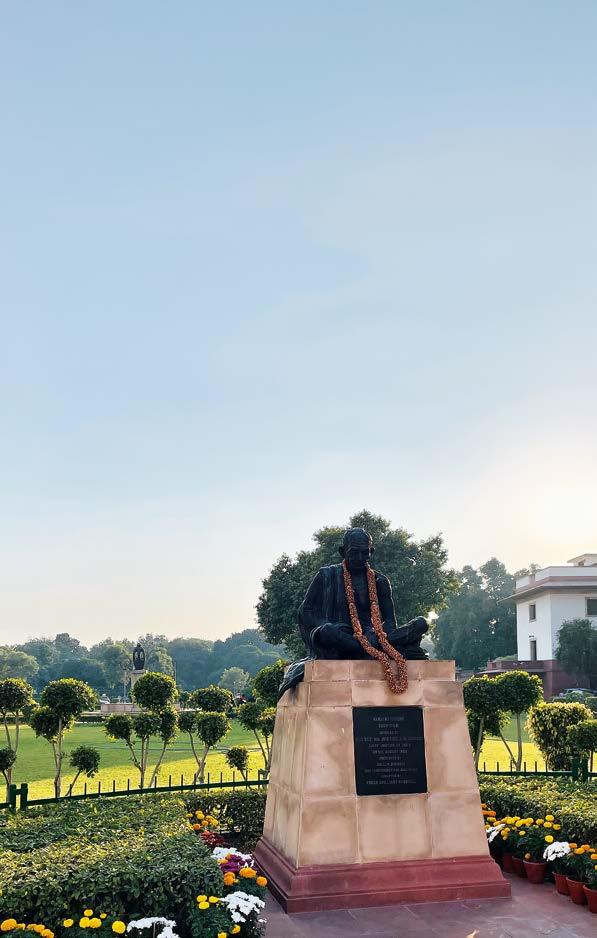
The court process shared similarities with the British system, yet there was no question of its own distinct identity, with conversation often turning to the differences between the courts in India and England and Wales.
A troop of Rhesus monkeys would do their daily patrols and test the security of the court boundary fences, while inside the court concerns were growing over the continued illegal exportation of the Indian Pangolin for Chinese medicine, and the failure to adequately protect India’s rich natural heritage.
It was of particular interest that, unlike back home, any Indian citizen could walk directly into court and raise an issue before the Supreme Court Judges, irrespective of the stage that their case had reached. Equally, where legal positions were unchartered, the judiciary could provide guidance on the law. The ability to offer such unfettered access to senior judges is surely the envy of any judicial system.
I am very grateful for this opportunity and would thoroughly recommend it to any individual seeking new cultural perspectives. My thanks go to the Pegasus Trust and Dr Aman Hingorani, Priya Hingorani and Shweta Hingorani who continue to enable these great opportunities in the name of Nirmal and Kapila at the Hingorani Foundation. I would like to also thank Supreme Court Judge K V Viswanathan, Nandita Rao and Akhand Singh and their associates for their continued wisdom, guidance and friendship during the scholarship.
UGANDA
By Yasmin Omotosho, 7 Bedford RowOn my penultimate day in Uganda, I was having a conversation with my Uber driver, Joseph, about what a wonderful time I had had on my placement, and how sad I was to leave. “I’ll give you a Ugandan name”, he said. “Natukunda ” When I asked what it meant, Joseph replied, “Love”. My ‘new name’ could not have summed up my experience as a Pegasus Scholar in Uganda more perfectly.
I spent most days at the High Court in Central Kampala under the supervision of the Technical Adviser to the Judiciary, the formidable Professor Andrew Khaukha, and no two days were the same. I undertook work on a variety of law reform projects, spanning from the ‘state brief’ (legal aid) scheme to sentencing guidelines to the introduction of Alternative Justice Systems. I also attended several events, including the launch of new criminal and civil Rules and Practice Directions at the High Court, and a Child Psychology and Child Centred Decision Making conference, including sessions on handling child witnesses, and insights into life at youth bail hostels from ‘matrons’ who had been working with juveniles for decades. I also shadowed Lady Justice Alice Komuhangi at the Family Division of the High Court in a land dispute matter with over 20 different witnesses, and observed a murder trial at the High Court. One of the highlights of my trip was having the opportunity to spend time both in and out of court with Justice of the Ugandan Supreme Court, Mike Chibita – a brilliant lawyer and a man of great integrity.
I travelled around the environs of Kampala, visiting Magistrates’ Courts and prisons, observing first-hand the administration of justice in Uganda. I accompanied Scott Leist (Director of East Africa at Pepperdine Law School) and his team from the Pepperdine Prison Project (based in Mukono, a town near Kampala) who are working to implement ‘plea bargaining’ in the criminal justice system. I observed one ‘plea bargaining session’ in the grounds of a prison, concerning cases for which I had completed paperwork (everything is done by hand in the Ugandan justice system), where a Magistrate disposed of various cases concerning inmates (mostly incarcerated for petty crimes) following a plea bargain with the state prosecutor. I couldn’t

help but draw parallels with mitigation I used to make as a criminal pupil in London. I was inspired by the dedication of Scott and his team to making positive change in the Ugandan justice system, and moved by the tenacity of my colleagues, from whom I learned a great deal – particularly Esther Lokwang, a passionate advocate (and now friend) – who was exceptionally kind to me.
Outside of work, I explored ‘the Pearl of Africa’s’ outstanding natural beauty by going on safari at Murchison Falls and visiting Jinja, where I travelled by boat to the source of the River Nile and zip lined between the trees in the forest of Nagojje. I sampled crocodile, had countless adventures on ‘boda-bodas’ and attended a wonderful wedding. I also visited All Saints’ Church in Kampala, where I met Lillian Yiki, a remarkable woman, mental health counsellor and friend, and shadowed her in a group therapy session at a psychiatric facility. I also befriended Stephen and Janet Gaukroger, an inspiring British couple who, through their Christian ministry, have been working with leaders and different communities in Uganda for years.
I was inspired by the dedication of Scott and his team to making positive change in the Ugandan justice system, and moved by the tenacity of my colleagues, from whom I learned a great deal.
I am extremely grateful to the Pegasus Trust and Ugandan Judiciary for affording me such a rich experience that has shaped me both personally and professionally. I am particularly grateful to Professor Khauka, for co-ordinating my placement. I look forward to continuing to be an ambassador for the Pegasus Trust, returning to Uganda (hopefully in the near future!) and building upon the connections I have made.
Yasmin Omotosho

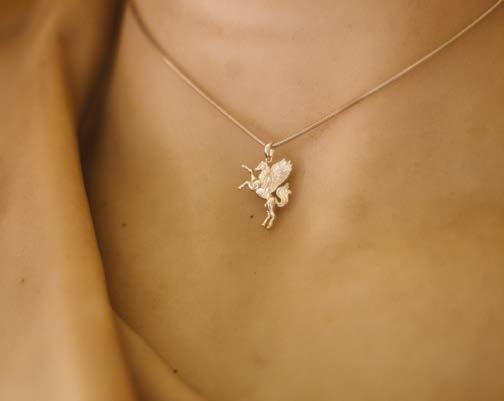
THE INNER TEMPLE HISTORY SOCIETY
By Master Donald Cryan
When the Inner Temple History Society was founded, its brief was set widely but with a view to promoting a better understanding of the history of The Inner Temple in all its aspects, its role as an educational and professional institution over nearly 700 years; its guardianship of its ancient estate; its impact through its members on the law and history of those lands where the Common Law is practised; all aspects of legal and the historical interests and writings of its members. This is a rich hunting ground in which to put together the three or four lectures a year which the Inn has the time and resources to promote.
Since the completion of Project Pegasus, The History Society has had the benefit of using the Inn’s purpose-built lecture theatre and reception space. This development could not be more timely. As the Inn has opened up after the COVID-19 years, the online and international interest in the Society’s talks has blossomed. Numbers attending are at least double those who came to hear talks of equal merit before the pandemic.
In October 2022, Sir Michael Tugendhat (Master Tugendhat) spoke to well over 200 people, most of whom were online, on the subject of his recent book on Human Rights in Britain and France: From Thomas Becket to the French Revolution. It was fascinating to understand the development of this area of the law in its international context. The book, which is award-winning, was co-authored with a distinguished French writer, and as yet is available in French. This was therefore a unique opportunity to learn of the genesis our thinking on human rights.
At the start of 2023, the Society heard the first of an informal series of talks focusing on the history of various aspects of the Inn through its treasures and fabric. Richard Parsons has an unparalleled knowledge of the Inn’s silver having been its adviser of many decades. He has written extensively in previous editions of the Yearbook on some of its more interesting items and on this occasion, he chose a number of items which illustrated the evolution of the collection and the way they reflected on the life of the Inn over the centuries. Whilst being extremely learned it was also fun and made history in itself. Master John Wass managed to get a clear sound out of the pre-dining horn which had been thought to be silent for 150 years.
In June 2023, Professor Sir John Baker KC (Master Baker) spoke on Three Treasures from The Library. Master Baker is, in one sense, one of the treasures of The Inner Temple himself. He is the Downing Professor Emeritus of the Laws of England at the University of Cambridge and his encyclopaedic knowledge of the history of The Inner Temple has been invaluable to those carrying out almost any work on the Inn’s history.
On this occasion he chose to explore three items from the collection which are among the most important and intriguing documents in our national and legal history. The medieval Clifford’s Inn Triptych comes from the dawn of formal legal education in England. Within it lies the earliest regulations for students in any of the legal Inns. Few, if anyone, would have Master Baker’s capacity to explain and contextualise the triptych.


He went on to explain in outline the importance of the four late medieval illustrations of the interiors of the mid-15th century courts. There are no other extant such illustrations for the next three hundred years and they provide a window into the life of the English Courts and life just a couple of generations after Chaucer.
Master Baker’s final choice was King Edward VI’s manuscript document headed My devise for the succession in which he sought to change the order of succession to the throne contrary to the will of Henry VIII, excluding Mary and Elizabeth. A much fuller account of his talk by Master Baker himself appears elsewhere in this Yearbook.
On this occasion he chose to explore three items from the collection which are among the most important and intriguing documents in our national and legal history.
At the time of going to press two major talks are eagerly awaited. On 26 October 2023, Dr Geoffrey Tyack of Kellogg College, Oxford will talk on The Smirkes and the Inner Temple: The Building of the Victorian Temple. Sir Robert Smirke and his younger brother were among the most famous architects of the mid-19th century (the British Museum and its reading room) yet are hardly remembered nowadays. They were also the successive surveyors of the Inn and responsible for momentous architectural changes during their time which can still be traced today.

On 29 November 2023, the next in the annual Selden Society and Four Inns of Court Lectures will take place. It follows on Lord Judge’s talk, 1622 The King’s Prerogative-2022 The Prime Minister’s Prerogative Continuing Constitutional Turbulence which attracted considerable public attention. This year it will be Gray’s Inn’s turn to host this most prestigious of public lectures on matters of legal history within a modern context. Baroness Hale will give an overview of the rights of women in respect of their children over the last 200 years. The title is, “Matrimony, Patriarchy and the welfare of children; the 200 year struggle to give parents equal right in the upbringing of their children” This is the first time that she has delivered such a tour d’horizon in a public talk. The role of The Inner Temple History Society in promoting this series of talks has been significant. Preparation for the programme of talks for the first half of 2024 is well advanced and will include a talk on the history of the Inn’s Library and another on the Sub-Treasurers who have kept the place running through the centuries come plague, fires and bombing.
His Honour Donald Cryan (Hon) LLD Chair of The History Society Master of the Bench innertemple.org.uk/historyvideos
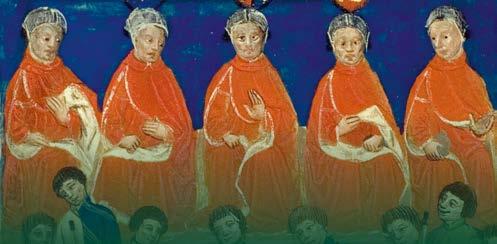

From a Social Context of the Law discussion held on 16 May 2023 between Professor Sir John Curtice FRSA FRSE FBA and Master David Lidington, moderated by Master David Hunt

Lord Hunt: What an exciting time to explore this subject of Should our constitution protect against party elected leaders? It’s set in the context of Prime Ministers taking office without a general election. I take to this subject, like a duck to water, because it has been a part of my parliamentary life for the last 50 years. And 50 years in parliament have seen some ups and downs, but never has it come into a situation where in one year we had three Prime Ministers.
Sir John Curtice: The reason why this debate has been stimulated this evening is the sight of just over 140,000 people deciding who should become the next Prime Minister in the summer of last year, only for the decision to be overturned within a matter of weeks and the loser declared the winner. Inevitably that somewhat improbable sequence of events has made people ask about whether or not having party members elect leaders is wise. It has also become an issue because the Conservative Party has now used this procedure twice while in office. Also, earlier this year the SNP had a party members’ ballot to decide the leader of the SNP, and that was the first time that Scotland’s First Minister was decided by that method.
Why might we worry about this? I’m going to examine three criticisms that are commonly made. One is that in the case of the Prime Minister it’s undemocratic that it should be decided by anybody other than the electorate. So, Prime Ministers should be directly elected. The second is that irrespective of whether a party is in office or is in opposition, it’s a less effective way of identifying the person who is most likely to be a good leader, that MPs know best. The third criticism is that it is unrepresentative, that those who do vote in these party membership elections are not typical of the public, or perhaps even of the people who vote for the party in question.
I’m going to look at some of these. I’m going to turn the question around towards the end and suggest that probably we do need to keep party membership ballots. But we actually also need to reintroduce MPs into the process of electing a Prime Minister – at the moment they do not have any role at all.
First, it’s undemocratic. We shouldn’t change Prime Ministers without an election. Well, we have a parliamentary system of government, and under parliamentary systems of government, our Prime Ministers need to be able to maintain the confidence of the House of Commons. And if you go through the history of Prime Ministers since 1918, of the 36 people who entered into office, 23 of them first acquired office, not as a result of winning an election, but as a result of taking over from their predecessor. Only 13 of them have come into office as a result of an election. Meanwhile, of the 23, only two of them went to the country almost immediately on becoming Prime Minister. So, every time you hear a politician get up and say: “We should have an election, we should have an election!”, you should just say to yourself: “They need to learn – A, their Constitution and B, their history.”
What is true, is perhaps in some senses we’re seeing the unintended consequences of changes. All of our parties in fact initially introduced leadership elections while they were in opposition. It started with the Liberal Party in 1976. Then, Labour in 1981 once they were in opposition, and then the Conservatives in 2001, when they were in opposition. These are parties that when in opposition decided who was going to be their leader, but then it does mean that they’re now using that internal procedure to elect somebody who then assumes the office of Prime Minister/First Minister. Given a parliamentary system, the leader is going to be the person who becomes Prime Minister, however they reach office.
Second, it’s ineffective, that MPs know best. There is certainly a kernel of truth that what is crucial for leaders is that they have to be able to maintain the confidence of their parliamentary colleagues. If you look at the people who became leaders without clearly being endorsed by their parliamentary colleagues – Ian Duncan Smith, Liz Truss and Ed Miliband – two of them resigned and the other’s lack of authority wasn’t helped by the way he acquired office. So, there’s certainly a lot of merit in saying that MPs should have a role.
The third accusation is that party members aren’t representative. And the accusation often is made that they are extreme. One thing that is true, and arguably is a problem, is that our political parties tend to have diminishing memberships. That’s certainly true of the Conservative Party. The first Conservative leadership election back in 2001 had about a quarter of a million people who actually participated. The last time, it was less than 150,000.
A lot of the criticism comes from what we in political science call May’s Curvilinear Law of Disparity, which is the idea that the sensible folk are the voters; the unsensible extremists are the activists, the party members; and the MPs perhaps aren’t quite as sensible as the voters, but for the most part they tend at least to listen to the sensible folk, even though they’re not always necessarily sensible by inclination.
The trouble with this is, however, the research does not suggest that this is correct. Pippa Norris, back in 1992, found, for example, on issues like nationalisation and taxation, spending and welfare, that if the Conservative MPs are at one end of the spectrum and the Labour MPs at the other end of the spectrum, although their activists may be more left- and right-wing respectively than their voters, it’s the MPs who are the ideologues.
In the Conservative Party at the moment, Conservative MPs are just so much more economically liberal than everybody else. On the Labour side, it’s Labour MPs, above all, who are ideologically socially liberal. So, if you’re concerned about leaders being elected by folks whose views are not necessarily representative, the last group of people you would give the election to is MPs. So, MPs have a role as people from whom leaders need support, but we don’t necessarily want to give the choice simply to MPs. How am I going to square the circle? Well, I want to draw you to what I think is a gap in our constitutional convention/law. The truth is at the moment, this is the great secret – nobody elects the Prime Minister. Nobody at all casts a single vote for a Prime Minister.
The Crown appoints somebody whom it thinks will be able to command the confidence of the House of Commons. The Commons, by convention although not necessarily by law, can get rid of a Prime Minister by a vote of no confidence. It’s worth contrasting the situation with that in both Scotland and Wales, in the devolved institutions. So, yes, SNP members, decided they wanted Humza Yousaf as their leader. But then Humza Yousaf had to be elected by MSPs in the Scottish Parliament.
And I think arguably, if a majority party finds it doesn’t like what the members have decided, if we have a formal vote of MPs, at least in theory, it is open to them to say no, we’re in favour of having somebody else. So, I want to suggest that probably we have to end up keeping the choice amongst members, but if, for example, another Jeremy Corbyn type figure comes along who MPs really cannot stand, then we give them a vote, and they can vote or not vote for the person to become Prime Minister that their party has chosen as leader.

Sir David Lidington: Let me summarise where I come from on this. I think that there’s certainly a case for constitutional reforms of various kinds, I think that the power of the executive at the expense of parliament has increased, and ought to be subjected to further checks, and I don’t think that we can simply rely on conventions and customs in so doing.
Secondly, I think the question of whether members of political parties should or should not take part in the election of a party leader, including of a leader who becomes Prime Minister because that party has a majority in the House of Commons, is largely a red herring. It is a political matter which I don’t think is central to the constitutional question involved.
It is my view that the decision about who becomes Prime Minister and how long an individual serves as Prime Minister between elections must constitutionally remain with members of the House of Commons. Historically, Prime Ministers in our country were the personal choice of the sovereign. Originally, the term ‘Prime Minister’ was an insult. It was a term designed to accuse somebody of seeking to accrue semi-dictatorial, viceregal power, and the office of Prime Minister was not even mentioned in an Act of Parliament until the early 20th century.
Until then, the office of Prime Minister was not recognised anywhere in statute. The King or Queen’s first minister, their Prime Minister, was the person who could command a majority in the Commons. And it was perfectly normal for the Prime Minister to change between elections. And we used to have a requirement whereby when a backbench member of the House of Commons became a minister, they had to resign their seat and fight a by-election, in order to be confirmed.
The constitutional reality is that voters elect a House of Commons. And it’s the House of Commons with that mandate from the electors which then decides who the Prime Minister should be. And we have to have a mechanism in our system for dealing with what happens if either a Prime Minister loses the confidence of the Commons, or a Prime Minister resigns for other reasons, on the grounds, for example, of ill health or death in office.
What happened I would argue in 2022 was actually an example of the Constitution working. It looked pretty chaotic, but actually what happened was that you had first one and then a second Prime Minister, who lost the confidence of the majority of the House of Commons. And the constitution did its work – Boris Johnson and Liz Truss were effectively deposed by members of parliament.
I think the electorate, for the most part, tends to share the view of Brenda from Bristol at the time of the 2017 election called by Theresa May. “What do you think about this election? How are you going to vote?” She stared at the interviewer and said: “Not another one!” Most people know it’s their duty to vote but they don’t want to be troubled to go to the ballot box more frequently than necessary.
Political parties are a necessary part of a mass democracy. Having seen this from the inside, I could argue with great confidence that without the discipline and the cohesion that membership of a political party imposes, it will be impossible for any government of any political stripe to get anything done. Imagine a House of Commons of 650 independents trying to take any unpopular but necessary decision in the national interest. It would not happen. I’ve seen firsthand what happens when a government loses its overall majority or has just a tiny one. The Prime Minister of the day then ends up in a constant week-by-week or day-by-day process of negotiation with this or that group of backbenchers. And the political party provides, even in those circumstances, at least some hope that consistent government can be carried on.
I do think in the context of an election that fails to deliver a decisive majority for one party or the other, there is merit in the system that some European democracies have of a ‘wise man or woman’ being appointed to act on behalf of the sovereign to test out who might be able to put a coalition or a working majority together in the House of Commons. I think that, where a majority exists, having a decision very clearly left to the political party concerned, either through its MPs alone or through its MPs and party members, is the best way to protect the king from partisan controversy.
The irony of bringing party members into these decisions was that it was seen certainly by my party, and I think by the Labour Party too, as a means to try to make it more attractive for people to become party members and to broaden the membership base and make it more diverse, at a time when all parties were, and continue to be, worried about how reluctant most people are to join parties, and the narrowing and ageing of the party base. Now my view is that the mechanism was tried in good faith, but I don’t think it has actually worked very well. But I don’t think you can ban parties from enfranchising their members. And the fact that party members – in most circumstances under our system – play the key role in selecting or deselecting candidates to be members of parliament means that there will always be that possibility of revenge.
If we’re looking for constitutional changes that might make a difference, and might do something to rebuild public trust in our system, we need to look again at how we programme the time allotted to individual bills, where too often that is used by the government of the day as a means to restrict debate on things the government would prefer were not debated, and for ill-drafted legislation to be rushed through the Commons, only to be largely rewritten when it comes to the House of Lords. I think we could look at enhancing the power of select committees to confirm major public sector appointments.
We
need to look again at how we programme the time allotted to individual bills, where too often that
is used by the government of the day as a means to restrict debate on things the government would prefer were not debated.
And we could have a new Parliament Act, which defined the powers and responsibilities of a reformed upper chamber. Which could, for example, give it enhanced power to delay or even to block certain categories of legislation: perhaps specific powers over Statutory Instruments, which often get inadequate scrutiny; perhaps even to define in law a class of constitutional statutes and say that, as with the Quinquennial Act now, the upper chamber’s assent would be required if those Constitutional statutes were to be amended or repealed. So, I think that there is a really significant agenda for constitutional reform and for debate about the relationship between the executive and legislature, but I think that this particular question of who it is that should approve the change of Prime Minister between general elections is a very, very minor aspect of that debate.
Sir John Curtice FRSA FRSE FBA
The Rt Hon Sir David Lidington KCB CBE
The Rt Hon Lord Hunt of Wirral MBE
For the full video recording: innertemple.org.uk/constitution




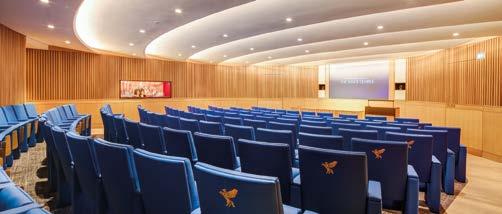
RAISING THE BAR ON
Conference and Meeting spaces
Book a meeting room or conference space at the Inner Temple and you will have everything you need for a successful day.
All rooms feature high-tech integrated AV, with interactive Clevertouch screens, cameras for room capture, recording and streaming, allowing you to reach audiences near and far and to revisit your meetings when needed.

There is also a spacious shared breakout space for attendees to take time out, with access to the viewing balcony which overlooks the Inner Temple’s award-winning gardens and the surrounding areas.
020 7797 8230 | venuehire@innertemple.org.uk | innertemplevenuehire.co.uk
THE SODOMY OFFENCE: ENGLAND’S LEAST LOVELY LEGAL EXPORT?
By Master Michael KirbyThis article formed the basis of a lecture delivered by Master Michael Kirby to the LGBTQ+ Society on 18 April 2023

THE PAST

It all goes back to the Bible. In the Book of Leviticus, the Old Testament contains the following declaration:
“If a man … lie with mankind, as he lieth with a woman, both of them have committed an abomination: they shall surely be put to death; their blood shall be upon you”.
This is one of a series of stern commandments. A man who lies with his daughter-in-law shall be put to death, as must his victim, seemingly however innocent she might be. The penalty is stepped up for a man who takes a wife and her mother. They are to be “burnt with fire” so that “there be no wickedness among you”. A man that lies with a beast is to be put to death. As well as the poor animal. There is a similar offence of a woman connecting with a beast. These punishments and offences portray an early, primitive, patriarchal society where the powerful force of sexuality was seen as a danger to be held in the closest possible check.
According to those who have studied these things, the early history of England incorporated into its common law an offence of ‘sodomy’, in the context of providing protection against those who endangered Judeo-Christian principles. The Church had its own courts to try and to punish ecclesiastical offences, those that defiled the kingdom and disturbed the racial or religious order of things.
A survey of the English laws, written in Latin in 1290, during the reign of Edward I, mentions “sodomy”, involving sexual intercourse. It was so described because the crime was attributed to the men of Sodom who thereby attracted the wrath of the Lord and the destruction of their city. Sodomy
was perceived as an offence against God’s will, which thereby attracted society’s sternest punishments. The offence was reinforced by a biblical instruction that associated the sexual act with shame and excused it only as it fulfilled the procreative function.
Sodomy was perceived as an offence against God’s will, which thereby attracted society’s sternest punishments. The offence was reinforced by a biblical instruction that associated the sexual act with shame and excused it only as it fulfilled the procreative function.
In the 16th century, following Henry VIII’s separation of the English church from Rome, the common law crimes were revised so as to provide for their trial in the King’s courts. A statute of 1533, provided for the crime of sodomy, under the description of the “detestable and abominable Vice of Buggery committed with mankind or beast”. The offence was punishable by death. Although that statute was repealed in the brief reign of Mary I, it was re-enacted by parliament in 1563, in the reign of Elizabeth I. The statutory offence, so expressed, survived in England until 1861. The last recorded execution for ‘buggery’ in England took place in 1836.

The great text writers of the English law, exceptionally, denounced sodomy and all its variations in the strongest language. When William Blackstone, between 1765–9, wrote his Commentaries on the Laws of England, he too included the “abominable crime” amongst the precious legacy that English law, bequeathed to its jurisdictions. Everywhere the British took their Empire, language, and trade, they brought with them the crimes against the “order of nature”. Astonishingly, these crimes remain in force in many countries of the Old Empire to this day. The offences spread like a pestilence. They have proved difficult to eradicate.
In France, Napoleon’s codifiers undertook a complete revision and re-expression of the penal law. This was an enterprise which Napoleon, correctly, predicted would long outlive his imperial battle honours. In the result, the sodomy offence, which had previously existed in France and had been repealed in 1791, was removed from the French Penal Code of 1810. This repeal proved profoundly influential and quickly spread to more countries even than Britain ruled. It did so through derivative codes adopted, following conquest for example, in the Netherlands, Belgium, Spain, Portugal, Scandinavia, Germany, Russia, China, Japan and their respective colonies and dependencies.
Everywhere the British took their Empire, language, and trade, they brought with them the crimes against the “order of nature”. Astonishingly, these crimes remain in force in many countries of the
Old Empire to this day.
Just as the Napoleonic codifiers brought change, and the termination of the prohibition on consensual same-sex activities in France and its Empire, so in England a movement for codification of the criminal law, gained momentum in the early 19th century. A great proponent of this movement was Jeremy Bentham. He strongly criticised Blackstone for his complacency about the contents of the criminal law of England. He demanded reform of the law’s treatment of what later became named as homosexual acts. However, reform was opposed by the judges. In the result, no relevant reforms were enacted in England.
Encouraged by contemporary moves for criminal legal reform in France, Bentham urged a reconsideration of only those forms of conduct which should, on utilitarian principles, be regarded as punishable offences under the laws of England. He continued to urge the acceptance of the utilitarian conception of punishment as a necessary evil, justified only if it was likely to prevent, at the least cost in human suffering, greater evils demonstrably arising from putative offences. Somewhat cautiously, he also turned his attention to the law’s treatment of what later became named as homosexuality. He favoured de-criminalisation.
What could not be achieved in England, in the form of a penal code, became an idea and a model that could much more readily be exported to, and imposed on, the British colonies, provinces and settlements overseas. So, this is what happened. There were five principal criminal codes on offer. They all included various reforms. However, the homosexual offences were common to them all. They were exported to all countries of the British Empire – including to all of the colonies in faraway Australia, Canada, South Africa and Singapore.
Ruling the world’s largest Empire was a very demanding responsibility. The rules could never appear weak. They exuded a very masculine air of dominance. Same-sex activity was considered morally unacceptable to the British rulers and their societies. The local populations were not consulted in respect of the imposition of such laws. At the time, the settlers, if they ever thought about it, would probably have shared many of the prejudices and attitudes of the rulers. But in many of territories in Asia, Africa and elsewhere, where English law was imposed and enforced, there was no (or no clear) pre-existing culture that required such grim punishments for all such offences. They were simply imposed to stamp out the ‘vice’ and ‘viciousness’ feared to be present in the conduct of native peoples which the British rulers found, or assumed, to be intolerable in a properly governed society.
The most copied of the colonial criminal codes was the Indian Penal Code (IPC) of Thomas Babington Macaulay. The relevant provision appeared in Ch XVI, titled Of Offences Affecting the Human Body. Within this chapter, section 377 appeared under the subtitle Of Unnatural Offences. Originally, it provided for the death penalty. But at the time of India’s independence in 1947 it declared:
“377. Unnatural Offences – Whoever voluntarily has carnal intercourse against the order of nature with any man, woman or animal, shall be punished with imprisonment for life, or with imprisonment of either description for a term which may extend to 10 years and shall also be liable to fine.
Explanation – Penetration is sufficient to constitute the carnal intercourse necessary to the offence described in this section.”
This provision of the IPC was copied in a large number of British territories from Zambia to Malaysia, and from Singapore to Fiji. The acts specified were punishable, irrespective of consent or resistance, because more than the individual’s will or body was at stake. Legally, same-sex activities were linked and equated to the conduct of violent sexual criminal offences, such as we treat paedophilia today.
I can recall clearly a day in my first year of instruction in criminal law at the Law School of the University of Sydney when I was introduced to this branch of the law, as it applied in New South Wales. In the last year of the reign of Queen Victoria, the colonial parliament of New South Wales, enacted the Crimes Act 1900 (NSW). It is still in force although parts have been amended. Part III of that Act provided for the definition of ‘Offences against the Person’. A sub-division of those offences was headed Unnatural Offences. The first of these provided in section 79:
“79. Buggery and Bestiality: Whosoever commits the abominable crime of buggery, or bestiality, with mankind, or with any animal, shall be liable to penal servitude for 14 years.”
The acts specified were punishable, irrespective of consent or resistance, because more than the individual’s will or body was at stake. Legally, same-sex activities were linked and equated to the conduct of violent sexual criminal offences.

As I listened to the law lecturer explaining the peculiarities of the unnatural offences, including the fact that, in law, full age and consent were no defence and both parties were equally guilty; the availability of propensity evidence to prove the particular offence charged and evidence of similar facts; and the heavy penalties imposed upon conviction; I knew that these provisions were targeted directly and specifically at me as a gay man. I could never thereafter share an unqualified belief that the inherited criminal law of Australia was flawless. A growing body of public opinion in Australia and elsewhere came to see the need for modernisation and reform. However, it was to take the period between 1974 (in South Australia)
THE REFORMS
The forces that gave rise to the movement for reform were many. They included the growing body of scientific research into the variable features of human sexuality. This research was undertaken by several scholars, including Richard Krafft-Ebing (1840–1902) in Germany; Henry Havelock Ellis (1859–1939) in Britain; Sigmund Freud (1856–1939) in Austria; and Alfred Kinsey (1894–1956) in the United States. The last, in particular, secured enormous public attention because of his unique sampling techniques and the widespread media coverage of his successive reports on variation in sexual conduct on the part of human males and females.
The emerging global media and the sensational nature of Kinsey’s revelations ensured that they would become known to informed people everywhere. Even if the sampling was partly flawed, it demonstrated powerfully that the assumption that same-sex erotic attraction and activity was confined to a tiny proportion of wilful anti-social people was false. Moreover, experimentation, including acts described in the criminal laws as ‘sodomy’ and ‘buggery’, treated by law as amongst the gravest crimes, were relatively commonplace both amongst same-sex and different-sex participants. If such acts were so common, the questions posed more than a century earlier by Bentham and Mill were starkly revived. What social purpose was secured in exposing such conduct to the risk of severe criminal prosecution and, upon proof, punishment? Particularly where the offences applied irrespective of consent, age and circumstance and the punishments were so severe?
A number of highly publicised cases in Britain, where the prosecution of a number of aristocratic ‘offenders’ appeared harsh and unreasoning, set in train a growing public debate about reform. Eventually, committees were formed throughout the United Kingdom to support parliamentary reform. A royal commission of enquiry was established in 1956, chaired by Sir John Wolfenden, a university Vice Chancellor. The Commission’s report recommended substantial modification and confinement of homosexual offences, deleting adult, consensual, private conduct. The Wolfenden Committee expressed the principle that they embraced in terms that would have gladdened the heart of Jeremy Bentham:
“Unless a deliberate attempt is made by society, acting through the agency of the law, to equate the sphere of crime with that of sin, there must remain a realm of private morality and immorality which is, in brief and crude terms, not the law’s business”.
The prosecution of a number of aristocratic ‘offenders’ appeared harsh and unreasoning, set in train a growing public debate about reform.
and 1997 (in Tasmania) to secure the abolition of all the laws in Australia that punished gay people for following the desires of their nature. However, the criminal laws, introduced into so many jurisdictions by the British Imperial authorities, remained in force in virtually all of them long after the Union Jack was hauled down and the Britannic viceroys departed, one by one, from their Imperial domains.
In the middle of the 20th century, as the centenary of the formulation of the IPC approached, moves began to emerge for the repeal of the same-sex criminal offences, commencing in England itself. Reform gradually followed in all of the settler dominions. And later in many other jurisdictions.
Ultimately, private members’ Bills were introduced into the House of Commons and the House of Lords, by lending proponents of reform, neither of whom identified as homosexual. Within a decade of the Wolfenden Report, the United Kingdom parliament changed the law for England and Wales. At first, the age of consent was fixed at 21 years and there were a number of exceptions (relating to the Armed Forces and multiple parties). Reforming laws were soon also enacted for Scotland and Northern Ireland. The last mentioned reform was achieved only after a decision of the European Court of Human Rights held that the United Kingdom was in breach of its obligations under the European Convention on Human Rights by continuing to criminalise the adult, private, consenting sexual conduct of homosexuals in that province.
Within a remarkably short time, the influence of the legislative reforms in the United Kingdom resulted in the legislative modification of the same-sex prohibition in the penal laws of Canada, New Zealand (1986), South Australia (1974), Hong Kong (1990) by legislation and in Fiji (2005 by a High Court decision). Likewise, a decision of the Constitutional Court of South Africa in 1998 struck down the same-sex offences in that country as incompatible with the terms and values of the post-Apartheid Constitution. In that decision, Ackermann J said:
“The way in which we give expression to our sexuality is the core of this area of private intimacy. If, in expressing our sexuality, we act consensually and without harming one another, invasion of that precinct will be a breach of our privacy.”
To the same effect, the Supreme Court of the United States of America (another country which, with few exceptions, had inherited its state criminal laws from the British template), eventually, by majority, held that an offence, enacted by the State of Texas, as expressed, was incompatible with the privacy requirements inherent in the United States Constitution. Kennedy J, writing for the Court, declared:
“… [A]dults may choose to enter upon this relationship in the confines of their homes and their own private lives… The liberty protected by the Constitution allows homosexual persons the right to make this choice. … When homosexual conduct is made criminal by the law of the state, that declaration, in and of itself, is an invitation to subject homosexual persons to discrimination both in the public and the private spheres.”
In Australia, the journey to reform was slow and difficult. It began with removal of the law in the Australian Capital Territory, a federal responsibility (1975). One by one, the States of Australia, by parliamentary action, amended their respective criminal laws to remove the ‘unnatural offences’. Amongst the last to make the change were Western Australia (1989) and Queensland (1990). In each of those States, the distaste at having to repeal the templates of the Criminal Codes then applicable, was given voice in parliamentary preambles which expressed the legislature’s discomfiture.
In Queensland, where the legislators were called upon to repeal the material provision from Griffith Code, a preamble was enacted that was distinctly condescending:
“Whereas Parliament neither condones nor condemns the behaviour which is the subject to this legislation … [but] reaffirms its determination to enforce its laws prohibiting sexual interference with children and intellectually impaired persons and non-consenting adults.”
Only one Australian jurisdiction held out, in the end, against repeal and amendment, Tasmania. In that State, a variant of the Griffith Code continued to apply. Endeavours to rely on arguments, including the dangers of HIV/AIDS, to attain reform, failed to gain traction. Eventually, immediately after Australia subscribed to the First Optional Protocol to the International Covenant on Civil and Political Rights (ICCPR), a communication was submitted to the United Nations Human Rights Committee in Geneva. This argued that, by criminalising private same-sex conduct between consenting adults in private, the law of Tasmania brought Australia, in that jurisdiction, into breach of its obligations under the ICCPR.
In March 1994, the Human Rights Committee of the United Nations in Toonen v Australia upheld the complaint and found Australia in breach. The majority of the Committee did so on the basis of a breach of Article 17 of the ICCPR (privacy). A minority report suggested that there were other breaches in relation to discrimination on the “grounds of sex”, thereby anticipating by 26 years the 2020 US Supreme Court decision in Bostock v Clayton County
Reliant upon the Human Rights Committee’s determination, the Australian Federal Parliament enacted a law to override the Tasmanian same-sex criminalisation, asserting this action under the external affairs power in the Australian Constitution. The validity of the law so enacted was then challenged by Tasmania in the High Court of Australia. That court, in Croome v Tasmania, dismissed an objection to the standing of one of the successful complainants to Geneva, in seeking relief against the Tasmania challenge.
By this stage I had been appointed from the New South Wales Court of Appeal to the High Court of Australia. I recused myself from participating in the case, illustrating the

relatively strict view in Australia on judicial recusal. It is a view that contrasts with that taken recently by some Justices of the Supreme Court of the United States. With the High Court’s decision, the Tasmanian parliament surrendered. It repealed the anti-sodomy offence of that State. It was not therefore necessary for the High Court to rule on the constitutional validity of the federal law. In all Australian jurisdictions, the old British legacy had been removed by legislation and the democratic process. But it had taken 20 years.
For a long time, no further significant moves were made in non-settler countries of the Commonwealth of Nations to follow the lead of the legislatures in the old dominions and in the courts of Fiji. On the contrary, when in 2004 a challenge was brought to the Supreme Court of Zimbabwe in Banana v The State, seeking to persuade that court to follow the privacy and equality reasoning of the South African Constitutional Court, the endeavour, by majority, failed, Chief Justice Gubbay dissenting.
Another setback was initially suffered in Singapore, which, like Hong Kong, was a small common law jurisdiction with a prosperous Chinese community unencumbered by majority cultural norms of Judeo-Christian origin, except as imposed on them by their now departed British colonial rulers. In Hong Kong, the then territory’s law reform commission supported the Wolfenden principles and recommended their introduction in that colony. The change was effected in 1990, after vigorous advocacy by the local homosexual community and its friends. However, the course of reform in Singapore was less favourable.
In 2006, the Law Society of Singapore delivered a report proposing repeal of s377A of the Singapore Penal Code. However, a fiery debate ensued in the Singapore parliament. Members supported the retention of the colonial provision on the basis that it contributed to “social cohesiveness” Christian churches and religious members of parliament opposed reform. The reform bill was rejected, although the Prime Minister made it clear that the laws “would not generally be enforced”, so long as victims preserved a low profile and observed the requirements of ‘don’t ask don’t tell’. Repeated challenges before the Singapore Court of Appeal were of no avail.

THE FUTURE
The last decade, throughout the world (but mainly in Commonwealth countries) has seen progress in fits and starts to abolish the inherited criminal laws against LGBTIQ+ people. Undoubtedly, the most important move came in India. It began in 2009 when the Delhi High Court found that the provisions of section 377 of the IPC, in so far as they purported to criminalise adult consensual sexual conduct in private, were invalid under the Indian Constitution. The judges found that the provisions violated the constitutional guarantees of equality and privacy. The decision was immediately appealed to the Supreme Court of India. Initially, that court upheld the appeal. It set aside the declaration of invalidity. That outcome was a great shock in India and beyond. However, in its turn, it was challenged in further proceedings in the Supreme Court.
The last decade, throughout the world (but mainly in Commonwealth countries) has seen progress in fits and starts to abolish the
inherited
criminal laws against
LGBTIQ+
people.

In September 2018, that court unanimously restored the declaration of invalidity issued by the Delhi High Court. It did so basically on the same constitutional principles. Misra CJ declared that, under the Indian Constitution, everyone had the right to live with dignity. This entitlement was upheld by international human rights law, as by the Constitution of India. The right to enter into private sexual adult relationships had to be secured against undue intrusion by the state. The importance of the Indian decision rested not only on the protection of the rights of sexual minorities in India. Many criminal codes in other countries followed the Indian provision. The constitutional requirements invoked in India had parallels in many newly independent states.
A momentum was therefore built up following the line of authority in India. In Belize the Court of Appeal, headed by Benjamin CJ, found that the relevant provisions of the criminal code were unconstitutional and inapplicable to the consenting sexual conduct of adults in private.
Favourable court decisions followed also in Seychelles, Botswana, and on the subject of equal marriage rights, in Taiwan. On the other hand, a number of test cases challenging criminal offences on constitutional grounds, failed. This occurred in Uganda; Kenya; Singapore; and in Zambia (although in some of these cases appeals were brought and are pending).



Marriage equality litigation has also enjoyed mixed success. In the United States, the Supreme Court (by majority) upheld the constitutional right to equal marriage. However, an attempt in Australia to secure judicial intervention to permit marriage equality, failed. That decision was later reversed after a voluntary survey on marriage equality resulted in a large majority in favour of marriage equality, leading to amendment to the Marriage Act by the Australian parliament. What began as a truly exceptional legislative measure in the Netherlands in 2000, expanded to the current widespread adoption of marriage equality, either by legislation or judicial decisions. Today equal rights to marriage for LGBTIQ+ couples are enshrined in law in more than 30 countries.
A similar indication of changing attitudes can be seen in the successive votes in favour of the continuance of the office of the United Nations Independent Expert on Sexual Orientation and Gender Identity. Despite vigorous opposition to the retention of the office, mainly from African and Arab states, the successive votes in the Human Rights Council and the General Assembly of the United Nations have been increasingly in favour of the retention of the office.
By the same token, hostility towards LGBTIQ+ status remains strong in Africa, the Caribbean and in parts of Asia.
A particularly disappointing development has been the shift in attitudes and law of Indonesia, formerly regarded as tolerant on this issue. The repeated refusal of the courts in Singapore to interpret constitutional norms broadly demonstrated for many years the frustrating failure of ‘democracy’ in that city state to provide respect for a minority, despite other features of modernism and communitarianism. Eventually, in 2022, the Singapore parliament enacted reform; but not without adapting a parallel measure, amending the Singapore Constitution to prohibit same-sex marriage.
Civil society organisations and some initiatives of the Commonwealth; the United Nations and academic leadership, continue to struggle in support of full legal equality for all LGBTIQ+ people. Every month or so a legislative or judicial breakthrough is celebrated. However, this is then counterbalanced by defeat in another legislature or in an appellate court. Sadly, the Judicial Committee of the Privy Council, on appeal from several Commonwealth states in the Caribbean, has not covered itself with judicial glory. In this, it is to be contrasted with the Caribbean Court of Justice in similar cases. Once again Uganda, in 2023, has won the prize for most hostile state in the Commonwealth, if not the world.
The Anti-Homosexuality Act 2023 (Ug) has even reintroduced the death penalty as a punishment for defined cases of
‘aggravated’ homosexuality. Yet the most absurd law introduced in 2023 was in Malaysia, another Commonwealth country. This declared that sale and possession of colourful ‘Pride’ swatches would attract criminal punishment because offensive to Islamic religious principles.
The journey of human rights and justice is a long and tortuous one. It is accompanied by tears and disappointments. However, if LGBTIQ+ minorities have proved anything about themselves over the past 50 years it must be their resilience, determination and commitment to equality where that matters. Many achievements in the law have been noted. More remain to be secured. The law which was, for centuries, an oppressor of sexual minorities, is now increasingly seen as a protector and guardian. Still, the road ahead is long, and fear, shame and violence remain prevalent. This is worst of all in Commonwealth countries that derive their criminal laws from Britain.
This is itself somewhat surprising because the Commonwealth Heads of Government Meeting (CHOGM) in 2013 adopted a Commonwealth Charter to express the values and aspirations of all Commonwealth member states. This step followed a report to CHOGM recommending this step, proposed by an Eminent Persons Group (EPG), tabled at CHOGM in Perth, Western Australia, in 2011. The writer was a member of the EPG. Its text, signed by the Late Queen Elizabeth II at Marlborough House in 2013, was designed to express core values to replace allegiance to the British monarch which had earlier been the legal adhesive that bound the British Empire and its Commonwealth together. The Commonwealth Charter declares, in unequivocal language, that “we are implacably opposed to discrimination of any kind.”
Yet discrimination persists, both in practice and in law. The influence of the old British laws on sodomy remains in force in almost 30 Commonwealth countries. Fifty years on from independence and self-government, this persistence cannot now be blamed on Britain. On slavery, after a shaky start, the British Empire became a global leader of reform. On sodomy and consequent injustices, countries of the Commonwealth of Nations have continued to resist reform. The struggle for equality and justice is not over. This is an unfinished story.
The Hon Justice Michael Kirby AC CMG Honorary Master of the Bench
For the lecture video recording: innertemple.org.uk/sodomylaw

SELDEN SOCIETY LECTURE: THE KING’S PREROGATIVE 1622; THE PRIME MINISTER’S PREROGATIVE 2022:
CONTINUING CONSTITUTIONAL TURBULENCE
By The Rt Hon The Lord Igor JudgeThe Seldon Society and Four Inns of Court Annual Legal History Lecture held on 1 November 2022

When did the trouble start? It certainly did not help smooth things over in 1609 when King James I told parliament that “the state of monarchy is the supremest thing upon earth”, modestly adding that all the attributes of God agreed in the person of a King. That 1609 parliament included something like 100 lawyers from the four Inns of Court among its members, many rather troubled by the Scottish King’s approach, and it was unwise for him to prove his ignorance of the common law by claiming that “no law could be more favourable and advantageous for a King and extend further his prerogative”. It was even more unwise to fail to recognise the importance of the response, which in 1610 took the form of a Petition of Grievances. The Petition was a measured complaint against rule by proclamations, which tended “to alter some parts of the law”, and expressed concern that proclamations would “by degrees, grow up and increase to the strength and nature of laws”. What they perceived as the menace of ‘proclamations’ is now disguised by its modern manifestation, ‘statutory instruments’.

To the title of this lecture. By December 1621, the troublesome relationship between James I and the House of Commons boiled over. Again, they drew up a Declaration of Grievances. The King responded with outrage. The Commons offered a second petition reasserting their rights, respectfully inviting the King to take away “the doubts and scruples your Majesty’s late letter to our Speaker hath wrought upon us”. The King countered that their asserted rights were no more than whatever he was prepared to tolerate. So the Commons produced a Protestation. It was entered on the Journals. James I adjourned parliament. A few days later in the New Year he went to parliament. He demanded to see the Journals. He read the entry. He literally tore it out of the book “to be razed out of all memorials and utterly to be annihilated”. Parliament was dissolved because the Commons had taken “inordinate liberties with our high prerogative”. Sir Edward Coke, a former Chief Justice, was locked up in the Tower where he remained for seven months. Locking opponents up was an unpleasant Stuart habit: later our very own John Selden was deprived of his liberty more than once, and finally for five years.
King Charles I (1600–1649). Painting by Dutch artist Daniel Mytens (1590–1648) © Wikimedia CommonsWe were now on the path, not an inevitable path, but the path which ultimately led to Civil War and execution of the King. Reflecting that awful chaos and turmoil, Thomas Hobbes produced The Leviathan, postulating concentrated power. “I authorise, and give up my right of governing myself to this man on condition that thou give up thy right to him and authorise all his actions in like manner… To the end he may use the strength and means of them all as he shall think expedient…” I was brought up to regard that philosophy of concentrated, effectively unconstrained political power with distaste, and still do. Passionately.
Within another 40 years, a new James I was driven out of his kingdom. That dramatic event required its philosophical justification, and in his Treatise of Civil Government John Locke provided it. Political society must establish legislative power, but the legislature violates its sacred trust if, among other things, it ignores the principle that it “neither must, nor can, transfer the power of making laws to anybody else...”
All was now well: we would never again be governed by the ‘King, in parliament’, the King tolerating parliament as he thought useful. Our constitutional settlement was the ‘King-in-Parliament’, two Houses and the monarch, the whole in a balanced equilibrium. Please recognise the vast difference between the King comma in Parliament, and the King hyphen in hyphen Parliament. The punctuation is critical.
Now, jump 400 years to 2022. The equilibrium of Kingin-Parliament has become a mythical constitutional fiction. The Lords has negligible power, although still some influence. The head of state is a constitutional monarch, who notwithstanding his lifetime concerns has accepted ‘advice’ not to participate at COP 27. Constitutional power is vested virtually exclusively in the Commons, and although that is the principle, in reality the exercise of power resides in number 10 Downing Street, which nowadays exercises significant oversight over the Departments of State. Of course, modern Prime Ministers cannot lock up their opponents, nor do they remain in office for life. Despite those important distinctions I venture to suggest that true description of where actual power rests is the Prime Minister in the Commons. And at the end you can work out for yourselves where the punctuation, comma or hyphen, should be drawn.

For the purposes of this lecture, I chose 2022 because the Dissolution and Calling of Parliament Act 2022 was expressly designed to restore the royal prerogative. The Prime Minister advises the monarch that parliament should be dissolved. I suggest that the monarch has no choice. In 1950, three situations were suggested where the monarch might take a different view to the Prime Minister. These were explained in a letter to The Times, written by the King’s Private Secretary, but signed with a nom de plume, “Senex”. That suggests, at the very least, concern that even his own very limited thesis would be politically controversial. I do not think it runs today. The monarch may, of course, advise the Prime Minister against a dissolution, but the exercise of the prerogative is in the Prime Minister’s hands. There is no other constraint. The Commons cannot reject its own dissolution. The jurisdiction of the courts is ousted. The monarch, whose prerogative the statute purports to restore, certainly cannot dissolve parliament, not even in our recent absurd circumstances. Only the Prime Minister, or the expiry of five years, can negative the results of the previous General Election. All those millions of votes binned, at the behest of one office holder. Indeed, we have reached the absurdity that while the Conservative party were electing Liz Truss, Boris Johnson remained Prime Minister and in law he, and he alone could have asked for a dissolution. The Commons, where the Prime Minister had a comfortable majority, rapidly, as it habitually does unless parliamentary time is becoming constrained, rejected a Lords’ amendment which would have tempered this modern manifestation of the prerogative, and required a majority, a bare majority, in the Commons to support its dissolution. Today’s Prime Minister can more or less echo King Charles I that “Parliaments are altogether in my power for their… dissolution”.
In the available time I want briefly to touch on two further important Stuart prerogatives which are now vested directly or indirectly in the Prime Minister. In passing, I highlight the penetrating foresight of Sir John Eliot who in 1625 identified the danger to what he thought of as the democratic process of leaving the control of business to one person: today that powerful weapon is in the hands of the governing party. Eliot too ended up in the Tower, where he died.

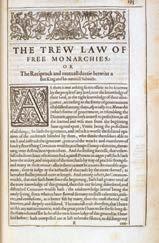 Inside cover of The Second Part of the Institutes of the Lawes England. Created by Sir Edward Coke (1552–1634), the Institutes is one of his best known treatises and a foundational document for the common law. This work was considered a threat to the royal prerogative and seized on the order of King Charles I (1600–1649) Published, 1642. 508.f.9.(1.) © The British Library
Inside cover of The Second Part of the Institutes of the Lawes England. Created by Sir Edward Coke (1552–1634), the Institutes is one of his best known treatises and a foundational document for the common law. This work was considered a threat to the royal prerogative and seized on the order of King Charles I (1600–1649) Published, 1642. 508.f.9.(1.) © The British Library

First, Elections. Charles I exercised the prerogative to control membership of the Commons. The simple device was to appoint those who were frustrating him in parliament as High Sheriffs of their counties. Such an appointment disqualified them from leaving their counties; so they could not go to London. These are names to conjure with, among them Coke, Phelips, Alford and Wentworth.
Second, the Honours system. James I created 600 knights within three months of his arrival. Francis Bacon described the title as “almost prostituted”. Nevertheless, he sought one for himself, expressing the hope that his own personal dubbing should not be “merely gregarious in a troop”. Much more important, as a precaution against the Lords supporting that hugely significant Petition of Right, in April/May 1628 Charles I packed the Lords, much smaller then than now, with six new Peers. I cannot discern any distinction in any of them except that one was a nephew by marriage of the King’s favourite, Buckingham, one was a favourite of the new Queen, and one bought a Viscountcy, no less, for a donation of £20,000, a vast sum to the cash-strapped King.
Two aspects of the prerogative, one already constantly misused by Prime Ministers from both sides: HOLAC, the Appointments Commission, apart from its own recommendations, cannot assess the suitability, or justification for appointment, but only the candidates’ probity. The House of Lords itself, which is desperate to diminish its size to sensible proportions has no voice. No one and nothing has any controlling influence over the Prime Minister. That prerogative still thrives 400 years on.
As to elections, the Elections Act 2022 has granted the party in power a significant measure of control over the Electoral Commission. Yet the primary requirement, indeed the very justification for this influential body in a modern democracy, is absolute political neutrality and independence of any political influence. Despite Lords’ amendments, again rapidly rejected by the Commons, that independent body must, not may, must now “have regard” to “guidance” from the Secretary of State. ‘Guidance’ is a newish phenomenon, legislation disguised by an emollient word. The result is a diminution in the independence of the Electoral Commission.
Leaving the Prime Minister directly appointing members to one House, influencing the elections to the other House, and solely responsible for dissolving parliament (not a bad hand), I must move beyond prerogative powers. Given the way musical chairs has been played recently with the identity of the resident at number 10 Downing Street it may seem a little audacious to focus on the Prime Minister in the Commons. But although Prime Ministers come and go, the office itself is untouched. We have become habituated, in John Locke’s penetrating phrase, to the transfer of lawmaking powers from the legislature to the executive. And worse, for the executive to approach its own responsibilities on the basis that a majority in the Commons enables it to do anything and everything. I make no comment about Trussonomics’, but those wide-ranging economic proposals were agreed by the Prime Minister and the Chancellor of the Exchequer and proclaimed to the nation before they were seen even by the Cabinet. Astonishing, but commonplace, policy proclamations that should be first made to parliament are now frequently made to the media first.
So back to where I began. Proclamations. There never was any constitutional objection to the King issuing proclamations which advertised existing law, or even which encouraged agreeable behaviour. There is none today. What the Commons asserted in 1610 was an “indubitable right” not to be subject to proclamations which enforced compliance with new law created by the Palace. They were following well understood constitutional principles. Today there are many rhetorical flourishes in the Lords about Henry VIII clauses in legislation, referring to the notorious Act of Proclamations 1539; but even that notorious Statute had its limitations and was repealed immediately on Henry’s death. That was no more than
confirming the provision in the Act that it should not survive Henry’s death. Stephen Gardiner, who was there at the time, observed that nothing in the Act enabled anything to be done “contrary to an Act of Parliament or common law.” In 1555, the judges in Mary I’s reign asserted that “no proclamation by itself may make a law which was not law before, but they only confirm and ratify an old law and not change it”. I only mention that decision because Sir John Baker, the oracle of English legal history, draws attention to the observation in the report, so familiar to anyone who has practised at the Bar that although some contrary precedents were quoted, the justices “had no regard for them”. More important, in 1610 there already was a long-standing national antipathy to lawmaking by proclamations. The abolition of the Star Chamber in 1641, the enforcement authority, effectively ended the practice.
But our constitution evolves. The objectives of unacceptable Stuart proclamations are now achieved by delegated legislation. Now is not the time to address the way in which the emergency measures required by COVID-19 operated, but parliament was sidelined throughout. A declaration of emergency accompanied by the signature of a single minister on a statutory instrument, effectively locked us all down. There was no obligation to consult parliament for up to 28 sitting days, effectively six weeks. During the pandemic our lives were redrawn, and freedoms curtailed on the basis of over 500 statutory instruments. But we must not fool ourselves that this was either a new or a temporary phenomenon or confined to emergency situations. Largely, statutory instruments are not dealing with emergencies at all: new laws impinge on, adjust and govern our day to day lives like confetti falling at a wedding.
In 2022, our increased expectation of what central government and local authorities and quangos should provide, and indeed the myriad of societal issues which need regulation, has the consequence that secondary legislation is necessary, and often appropriate. In theory this is all under parliamentary control. First the powers are enacted by parliament. Second, there are, I think, 16 different ways in which parliamentary control over statutory instruments may be exercised. Well then, hurray, what am I fussing about? Just the reality. I venture to suggest that this reality would have been regarded by our ancestors in the 1620s as government by proclamation. Why?
The powers are gifted in ‘skeleton’ Acts: legislation which declares a policy but leaves implementation to statutory instruments. Take as a simple example, the recent Schools Bill. The Bill asserts that it is addressing the important question of ‘Academy Standards’. Yet there is not a word about standards. The legislation contains a list of controlling powers that by regulation may be exercised by the Secretary of State. Indeed, after about 18 powers, it confirms that they are merely ‘examples’ of what this Secretary of State may address. It will all be left to statutory instruments. It is a complete assumption of authority by the Executive. There is even a Henry VIII clause as early as clause 3, allowing amendment by secondary legislation even before the required academic standards themselves have been defined. Today when an Act of Parliament omits a Henry VIII clause it is only because someone in the Department has failed to press the relevant button on the computer. That is how commonplace delegated legislation has become, and how frequently primary legislation may be overruled by secondary legislation.
So, the second limb of parliamentary control. The constitutional theory that the exercise of any lawmaking powers granted by secondary legislation is subject to parliamentary control. In reality there is no such control. No draft statutory instrument can be amended. You cannot accept, say, 99 sensible provisions, but reject one obnoxious one. The executive controls business in the Commons, the danger identified by Eliot 400 years ago. For what the Whips perceive to be indiscipline, the penalty is service on the Commons Delegated Legislation Committees. The consideration given is minimal.
Since the 1980s, many thousands of statutory instruments prepared by government departments creating powers granted to ministers, including creation of criminal offences, punishable with imprisonment, have been laid before and accepted by the Commons. Just as for instance, between 2005 and 2009, over 6,000 statutory instruments were laid; in every single year between 11,000 and 13,000 pages of statutory instruments, over 50,000 pages of laws, came into force. In the session before COVID-19, 2017–2019, 2,323 statutory instruments were laid before the Commons. That is mind boggling. Even more shattering, since 1979, that is well over 40 years, the Commons has not rejected a single statutory instrument. 40+ years: not one among so many thousands. Since 1950, the Lords has rejected six, the last in 2015. This so shocked the Prime Minister that he set up an immediate review, the object of which was to curtail the power of the Lords over statutory instruments. As though the democratic process could be subverted by six occasions since 1950 when the Lords had, in effect, said no, not to primary legislation, but to the consequences of secondary legislation.
Since the 1980s, many thousands of statutory instruments prepared by government departments creating powers granted to ministers, including creation of criminal offences, punishable with imprisonment, have been laid before and accepted by the Commons.
That 2015 decision by the Lords is interesting. In 2006, the Labour-controlled Commons gave a minister power, by statutory instrument, to change benefits allowances. The intention was to increase them without reverting to parliament. They were then used by Conservative government, when Mr Osborne was Chancellor of the Exchequer, using the powers available to him in the statutory instrument to remove something over £4 million from the benefits system. The Lords rejected that proposal. The important moral is that once these powers have been given to the executive, they remain in place even when the electoral system has provided us with a different and new executive. These powers can be used, or misused, by any future government. They are not the prerogative; but the powers survive long after the government which created them, available to each succeeding government.

For years now concerns have been expressed by Committees of both Houses and many others. Not least Sir John Baker himself. Assurances are offered, but executives do not enthusiastically support reductions of their power. In November 2021, the Secondary Legislation Scrutiny Committee of the Lords published a report under this chilling headline Government by Diktat; A call to return power to Parliament. The title says it all, but it was intended “to issue a stark warning that the balance of power between parliament and government has for some time been shifting away from parliament… A critical moment has now been reached when that balance must be reset” At the same time the Delegated Powers and Regulatory Reform Committee published its own report, equally chilling, entitled Democracy Denied? The urgent need to rebalance power between Parliament and the Executive. In summary it records “the abuse of delegated powers is in effect an abuse of Parliament and an abuse of democracy”. Members of these committees are hardly revolutionary: not a Guy Fawkes among them; to the contrary, their deep concern is the operation of our constitutional arrangements. Their membership is cross-party, including crossbenchers, and they are unanimous. Does the government of the day take any notice? No, they were ignored. If it had attended to them, the devastating criticism of the flawed constitutionality of the Northern Ireland Protocol Bill – “as stark a transfer of power from Parliament to the Executive as we have seen…. The Bill is unprecedented in its cavalier treatment of Parliament” – would not have been made.
When it is concluded, study the Hansard Society Review of Delegated Legislation. For now, please study these reports from the Lords. They matter hugely. In their tone and in a widely different historical context, these reports represent today’s Petition of Grievances and the Protestation. Government by proclamation has returned, insidiously, in disguise. If it continues, apart from the requirement of a general election at least every five years (a provision which itself is open to extension by parliament) it will be Thomas Hobbes, not John Locke, who will have triumphed. For me that would be a constitutional catastrophe.
The Rt Hon The Lord Igor Judge Convenor of Cross Bench Peers, House of Lords Treasurer of the Middle Temple 2014 Lord Chief Justice of England & Wales 2003–05


THE INNER TEMPLE SUMMER PARTY




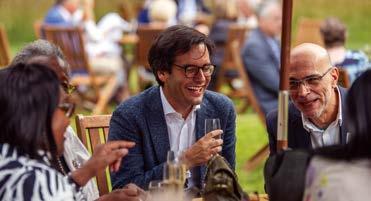





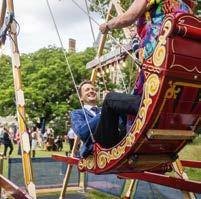




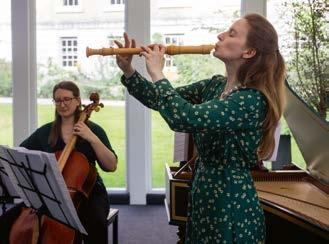



2022 BOOK PRIZE AWARD CEREMONY
Held on 23 February 2023, sponsored by Wildy & Sons Limited
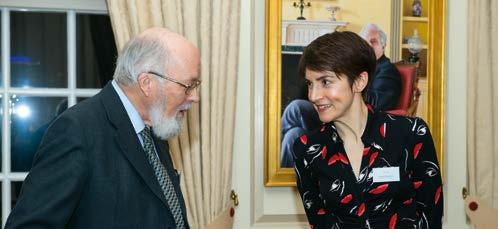
SPEECH BY MASTER TREASURER
Master Rosalyn Higgins, fellow Benchers and members of The Inner Temple, distinguished Book Prize finalists, ladies and gentlemen, I am delighted to welcome you all to the fifth of our triennial Inner Temple Book Prize.
Master Kenneth Olisa is sadly unable to be with us due to illness, but I am delighted to come off the bench to present the prizes for our Inner Temple Book Prize whose reputation goes from strength to strength.
In 2011, as the Inn’s Royal Treasurer, HRH was asked to be Patron of the Prize and wrote this in the Prize’s prospectus: It was first awarded in 2008 as part of the Inn’s celebrations to mark the 400th anniversary of the grant by King James I of the Temple’s Royal Charter and which acknowledged what was already by then a centuries old tradition of Legal education.
This prize maintains that commitment by encouraging scholarly contribution to the understanding of the law as administered in England and Wales.
I congratulate The Inner Temple on this worthy venture which I am confident will grow in reputation and stature as it becomes a permanent feature in our legal landscape.”
I congratulate The Inner Temple on this worthy venture which I am confident will grow in reputation and stature as it becomes a permanent feature in our legal landscape.”
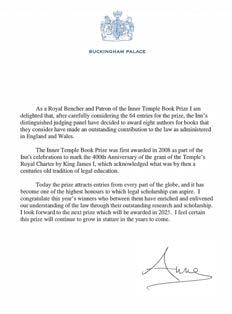 Her Royal Highness has been good enough to write some comments for tonight’s programme:
Her Royal Highness has been good enough to write some comments for tonight’s programme:

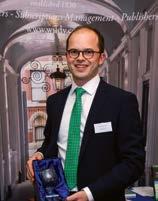

The Inn’s Royal Charter lays down for all time the Inn’s responsibility to practice and teach the law, and it is evident to a visitor to The Inner Temple today that the Inn continues to honour this commitment made 400 years ago.
As the Treasurer of the Inn, I am proud of all that Inner Temple is doing to engage with the training of barristers at home and abroad. We have a truly international reach. Since 2019 Call nights feature students from 50 countries around the world. So, we make a real contribution to the maintenance of the rule of law in the common law world.
I am proud of all that Inner Temple is doing to engage with the training of barristers at home and abroad. We have a truly international reach. Since 2019 Call nights feature students from 50 countries around the world. So, we make a real contribution to the maintenance of the rule of law in the common law world.”
The Inner Temple supports our members throughout their professional careers, from their student days through to their service as judges with lectures, seminars, debates, advocacy classes and other activities which in fulfilment of the Inn’s obligation and commitment to legal education. Long gone are the days when a barrister’s education consisted of a moot organised by Master Reader and a series of dinners… even if we have happily not given up the social side of our activities! The new education and training facilities, where we are now, provide an excellent environment for learning and are well equipped to support hybrid events thereby improving accessibility and inclusivity. We have responded to regulatory reform with developments to its qualifying sessions, justly praised by the BSB, alongside provision of new practitioner training. I am also proud of our evolving programme of educational events for established barristers, ranging from practical career advice to developing communication skills and dealing with distressing material.
Perhaps the most important and remarkable contribution to all this is given by the Benchers and members of the Inn who freely give up their spare time to share their knowledge and skills with our more junior members and students. It is the basis of an ethical reputation, standard of excellence and mutual support for which the Bar is justly renowned throughout the world.
So, to why we are here this evening. The Book Prize is one of several initiatives undertaken by Inner Temple to strengthen our links with those organisations, publishers and universities who, between them, are at the heart of all that is best in legal education. The ties between the practising Bar and the academic legal world are deep and important to both.
May I therefore add my thanks to the 64 entrants for submitting their books which the judges noted were of an exceptionally high standard, the 61 Benchers and members who between them read each one carefully, the short-listing panel chaired so efficiently by Master Bernard Rix with wisdom and guidance, all those who have worked tirelessly on the administration of the prize, but most of all, the short-listed authors themselves, whose commitment to the highest standards of legal authorship resonate with all The Inner Temple does.
Thank you.
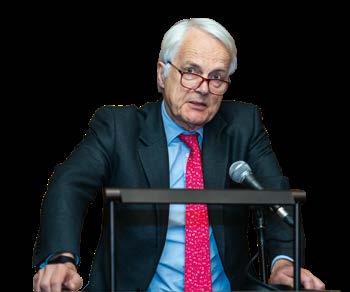 Sir Robert Francis KC Master Treasurer
Dr Richard Martin
Sir Robert Francis KC Master Treasurer
Dr Richard Martin
SPEECH BY
MASTER ROSALYN HIGGINSMaster Treasurer, fellow Benchers, members of The Inner Temple, distinguished Book Prize winners and runners-up, ladies and gentlemen, I begin by immediately saying that I am standing in for Sir Bernard Rix, (the driving force over the years behind the Book Prize) who is very disappointed not to be able to be here tonight.
This is a very special occasion, in which all who have been involved in the 2022 Inner Temple Book Prize can meet together to celebrate the prize winners.
This is a very special occasion, in which all who have been involved in the 2022 Inner Temple Book Prize can meet together to celebrate the prize winners.”
You have heard from the Treasurer about the origins and purpose of the Book Prize. The Book Prize is an important element in the Inn’s place in the world of legal education. At the heart of the rather detailed Rules of Entry is the following: “The criterion to be applied in deciding on the award of prizes is the extent to which the book makes an outstanding scholarly contribution to the understanding of the law as administered in England and Wales”.
If that phrase seems to narrow eligibility, it is immediately followed by these words: “subject to that consideration, works dealing with international law, comparative law, the law of the European Union, the Commonwealth or other international organisation, legal history, legal philosophy, sociology of law, or criminology and the treatment of offenders will be eligible for consideration”.
Master Treasurer, you may imagine that some of the entries we honour this year have required some rather careful scrutiny of these eligibility criteria!
The prize winners and runners-up can feel special pride in the fact that their books have passed not only stiff competition, but also the rigorous examination of the Judging Panel. Your contributions have been judged by a retired High Court Judge, two retired Justices of the Court of Appeal, two current members of the Court of Appeal, a former President of the International Court of Justice and three leading academic practitioners. Not an easy panel, our authors might feel.
The Inner Temple Book Prize has become well known, and much valued, by publishers and writers alike. The panel reads every single book that is long-short listed. This time we had 64 entries, and obviously to read each and every one of these is not possible. We owe a debt of great gratitude to the 61 Benchers and members of the Inn who volunteered at the initial phase to read an entry and we are very pleased to see some of them here tonight. Every single entry was carefully read and marked by reference to specified criteria; enabling the panel, after reading each of these assessments, to agree upon a long-short list at its first meeting.
Given the breadth of expertise of the panel members, there is usually a pool of knowledge on the subject matter of most submitted books. But each member will read every single shortlisted book, whether or not it is about a familiar subject matter. You may imagine that this is a very heavy task. When filling our wheeled suitcases with a pile of hugely varied books, we could be forgiven for feeling somewhat daunted about what lies ahead. But then we can only feel ashamed as we receive the email circulated by Professor Sir John Baker, saying “Can’t wait…”


Then there is yet more reading, in which your magnum opus is assessed in a written commentary. The panel meets again, the leading contenders start to emerge, and we each take away any books we have not yet read. Again, written views are sent in. Master Rix then has the job of making some sense of it all. Further meetings, discussions, reading and eventual voting then follow. For you to have come through as winners and runners-up is a very considerable achievement.
This year the merits of Professor Jo Braithwaite’s book The Financial Courts and Professor Neil Duxbury’s book The Intricacies of Dicta and Dissent could not be separated, and so, very unusually, we have joint winners of the Main Prize. We found Professor Braithwaite’s examination of a specialised subject – a technical study on an important and growing subject – not only scholarly but also accessible and interesting for the non-specialist. We found impressive analysis and persuasive interpretation of the International Swaps and Derivatives Association Agreement. Each chapter was well footnoted and clearly presented cutting through financial jargon and complexities.
It is a great shame that Professor Duxbury cannot be with us this evening. His book is essentially designed to get judges thinking about the legal implications of what they say in their written judgments. It contains fascinating insights into current practice in a variety of courts and is rooted in a deep, deep knowledge of English case law. What weight may dicta have in a later judgment, or should reference be made only to the ratio decidendi? Huge knowledge must have been required to know where to go for examination of different dicta. Dissents, the other part of Professor Duxbury’s book, are more easily ascertainable. Each of us admired the scholarship

MAIN PRIZE WINNER AND RUNNERS UP
Joint Winners of the £12,000 Inner Temple Book Prize
Professor Jo Braithwaite
The Financial Courts: Adjudicating Disputes in Derivatives Markets (Cambridge University Press)
Professor Neil Duxbury
The Intricacies of Dicta and Dissent (Cambridge University Press)
Runners up
Professor Richard Helmholz
The Profession of Ecclesiastical Lawyers: An Historical Introduction (Cambridge University Press)
Professor N W Barber
The Principles of Constitutionalism (Oxford University Press)
and depth of thinking, some being especially appreciative of the part on dicta, and others of the part on dissents.
As for Dr Bell’s winning entry in the New Authors’ category, I think I don’t disclose too much when I say there was a high degree of agreement on The Anatomy of Administrative Law as the winner. The study was rooted in serious scholarship. The underlying theme that there is no single principle guiding the development of administrative law is rigorously tested in well selected cases against a range of criteria. It was hard for us to believe that this was indeed written by a ‘new author’. So, we congratulate the prize winners and also the runnersup in each of the categories. In the New Authors’ category Joshua Hitchens and Niamh Daly for Forced Marriage Law and Practice, and Dr Richard Martin Policing Human Rights: Law, Narratives and Practice; and in the Main Prize category Professor Barber for The Principles of Constitutionalism, and Professor Richard Helmholz for The Profession of Ecclesiastical Lawyers
I know that Master Rix, for whom I am standing in, would not wish me to conclude my remarks without thanking his fellow panellists for all their hard work. And warm thanks are also due to Celia Pilkington, The Inner Temple Archivist, who was our contact with publishers and ensured that we each had the books we needed at each stage of proceedings and stood ready to answer every question we had. And our appreciative thanks too to Rob Hodgson, our Librarian and Keeper of Manuscripts, who kept meticulous track of absolutely everything.
Her Excellency Dame Rosalyn Higgins GBE KC JSD FBA Master of the Bench
NEW AUTHOR’S PRIZE WINNER AND RUNNERS UP Winner of the £5,000 New Author’s Prize
Dr Joanna Bell
The Anatomy of Administrative Law (Hart Publishing)
Runners up
Joshua Hitchens and Niamh Daly
Forced Marriage, Law and Practice (Bloomsbury)
Dr Richard Martin
Policing Human Rights: Law, Narratives and Practice (Oxford University Press)
JUDGING PANEL
Professor Sir John Baker KC LLD FBA
The Rt Hon Lord Justice Dingemans
The Rt Hon Sir Patrick Elias
The Rt Hon Dame Elizabeth Gloster DBE
Her Excellency Dame Rosalyn Higgins GBE KC JSD FBA
Nigel Pleming KC
The Rt Hon Lord Justice Popplewell
The Rt Hon Sir Bernard Rix
Professor Cheryl Thomas KC (Hon)
Professor Leslie Thomas KC
Sir Michael Tugendhat
THE SOCIAL CONTEXT OF THE LAW: IS OUR ADVERSARIAL SYSTEM FIT FOR PURPOSE?
The Inner Temple Social Context of the Law discussion held on 12 June 2023 between Master Iain Bonomy and David Perry KC, moderated by Master Geoffrey Nice

Master Geoffrey Nice: Welcome to this event tonight dealing with the question of the adversarial process. Is it fit for purpose? We live in the best parliamentary democracy in the world, which also uses, in large part, the adversarial system, as does the judicial system, which the Lord Chief Justice regularly tells us is the best judicial system in the world.
Maybe there are reasons at least to question the adversarial system when we come to the criminal side, or the criminal trials side of it. Who can have any doubts that in 1950 when Timothy Evans approached, as he did, with the chaplain on his one side reading from the book, the noose ahead of him for a crime he did not commit, he said, “Well, at least I’ve been tried to death by the best legal system in the world.” Something that maybe some of the Birmingham bombers also might have said. It is undoubtedly a system that needs consideration.

The adversarial system has, of course, been sensitive to the need to change, and it has changed over time in very significant ways, which have diminished what might be thought the disadvantages of the adversarial system – the sweeping away that some of us will remember of technical rules about corroboration; about the evidence of wives and matters of that sort, happened, and thus technical arguments within the adversarial system that stopped trials going ahead came to an end. Perhaps the greatest single change of all which has changed the nature of the adversarial British jury trial was the abolition of the absolute right to silence of an accused person, which means that our system and America’s are completely divided. In America, no defendant gives evidence, in England more or less every defendant does. So, the trials have become much more like inquiries into truth, but they still carry with them the single continuing line of belief in the adversarial process, which goes back the best part of a thousand years.

Master Iain Bonomy: Initially, I was thrown by the reference to ‘our’ adversarial system in the question. I’m not sure that all are the same, however, there’s no point in debating that, so I decided not to dwell on it and instead concentrate on the systems with which I am familiar – that’s in Scotland and also in the international criminal justice system.
Our Law Reports in Scotland are littered with judicial expressions of frustration at the lack of control judges have over proceedings, and the absence of a dedicated aim to ascertain the truth, that are core weaknesses of the system. We know that the absence of judicial control is recognised as a core weakness because of all the efforts over the years that have been made to introduce judicial case management and then to develop it.
The adversarial system has, of course, been sensitive to the need to change, and it has changed over time in very significant ways, which have diminished what might be thought the disadvantages of the adversarial system.
Probably the best example I can give of the expression of that frustration was the opinion of the Lord Justice Clerk Thomson in a case in 1961, when he said: “Judges sometimes flatter themselves by thinking that their function is the ascertainment of truth. This is only in a very limited sense. Our system of administering justice and civil affairs proceeds on the footing that each side, working at arm’s length, selects its own evidence. It’s on the basis of two carefully selected versions that the judge is finally called upon to adjudicate.” He cannot make investigations on his own behalf and he cannot call witnesses. Litigation is in essence a trial of skill between opposing parties conducted under recognised rules, and the prize is a judge’s decision. We’ve rejected inquisitorial methods and prefer to regard our judges as entirely independent. Like referees at boxing contests, they see that the rules are kept and count the points.
We know also the very fact that control of the proceedings lies in the hands of the parties, up to 50 per cent or so of whom have reason to conceal the truth, means that elements in the system may be used – indeed are used – to frustrate the quest for the truth. One of the prime tools deployed for that purpose is of course cross-examination, with its ever-attendant risk that attention, particularly that of a jury, will be focused on the performance of the cross-examining counsel, and on his leading questions, both frequently distractions from the only real meaningful subject matter of the case: the evidence.
Law Courts have over many years doubled as performance spaces for many who would find themselves very much at home on the stage. The content, delivery and timing of a leading question on an important issue in the case can often have an impact on the result way beyond the significance of the answer. So, it is my first submission, that that point alone is sufficient to demand a negative answer to the question posed tonight.
And just as you are blessed in the courts of England and Wales with many very talented advocates skilled in the art of stretching the rules to their advantage, the same is the case in Scotland. Let me give you an example from 2014. A case involving 17 historic charges of sexual abuse in the early 90s. The two-day cross-examination of the complainer by senior counsel opened with this exchange: “You are a wicked, deceitful, malicious, vindictive liar?”
In the end of the day, the appeal was dismissed. After refusing the appeal, the court said: “Due regard must be had to the right or privilege under domestic law to test the witness’s evidence by properly directed and focused cross-examination. That right, however, does not extend to insulting or intimidating a witness. It also requires to be balanced against the right of a witness to be afforded some respect for her dignity and privacy. The court must be prepared, (where) appropriate, to interfere when cross-examination strays beyond proper bounds.” So, my second submission is that the actual damage done and the potential for damage to be done to witnesses in the course of cross-examination also demands a negative answer to the question.
Transport that style of cross-examination to the International Criminal Court set-up and try to imagine the state of confusion and shame engendered in the minds of Albanian women, victims of sexual assault and rape in the course of the conflict by Serbian soldiers. For reasons related to social mores, many delayed reporting these attacks for fear of being ostracised by family and friends. Counsel and accused – who often conducted their own defences – nevertheless repeatedly accused them simply of lying or giving evidence that was completely unbelievable without establishing any basis for the accusation.
In fairness to the judges, it’s a difficult situation to handle, when you can’t actually anticipate exactly what the question coming will contain. Similarly, even with a proper foundation, calling an Albanian farmer, a peasant farmer, a liar – that was instantly perceived as a personal insult of the gravest kind. The initial reaction of the witness was confusion, then when told that the accused was simply putting his case in this way as an assertion because that was part of the system – there followed a tirade of offensive abuse of counsel. Witnesses were even seen to collapse – female witnesses, accused in the way that they were, on two occasions I was present, simply collapsed in the witness box.
So, that’s my third point – it’s unfair to a witness who is genuinely unfamiliar with the system, and again, demands a negative answer. And my fourth and final point is that the fact that we, with the aim of protecting vulnerable witnesses, have been modifying our ordinary adversarial rules –specifically for sexual offence and rape trials since the 1970s, and now in the 2020s are contemplating more radical changes than ever before – proves not only that the system is not fit for purpose, but also that it is beyond repair.
I note that the Law Commission of England and Wales is hard at work here, and that in Scotland a pilot study of judge-only courts, to be followed by a Civil Service evaluation of the results, is proposed. Every association in Scotland representing solicitors throughout the country has vowed to boycott the pilot. That’s not surprising because it follows a statement by the Justice Secretary that he would consider any radical reforms to trial procedures if they would improve conviction rates for sex crime. So, for these reasons, I beg to move the question be answered in the negative.
Litigation is in essence a trial of skill between opposing parties conducted under recognised rules, and the prize is a judge’s decision. We’ve rejected inquisitorial methods and prefer to regard our judges as entirely independent. Like referees at boxing contests, they see that the rules are kept and count the points.

David Perry KC: I will be contending that the Anglo-American adversarial trial is among the chief glories of the common law system. It has stood the test of time. It has the common law’s genius for evolution and adaptation, and it is the system for which we would all contend if, behind a veil of ignorance, we were asked to design a system in which we ourselves might stand accused of crime. The motion raises two issues. First, what is the adversarial system? And second, what is its purpose?
The defining feature of the English adversarial system is that it involves trials conducted by skilful professionals on both sides of the case. We can thank the adversarial system for the fact that this jurisdiction has such brilliant lawyers, who are themselves responsible for bringing about legal change. Nowhere else in Europe, or anywhere in the world, will you find such skilful practical professionals on both sides of the case.
In the European systems, by contrast, evidence is gathered by judges or judge-like investigators, public officers, who are charged with the duty to investigate, and the facts and the criminal investigation becomes the judicial function. This is the very reason we moved away from that sort of system to the adversarial system because our experience was that judges bullied defendants into pleading guilty, or they didn’t give them a trial. In the European trial, the presiding judge examines the witnesses. The lawyers for the prosecution and the defence play subordinate roles, mostly recommending lines of inquiry, sometimes supplementing the court’s questioning of witnesses.
As for the second issue, the purpose of adjudication in the adversarial system is to do justice. And what does justice mean in every case? It means the guilty are convicted and the innocent go free. But those aren’t the only values that we recognise in our system. There are normative aspects to a criminal trial. The adversarial trial is not simply about the prevention of crime. The conviction of the guilty and the acquittal of the innocent should also take place in a fair and open manner, which commands public confidence, and where the parties participate on equal terms – this is the adversarial system.
The adversarial system took shape relatively late in English legal history. Until the late 1600s trials were largely do-ityourself affairs. The main purpose of the trial, this contest of amateurs, was to give the accused an opportunity to speak in person, and there was no room for defence counsel, the defendant was expected to clear himself. Like the presiding judge in Europe, the judge would take control of the proceedings. It all sounds absolutely fine until you get to the Monmouth Rebellion, and Judge Jeffreys goes to the West Country and has batches of verdicts. About 600 people are convicted in less than a week, the average time of the trials is about eight minutes.
So, what did parliament do? It knew that the inquisitorial system, the European system, wasn’t working. You needed to have protection against judges. So, they passed the Treason Trial Act 1696 – an act which Sir James Fitzjames Stephen called “the most unprincipled piece of class legislation ever enacted by the English parliament”. The reason why it was so unprincipled and class-based is it only applied to treason, and who was being charged with treason but the nobility? Although the Treason Trials Act 1696 allowed legal representation for those charged with treasonable intrigues, defence counsel began to appear in ordinary cases over the course of the 1700s. Until 1836, you were prohibited from having defence counsel; until that time, there’d never been a right to it. The progressive rationalisation of the law has continued to this day, but the structure of the trial has remained remarkably resilient.
I’m going to give various reasons as to what we have to thank the adversarial system for. First, we have to thank the adversarial system for a law of evidence that ensures that decision-making is rational and structured. That is what the law of evidence is designed to achieve: structured, rational decision-making. Second, it’s thanks to the adversarial system that we have a right to silence. Third, it’s thanks to the adversarial system of trial that we have the confessions rule, that excludes suspect or pre-trial confessions from consideration by a court. Unlike in Europe, where torture was countenanced, the common law set its face against torture. Fourth, it’s thanks to the adversarial system of trial that we do not allow cases to be decided by overbearing, bullying judges whose sympathies lie with the state. Fifth, it’s thanks to the adversarial system of trial that we have a ‘beyond reasonable doubt’ standard of proof – it was developed in the common law system.
We have to thank the adversarial system for a law of evidence that ensures that decision-making is rational and structured. That is what the law of evidence is designed to achieve: structured, rational decision-making.
And, above all, the adversarial system has played a role in the creation of a specialised legal profession with practical forensic skills. Anyone who practices in Strasbourg or Luxembourg will know from the judges in those courts that they always look forward to being addressed by English advocates rather than advocates from the Continental jurisdictions. The simple reason for that is that the English advocates have honed their skills to put forward their cases in the most structured and compelling way that they can. This is another value that you would lose if you changed the adversarial system. The adversarial system has reinforced the independence of the judiciary, because it is lawyers who are blamed for the problems in the law, not the judges. That is why judges are always asked to come to the rescue, to chair public inquiries.
And the system has certainly not outlived its purpose. It permits rigorous testing of testimony through crossexamination, the best mechanism yet devised for exposing mistaken or malevolent evidence. And if there are criticisms about the way that cross-examination is conducted, the fault lies with judicial management of the trial and control. The adversarial system fosters a sense of equality between the state and the citizen, as it did originally in the later Stuart times between the Crown and the subject. There is no imbalance in our system between the prosecution and the defence, and the judge is the neutral umpire. The system remains vigorous. It is fit for purpose. All litigation is an inquiry into contested truth, which in the absence of advocates would suffer from imperfect understanding. We need a strong legal profession, and we need an adversarial system. I would suggest that the answer to the motion is, the adversarial system IS fit for purpose, and it has been fit for purpose since it was introduced as a counterweight to Stuart tyranny.
The Rt Hon Lord Bonomy LLD
David Perry KC
Sir Geoffrey Nice KC
With contributions from Caroline Willbourne during the Q&A
For the full video recording: innertemple.org.uk/adversarialsystem
YOUR BAR LIAISON COMMITTEE

With the triennial elections for membership of the Bar Liaison Committee (BLC) taking place in November, why not put yourself forward for election to the committee and get involved in the work of YOUR Inn? To reflect the profession and the Inn’s commitments to fairness and equality of opportunity, we encourage as diverse a membership as possible.
Any member of the Inn who has been called to the Bar, in practice at the Self-Employed or Employed Bar, but who is not a Master of the Bench, is eligible to be elected to the BLC if three other members nominate them by email or in writing.
The BLC is a dynamic committee of pivotal importance. It is responsible for ensuring that the voices of members of the Inn are heard at all levels of the Inn’s governance and can carry significant influence in shaping future policies. Matters for discussion are necessarily diverse and wide in scope: for example, the provision and pricing of the Inn’s accommodation, catering and events generally (bearing in mind The Inn’s overriding objective of inclusivity). Where updates are sought, for example, with regard to the Bar Council’s ‘Race at the Bar’ progress report, papers are presented and constructive feedback provided.
Members of the BLC sit on all the Inn’s committees and subcommittees including the Executive Committee, Education & Training Committee, Scholarships and Outreach, Advocacy Training, Estates, Finance, Archives and International Committees. They are also active in assisting Masters of the Bench in overseeing a range of other responsibilities such as the Employed Bar Forum, the Inns of Court Alliance for Women, marshalling, mooting, debating, scholarship interviewing, the car park, the cellar, pictures and silver and student societies. Strong links are maintained with members of the Inn on circuit through their representatives on the BLC and by holding educational and social events on all the Circuits in collaboration with the Masters of the Circuits.
Promoting the Inn’s work and the society’s facilities, including dining in Hall, are also important responsibilities of BLC members. From time to time the BLC will assist in responding to Bar Standards Board consultations on behalf of the Inn.
In October, I shall be writing to members eligible for election with details of the application process. It is vitally important the BLC reflects the Inn’s diverse membership. I hope very much that you will consider putting yourself forward to further the work of The Inner Temple.
Sarah Williams Payne Hicks Beach LLP Chair of the Bar Liaison Committee
For more information about the Bar Liaison Committee, please contact Henrietta Amodio, Director of the Treasury Office and Secretary to the BLC, hamodio@innertemple.org.uk , or innertemple.org.uk/who-we-are/how-we-operate/committees/blc
PROPOSED TIMETABLE FOR ELECTIONS
NOVEMBER 2023
Date Action
23 October Online nominations open
13 November 5pm Deadline for nomination forms
20 November
27 November 5pm
If more than 17 nominations are received, online voting commences
In the event of a ballot, online voting ceases
4 December First meeting with newly elected members.
JUDICIAL PATHWAYS FOR THE EMPLOYED BAR: FIRST STEPS TO A JUDICIAL CAREER
By Master Heidi Stonecliffe
On Tuesday 28 February the Employed Barristers’ Committee and Inner Temple’s Employed Bar Forum brought together a panel of speakers to shine a light on how they secured judicial appointment coming from the position of employed barristers.
As Chair and Vice Chair of the Employed Barristers’ Committee (EBC) Stuart Alford KC and I are committed to breathing life into the recommendations arising from and contained within the Life at the Employed Bar report, which was published in early 2023. We listened closely to our fellow practitioners and set out nine recommendations that we believe will help shape and promote the Employed Bar as we move into the EBC’s 25th year. One such recommendation was to increase the opportunity for judicial appointments for those at the Employed Bar.
Nearly ten years ago, Lady Hale stated that the law, the legal profession and the courts are there to serve the whole population and not just a small section of it, and so should be as reflective of that population as it is possible to be. The Employed Bar is an incredibly diverse group with many members of the profession coming from a variety of backgrounds and offering a wealth of experience in different areas of law. We believe that encouraging more employed barristers to follow the path towards judicial appointment will improve the diversity of the courts as a whole and pays tribute to Lady Hale’s sentiments.
With this in mind, we set out to gather a panel of practitioners who had taken those steps and been successful in getting a judicial appointment whilst at the Employed Bar to impart their wisdom, experience and guidance to others who might be thinking of following in their footsteps. We could not have asked for a better panel, introduced by Master Sara Lawson, General Counsel at the Serious Fraud Office.
Brie Stevens-Hoare KC is a barrister commissioner at the Judicial Appointments Commission (JAC). She is a passionate supporter of diversity and inclusion and started our panel discussion with a much-needed practical guide to judicial appointment, setting out the ‘when’s, the ‘why’s and the ‘how’s of the process in clear terms. This was invaluable to those who had perhaps thought it to be an impenetrable system and ‘not for me’, as some of our members had expressed previously. Her clear and pragmatic advice both during and after the session allowed prospective applicants to ask about those tricky issues which often deter people from applying, and which I am quite certain will have done an enormous amount to encourage future applicants.
Venetia Jackson followed Brie. She gave a refreshingly human account of her own decision to apply for a judicial position whilst in employed practice. She gave valuable insight and guidance on sitting part time as a tribunal judge whilst juggling a busy practice at Pinsent Masons with a young family. She also gave a thoroughly honest account of the application process and how she took valuable learning from previous unsuccessful attempts when making repeat applications. Her mantra of ‘if at first you don’t succeed, try and try again’ was wonderfully positive and inspiring. She also provided excellent practical examples of how to satisfy competency examples regardless of whether you have a litigation practice.
She gave a refreshingly human account of her own decision to apply for a judicial position whilst in employed practice. She gave valuable insight and guidance on sitting part time as a tribunal judge whilst juggling a busy practice at Pinsent Masons with a young family.
Charlotte Welsh, who secured a full-time position in the Immigration Tribunal whilst working at the Crown Prosecution Service and now sits in the Upper Tribunal and as a Criminal Recorder, gave an invaluable insight into what it was like to sit in an area that was entirely different to the one she had practised in. She started her session with a stark reminder of the value of panel discussions such as this and explained how her own path to a judicial appointment had been fuelled by attending a similar session several years ago. Her account also served to remind attendees not to think narrowly about where they might apply to sit and how their experience could apply equally to positions outside their practice area. Looking outside one’s comfort zone and thinking about transferable skills was a valuable message from Charlotte which struck home with the attendees and anyone thinking of appointment in the future.

Mr Justice Leech followed with his own account of his progression from chambers to employed practice at Herbert Smith Freehills, to Deputy High Court Judge and then to full-time High Court Judge in the Chancery Division. He spoke, amongst other matters, to the benefits of being an employed practitioner when appointed to sit, telling how it provided him with greater opportunity and time to take up a judicial role and combine it with his busy practice.
He spoke, amongst other matters, to the benefits of being an employed practitioner when appointed to sit, telling how it provided him with greater opportunity and time to take up a judicial role and combine it with his busy practice.
We are indebted to all four of our panel members for their open, candid and energetic commitment to encouraging employed barristers to consider a judicial career and I hope that others who attended and who take the opportunity to view the recording of this session will be inspired by their advice.
We are also indebted to The Inner Temple for their unstinting support of the Employed Bar. As a member of the Inn since 1996 and a Bencher since 2022 I am immensely proud of the proactive and progressive approach that The Inner Temple takes to diversity and inclusion. From the very outset of my career at the Bar, The Inner Temple has continued to advance the practice of all barristers regardless of whether they are employed or self-employed and is a true stalwart of the ‘one Bar’ philosophy. We look forward to hosting further panel discussions aimed at increasing visibility and inclusion for employed practitioners and would encourage everyone to attend our next event on 9 October 2023, which will discuss the benefits of being a member of Circuit and the work that the South Eastern Circuit is doing with the Employed Bar.
WHERE THE WILD THINGS ARE


It has been over five years since I took over as Head Gardener, and during this time the Garden has evolved considerably. Most of the compliments I now receive are on how the Garden has changed to be more ‘natural’ or ‘wild’. Alongside its soft and sensory beauty, this style of gardening is also part of an increased awareness of the immediate ecological and climate crisis and a desire for gardens to be a part of the solution.
Gardening in tune with nature is not a new notion. William Robinson’s seminal book The Wild Garden was first published in 1870. Within, Robinson rejected the Victorian taste for sterile gardens created using ‘bedding’ plants of exotic annuals. Instead, he advocated a more natural aesthetic using hardy plants selected for their suitability to the conditions. In 1889 Robinson was hired to advise The Inner Temple Garden following disturbance in the Garden from laying a new electricity supply. The advice was not extensive, but it was practical: how to backfill the excavations, his dislike for the unsustainable growing of the chrysanthemums in glasshouses and, more generally, against evergreens in the Garden which could not cope with the pollution.

Robinson remains hugely influential. The need for sustainable gardening is now unquestionable. It is easy to think that all gardening by its very nature achieves this, though many traditional gardening practices – from the reliance on pesticides to peat to plastic – are detrimental to the environment. Thankfully, those at this year’s RHS Chelsea Flower Show would have noticed the seismic shift in the charity’s purpose, promoting gardening for the environment and wellbeing.
Over the past five years we have altered practices to manage the Garden with greater sustainable principles, and this work continues. We are proud to say that we no longer use pesticides or herbicides which are known to have a negative impact on pollinators and soil health, in addition to the consequences on human health not yet being fully known. We are monitoring water usage and have installed a more sustainable irrigation system (programmed to come on at night when watering is more efficient) from an onsite bore hole, removing the need to use mains-treated water on the Garden. We have reduced fertilisers considerably and largely replaced them with organic alternatives.


In addition, we have stopped the practice of unsustainable bedding displays, previously used in the Long Border by Paper Buildings, in favour of a mixed herbaceous border. Also, we have converted areas of formal lawn or empty tree circles into beautiful meadows or long grass areas which sustain a host of pollinators and invertebrates. I have been a long-time supporter of the ecological wildflower projects of Richard Scott, the Director of the National Wildflower Centre at Eden Project. It was lovely having him call into the Garden in June to see the work we have been doing and discuss ways in which we may be able to work together in future.
Since 2022, we have been working with Pollinating London
Together (PLT) who have been using the Garden as a site for its research to gather data on the diversity of pollinators in the City of London. PLT also educates on how to increase the range and diversity of pollinators with recommendations for plants and habitat. From PLT, the team has learnt that the well-intentioned introduction of beehives on a large scale in London has put a strain on the population of wild bees and other pollinators, as the honeybee hives compete for floral resources. I was astounded to learn there are over 270 bee species in the UK, honeybees accounting for just one. Therefore, the work we are doing with PLT is to preserve and create food sources and habitats in the Garden to support the other pollinator species.
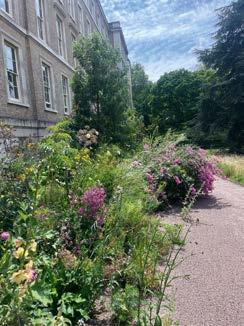

Hopefully many of you have already read gardener Christine’s Nature Journal article in the Trinity edition of Innerview. If not, it is still available on the website and well worth a read. Christine has been keeping a nature journal, logging which different bees, butterflies, moths, flies, and birds are in the Garden and uploading this data onto apps for scientists to use. As part of this, she has been putting out moth boxes at night to monitor what species we have in the Garden. In her article, Christine draws attention to a recent study by the University of Sussex that found moths – of which there are 2,500 species compared to 57 species of butterfly in the UK – are more efficient pollinators at night than day-flying pollinators, namely bees.
Christine has been transformative in sharing her passion and knowledge for biodiversity with the team. Sadly, with a tear in our eye, we said bon voyage to Christine in August as she and her family moved back to France. Christine leaves a valuable legacy in the Garden team; we now see the importance and beauty of moths and flies as pollinators or an ant hill in the meadow as a food source for the many birds we have in the Garden. We will continue the work Christine has so passionately encouraged, continuing to log the different species and work to create habitat in the Garden to support as many species as possible. Our objective is to marry excellent horticultural standards in a grade II listed garden with progressive ecological principles.
 The Long Border by Paper Buildings. Formerly a bedding display replanted twice a year now a mixed herbacous border
Meadow © Paul Debois
Gardener, Christine Bouet Battisti has been transformative in promoting biodiversity in the Garden
The Long Border by Paper Buildings. Formerly a bedding display replanted twice a year now a mixed herbacous border
Meadow © Paul Debois
Gardener, Christine Bouet Battisti has been transformative in promoting biodiversity in the Garden



There is no doubt that the climate and ecological crisis is upon us and accelerating faster than predicted, with extremes of temperature and flooding both in the UK and globally. In terms of biodiversity in the UK, Kew has reported that since the 1930s we have lost 97 per cent of our wildflower meadows and the British Trust for Ornithology (BTO) reports that since the 1970s we have lost close to 30 million house sparrows. A large proportion of this biodiversity crisis can be attributed to changes in farming practices, but gardens have an important role, especially in the City.
While monitoring is an important part of countering what is happening, so is action. Initiatives such as ‘No Mow May’ are starting to change public perceptions, though I can have some issues with such campaigns. Ideally, we should be encouraging people, and importantly councils, to leave areas of long grass or meadow longer than just May. This said, I understand ‘No Mow Summer’ doesn’t have quite the same ring and any step in the right direction is welcome.



A
large proportion of this biodiversity crisis can be attributed to changes in farming practices, but gardens have an important role, especially in the City.
It is hoped the developments we are carrying out in the Garden with our meadows and other biodiversity initiatives act as inspiration to others, demonstrating it is possible to garden along ecological principles in a historic and beautiful garden. There is still much to learn, understand and implement to ensure the Garden truly delivers all it can in terms of climate and biodiversity. Though the speed of the crisis is alarming, it is empowering to feel that the Garden can be part of the solution, creating a sanctuary for biodiversity and people in the heart of the City of London.
Sean Harkin
Head Gardener

 T moth
Christine setting up Moth Trap Jersey Tiger moth Wildflowers where previously a barked tree circle
New meadow area in front of Paper Building
Sean with Richard Scott of National Wildflower Centre, Eden Project
T moth
Christine setting up Moth Trap Jersey Tiger moth Wildflowers where previously a barked tree circle
New meadow area in front of Paper Building
Sean with Richard Scott of National Wildflower Centre, Eden Project
IN MEMORIAM
The Inn mourns members of the Inn who have died in the past year: *
Mrs
Mr
Mr
Mr
The
Mr
Mr

Mr

HISTORY SOCIETY LECTURE: THREE TREASURES FROM THE LIBRARY
By Master John BakerFrom a lecture delivered on 26 July 2023

ONE
The Clifford’s Inn triptych is a unique link with medieval legal education. The Inns of Court and Chancery probably came into existence around 1340, when the legal profession returned en masse from a five-year exile in York. Clifford’s Inn was the earliest of all the Inns to be mentioned specifically in surviving records (in 1344). It took its name from the owner of the freehold, Lord de Clifford. When the society was dissolved in 1903, some of the armorial windows were placed in The Inner Temple Library, and a minute-book from 1610 to 1740 (the oldest from any of the Inns of Chancery) was also given to the Library; all were destroyed by enemy action in 1941. Two other windows survive in the Judge’s Room of the Mayor’s and City of London Court, one with the arms of William Skrene, who was called to be a serjeant in 1396 directly from Clifford’s Inn –sometimes treated as evidence that it was once an Inn of Court.
The medieval hall of Clifford’s Inn was demolished by developers in 1934 and is said to have been taken (in pieces) to America. (Where is it now?) But the triptych with the ancient statutes of the Inn, which had hung in the hall for nearly 300 years, had already been transferred to the Inner Temple in 1903 and survived. As long ago as 1800 it was said to be scarcely legible, and in 1902 Hay-Edwards (in his history of the Inn) said that nothing of the writing remained except the illuminated capital letters. In fact – grimy and faded though it is – the text can nearly all be read. There are four columns containing 47 numbered paragraphs, written in law French, with the Tudor royal arms at the head.


The caption is the most badly damaged part, and some crucial words are lost, but almost all the missing text can be supplied from a 17th century transcript found in a solicitor’s office in Brick Court in 1998. Translated into English, it reads:
“These are the statutes and ordinances made to be held and kept for the good and honourable governance of the new Inn in ‘Chancellor Lane’, renewed and newly written in Clifford’s Inn in the [twenty-something] year of King Henry VII, in the time of Lawrence Holland, then principal there, and now newly written in the twentieth year of King Henry VIII, Hugh Goodman being principal”.
Holland was principal from 1504 to about 1510, and so the ‘renewal’ must date from about 20 years before the engrossment on vellum in 1528 or 1529. Whatever renewal meant, it does not seem to have involved much editorial work. The text is in no rational order and seems to be a random compilation of orders made at different times. Statute 20 is actually dated 1478 and must be an addition to an earlier code. Statute 24 forbids the playing of ‘new fair’, a gambling game otherwise known only from Langland’s Piers Plowman, written in the late 1300s. So, the earliest of the statutes may even date from before 1400.
The caption contains an unsolved puzzle. It tells us that the renewal was made in Clifford’s Inn. But the preceding words, only recently deciphered, say that the original statutes and ordinances were made for the “new inn in Chancellor’s Lane”. What, then, was this ‘new inn’? Was it the society set up in Lord de Clifford’s house in the 1340s? Does ‘new’ here refer to the 1340s? Clifford’s Inn certainly had an entrance in Chancery Lane. But there was a different inn further up the lane, facing what is now Lincoln’s Inn. This was from 1353 to 1374 the house of John of Tamworth, a Master in Chancery, and was used for training Chancery clerks. Sometimes called Tamworth’s Inn, it was also by 1368 called the New Inn. References to the New Inn in Chancellor’s Lane have recently been found from 1412 and 1429, by which time Clifford’s Inn was known by that name. (To confuse matters, there was also an Inn of Chancery near the Aldwych called New Inn –which, like Clifford’s Inn, survived into the 20th century).
Clifford’s Inn Hall Clifford’s Inn Triptych
Tamworth’s Inn never became an Inn of Chancery in the later sense, and we do not know for certain why the lesser Inns were so called. Medieval Chancery clerks were supposed to be trained in the Lord Chancellor’s household, or in the households of the masters (the 12 senior clerks, headed by the Master of the Rolls) – and Tamworth’s Inn was one such. They had nothing much to do with the Court of Chancery –the Chancery was first and foremost the royal secretariat. Oddly, however, the eight Inns of Chancery which survived are not known to have begun in that way. Possibly some originally had Chancery masters in control. Clifford’s Inn did have a few Chancery clerks among its senior members in the 15th century, but they were a minority. It is more telling that the 1344 reference to the Inn mentioned ‘apprentices’, the name used for students of the common law and not for clerks learning to serve the Chancery – who were actually forbidden to mix with apprentices. The so-called Inns of Chancery all educated young students of common law, though the Lord Chancellor exercised some kind of control over them. How that superintendence came about is obscure. There may have been some analogy with university chancellors. More likely it recalled an earlier world in which senior Chancery clerks such as Tamworth had given lectures on the writs – the starting point of all legal study. By the early 1500s that world was long gone, and the Chancellor surrendered his supervisory role to the Inns of Court. Clifford’s Inn, together with Clement’s Inn and Lyons Inn, then became attached to the Inner Temple. I will leave the puzzle there and return to the statutes. The glimmers of light which they shed on the educational system are slight, though it is the earliest light we have. In statute 9 there is a reference to “learning according to the custom of the court”. Everyone knew what that was, so it isn’t spelt out; but ‘custom of the court’ is an intriguing expression in this context. Statute 8, dealing with disorders, mentions three learning exercises: “the examination of the writs”, “the declaration of the opening (?)” and “court baron”. It seems likely that the first and last correspond with the 14th-century treatises Natura Brevium and Curia Baronum, which began as lectures. Statute 40, probably of later date, mentions four exercises: writ-reading, lecture, moot and report. It also refers to the Reader of the Inn. The fines laid down for defaulting show that moots were considered the most important exercise, whereas missing the writ-reading – perhaps a passage from the Natura Brevium – only cost 6d. The penultimate chapter, probably a Tudor addition, refers to utter and inner barristers. As in the Inns of Court, these ranks related originally to mooting; an utter barrister was a member who had been called up to argue a moot at the bar of his Inn. But a barrister of an Inn of Chancery had no standing outside it; to acquire a right of audience in courts of law he had to progress to an Inn of Court, and again graduate from inner barrister to utter barrister by performing a moot.
Like so many codes, the statutes omit to tell us what everyone knew. Written regulation was needed only for the minutiae of governance and discipline. Of this we learn quite a lot. The members were called compaignons (fellows). There were no admission qualifications, save that a fellow had to find two sureties, had to be able to pay his pension (a room-rent of 3s or

more), his commons and dues, and 13d for his pewter plate and saucer. Fellows took it in turns to be steward for a week, unless excused (on payment of 1s). The steward was responsible for the cloths, cups and salts, for buying bread and ale, for shutting the gates at night, and for reporting anyone who came in after the gates were shut. The Inn had a principal, and the principal had a council (later known as the ‘ancients’). Fellows were forbidden to “make construction” of the statutes against the principal and council, or to plot or compass the removal of the principal without the consent of the council. Speaking opprobrious words of the principal resulted in expulsion from commons. There were several rules about commons. Any pensioner spotted between St Paul’s and Temple Bar was deemed to be in commons and charged for meals, whether or not he ate them; other members might be charged for ‘repasts’ (meals paid for separately). Drink was available at the buttery during dinner and supper, but strangers were not to be introduced, on pain of 6d. Attendance during Christmas was compulsory for two years after admittance, and the 1478 order mentions the election of a Christmas marshal to oversee festivities.




We know that the students, who were mostly from gentry families, were aged about 18 on admission, and we find paternalistic measures in Clifford’s Inn such as the rule that they should not mortgage their hutches (ie trunks with their belongings) or enter into usurious loans. Minimum standards of behaviour were required. Fellows were not to disgrace the Inn by going out to pursue vendettas, or by bringing in women of ill repute; such major offences incurred a fine of 6s 8d. Breaking down the buttery door, or procuring it to be opened “by art or engine”, cost 12d, doubled for a second offence, with expulsion for a third – drink was in high demand. Fellows were not to speak ribaldry in Hall, on pain of a farthing a word. Causing an argument – not a legal argument, that is – cost 6d. They were not to play tennis, dice, cards or quoits, or to keep greyhounds, spaniels or mastiffs. For drawing a knife or sword in play, the penalty was only 1d a time, though striking another with fist, staff, knife, dagger or other object, cost 12d (provided no blood was drawn) besides amends to the victim. (Evidently, kicking or throttling were not foreseen.) Bloodshed meant a fine of 6s 8d and expulsion. Drawing a weapon in anger on another fellow, or on the cook, also merited expulsion. These regulations evoke the violence and misrule which were endemic in a community of young students far from home, without tutorial oversight.
Similar regulations were in due course made for the other inns of chancery. But the old statutes of Clifford’s Inn, even if we cannot precisely pick apart and date the component elements, include within them the remains of the earliest written regulations for any of the legal inns and provide a vivid insight into student life in these medieval societies.
TWO
The four beautiful illustrations of the 15th century courts take us from Chancery Lane to the more exalted atmosphere of Westminster Hall. They were excised from an abridgment (or digest) of cases written around 1450–53. We know it was an abridgment because the slightly smaller Common Pleas picture on the first page has beneath it (and on the verso) the beginning of an alphabetical index of the titles. And the date may be calculated from the depiction of seven judges sitting in that court, something which only happened between Michaelmas 1450 and June 1453.
These priceless paintings, though ignored by art historians, are a landmark in the history of English secular art. They are also the earliest pictures of English law courts in action. Indeed, they are the only coloured representations of the principal courts before the 18th century. They were presented by Master Darling, Treasurer in 1914. All we know of their provenance is that in 1860 they belonged to Selby Lowndes of Whaddon Hall,

Buckinghamshire. His ancestor William Fleetwood (d 1594), Serjeant-at-Law and Recorder of London, was a collector of fine legal manuscripts. It was also pointed out in 1860 that the antiquary Browne Willis (a member of the Inner Temple) lived at Whaddon Hall until his death in 1760. But Willis’s manuscripts were left to the Bodleian Library and are still there (110 in number). I can throw in a third connection. Whaddon Hall belonged in the time of Henry VIII to Thomas Pigot, Reader of the Inner Temple in 1501, later a King’s Serjeant. Serjeant Pigot owned a fine illuminated statute-book, now in the Bodleian Library, and so he obviously liked expensive books. But whether any of these owned the manuscript is unknown.
The Whaddon Hall volume must have been commissioned for a significant person in the law. Abridgments were a new invention in 1450, and this was one of the first. None of the others which have survived contain any pictures. Indeed, no other English legal manuscripts have full-page illustrations, and most have no adornment at all. The only other decorated law books in the period are the showpiece statute-books on vellum, such as Serjeant Pigot’s, which often have initial letters with pictures of a king sitting in parliament. That is a genre well known to art historians. But the little miniatures do not contain anything approaching the level of detail found in the Whaddon Hall manuscript. They do not even show us what the House of Lords looked like. The closest comparator is the full-page picture in the Mayor of Bristol’s Calendar by Robert Ricaut, town clerk, which shows a mayor taking the oath of office in the town’s council chamber: the concept is similar, though the painting is less accomplished and a quarter of a century later in date (1479).
I will say a little about each of the miniatures in turn. The Common Pleas was on the front page because, though formally inferior to the King’s Bench, it was the most important of the four courts in terms of business. The judges are sitting on a raised bench beneath a blue cloth of estate with the royal arms flanked by the arms of Edward the Confessor (founder of the palace in which they sat) and England. In front of the judges is a huge table covered with green cloth, and outside that (in the foreground) a substantial bar – an oak barrier at least four feet in height. The court is a scene of activity. Around the table, on all four sides, sit the various clerks with their parchment rolls, pen-cases and inkwells, and a book bound in red (probably a Bible for swearing jurors and witnesses). If they were all present, there would have been at least 20 clerks: the three chief clerks (called prothonotaries), who kept the rolls with pleadings and judgments; the thirteen filacers, who kept rolls recording mesne process; and the four exigenters, who enrolled process leading to outlawry. On the massive table stand two criers or ushers holding short tipstaves. At the bar a dishevelled and poorly dressed defendant has been brought up in the custody of the
Mayor of Bristol’s Calendar by Robert Ricaut Court of Common Pleas
warden of the Fleet Prison, who is armed with a cutlass and carries a long staff. To the sides are five serjeants-at-law, one of whom at bottom left is taking instructions from a bare-headed attorney. Only serjeants-at-law had rights of audience in this court: indeed, they originated as the Bar of the Common Pleas. It is to be noted that the judges have no desks, or anywhere to put papers, and that the serjeants (who stand outside the bar) do not even have seats. There are no books or bundles of papers, just the Latin pleadings in the rolls. The mere threat to produce a book could be enough to defeat a shaky argument.
The serjeants and judges all wear the white linen coif, tied under the chin. Serjeants-at-law were invested with these by the Lord Chief Justice upon their creation and constituted a select order of dignity, known unofficially as the ‘order of the coif’. The judges are wearing essentially the same robes that judges still wear on ceremonial occasions: a robe, a hood around the shoulders, and over that a mantle, all of fine scarlet cloth faced with miniver. The serjeants, junior counsel, clerks and ushers all wear long parti-coloured robes, one side being of plain cloth and the other cloth of ray (that is, striped). Four of the clerks are wearing the Lancastrian livery colours of blue and white, whereas all the serjeants in this and the other pictures have blue and green. Later in the century the serjeants adopted the blue and mulberry colours of the House of York, which are also evident in the Bristol miniature. The serjeants are distinguished from lesser members of the Bar not only by their coifs but by wearing hoods.
If we move on to the King’s Bench, the scene is not dissimilar, though there are only five judges and a criminal trial is about to begin. The defendant has been brought up in the custody of the marshal, similarly armed to the warden of the Fleet, and is raising his hand on arraignment. To the left of the picture, a crier (in the Lancastrian colours) is handing the Bible to the jurors as they are sworn. Here there are only two serjeants, which is unsurprising since defendants indicted for treason, murder or felony were not allowed counsel. In the foreground we see a sorry group of prisoners awaiting trial, some of them with hardly any clothes. They are chained at the ankles, as indeed is the prisoner at the bar, despite the assertion by legal authorities such as Bracton that shackles were to be removed on arraignment. Only a few years ago this very picture was cited in America to counter the written authorities and justify the continued practice (in some states) of shackling defendants in court.
The Court of Exchequer presents a different scene. There is as yet no chequered table, though there are gold coins being counted, and banded coffers of treasure on the floor. The lock-up in the foreground is a surprising feature, but

no doubt the king’s debtors were a slippery set; being kept in a box was (I suppose) slightly less degrading than being chained. Here there are three serjeants, but also three counsel without coifs – apprentices of the law (still not called barristers). One of the apprentices is raising a bag of coins, presumably to stave off execution and have his client discharged. Only the Chief Baron has scarlet robes. That is because he was a serjeant: Piers Arderne, a former Bencher of the Inner Temple – his arms can still be seen over the fireplace in the old buttery. He was concurrently one of the Common Pleas judges, so he must have nipped across from page 1. The other judges have undyed robes of the same pattern. All five wear curious hats like those worn by chefs. This seems to have been a passing legal fashion. Finally, we come to the Court of Chancery, where we are in an even more different world. The judges here are tonsured clerics. The Chancellor, who is covered, is John Kemp, Cardinal Archbishop of York. He is wearing the scarlet cope of a doctor of law, being an Oxford law graduate who had practised in the Church courts and served as Dean of the Arches. The Master of the Rolls, also in scarlet, and reading a patent, is John Kirkby. He is wearing different robes, more like those of the judges. The four Masters in Chancery have undyed robes; their hoods are cast round their necks scarfwise, a mode of wearing hoods which lives on at Cambridge when the proctors wear their hoods ‘squared’. The Chancery literally smelt of parchment and wax, and on the table we see the chafewax with his rolling pin, pressing the matrix of the great seal on to a warm seal attached to a charter. There is also a little pile of writs waiting to be sealed. The picture suggests that these activities still took place in open court: in later centuries the seal was carried into court ceremonially, in its embroidered burse, but the wax was chafed elsewhere. (They now use plastic granules and a hydraulic press.) At the bar there are three serjeants and two apprentices. That is significant: although the Chancellor was a canon lawyer, this was not an ecclesiastical court and doctors of law had no rights of audience. Another interesting feature is the group of five characters in the foreground, perhaps instructing attorneys waiting to furnish counsel with information when required. The four miniatures were published as coloured lithographs by the Society of Antiquaries in 1864, with a slightly antiquated commentary written in 1860 by George Richard Corner (d 1863), solicitor and antiquary. They were privately republished by the Inner Temple in 1909, with Corner’s commentary but with photogravures in black and white. I would strongly recommend that they be published again, from colour photographs, so that their glorious details may be more widely known and understood.

 Court of Exchequer
Court of Chancery
Court of Exchequer
Court of Chancery


ATHREE
The third treasure is a remarkable document, one of the many manuscript treasures left to the Inn in 1707 by Master William Petyt. It is written in the hand of King Edward VI, who headed it “My devise for the succession”, and it is bound up with an undertaking signed by members of the Privy Council to support his scheme. It is thought to date from the time of the King’s final illness in 1553, when he was aged 15. To explain its significance, I will have to outline the genealogical background.
The succession to the crown had been thrown into some confusion by Henry VIII’s ‘divorces’ (annulments). His first wife, Katherine of Aragon, was the widow of his deceased brother Arthur; and the marriage had taken place with a papal dispensation from the impediment of affinity. After 24 years of marriage, Henry decided that their failure to produce a male heir was God’s punishment for breaking divine law, as revealed in Leviticus, a law with which even a pope could not dispense. In this country the law was not changed until 1921, and even then amidst much controversy. I am not sure I understand the objection: the text forbids having sex with a brother’s wife; it says nothing about a deceased brother; and there is a text in Deuteronomy which refers to a duty to marry a deceased brother’s widow. Anyway, Henry thereafter referred to Katherine as his “dear sister” and, after collecting opinions from numerous law faculties, decided he was free to marry Anne Boleyn; this was confirmed by Archbishop Cranmer. The effect of the divorce was to bastardise Princess Mary (who later had Cranmer burned to death). Three years later, the marriage to Anne Boleyn was also annulled, this time because of the King’s prior fling with Mary Boleyn. (The impediment of affinity was based on sex rather than marriage.) The effect of this divorce was to bastardise Princess Elizabeth. Assuming these divorces were valid, Henry’s only legitimate child was Prince Edward (son of Jane Seymour), who – as a male – would have become King anyway. The problem was, what should happen if Edward had no children, as by 1553 seemed certain.
Edward’s father (Henry VIII) had given the matter careful thought three years before his death. He decided to reinstate his daughters. That required legislation, since they were no longer legally his children. An Act of Parliament was passed in 1544 providing that if Edward died without issue the crown should go to Mary and her male issue, remainder to Elizabeth and her male issue, remainder (in case they had no male heirs – which, in the event, they did not) to such
persons as the king should appoint by will under his hand. The next potential heirs were the Scottish line descended from Henry VIII’s sister Margaret, queen of King James IV of Scotland, and grandmother of Mary, Queen of Scots. But Henry’s will passed over that foreign line and appointed the remainder to the issue of his deceased younger sister Mary, Dowager Queen of France and Duchess of Suffolk. That meant the crown would go (failing Mary and Elizabeth and any issue they had) to the issue of Mary’s elder daughter Frances, Duchess of Suffolk, failing whom, the heirs of Mary’s younger daughter Eleanor, Countess of Cumberland. The arrangement had parliamentary sanction, as a form of delegated legislation, though a great debate arose in the 1560s as to whether Henry’s will had in fact been signed with the king’s sign manual, in accordance with the Act, or by a stamp with a facsimile signature – the king having become almost incapable of writing. But that is another story.
Edward VI and his advisers were not happy with Henry VIII’s scheme. They took the view that the annulments of Henry’s first two marriages were applications of the law of God; and it was therefore contrary to the law of God for his illegitimate sisters Mary and Elizabeth to inherit the throne. They also took the view that half-sisters could not inherit from Edward as children of the half-blood (that is, by different mothers). It was the common law (not altered until 1833) that children of the half-blood could not inherit real property from each other. Thirdly, they took the view that Mary, Queen of Scots, could not inherit because she was born in Scotland and was therefore an alien. It was also the common law (operative until 1870) that an alien was incapable of owning freehold property in England. These were strong arguments, if the descent of the crown was governed by the same rules as the descent of land, which generally it had been.
With all this in mind, in April or May 1553 Edward produced the ‘devise’ (device) in his own handwriting; and a more detailed revision of the scheme was prepared by lawyers in an unsealed document dated 21 June 1553, signed by the privy councillors and most of the peerage. The latter was hastily suppressed later in the year and remained hidden away until 1611 when Sir Robert Cotton gave it to James I to be destroyed. (Fortunately for historians, someone kept a copy, now in the British Library). Edward’s scheme, following the logic of the common law, was to exclude the Princesses Mary and Elizabeth, and the alien Queen Mary of Scotland, and move directly to the Suffolk line. As a further embellishment, he thought it a good idea to exclude women
altogether. His device therefore limited the succession to the male heirs of Frances, Duchess of Suffolk, remainder to the male heirs of Frances’s daughter Jane, remainder to the male heirs of Frances’s second daughter Katherine and third daughter Mary, remainder to the male heirs of their respective daughters. Although England had never had a queen regnant, if we discount the Empress Matilda, most of the potential heirs were now female and so for the first time an attempt was made to exclude them all on grounds of gender. This was a legally questionable course. It was not only contrary to Henry VIII’s Act of Parliament, it was also contrary to the common law. Land could only be settled on male heirs – so as to exclude women – by means of an entail, a device founded on a statute of 1285 which did not apply to the crown. It was also an impossible course, for a different reason.
By the end of May 1553, it was obvious that Edward, now in palliative care on opiates, had only weeks to live. A crucial change was then made in the device, which may be seen in our manuscript. The King – if it is indeed his hand –altered “Lady Jane’s heirs male” to “Lady Jane and her heirs male”. The Duke of Northumberland may have been behind this. He held considerable sway over the young king and the Council, and in the very same month (May 1553) Jane Grey had become his daughter-in-law after marrying Lord Guildford Dudley. But there was a practical necessity for the change. Jane, only just married, had no issue. If the king died imminently, none of the male heirs enumerated in the device would yet have come into being; there would only be women. The whole device would therefore have failed. So, the tiny alteration brought a legitimate living person – inescapably, a woman – into the succession. It would prove to be Lady Jane Grey’s death warrant.
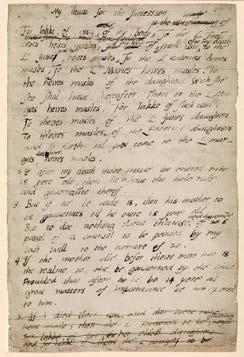
The other Petyt manuscript, which accompanied the king’s device, was signed by 20 members of the Privy Council and the law officers. The most prominent legal signatories were Sir Edward Montagu, Chief Justice of the Common Pleas, and Sir John Baker, Bencher of the Inner Temple and Chancellor of the Exchequer. Montagu CJ was worried that the device contravened the statute of 1544, especially since a statute of 1547 (passed by Edward VI’s first parliament) declared that any claim to the throne contrary to the 1544 Act was high treason in all those who supported it. Montagu arranged a meeting of all the judges in Ely House, and they confirmed that support for the king’s project would indeed be treasonable. (Alterations in the succession always faced this problem, in that they amounted to high treason until they were embodied in legislation.) When Montagu reported the judges’ opinion to the Privy Council, he was assured that it would all soon be drawn up into an Act of Parliament and the teenaged king “with sharp words and angry countenance” ordered him to carry on with the drafting. If the worst came to the worst, he would be granted a pardon. Montagu recorded that, as an “old man” – his own words (he was 65) – he “was in great fear as ever he was in all his life before, seeing the king so earnest and sharp”. So, he carried on.
But things did not go as planned. The king died on 6 July before a parliament could be called. His scheme for the succession, though approved by the Privy Council and most of the peers, was therefore still legally invalid. Northumberland nevertheless decided that it should be put into effect, and Jane was proclaimed queen on 10 July. The proclamation asserted that the crown had come to Jane by authority of the letters patent (as it called them) of 21 June. Yet within a fortnight the law prevailed and Mary’s title under the 1544 Act was accepted; it was Mary who was crowned. Northumberland was tried and executed for treason in August, Jane and her husband the following year. No pardons for the judges were forthcoming. The two chief justices, Cholmley and Montagu, must have felt some alarm when they were committed to the Tower. Was it a defence to treason that they were doing what the king ordered them to do? Probably not, in the case of a statutory treason. But after six weeks they were discharged with heavy fines of £1,000 (about £½M today). Despite their pleas in mitigation, Mary declined to reappoint either of them. The Solicitor-General (Gosnold) also lost office, though the Attorney-General and Sir John Baker somehow emerged unscathed, and Bromley J (another signatory, formerly of the Inner Temple) actually became Lord Chief Justice. Thus are the vagaries of public life.
So much for Edward’s ill-fated ‘devise’. And yet … Had he lived just a few months longer, to call a parliament in the Michaelmas term, our scrap of paper would have become law; Jane would have been assured of the crown; England would have escaped Mary I’s reign but missed the glories of Good Queen Bess. Assuming Jane or her sisters had male issue and established a House of Dudley, we would also have been deprived of the Stuarts, the United Kingdom, and the Hanoverians. Our nation’s history would have been completely different.

For the full video recording: innertemple.org.uk/librarytreasures
Professor Sir John Baker KC LLD FBA Honorary Master of the BenchCELEBRATE THE LIVES
MASTER NICHOLAS WOOD
31 January 1943–07 December 2022
Master Wood was called to the Bar in 1970 and practised at 5 Paper Buildings. He retired to Devon later in life.
Master Wood was elected a Bencher of the Inn in 1990. He was a member of the Library and Archive Committees. He was a strong supporter of the Archive Committee, offering invaluable assistance with the oral history project. He took on the task of editing many of the transcripts and produced editing guidelines for future history interviews.

MASTER MICHAEL AUSTIN-SMITH
4 September 1944–15 August 2022

MASTER JAMES GUTHRIE
21 February 1950–26 December2022
Master James Guthrie KC was called to the Bar in 1975 and joined 3 Hare Court (then at 1 Crown Office Row) the following year. He took silk in 1993, and later served as Head of Chambers for two terms, spanning nine years. He was elected a Bencher of the Inn in 2000 and sat as a Recorder until 2021. Over a long and distinguished career, Master Guthrie practised both in criminal and civil work and developed a specialist practice in the Privy Council, undertaking appeals across the full spectrum of the Judicial Committee’s jurisdiction. He became indelibly associated with the work of the Privy Council, appearing in hundreds of petitions and appeals instructed by governments, corporations and individuals.
Master Guthrie was also admitted to the Bars of the Turks and Caicos Islands, St Lucia, St Vincent and the Grenadines, Trinidad and Tobago, St Christopher and Nevis, Grenada, Bermuda, Belize, Antigua and Barbuda, and the Bahamas,
Master Austin-Smith was called to the Bar by The Inner Temple in 1969 and took silk 1990. He was Recorder from 1986 to 2014 and a Department of Trade and Industry Inspector from 1988 to 1990. Master Austin-Smith was elected a Governing Bencher of the Inn in 2002.
and he appeared in the Caribbean Court of Justice and in the Supreme Court and the Court of Appeal of Mauritius, making many friends overseas and embracing their diverse cultures.
Master Guthrie was one of the architects of PACH, the precursor to the current Pupillage Gateway, and was himself a pupil supervisor for many years, including to Master James Dingemans. He was a member of various committees including the Education & Training Committee, Investment Sub-Committee, and the Pegasus Scholarship Trust, where he served as Chair from 2014-2019. He also took particular interest in the legal action NGO, the Death Penalty Project, to help protect the human rights of those facing the death penalty.
A highly respected advocate, he wore the burdens of his important work lightly, combining an easy manner and understated charm with common sense and impeccable judgment.
 Gerard Austin-Smith QC
James Guthrie KC
Gerard Austin-Smith QC
James Guthrie KC
MASTER MARK GEORGE
10 July 1952–20 December 2022
Mark George KC was called to the Bar in 1976 and took silk in 2009. He was a member of Garden Court Chambers for over 25 years before becoming Head of Garden Court North in 2013. He specialised in criminal defence with expertise in murder, manslaughter, major drug importations and serious sexual cases. He represented 22 Hillsborough families at the 2014-2016 inquests. He was an avid supporter of Chelsea FC and fascinated by Old English, Norse History and the ancient standing stones.
Master George was elected a Bencher of the Inn in 2013. He was a long serving member of the Estates, Education & Training, and Qualifying Sessions Committees.
Garden Court North Chambers said at the time of his death, “Mark was a principled advocate, campaigner and a fighter for social justice as well at the rule of law, whose presence, friendship, strength and wisdom will be greatly missed by all who knew him.”
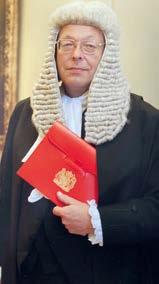

MASTER STUART DENNEY
15 June 1959–23 January 2023
Master Stuart Denney was born in Welwyn Garden City and educated at St John’s Leatherhead. After reading law at Gonville & Caius College, Cambridge, Stuart Denney KC was called to the Bar in 1982 and took silk in 2008. He specialised in criminal and regulatory law and was formerly a member of Deans Court Chambers in Manchester, where he was Head of the Criminal Department. Master Denney was pupil master to Master Sophie Cartwright and Miss Ros Elmsley Smith and delighted in the success they have both achieved.
Master Denney was elected a Bencher of the Inn in 2015. He was actively involved in education and training activities on Circuit and attended many student residential weekends, often with his wife, Master Louise Bancroft. They have one son, who did not follow them into the law, but who was his pride and joy.
Master Denney reluctantly retired from the Bar in 2021 when the physical toll on his body of long term kidney disease became too much to do the job he loved so much. In retirement, he had more time to follow the fortunes (or otherwise) of Scottish Rugby and English cricket whilst completing sudoku puzzles and cryptic crosswords in record time and, always, to enjoy a glass of his favourite Sauvignon Blanc. He died peacefully on 23 January 2023.
Master Denney was summed up by Mr Justice Mark Turner, a friend and former member of Chambers, who presided at the eulogy given at Manchester Crown Court to a packed court on 16 June 2023 as “a lion of the Bar” who “was feared in the courtroom but beloved in the robing room; direct, succinct, self-effacing, resilient. Devoid of self-pity.”
MASTER CLARE MARX
15 March 1954–26 November 2022
Dame Clare Marx was a consultant orthopaedic surgeon who was the first woman President of the British Orthopaedic Association, the first woman President of The Royal College of Surgeons and the first woman Chair of the General Medical Council, a role from which she stood down at the end of July 2021 due to a diagnosis of pancreatic cancer. In 2007 she was awarded a CBE and in 2018 a DBE for services to medicine.
Master Marx was elected as an Honorary Bencher of The Inner Temple in 2017.
An interview with Master Marx on Michael Berkeley’s Private Passions on Radio 3 is still available on BBC Radio Sounds here: www.bbc.co.uk/programmes/m0016jvh
 Dame Clare Marx DBE DL FRCS
Stuart Denney KC
Dame Clare Marx DBE DL FRCS
Stuart Denney KC

READER’S LECTURE SERIES: POLITICS AND THE LAW
From a Reader’s Lecture given by The Rt Hon The Lord Butler of Brockwell KG GCB CVO on 13 February 2023
I feel very honoured that you’ve invited me as a non-lawyer to give this lecture about the relationship between the executive and the courts. My career in the civil service coincided with the development of judicial review over the years or, as others might say, the growth of judicial activism.
I joined HM Treasury in 1961 and there was no doubt about what my job was. It was to do my utmost to stop other departments spending taxpayers’ money. As it happened, there fell within my area of responsibility the public expenditure consequences of a case which the Burma Oil Company brought against the government, which turned into a very significant development of judicial review.
The Burma Oil Company, later known as BP, had brought a case against the government for compensation for the destruction of their oil fields undertaken in Burma during World War Two to prevent the oil fields falling into the hands of Japanese. When this case was brought in the 1960s, the government believed that it could defend itself by relying on the doctrine of Crown immunity.
The essence of this was that proceedings could not be brought against the Crown for actions taken under the Royal Prerogative for the defence of the realm in wartime. The case went to the House of Lords who decided by a majority that because the damage had been undertaken in defence of the public, the owners were entitled to compensation from the public purse. The public expenditure repercussions of this decision were potentially enormous.
The government got out of the liability by passing, with retrospective effect, the War Damage Act 1965. The courts had spoken, but the executive, by parliamentary action, overruled the courts. This was constitutionally legitimate, but it was highly controversial. Nevertheless, the principle that actions taken by the government under the Royal Prerogative could be challenged in the courts was established.
As a junior official in the Treasury, I had a worm’s eye view of this episode.
Fast-forward 20 years to 1984, and I was Principal Private Secretary to the Prime Minister, Margaret Thatcher. It was in this capacity that my second brush with judicial intervention took place. Following industrial action by the Civil Service trade unions, Margaret Thatcher decided that the staff of GCHQ, the government’s intelligence listening centre, should be banned from trade union membership, so that they could not be called out on civil service strikes. In this respect, they were to be put in the same position as the other intelligence agencies and the armed services. The ban was imposed by an Order in Council under the Royal Prerogative – requiring no parliamentary procedure.
The Council of Civil Service Unions brought a judicial review of the order. At the first instance, Lord Justice Glidewell ruled that the government’s processes had been defective, because the staff of GCHQ should have been consulted first, and therefore, the Order in Council was invalid. The Court of Appeal reversed this decision, on the grounds that judicial review could not be used to challenge the
use of the Royal Prerogative – rather going against the decision that had been made in the Burma Oil Case. The House of Lords decided that an order made under the Royal Prerogative could be subject to judicial review, but that some areas should be exempt – and one such area was national security. On these grounds, the House of Lords concluded that this particular order should be exempt from judicial review. So, the government won its case. Fast-forward to modern times. Administrative law has now evolved to a point where every civil servant needs to familiarise himself or herself with a government publication called The Judge Over Your Shoulder. The definition of administrative law in the introduction runs as follows: “Decisions by public bodies may be challenged through the court procedure known as judicial review. A claim for judicial review means a claim to review the lawfulness of an enactment or decision, action or failure to act in relation to the exercise of a public function.”
The courts must be careful. It would be wrong for judges to usurp the role of politicians, or trespass on ground occupied by parliament. Careful criteria have therefore had to be developed to draw the boundary between the executive’s role and the court’s role.
We need to ask how it is that we’ve reached a situation in which it has been become acceptable to give judges –who are not elected – the power to nullify decisions of public bodies who have been democratically elected, including the government itself. Decisions affecting the public made under these powers have to be monitored, and the public safeguarded from mistakes or errors of procedure. Nevertheless, the courts must be careful. It would be wrong for judges to usurp the role of politicians, or trespass on ground occupied by parliament. Careful criteria have therefore had to be developed to draw the boundary between the executive’s role and the court’s role. The court’s role relates to the processes by which a decision is taken, not the merits of the decision itself.
In order to protect themselves against judicial intervention, staff of public bodies have to test their decisions against a demanding set of criteria, set out in The Judge Over Your Shoulder. I think that these criteria contribute to a fair and well-governed society. So, should we conclude that with the availability of judicial review, all is well in our governance arrangements? Not entirely. In the foreword to The Judge Over Your Shoulder, Susanna McGibbon, the current head of the government legal service says: “A rule of law requires a balance of power between the government, parliament and the judiciary.”

The danger is that in that balance, the government –the executive – is overweight. The history of our nation’s governance is the balance between rulers and the ruled, between the government and the public. Over the last 300 years or so, the executive has devised various ways of getting its way in parliament. Political parties were formed to establish majorities. Devices were developed to keep members of parties in line, the whipping system, patronage, selection and deselection of party candidates, and much else. Even so, governments have to get powers from parliament, and this imposes a restraint on them. They have to make their case to parliament, and even when the governing body has a majority, they have to watch their step. In recent years, the executive has devised new ways to prevent parliament from putting an effective brake on the government’s freedom of action. Governments today increasingly introduce legislation in skeleton form, defining powers in the broadest terms, with details set out in statutory instruments.
Parliament is debarred from amending these statutory instruments – unlike legislation – and by convention, does not defeat them. Of the thousands and thousands of statutory instruments each year, the House of Commons has not rejected one since 1979. And the House of Lords has rejected only six since 1950. The consequence of this is that the executive obtains powers which parliament does not effectively scrutinise or control.
An example currently before the House of Lords is the government’s Retained European Union Law (Revocation and Reform) Bill. In this Bill, the government is seeking powers to abolish or amend laws inherited from our membership of the European Union without any effective parliamentary control. This sort of thing previously happened when King Henry VIII sought to make law by proclamation, and the parliament at the time stepped in to prevent him from doing so.
So, in terms of the balance between government, parliament and the judiciary, on which the rule of law depends, it seems to me that parliament is now underweight in this country. I submit that this is serious. We only have to look around the world to consider the lessons of European history to remind ourselves of what can happen when autocratic regimes can dominate parliament so that they can enact at will whatever laws they want.
I’m not saying we’re at that point now. Even so, we cannot be too relaxed about the executive finding ways to ride roughshod over parliament. But you may say, “Why doesn’t parliament use the powers which it has? Statutory instruments have to be laid before parliament and can be voted on. Why doesn’t parliament exercise control by voting down the statutory instruments it doesn’t like?”
The answer is that the House of Lords does not vote down statutory instruments except in the most extreme circumstances, because as the non-elected House, it does not feel that it can reject the measures of the executive single-handedly.
But the reason why the House of Commons does not do so is more discreditable. The opposition parties reckon that, sooner or later, they will be the government and then they will not want their own statutory instruments voted down. This is not a story which reflects well on our parliament. It follows that if we cannot rely on parliament to restrain the executive and their excesses, we have to look at the courts to do so.
Was the Supreme Court right to intervene and annul the use of the prerogative to prorogue parliament in 2019? My answer is yes. In the absence of any colourable justification, the executive’s suspension of parliament at a crucial moment in the Brexit negotiations was a flagrant abuse of prerogative power. Similarly, the government’s intervention in 2017 to give notice of our withdrawal from the EU – thus effectively reversing, without any parliamentary process, the legislation which took us into the EEC in 1972 – was similarly found to have been an abuse of power.
The government did not like these two interventions by the Supreme Court. Subsequent to the 2019 election, the government carried forward its campaign to clip the wings of the courts by establishing a study of judicial review, under an independent panel chaired by a Conservative peer, Lord Faulks. The outcome was a disappointment to the government. It recommended only two, fairly technical, changes to judicial review.
I end by quoting the final observation of the Faulks Review panel: “Our view is that the government and parliament can be confident that the courts will respect institutional boundaries in exercising their inherent powers to review the legality of government action. Politicians should in turn afford the judiciary the respect which is undoubtedly due when it exercises those powers.” I say “Hear, hear” to that.
The Rt Hon The Lord Butler of Brockwell KG GCB CVO Master, University College, Oxford, 1998–2008; Secretary of the Cabinet and Head of the Home Civil Service, 1988–98
For the full video recording: innertemple.org.uk/politicsandthelaw
HUMAN RIGHTS IN BRITAIN AND FRANCE: FROM THOMAS BECKET TO
THE FRENCH REVOLUTION
 By Master Michael Tugendhat
By Master Michael Tugendhat
From a lecture for The Inner Temple History Society held on 10 October 2022 (abridged by the author)

English and French lawyers and philosophers have influenced each other since they shared a francophone culture for some 300 years after the Norman Conquest. The recognition of the right not to be enslaved illustrates this co-operation between the two countries who, despite this, spent much of the last millennium at war with one another.
In most parts of the world, until the 19th century, enslavement was generally legal in the sense that it was in accordance with contemporary national laws, whether customary laws, or the enactments of legislatures. Between the 11th and 13th centuries, in parts of Northwest Europe, slavery was replaced, first by less oppressive forms of unfree labour, and then by consensual arrangements. In France and England, after the 12th century, the status or institution of slavery permanently ceased to be recognised by law. It is sometimes said that slavery was then delegalised. This did not happen outside Northwest Europe until the 19th century.
In France and England, after the 12th century, the status or institution of slavery permanently ceased to be recognised by law. It is sometimes said that slavery was then delegalised. This did not happen outside Northwest Europe until the 19th century.
The words slavery and enslaved are used in different senses. The primary meaning refers to one person exercising the powers of ownership over another as if the other were a chattel (chattel slavery). This form of slavery was usually permanent. It is inherited through the mother, unlike other types of status, which are inherited through the father. It is the only inherited form of slavery. A second meaning is a criminal convicted of an offence by a competent court and sentenced to work (penal slavery or servitude). This may be for a fixed period, or for life. A third meaning is where a prisoner of war is forced to work and cannot be permanent. Fourth and fifth meanings are where a person agrees to serve without pay, either for a fixed period (an indentured servant and exploited children) or for life (debt bondage and forced marriage). A sixth meaning refers to cases where a person enjoys the right of personal liberty but does not have the right to vote or otherwise participate in the making of the laws that govern him (political slavery). This is typically where the government of a country is a despot or a colonial power or where women are excluded from public life. In all these cases the forced labour is in accordance with the law of the place where the parties are situated. There are also forms of illegal slavery, where one person holds another under their control by force (‘modern slavery’ and people trafficking). In the 15th to 18th or 19th centuries, European settlers practised chattel slavery in their Caribbean and American colonies mainly by transporting across the Atlantic millions of enslaved people purchased from their captors in West Africa.

Chattel slavery was abolished by law in the British Empire in 1833, in French colonies in 1848, and in the USA in 1865. The Geneva Convention to Suppress the Slave Trade and Slavery of 25 September 1926 made chattel slavery unlawful under international law. Other forms of compulsory work are permitted by international law, such as the European Convention on Human Rights 1950, article 4. In England, penal servitude was introduced as a substitute for the death penalty by an Act of 1857 which remained in force until 1948. Debt bondage became unlawful under international law by the Supplementary Convention on the Abolition of Slavery, the Slave Trade, and Institutions and Practices Similar to Slavery of 30 April 1956 and other treaties. International humanitarian law (the Geneva Conventions) also permits prisoners of war to be forced to work.
Many enslaved people have been men engaged in heavy work in unsafe conditions, such as in the mines of ancient Greece and Rome, and the plantations of the Americas in the 16th to 19th centuries. But most were required to provide domestic, including sexual, services, and these people were, and still are, mainly women and girls.
Uniquely oppressive features of chattel slavery are that it is hereditary and that the enslaved person is permanently separated from their homeland, family, and social network.
The Domesday Book, prepared in 1066–1087, reveals that enslaved people constituted at least 20 per cent of the overall population of England in 1066. It was during the reigns of the French-speaking Plantagenet and Angevin kings, that slavery disappeared. From the 11th century, in wars fought in France and in England, victorious armies did not enslave those whom they defeated. Nor did they raid each other for slaves, nor enslave debtors who could not pay their debts.
The Domesday Book, prepared in 1066–1087, reveals that enslaved people constituted at least 20 per cent of the overall population of England in 1066. It was during the reigns of the French-speaking Plantagenet and Angevin kings, that slavery disappeared.
It is impossible to know all the reasons why legal chattel slavery disappeared from France and England about the 11th to 12th centuries and was not re-introduced when it was allowed in their colonies. In this article we are considering only the arguments against slavery advanced by lawyers and philosophers up to the end of the 18th century. Amongst ancient Romans and early Christians there was no movement for abolition, but there were writers such as Seneca and St Paul who taught that all people were equal, whether enslaved or free, and that enslaved people should all be well treated.
John of Salisbury (c1116–1180) was born in England and educated in Paris, then the most important centre of learning North of the Alps. John dedicated his Policraticus (1159) to Becket. It is the first complete work on political theory written in the Middle Ages. It foreshadows some of the ideas expressed 55 years later in Magna Carta 1215, including the principle that the king must govern for the common good, and according to law (the rule of law). John of Salisbury’s work was still being read 400 years later when it became one of the first works to be printed following the importation into Europe of the art of printing.
John of Salisbury deduced from what he believed to be the descent of all people from Adam and Eve, that everyone should be judged equally on their personal virtues and vices not their status. Addressing slaveholders, John wrote:
“… the whole race of men upon the earth arose from the same origin… They are slaves, it is said: nay they are men … remember that fortune has equal power over you. You may yet see him a free man; he may see you a slave… Let your slaves cherish rather than fear you… for what is cherished is loved, nor can love be mingled with fear…”
John’s ideas are illustrated in stained glass windows and sculptures in churches where Adam and Eve are portrayed as equals, both of them working, she spinning and he digging. Examples are at the Cathedrals in Chartres, where John became Bishop after Becket’s murder, and Lincoln.
French was the language spoken by nobles’ government in England well into the 13th century. Henry II (reigned 1154–1189) introduced the common law. Most of its vocabulary is of French origin, including: action, bail, contract, court, defence, jail, judge, jury, nuisance, sentence, tort, verdict and many others. By that time, there were unfree men known as villeins and serfs, but no slaves. So, there was never a time since then at which there was a legal means for one person in England to treat another as a chattel. In 1215 Magna Carta, article 39, did not protect people of unfree status. It includes (in translation from the Latin): “No Freeman shall be taken or imprisoned … but by the lawful judgment of his peers, or by the law of the land.” The Latin and French words homo and homme both included women. The statute Liberty of the Subject 1354 is still in force. In the English translation from the original French, it applies to people of any status: “No Man (homme) of what Estate or Condition that he be …”
In 1315, King Louis X of France (1314–1316) issued a decree enabling French serfs on certain Crown lands to purchase their freedom. The decree started with the words “Since, according to the law of nature, each person is born free…” This is an echo of Roman law that foreshadowed the American and French declarations of rights of the late 18th century.
The 14th century chroniclers described the Peasants’ Revolt in England in 1381. One of the demands of the peasants was for social equality and the end of serfdom, summarised in the ditty: “when Adam delved and Eve span, who was then the gentleman?” Since the Bible does not refer to Eve spinning, this seems to be a reference to the images of Eve spinning and Adam digging that appear in the earlier stained glass and other works of art.
The disappearance of legal slavery in France gave rise to conflicts of laws. The Southern neighbours of France included Muslim ruled territories of Spain and North Africa that recognized chattel slavery. Enslaved persons continued to arrive in France from them. Some came seeking refuge from these neighbouring countries, while others were brought to France by those claiming to be their ‘masters’.
In 1402, four such refugees were freed by the Court in Toulouse. The court declared that it was a privilege of Toulouse that” all slaves became free as soon as they set foot in the town”. This is known as the ‘free soil’ principle.
French and English law both adopted the maxim of Roman law favor libertatis (the law favours liberty). This principle was introduced into the English common law from canon law (law of the Church) by judges who had trained in the Church’s theological faculties. In about 1470, Sir John Fortescue, a former Chief Justice of England, wrote:

A law is also necessarily adjudged cruel, if it increases servitude and diminishes freedom, for which human nature craves. For servitude was introduced by man for vicious purposes. But freedom was instilled into human nature by God. Hence freedom taken away from man always desires to return, as is always the case when natural liberty is denied. So he who does not favour liberty is to be deemed impious and cruel. In considering these matters the laws of England favour liberty in every case.”
By the time Fortescue was writing, it might have been thought that slavery would never again be practised by French or English people. But that was not what happened. Instead, Europeans took over a trade in enslaved Africans that had long existed. Both before and after the 15th century, African and Arab traders transported enslaved Africans from sub-Saharan Africa to the slave markets of the Middle East, sometimes overland, sometimes by sea.
In 1444, Portuguese traders transported enslaved Africans by sea from South of the Sahara to Portugal for the first time. The voyages to America of Christopher Columbus and Amerigo Vespucci followed. An account attributed to Vespucci described how he enslaved indigenous people and sold them in Cadiz in 1498.
In the first decade of the 16th century, Europeans imported slaves into Hispaniola (modern Dominican Republic and Haiti), first from neighbouring Caribbean islands, and then from Africa. About the same time as these developments, in 1516, Thomas More published his fictional description of the island he called Utopia, in which everyone is equal. By that time, there were no legally recognised unfree people in England. More was responding to the accounts of the voyages of Vespucci published in 1505. He may also have been influenced by John of Salisbury, whose Policraticus was printed in 1513.
More wrote Utopia in Latin. In it, he identifies three categories of people as servi (the plural of the Latin word servus) that is often translated as ‘slave’. But it may also mean a servant, a serf, or a free serving man. More did not include chattel slavery in Utopia. He defined those servi who were forced to work as convicts and prisoners of war. He also uses the word servi for people we would call economic migrants who entered the country with a work permit.
In the 16th century, in the Southwest of France, enslaved people continued to arrive in small numbers from Spain and North Africa. In 1558, there was a decision of the Parlement, or High Court, of Toulouse, in which the court stated that a slave becomes free as soon as he sets foot in France. The principle became a maxim of French law. In 1571, the Parlement of Guyenne, sitting in Bordeaux, made an order which released from slavery some North Africans who had been brought to France. The reason given by the court was that “France, the mother of liberty, does not allow that there be slaves”.
From 1571 onwards, the French courts consistently ruled in favour of enslaved Africans seeking their freedom. Such cases were more frequent in the late 17th century when Europeans were transporting increasing numbers of Africans to the colonies and bringing some of them back across the Atlantic on visits to France.
Jean Bodin (c1530–1596), was a French lawyer and politician, and the author of one of the major 16th century works on political thought, The Six Books of the Republic, first published in 1576. Bodin made references to Utopia in which More includes both strong criticism of the harshness to the poor of contemporary English law and a description of a fictional state about the size of England with a democratic and republican constitution. Bodin recounted decisions of the Parlement of Paris, and the 1558 decision of the Parlement of Toulouse. The book was widely read in England. A 1606 English version translates Bodin’s words as “the slaves of
strangers so soone as they set foot within France become franke and free”. Bodin refuted the argument that a prisoner of war could with justice be made a slave: those who lost a war might do so because they were weak, not because their cause was unjust. He attacked the cruelties to which slaves had been made subject. In France, if formerly enslaved persons made a contract by which they purported to restrict their liberty to a greater extent than was normal for free people the courts would declare the contract void.
In the 17th century, when French and English settlers introduced chattel slavery into their Caribbean colonies, the French law, known as the Code noir, enacted in France defined enslaved people as chattels (meubles) but gave them some protection against exploitation and abuse. But it was so clearly in conflict with the principles of liberty applicable in France that the Paris Parlement refused to register it. The English colonies enacted their own laws permitting slavery, giving enslaved people less, if any, protection from abuse.
The inconsistency between the colonial laws and the laws applied in France and England led to conflicts of laws. In a 1705 case, Sir John Holt, Chief Justice of England, declared that “as soon as a negro comes into England, he becomes free”. There was no precedent or authority for this statement, and no enslaved people were freed by an English court until 1772. It seems likely that he was inspired by Bodin’s statement about France. English judges at that time looked to French law much as today their successors look to the laws of other English-speaking countries.
By contrast, between 1730 and November 1790, when the Admiralty Court of France was abolished, that court freed 247 enslaved people who had been brought from abroad to France. Of these, 98 were freed before 1770. In 1738, an enslaved African Jean Boucaux sued his ‘master’, Verdelin, who had brought him into France. The French equivalent of an Attorney General argued that all men were born free and equal, that Christianity and the king, and the judges acting in the name of the king, ensured that liberty reigned in France, and that as soon as a slave set foot in France, he gained his liberty. The case decided in 1558 in Toulouse established a maxim of French law. In 1749, Montesquieu argued that slavery could not be a merciful alternative to killing defeated enemies as the Romans claimed: a Christian society accorded higher respect for human life.
In 1765, Blackstone controversially repeated the words used by Sir John Holt, saying they were English law, but citing no authority. This statement encouraged abolitionists to support the application for habeas corpus brought by James Somerset who had been enslaved in the New World, brought to England, and was being held by Charles Stewart in a ship awaiting return to the Caribbean. Francis Hargrave, junior counsel for Somerset, prepared a long argument which he presented to the court and published as a pamphlet. He cited Bodin and the French case law. After much hesitation, Lord Mansfield held that absent statutory authority or any precedent in the common law, the status of a slave under colonial laws could not be recognised in England. Somerset was free, so long as he remained in England. In 1778, the Scottish case of Knight v Wedderburn reached a similar outcome, again after hearing French law.
In 1770, the Abbé Raynal published in both French and English a strong criticism of European colonialism. The chapter on slavery captures his thesis in the short title of the French version “Slavery is repugnant to humanity, to reason and to justice”. In support of abolition, he invoked human rights, and repeated the arguments of John of Salisbury. “All men are brethren, they have one common father, an immortal soul, a future state of felicity …” He warned that Africans in the colonies would rebel, as they did in Saint-Domingue (Haiti) in 1791.
In 1770, the Abbé Raynal published in both French and English a strong criticism of European colonialism. The chapter on slavery captures his thesis in the short title of the French version “Slavery is repugnant to humanity, to reason and to justice”.
Inspired by English abolitionists, a French campaign for abolition commenced in 1782. Prominent supporters included political figures who were to be leaders in the French Revolution: J-P Brissot de Warville, the Marquis de Condorcet and the playwright Olympe de Gouges. Brissot and Condorcet cited from More’s Utopia in a translation published in 1780 that emphasized More’s advocacy of democracy and republicanism. These abolitionists argued that in defining slavery to include only convicts and prisoners of war, and excluding chattel slaves, More was attacking chattel slavery introduced into the colonies.
The abolitionist campaign was supported by formerly enslaved people from America invited to England to give lectures. In 1789, Olaudah Equiano (c1745–1797) published a book about his experience, arguing that it corrupted the slaveholders as much as the enslaved, and that it infringed human rights (his own words). This was one of the earliest texts using human rights in its modern sense.
Why does this history matter today?
First, it matters to everyone. The 1833 Act abolishing legal chattel slavery in the British colonies is marked by memorials, such as the one in Victoria Tower Gardens next to the Houses of Parliament. The disappearance of slavery within England itself in the two centuries following 1066 is less well known. To the best of my knowledge, there are no memorials to it.

But that disappearance of legal slavery in France and Britain in the 12th to 13th centuries was a momentous event in the history of the world. It was no less significant than the abolition of slavery which occurred in the 19th century. It, too, deserves to be remembered.
One reason why the disappearance of chattel slavery in Europe from the 12th century was so important was because it gave rise to the inconsistency between its illegitimacy in England and France, on the one hand, and, on the other hand, its legitimacy in their colonies and the rest of the world. This inconsistency was a major reason why legal slavery ultimately did not survive all around the world.
This history also matters to lawyers. The disappearance of legal slavery in France and England, and the corresponding recognition of the right to equality, was justified by arguments which had been advanced since the 12th century. In the following centuries, most notably in the late 18th century, lawyers and campaigners in Britain and France continued to influence each other in advancing abolitionist arguments. The anti-slavery statements by Holt CJ and by Blackstone, which became famous in England, and the landmark decisions Somerset’s case in England and Knight v Wedderburn in Scotland, followed the citation in British courts of French case law dating from the 15th and 16th centuries. In modern times, leading human rights texts, such as the Universal Declaration of Human Rights, and the European Convention on Human Rights, are in large measure the fruit of a dialogue between French and British lawyers. Today, British lawyers and judges commonly take into account jurisprudence from international human rights courts, and from the national courts of other English-speaking countries, but rarely from our European neighbours. Before the 19th century there was no Australian or Canadian case law. Our lawyers and judges looked to the case-law of European national courts, mainly from France. Was there ever more important case law cited in British courts than the French law on slavery, as explained by Jean Bodin, which inspired Holt CJ in 1705 and was cited by Francis Hargrave in 1772?
Sir Michael Tugendhat Master of the Bench

For the full video recording: innertemple.org.uk/becketrevolution

TEMPLE CHURCH CHOIR
We spoke to Thomas Allery, the new Director of Music at Temple Church, about the role of music within the Church

You have been Assistant Director of Music at Temple Church since 2019 and are taking up the role of Director of Music in September this year. How are you feeling about this new chapter?
I’m incredibly excited of course, but also keeping my mind clear ahead of the juggling of different tasks which come with responsibility for running the music department. I’ve become very fond of the Temple as a place to work and perform and I’m especially excited about bringing in some new ideas for our music programme here, and about enhancing our educational opportunities for young musicians. We are in an exciting place to make some bold moves into new projects and giving as many people as possible the opportunity to sing and gain musical skills. The training that a choristership offers to young people is life changing and life enhancing, and I want to create a sort of musical ecosystem in which there are learning opportunities right across the age range from age seven to post university and into the profession. Tell me a bit about your career so far and how you ended up here.
My own musical training started in a local church choir in the West Midlands. It wasn’t a Cathedral choir, but a fantastic, friendly (and very well run) church choir with the traditional model of services on Sunday and a Friday choir practice. I started learning the organ at a young age there and soon started to play in church services. Without that start, I wouldn’t be here today. From there I studied in Oxford and then at the Royal College of Music. Whilst doing my postgraduate studies, I started to play and study the harpsichord which has since become a big part of my musical identity. I have worked in several churches in London now (including St Mary-le-Bow) and I most recently spent five years as Director of Chapel Music at Worcester College in Oxford.


What do you think makes a really good choir?
A choir is first and foremost a team, so teamwork is the key. Good choral singing requires real active listening and a commitment from every singer to contribute to a greater whole with their energy and imagination. In that way singing is very much like acting where we try to bring something on the page to life. Many conductors stress about the music being together and in time, but I try to achieve this by inspiring everyone to say the same message in the same way. In this way, most technical matters sort themselves out. Live music is always about the here and now, so good choirs are ones which give energy and respond to each situation, communicating to their listeners and saying something new through their sound which will stay with their listeners. What is a typical day like in the Temple Church music department?
A typical day is quite varied! Each weekday (apart from Tuesdays), we have our chorister rehearsal at 4.30pm after school, so our day is shaped by this. When we have a service or concert, I guess we are always slightly saving ourselves so that we can give our best in performance. A day can have auditions for new singers for the choir (both children and professional singers), or meetings and discussions with colleagues. We have to be organised with our music preparation and make sure we are ready for services or concerts coming up, including buying or hiring scores, or occasionally arranging or rewriting pieces. A lot of my headspace is concerned with musical programming, and jotting down ideas for programmes or collaborations which might not come up for some time down the line. As a team, we have a huge pastoral responsibility to our young musicians (choristers and choral scholars) so quite a bit of time is spent on careful scheduling and pastoral oversight to make sure everyone is thriving in a healthy and supportive environment. I love chatting with colleagues and bringing ideas to life over cups of tea. A musicians’ life can often be at the laptop, so it’s important to keep up musical preparation as well as essential emails and admin!
Over the years I have developed a specialism in early music, especially from the 17th and 18th centuries. I am part of a period ensemble called Ensemble Hesperi with whom I enjoy performing on the harpsichord. Chamber music is such a rewarding and challenging way to play, and I enjoy being inspired by my colleagues, and of course making the spirit of chamber music part of my conducting of choirs. My main interest as a player is in continuo accompaniment (a style of improvised accompaniment playing from figured numbers above the bass line). I love the freedom of baroque music and relishing in how much of this music is left to the performer to improvise and respond in the moment.
Choristers And Timps Concert, 7 July Choristers And Timps Concert, 7 July
In 2021, the church introduced choral scholarships, could you tell us a bit about this?
The church introduced a scheme for female sopranos or altos in 2021, aimed at young pre-university musicians. They sing alongside our professional singers in services and concerts, as well as receiving singing lessons and a programme of musical workshops and mentoring sessions across the year. We have just come to the end of the second year of this scheme and it has been great to see this scheme working so well. One of the most important things we can offer is the opportunity for these musicians to grow musically and in their confidence going forward to university. By the end of the year, these students have been slotting into the choir just like the professionals. It’s also been lovely to see our team of singers supporting them and offering advice along the way.
Earlier this year, the Church and the Inns made a commitment to introducing opportunities for girls in the choir. How do you feel about this and what are you plans for this introduction?
This is an incredibly exciting move for the music of the church, and is very much the right time to be committing to this new direction. Girls’ choirs and girls in choirs are no new phenomenon and I look forward to this new challenge. There will be some changes of mindset required of us as a team, but I believe we are well set up in our core values of striving for excellence in musical teaching and opening up opportunities of a life changing opportunity. Teaching music is about responding to the needs of the individuals we work with to make a team, and that is the same with boys or girls. Our musical set up here means that we will opt for a mixed front row of boys and girls, completely evenly spread, with eight scholarships for girls and eight for boys. Alongside concerts, the church is especially well known for promoting concerts as well as music within the liturgy. Do you have big plans for the coming years?
I have many exciting plans for the years to come. Since the pandemic, we have presented a number of rush hour concerts without interval, and these have gone down very well indeed with our audience members, often coming straight from work and having time to chat afterwards and get home. I enjoy collaborating with other musicians so much, and it is always exciting to invite guest musicians to perform alongside our choirs here. Our choristers recently enjoyed performing Handel with a baroque orchestra and they really came alive when responding to the sounds they heard. I also want to create programmes which highlight unusual links between musical periods and composers. As a harpsichordist, I feel most at home directing a choir and orchestra from the keyboard which slightly changes the traditional relationship of conductor and performer. The Temple Church Choir has a long history of commissioning works and giving premieres and this is something I look forward to continuing in the years to come too.
Widening access is key part of Inner Temple’s mission. What plans do you have that will support this in the years to come?
Last year I led a pilot scheme of a musical outreach to primary schools which was a great success, and I am looking forward to building this into a regular part of our musical programme. I led workshops with state primary schools, and invited them to the church for a joint celebration concert where they sang together and enjoyed singing in the special acoustics of the church. We demonstrated our fabulous organ to them (most having never heard a church organ before). This sort of project isn’t without challenges, of course, but it is so important that we use music as a tool to reach out to our neighbours and inspire those who would otherwise not have access to such musical opportunities.
The lack of music provision in primary schools is often in the media today with good reason, and the arts are getting ever more and more squeezed out and under-funded. The provision of music in schools across London is incredibly varied; now more and more arts organisations are making outreach a part of their work, and it is great that we can contribute to this work from our music department at the Temple, alongside our colleagues. Ultimately, it is about remaining relevant, engaging with our neighbours and looking outwards.
How is your team organized?
We have a wonderful team of musicians here, all working together to support our teaching and performance programme. Our department is run by Susan Keeling, music administrator, who links everyone and everything together. She looks after everything from arranging timetables, liaising with chorister parents, scheduling, booking musicians, booking spaces, to making squash and booking singers. In teaching I am supported by two wonderful singing teachers, Mike Smith and Ben Williamson, who teach the choristers individually, especially looking after their technique and vocal wellbeing. Aimee Presswood joined us last year as our choral scholar teacher and mentor. Emily Elias is our recently appointed chorister tutor who assists with the training of the choristers and supports their educational programme, and we have a wonderful organist, Charles Andrews who plays the organ for services and concerts here. He knows the Temple Church organ better than anyone and is a sensitive and colorful accompanist to our services and choir. Chorister well-being is key to our operation, and we are so fortunate to have two wonderful chaperones, Jane and Parnell who look after the choristers so well whenever they are here.
What is the best thing about being a musician at Temple Church?
The church is such a special building for its atmosphere, unique acoustics, and of course, fascinating history. It is amazing to be part of such a distinguished history of music, but also an exciting place to look into the future. As your readers know, the Temple itself is an inspiring environment in which to work and as musicians, we have the opportunity to meet and work alongside so many people every day, seeing life in all its layers.
Thomas Allery Director of Music at Temple Church


READER’S LECTURE SERIES: THE EXECUTIVE AND THE COURTS IN THE CONSTITUTION
From a Reader’s Lecture given by Master Timothy Endicott on 6 March 2023
The Executive is the branch of government that runs schools and hospitals and issues passports. The judiciary and the legislature are far simpler than the executive in form and function. The work of a court centres on a specific, binary task: passing judgment on a claim for an order or a declaration. The work of a legislature centres on a specific, binary task: passing judgment on a proposal to enact a bill. We only have branches because the judiciary and the legislature need to be instituted to carry out those two specific, highly formalised governmental roles that could not be exercised responsibly by what we call ‘the executive’.
The executive is a complex proliferation of complex agencies, and its work has no characteristic form. Its function is to govern, subject to the exclusive allocation to the legislature and judiciary of their crucial, specific governmental powers and responsibilities. It is no accident that we call the leadership of the executive ‘the government’.
In Whitehall and in the devolved executives, that leadership gets its power from support in the legislature. It is a popular idea that the government has a constitutionally dangerous sway over parliament. But let’s remember the downfall of Boris Johnson and the downfall of Liz Truss – two lurid reminders that the head of government is utterly dependent on MPs, and is at the mercy not just of their actions, but even of their sensibilities. The representatives of the people have a standing opportunity to make a Prime Minister vanish. It does not take a vote of no confidence. If the Prime Minister doesn’t keep a crucial majority of the majority MPs not-toounhappy, Cabinet ministers will start resigning, and the removals van will roll up Downing Street.
That mechanism does not guarantee good government, but it is our constitution’s primary support for responsible government. The individual with the remarkable constitutional power to construct a government will vanish, unless he or she responds to MPs’ opinions and tolerances.
Support in the House of Commons and elections to the House of Commons are the primary basis for responsible executive government not merely because they are democratic, but also because they can respond to the open-ended array of considerations relevant to good executive governance in its phenomenal diversity. The House of Commons and the voters don’t give reasons. They can act on any grounds. And the House of Commons does not even need to act: in its relationship with the executive it mainly functions not as an actor, but as a forum. Ministers can be held accountable in the House of Commons and by the voters for their attitudes and demeanour and personalities.
JUDICIALISATION AND OVERJUDICIALISATION OF EXECUTIVE GOVERNANCE
Courts have no such open-ended authority over the executive. They are neither above nor below the House of Commons; their role is specifically juridical. And it should be carried out without judicialising aspects of executive governance for which the government should be accountable only to the House of Commons.
For a paradigm of the properly juridical ways in which a court might impose responsible government on the executive, think of habeas corpus, along with the array of statutory processes and remedies regulating detention in policing, immigration, the operation of prisons, probation, mental health, and so on. Those processes are properly juridical not simply because of the radical impact of detention on the individual, but because of the courts’ capacity to pass judgment on the effect of the open, prospective, general standards that are needed to justify and to regulate the act of detention, and their capacity to determine the facts on which the application of those standards will turn. And the court is a good forum for those processes because its bipolar, adversarial process puts the detainee on the very same level as the authorities of the state. None of that is reliably on offer in the House of Commons. The government can be held to account in the House of Commons for anything whatsoever, including for unlawful detention. But all our institutions should play to their strengths, and the administration of justice according to law at the suit of the individual is not the forte of the House of Commons.
Now for a paradigm of aspects of governance that are not for judges: suppose that a Prime Minister decided to dismiss the Home Secretary without giving her a hearing – suppose that some scandal made the Prime Minister think that it was against the public interest for the Home Secretary to continue in her job (as the Brighton Watch Committee thought that it was against the public interest in good policing for Charles Ridge to continue in his job as Chief of Police, in Ridge v Baldwin [1964] AC 40). If the Prime Minister sacked the Home Secretary without a hearing, the courts ought to entertain no proceedings seeking a remedy. Some of the most important things that the Prime Minister does are not unlawful even if they are procedurally unfair. Or suppose the decision is so unreasonable that no reasonable Prime Minister would do it. Giving permission for judicial review would be an overjudicialisation of government. Even a manifest injustice would not be a matter for the court.
Some of the most important things that the Prime Minister does are not unlawful even if they are procedurally unfair.
Litigation over the Ministerial Code, it seems to me, offers another paradigm of overjudicialisation of government –and this one is actual rather than hypothetical. The Code is a statement by successive Prime Ministers since Tony Blair of their expectations as to “the highest standards of propriety” for ministers. I think that there is nothing that the Prime Minister could say in that statement that would be properly a matter for a court of law unless it were unlawful for him to say it – as it would be if he defamed some person, or if he said something that amounted to encouraging the commission of a criminal offence under the Serious Crime Act 2007 (this means, by the way, that no omission to say anything in the Code could conceivably be a matter for a court). So, it was right that permission for judicial review was denied in R (Gulf Centre for Human Rights) v The Prime Minister [2018] EWCA Civ 1855 – a claim that the Prime Minister had acted unlawfully by changing a passage in the Code referring to ministers’ duty “…to comply with the law including international law and treaty obligations”, so that it just read “…to comply with the law.” But the Court denied permission on the ground that the revision made no change in substance. With respect, the courts ought to refuse to review what the Prime Minister says in the Code at all, unless the claimant has an arguable case that the law forbids the Prime Minister to say it.
Our judges have held that government action is unlawful if it is incompatible with the judges’ interpretation of the defendant’s policy statements (Mandalia v Home Secretary [2015] UKSC 59 [31]); with respect, it seems to me that this doctrine has been overextended extravagantly in its application to the Ministerial Code. The Administrative Court assumed the authority in R (FDA) v Prime Minister [2021] EWHC 3279 (Admin) to decide what counts as bullying for the purposes of the Code. Counsel for the FDA stated quite correctly that judges are capable of construing an anti-bullying code (as they often do), and that the Prime Minister is not “entitled to give the words used any meaning he chose” [25]. Neither of those truths gives the first shadow of a reason why the claim raised any matter for a court.

The Court dismissed the claim on the ground that the Prime Minister had not misinterpreted the Code. But suppose that the Prime Minister had acted on a clear misinterpretation of the Ministerial Code, or in blatant disregard of it. Given the nature and purpose of the Code, there would be no reason for a court even to give permission for judicial review in such a case. The Code’s nature and purpose is to express the Prime Minister’s expectations and commitments concerning matters that are not for courts to regulate.
All patently groundless claims for judicial review, I suppose, belong among our paradigms of overjudicialisation: asking the Court, eg, to quash the decision of the Foreign Secretary to ratify the Maastricht Treaty (R v Foreign Secretary, ex p Rees-Mogg [1994] QB 552), or to declare that the Prime Minister had unlawfully failed to answer questions from an MP (R (Hemming) v Prime Minister [2006] EWHC 2831), or to cancel Brexit because of irregularities in the referendum campaign (R (Wilson) v Prime Minister [2019] EWCA Civ 304). Since the claimants in such cases get to argue the substance of their claims in the application for permission to seek judicial review, the process can provide a very attractive public forum for pursuing campaigns against the government, even when the campaigners have no prospect of being given permission to pursue them.
Perhaps there is something worthwhile in the provision of that forum for legally lost causes? It is an irony of judicial review today: the judges pay tribute to the rule of law by giving a straight-faced, serious-minded, judicial assessment of claims that are not matters for judges.
Professor Timothy Endicott Vinerian Professor of English Law, University of Oxford Academic Master of the Bench
For the full video recording: innertemple.org.uk/executiveandcourts

A HISTORY OF THE INN THROUGH ITS TREASURES
By Richard ParsonsThis article is an edited text of a History Society lecture given on 22 February 2023
It is a great pleasure to talk to you tonight about some of the Inn’s treasures and the part they have played in the history of The Inner Temple.
The plate (the name for collective silver and not silver plate) of The Inner Temple consists of both religious and secular items. The religious silver and silver gilt regalia used in the Temple Church is jointly owned by the Inner and Middle Temples, both Inns have their own collections of secular plate which is used for dining and display purposes, much like other City Institutions and Oxford and Cambridge Colleges.
The Inner Temple collection is wide ranging and many of the important pieces can be seen in the Hall display showcases or being offered for view on dining tables for dinners. This evening we are considering plate that helps to explain the historical association and development of the Inn, combined with royal association and the Temple Church. Generally, the items chosen are chronologically presented and one of the items has such royal importance it has been included because it links other matters.
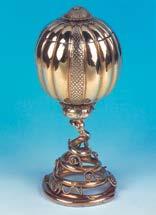
The earliest piece of hollowware in the collection is the silver gilt melon cup, London hallmarked for1563–4. There is some debate whether this cup has been in the hands of The Inner Temple at this time or acquired at a later date. On 1 May 1563 there is mention of a communion cup to be made for the church being co-funded by the Inner and Middle Temples, more about this later. Further, 4 days later on the 5 May 1563 it is again minuted as: ‘Order that Mr Warner’s money and 20li for the cup be recouped out of the debt owed by the society to Mr Fuller, late Treasurer….’ 20 li at the time would have been around £7,000 in today’s money and the question is would this have been enough money to make the melon cup? I believe it would, to make a similar cup today would cost around £7k to £10k using modern production techniques. I also believe a contemporary communion cup could have been made for considerably less than £20 at the time.
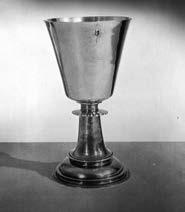
The first mention of the melon cup would appear to have been included in the inventory of 1703–4, with the entry ‘1. Gilt cup with cover’ – could this cup have possibly survived the Civil War in Inner Temple ownership when so much silver was lost? We just don’t know.

Some regard this as being a poppy-shaped cup, why would you wish to drink from a poppy when you can drink from a sweet melon? The cup to me represents a Cantaloupe melon, you will see the twisting stems shown in the spiralling base of the cup, also the shape of the cup body very much conforms to the fruit body. This variety of cantaloupe melon arrived in England in the mid-16th century and is mentioned in Hill’s ‘Art Garden’ of 1563. (He published under the unusual pseudonym of Mountain Didymus).
Contemporary Communion Chalice Melon and foliage Silver melon gilt cup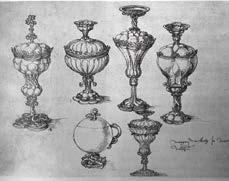
Further the cup bears the maker’s mark of Henry Watson, who employed European journeymen one of whom was Maurice van Myden. He would probably have brought his paten book with him illustrating similar sketches to those by Albrecht Durer of 1499. Van Myden might have made the cup to a very novel design at the time, but as a foreign worker would not have been allowed to register a maker’s mark at Goldsmiths Hall.
The final words might be left to the colloquial expression to cut the melon, to decide a question, illustrated by the exposed segment in the cup’s body showing the internal seeds, eminently suitable for the Inn.


In 1607 the Inner and Middle Temples jointly commissioned a gold cup as a gift to King James I of England and James VI of Scotland. This gift resulted in the two Inn’s receiving Letters Patent that granted the Temple lands in perpetuity.
Royal contact with The Inner Temple has been evident from the earliest times and perhaps not the earliest, but possibly the most important royal connection to the Inn is mentioned in the General Accounts Book for 1607–08. Here an object is described which it is believed no longer exists.
Apparently made by the Royal Goldsmith John Williams the passage records: “To the King’s goldsmith for half the cup which is to be provided to His Majesty £333 6s 8d.”
A subsequent entry for the next year states: “To the goldsmith for making a cup of gold which was given to the King with a velvet case, the one half £7 3s.”
The other half would have been paid by the Middle Temple.
My sketch of the cup described as a steeple cup, and this gold cup would have been a very large object. It is recorded that the cup weighed 200 and a half oz of gold. A large silver steeple cup of the period could stand 24 inches and weigh 60 oz, or so. Gold is twice as dense as silver so this cup would have been a third larger than a silver cup (100 silver oz equivalent), possibly 36 inches high.
The cup was given to James I in 1608 as a New Year’s gift and he is reported to have considered it one of his richest jewels, with the corresponding return of the Letters Patent. On the instructions of Charles I, it would appear that the gold cup was sent to Holland, possibly in 1629 with much other treasure, or it was accompanied by the rest of the
Crown Jewels and further royal treasure with the Queen and the Princess Royal in 1642, when they travelled to Holland to help secure a loan for the royalist cause in the Civil War. The Crown Jewels returned later to be eventually destroyed by Cromwell but it seems not the Temple cup. Still, it looks like a particularly good deal to have secured the Temple lands in this way.
In today’s money the £666 would equate to £330,000 for the cup’s manufacture. If we take the price of gold today, 200.5 oz will cost approximately £300,000; and if we say the cost to make the cup is £30,000, not so much has changed here in over 400 years, but the price of the Temple estate is certainly worth a great deal more.

A pair of silver gilt chalices being part of the plate belonging to the Temple Church. Each of the chalices are engraved with Latin inscriptions, one translated as being: “George Croke Armiger (bearer of arms, in fact he was knight) Treasurer of the Inner Temple and Nicholas Ouerburye Treasurer of the Middle Temple Anno Domini 1610”.
The other has a similar inscription but to the Middle Temple.
The general account book Vol II p 53 records: “1609 To Terry a goldsmith for two new communion cups for the Temple Church abating of exchange of one (possibly the communion cup of 1563 that I mentioned before), 13 li 12s 2d the Middle Temple paid one half 6li 16s 1d.”
If one cup cost £6 16s 1d in 1609 it seems most unlikely that the cup of 1563, at a cost of £20, was other than the melon cup.
Who was Terry? My view is that the pair of chalices were supplied by the shop-keeping goldsmith in Cheapside, John Terry hence the Terry in The Inner Temple records. The chalices, however, bear the maker’s mark of a monogram mark FT which was not a mark for Terry but for the actual working goldsmith who made the chalices, probably Thomas Francis.
It is remarkable that these silver gilt treasures belonging to the church survived the melting pot at the time of the Civil War; apparently, they were secured in a locked steel box in the church, so that they can still be used over 400 years after they were made. The altar cross and candlesticks used at that time in the Temple Church were less fortunate.
Two chalices Albrecht Durer Six Goblets
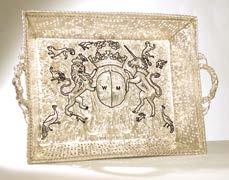
A silver layette basket purchased by the eminent criminal barrister Sir Edward Marshall Hall, from Tessiers Ltd, my old family firm, on 19 June 1925, was presented by five Benchers to Inn. By any standards this is an exceptional silver object, made in Holland in the Hague by Hans Coenraet Brechtel between November 1644 and November 1645. These baskets, usually made of wicker, were a customary gift to a pregnant woman in the later stages of her confinement.
The pierced and repoussé base is decorated with grapes, vines, birds, animals and a dominant central coat-of-arms with lion and unicorn supporters. The arms depicted here are of William II of Orange (1626–1650) and his wife Mary (1631–1660), eldest daughter of Charles I. Mary was born on 4 November 1631 and married William in London on 2 May 1641 at the age of 9. According to the marriage treaty, Mary was to remain in England until she had reached her twelfth year; her husband was to allow her £1,500 a year as pocket money. Turmoil in England caused Mary to be taken by her mother to Holland, somewhat earlier than expected, in 1642, probably with Temple gold cup. William, himself only fifteen at the time of the marriage, tried to sleep with his eleven-year-old bride in June 1643. This is noted in a diary called Gloria Parendi kept by William’s cousin, William Frederick, in contravention of his parent’s wishes, and was stopped just in time apparently by a ladyin-waiting. A second small marriage ceremony took place in The Hague in November 1643, on Mary’s twelfth birthday.
The pierced and repoussé base is decorated with grapes, vines, birds, animals and a dominant central coat-of-arms with lion and unicorn supporters.
It was not until 1644 that Mary was installed in her full conjugal position and was able to give audiences, receive foreign ambassadors and fulfil all the functions of the State. This she did with a gravity and decorum that was remarkable for her years. She was also celebrated for her grace, beauty and intelligence, but her ‘general education’ was described as defective, and she found difficulty in writing.
It is not possible to say precisely when William and Mary consummated their marriage; even in the summer of 1644 William had hardly any contact with his wife, treated her badly and had many lovers, amongst them the two daughters of Field Marshal Van Brederode. It is possible that the basket contained a message to apologise and encourage there to be a satisfactory union with the two young people.
If we consider in a brief form the two sides of the basket, his side on the left and hers on the right, in his lower quarter the weasel represents his unwelcome approach across from her collared squirrel, the virgin, the owl sits on the side of his lion’s head suggesting that he has wisely seen the light, the error of his ways, the crow talking through a wreath at the very top, represents an allegory of hope for victory. Whatever the message, the basket appears to have worked. Mary is reported to have had a miscarriage on 12 October 1647, and was definitely pregnant when her husband died of smallpox on 6 November 1650. She is reported to have rushed through the palace wailing and threw herself on his dead body only to be pulled away by concerned courtiers.
Eight days later she gave birth to a son who was christened as William and in 1689, after the Glorious Revolution of 1688, William became King William III of Great Britain.


The horn was blown before dinner at eleven and supper at six to call people to Hall, a practice that has now ceased but is remembered by some Benchers. Records from early times mention horns being purchased similar to the two shown here in 1621, 1630, and 1673. The Inn now has two silver capped horns. One, with silver mounts, was made by Thomas Phipps and Edward Robinson II in London in the 1780’s and engraved 1786; the other, larger, also with silver mounts is hallmarked London 1936–7 by an unknown maker WT and was given by Sir Frank MacKinnon.
Inner Temple horn calling had stopped in 1870 and Sir Frank campaigned to restore the practice in 1936. Because the head porter made such a poor sound with the 1780’s horn he commissioned another with a reeded mouthpiece to help the blower. You may be interested to know that the horn blower was entitled to a pint of beer after a performance.
Edward VIII Silver Mounted Horn – Engraved on end: “TheGift of Master Mackinnon” 1936 Antique Silver Mounted Horn – Thomas Phipps & Edward Robinson II c1785 Antique Dutch Silver Layette Basket by Hans Coenraet Brechtel, 1645

An inspection of the early volumes of the Calendar of Inner Temple Records gives many indications of the equipment needed for dining. There are mentions of the purchase and repair of silver spoons, ewers and bowls, also, supplies of food and linen. One of the records suggests that silver finger bowls, silver ewers and rose water basons were a necessary part of every well-kept cupboard of plate.
Up to the end of the 17th century, dining was a pretty messy business, the fork was only gradually introduced to Britain, from Italy, during the end of that century. The main eating utensil used before then was a knife for meat and a spoon for gravy, combined with the hand.
On the high table, the hands would have been washed at the beginning of the meal, sometimes before grace and at the end of the meal before the table was left. Those below the salt would wash their hands on entry and on leaving the Hall using side bowls. The Inn’s present head silverman, William Gallagher, tells me that the tradition of the youngest server tasting the water to ensure it was not poisoned has not happened in his time.
On Thursday 5 August 1661, Sir Heneage Finch, SolicitorGeneral, being Reader of the Inn, gave his feast in the ancient hall. To this feast the King was bidden, arriving in the royal barge from Whitehall accompanied by the Duke of York, the Lord Chancellor, various ministers of state, and a great number of the nobility Perhaps the ewer and basin used at this occasion was not quite important enough for the next royal visit in 1671. Sir Heneage, now Treasurer, wanted something a little grander. The King and the Duke again honoured the Treasurer with their presence on Candlemas Day, 2 February, on which occasion the Hall was again arranged for their reception, and a performance of The Committee, a comedy by Sir Robert Howard, was given for their entertainment by the players of the King’s House.
The large silver ewer and basin were made by Thomas Minshall in London and is hallmarked for 1670–1671. The basin has a diameter of 24” and weighs 119 oz. An interesting note, one of Minchall’s apprentices, John Clarke did not continue his career as a goldsmith, instead he became Keeper of the Lions at the Tower of London, which was the first menagerie in London. This was reported as being a more dangerous occupation compared to goldsmithing, the lions were known to maim or kill their keepers.
If this large ewer and basin were placed before the King at each end of the meal, with the generously engraved coat-ofarms surrounded by the elegant feathering plumage popular at the time, carved on the plain reflective silver surface, it would have been a most noticeable display of the Inn’s heraldry, status and wealth at the culmination of the feast and the royal visit.

The Pegasus salts might also have been found on the table. The Inner Temple Pegasus is first mentioned in records of the Christmas Revels of 1561. Robert Dudley helped resolve a land dispute between the Inner and Middle Temples; at the time he was the Queen Elizabeth I’s favourite, and it has been suggested, because he was also Master of the Queen’s Horse, that the choice of a Pegasus reflected his association with the Inn.
The Pegasus salts might also have been found on the table. The Inner Temple Pegasus is first mentioned in records of the Christmas Revels of 1561.
One of the most noticeable manifestations of the Pegasus is the realistically chased table saltcellars. Each of the 16 silver models are formed as a winged horse in flight supported at the front with a strut that forms part of the scrolling base. A removable shell salt dish is positioned between the wings. Made in the mid-19th century and all bearing London assay marks, one for 1849–50, eleven for 1850–51 and four for 1882–83, they were formed by the eminent silversmiths of the age, the Fox brothers, George and Charles. The family name was associated with silver manufacturing from circa 1801 in Old Street, in the City of London and then until 1921 in Soho, in the West End. It had not always been plain sailing for the silversmithing company and in the early years a petition for bankruptcy was made against the Fox family business, but the firm eventually flourished in Old Street until 1852, before moving to Soho. They made work for many of the leading London jewellers including my old firm, Tessiers Ltd in Bond Street, but principally for Lambert & Co of Coventry Street. The quality of their work was confirmed by the inclusion of articles made by them in the Great Exhibition of 1851.
Pegasus saltcellar Ewer and basin
We now move to modern times. Any dinner needs light, and the eminent silversmith Anthony Elson has given the Hall just that. He designed and made four candelabra for the millennium in 1999, four candelabra for the celebration of the 400 year’s charter granted by James I in 2008 and four candlesticks as a gift from Master John Deby in 2011.
The millennium candelabra each have stems formed as four supporting columns, symbolic of the Purbeck marble columns in the Temple Church, surmounted with interlocking Romanesque arches rising from a trumpet-shaped circular base, the four light branches of reverse ‘c’ scrolls with castellated drip pans, issuing from a central Pegasus standing upon a symbolic calyx of the conjunction of the planets Saturn and Jupiter; such a conjunction occurred on 28 May 2000. Before the 17th century, this event was widely supposed to herald apocalyptic changes. The most recent great conjunction occurred on 21 December 2020, Brexit occurred in January of that year.

The similar 400th anniversary of the Charter celebratory candelabra are made to a slightly smaller form, and they have a calyx of interlocking thistles and the candlesticks each have two demi-Pegasus rising from the bases. The general height of these lights makes for a more relaxed meal and enables cross table conversation.
There could be much more to add this evening, but time moves on. I hope you have enjoyed this talk whether your interest is historical, about silver or you just wished to see the new extensions to the Treasury Building.
Richard Parsons Silversmith and Jeweller
For the full video recording: innertemple.org.uk/treasures
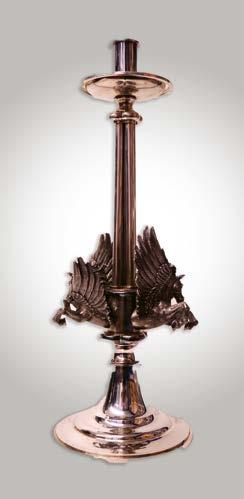 Millennium Candelabra
Millennium Candelabra


TIMELINE
By The Archivist1524
Thomas Audley, Baron Audley of Walden (1488–1544) was created a Bencher of The Inner Temple. He was the first member of the Inn to be appointed Lord Chancellor.
Audley was admitted to the Inn in 1514 and quickly ascended the political ladder as a loyal servant of Henry VIII, assisting him with his divorce from Catherine of Aragon and his separation from the Catholic Church. These moves eventually resulted in the establishment of the monarch as the Head of the English Church.
In 1524, Audley was elected as MP for Colchester where he became a strong supporter of Cardinal Wolsey. He was appointed Attorney General in 1526 and Speaker of the House of Commons in 1529. He was an enthusiastic advocate of Henry VIII’s anti-papal policies which ultimately abolished the papal jurisdiction in England. In 1531, he become Serjeantat-law and he was appointed King’s Serjeant and Lord Chancellor in 1533, in which role he prosecuted Anne Boleyn for her alleged adultery and was present on the scaffold of her execution. He led the cases against Bishop John Fisher and Sir Thomas More, both of whom were executed for refusing to repudiate papal supremacy.
In 1537, Audley condemned to death those who had participated in the Pilgrimage of Grace, a rebellion in the north of England where loyalties to the old Roman Catholic religion remained strong.
In 1541, he participated in the interrogation of Henry’s fifth wife, Catherine Howard, who was found guilty of adultery. She was executed in 1542.
He died in 1544. Thomas Fuller (Worthies of England, 1662) describes Audley and his black marble tomb in St Mary’s Church, Saffron Walden. “Not blacker than the soul, or harder than the heart, of the man whose bones lie beneath it”.
Audley’s renown as a man of few scruples grew after his death. His own words perhaps sum him up more succinctly: “If I had done nothing I had not been seen; if I had done much I had not been suffered”.

1624
The admission of John Winthrop the Younger (1606 – 1676) scientist, astrologer, alchemist, politician, physician and lawyer. He was the eldest son of the first Governor of Massachusetts, John Winthrop the Elder. He was the founder of New London in Connecticut and became Governor of the Connecticut Colony in 1657. Such was his popularity and strength of leadership he was re-elected every year until 1676.
Upon his arrival in Boston in 1631 he was elected as an Assistant to the Massachusetts Bay Colony. He established a settlement at Agawam, later renamed Ipswich, and he was subsequently commissioned to establish a colony on the banks of the Connecticut river which he named Saybrook.
The Massachusetts Bay Colony and Saybrook sided with the Narragansett and Mohegan in a war with the Pequots of eastern Connecticut in 1637, wiping out much of the tribe. Winthrop was given Fisher’s Island and he founded another settlement on the mainland which became New London.
The Connecticut colonies were founded during the interregnum and therefore lacked any official royal patronage or endorsement. John Winthrop travelled to England as the agent for the colony and obtained a Royal Charter in 1662 with the help of a network of royalist friends.
Winthrop founded the first ironworks in Massachusetts in 1633 and he experimented in the extraction of a salt from sea water by evaporation. His scientific curiosity was wideranging, and he became the first colonial member of the Royal Society in 1661. He presented his own papers on the subjects of maize, tar and pitch production and he arranged for many zoological specimens to be transferred to England from the New World for the interest of Charles II.
Winthrop also worked as a physician (largely self-taught) and devoted much time and energy to travelling around his colony and treating patients.
His enquiring mind rose to the stars, and he took delivery of a telescope measuring three feet and six inches. With this, he claimed to have viewed a fifth moon of Jupiter, a fact that was only definitively established in 1892 by Edward Barnard of the Lick Observatory.
John Winthrop the Younger died in 1676 and was buried beside his father in Boston.
 Thomas Audley (c.1488–1544), Lord Audley, 1569
Thomas Audley (c.1488–1544), Lord Audley, 1569
1724 Accounts
The Inn’s account and receipt books date back to the early 17th century and reveal the daily concerns of the Inn and necessary expenditure. One source of expense was the payment for the Temple foundlings, infants deposited at the Inn. The Benchers kindly undertook responsibility for their upkeep, employing wet nurses and arranging for their apprenticeship to local businesses at around the age of eight or nine years old. Many of these infants died in infancy and were buried in the churchyard. The register of baptism shows that in all 251 foundlings were baptised; 198 appear in the burial registers. The surname given to the infants was Temple or Templer.
ACCOUNT BOOK 1719–1724
Account of money paid and distributed to Treasurer and officer in the Treasureship of the Worshipful Francis Annesley Esq from the 18th day of November 1723 to the 18th day of November 1724.

Extracts from the rest of the year
July 9
Nov 14
the 5 Butlers their Bill for Board wages for the last 2 Vacations and half a years’ wage due to this 4 instant. Butlers at ladyday last
Paid Chief Butler a Quarter Sallary due then 7:10 and for candles for the staircase and additionall Watch one years ending this 4:10:4 and for the Newspapers for Easter and Trinity Term last 17:6 in all his tune of
Paid the Chief Butler a Quarter Sallary due at Michaelmas last 7:10 and 3:10 to allow him for his repairs of his Chambers his rents of the House in all the Sums of
Paid Eliz. Lucy widow towards the buryal of her Husband by Order of the Bench Table made this Day
Nov 16 Paid the washpott and Badge Porter for cleaning the back library one years due then
Nov 18 Paid Francis Annesley Esq. the payment due to him as Treasurer
Paid the Land Tax for this Society for the year 1723
Paid the tax Charged on this Society for the Old and New Duty in Houses for the year 1723
Paid Mr Horns Bricklayer his Bill in full ending 8 May last
Paid for Tipping and Engraving His House
Paid Mr Cook in full of a Bill for Joyners Work done at the Church being the Proposcion of this House.
From General Account receipt Book 1713–1724
A1824 ACT abolishing the transfer of enslaved people between the British colonies.
Sir Stephen Lushington, who served as Treasurer of the Inn in 1851, was a fervent abolitionist, famous for his role in ensuring the passage of the 1824 Slave Trade Act and the 1833 Bill abolishing slavery.
As a committed Whig and member of the Anti-Slavery Society he acted as the middleman between the government and the anti-slavery lobby. He was the first anti-slavery leader to advocate immediate rather than gradual abolition. This was agreed by the movement in 1832. His election as MP for Tower Hamlets allowed him to play a leading contribution in the abolition of slavery in 1833. Thomas Buxton and Lushington drafted an anti-slavery Bill proposing the complete abolition of slavery, but this was rejected in favour of the 1833 legislation that proposed an extensive system of compensation for slave owners. Lushington accepted this system as the only means of getting parliament to agree to abolition.
Lushington also devoted much energy to the question of capital punishment. He argued that the death penalty had no utility as a preventative measure as it caused reluctance among victims of crime, juries and judges to prosecute alleged offenders and led to irreversible errors in sentencing. He also believed that public executions “did debase, and lower, and brutalise the public morals, and the public mind”. After several failed attempts, Lushington and his allies secured the passage of the 1841 Punishment of Death Act which removed capital punishment for rape, embezzlement, forgery and the demolition of church property. It would take another 132 years before capital punishment was abolished in the United Kingdom.

1924
Dar Phar Hmee was admitted to the Inn on 25 January 1924 and became the first woman to practise as a barrister in Burma. She initially decided to become a lawyer in order to benefit the women of Burma, hoping that her attempt and intended success would serve as a role model for other women and inspire them to consider a career of public service.

Her reference for admission to the Inn was provided by the former Lieutenant Governor of Burma, Harvey Adamson: “Her family is well known and respected in Burma. Her father holds a position of trust in Rangoon Municipality. Dar Phar Hmee has come to England to study for the Bar, an enterprise which I believe no other Burmese lady has hitherto undertaken. From what I see and hear I am confident she is worthy of encouragement.”
She was called to the Bar on 17 November 1926. As one of two women to be called to the Bar, she attracted the attention of the press in London and even in Scotland. These interviews offer us an intriguing glimpse of London and of Londoners through the eyes of a young Burmese student:
“Never in my life had I seen people in such a hurry as those tearing down the streets of London. I thought that their haste must be due to some special attraction in the next street. In one of the busy streets of the West End I remember waiting five or ten minutes to cross the road and expecting the traffic to wait for me. Another of my difficulties was in understanding the language of the bus conductor who several times told me to ‘Ole tight’.”
Woman barrister from Burma, Dundee Courier, 10 December 1926
She also mentioned the dress of the typical British girl:
“They have none of the daintiness of our national costume, but of course our dress would be ridiculous here, for we wear skirts down to our ankles and we could not possibly run to catch buses and trains as British girls do.”
The Daily Telegraph, 18 November 1926

She admired:
“…the bearing of the British people, their erect bodies and even strides which show they have loved for generations long walks in the open air.”
The Daily Telegraph, 18 November 1926
She did not remain in London for long. On 10 December 1926, immediately following her Call to the Bar, she embarked for Rangoon and, in 1927, she became the first woman to be called to the Bar in Burma.
Eight years later, in February 1935, she made history again when she was appointed one of the first honorary female magistrates in Rangoon.
Dar Phar Hmee married U Myint Thein, who was also a barrister, and was called to the Bar by Lincoln’s Inn in 1925. He served as Chief Justice in Burma from 1957 to 1962, after some years of international work representing Burma in China and the UN.
Celia Pilkington Archivist Stephen Lushington by William Holman Hunt Top right: Daw Phwar Mhe
Creating unforgettable events

The traditional simplicity of the Hall and Bench Apartments provides the perfect backdrop for an array of events, from corporate dining and receptions to birthdays and weddings.
With bespoke packages designed around your event, you can choose rooms for morning, a ernoon, evening or weekend hire.
Standing events: Up to 400 guests
Taking all the stress away from you will be your dedicated event planner who will guide you every step of the way. All you need to do is sit back and enjoy whilst your vision comes to life.
020 7797 8230 | venuehire@innertemple.org.uk | innertemplevenuehire.co.uk
Seated events: Up to 250 guests

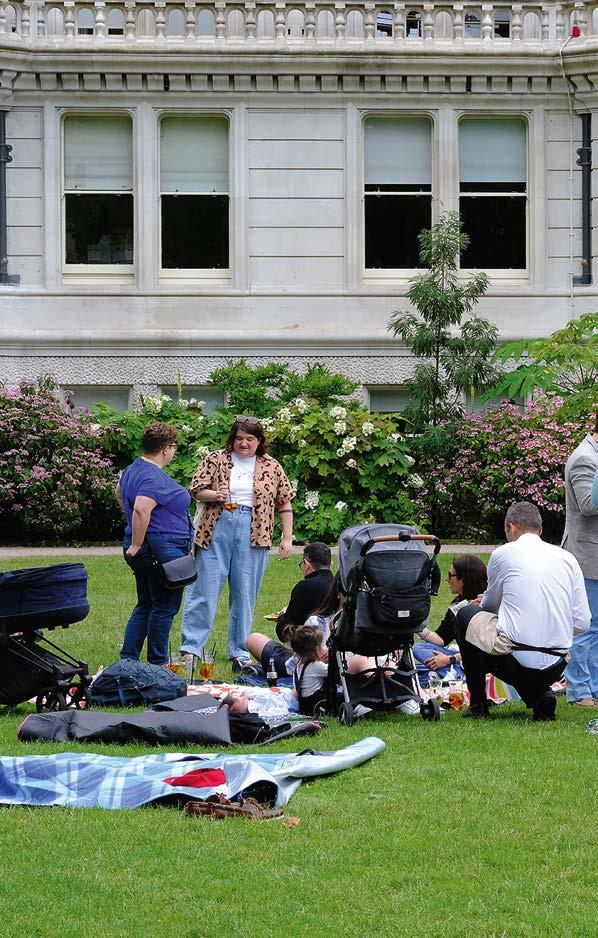
THE INNER TEMPLE BIG PICNIC
















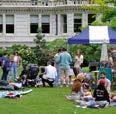



WEDDINGS AND BAPTISMS
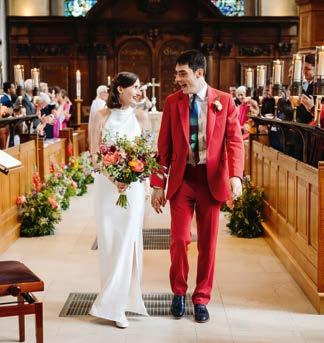


 Christopher Johnson and Hannah Stubbs 6 May 2023
© Carine Bea Photography
Caroline Cranley and Alex Arbuthnot, February 2023
Alice Hart and William Goss, 17 June 2023 © Caitlin&Jones
Christopher Johnson and Hannah Stubbs 6 May 2023
© Carine Bea Photography
Caroline Cranley and Alex Arbuthnot, February 2023
Alice Hart and William Goss, 17 June 2023 © Caitlin&Jones



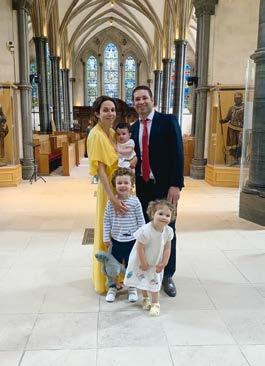
 Janette and Glenn Carrasco with baby India Lily, baptised on 23 April 2023
Clevenger family with baby Alice Lucy, baptised on 16 July 2023
Janette and Glenn Carrasco with baby India Lily, baptised on 23 April 2023
Clevenger family with baby Alice Lucy, baptised on 16 July 2023




 Suzanna and Sebastian Rose with baby Damien Rose, baptised on 16 July 2023
Kelly and Richard Padley at Thomas Daniel Padley’s Baptism, 6 November 2022
baptised on 16 October 2022
Suzanna and Sebastian Rose with baby Damien Rose, baptised on 16 July 2023
Kelly and Richard Padley at Thomas Daniel Padley’s Baptism, 6 November 2022
baptised on 16 October 2022
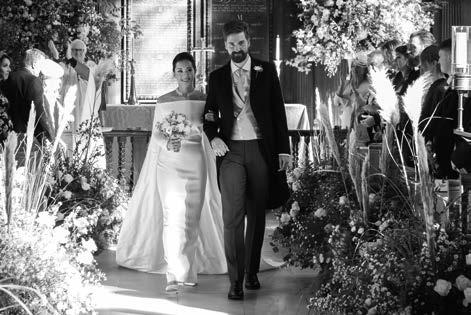
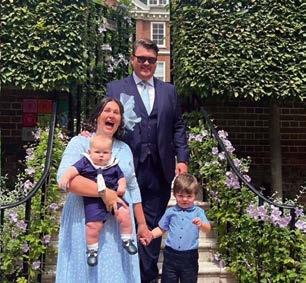
baptised on 16 July 2023


VIEW FROM THE CIRCUITS

As well as qualifying sessions arranged on Circuit by the Education & Training Department, the Treasurer is committed to hosting annual networking dinners for members on each Circuit.

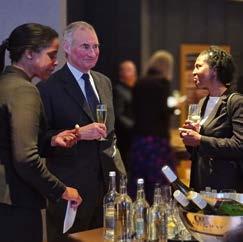


 Midland Circuit Dinner in Birmingham 2022
Wales and Chester Circuit Dinner in Cardiff 2022
Midland Circuit Dinner in Birmingham 2022
Wales and Chester Circuit Dinner in Cardiff 2022




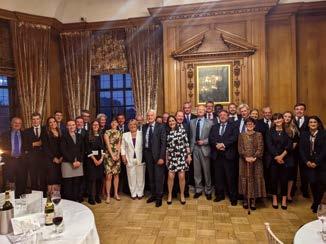

 North Eastern Circuit Dinner in York 2023
Northern Circuit Dinner Manchester 2023
North Eastern Circuit Dinner in York 2023
Northern Circuit Dinner Manchester 2023
BAR LIAISON COMMITTEE










































NEW SILKS 2023


























NEW MASTERS OF THE BENCH 2023–2024
Listed in order of Bencher status and by Call









MASTERS OF THE BENCH
The Honourable Society of the Inner Temple Masters of the Bench in Seniority Order Correct as of 1 August 2023
TREASURER 2023
Sir Robert Francis KC (O)
ROYAL BENCHER
HRH The Princess Royal KG KT GCVO QSO (R)
READER 2023
The Hon Mr Justice Soole (J)
READER ELECT 2023
Richard Salter Esq KC (B)
MASTERS OF THE BENCH, EX-TREASURERS
The Rt Hon Sir Stephen Brown GBE (U)
The Rt Hon the Baroness Butler-Sloss GBE (S)
The Rt Hon The Lord Lloyd of Berwick DL (S)
The Rt Hon Sir Konrad Schiemann (O)
The Rt Hon Sir John Chadwick (S)
The Rt Hon Sir Bernard Rix (O)
The Rt Hon Sir David Keene (S)
The Rt Hon Sir Anthony May (S)
Vivian Robinson Esq KC (S)
The Rt Hon The Baroness Hallett DBE (U)
Simon Thorley Esq KC (O)
The Rt Hon Sir Stephen Tomlinson (O)
The Rt Hon Sir Martin Moore-Bick (S)
His Honour Donald Cryan (Hon) LLD (O)
David Pittaway Esq KC (B)
The Rt Hon Dame Elizabeth Gloster DBE (O)
The Rt Hon Lord Hughes of Ombersley (O)
Guy Fetherstonhaugh Esq KC (B)
Her Honour Deborah Taylor (J)
MASTERS OF THE BENCH
John Willmer Esq KC (S)
The Rt Hon The Lord Woolf CH FBA (U)
Sir Oliver Popplewell (O)
The Rt Hon the Lord Mackay of Clashfern KT (H)
Professor Francis Reynolds DCL FBA KC (H)
Sir Michael Morland (O)
Nigel Inglis-Jones Esq KC (U)
The Rt Hon the Lord Scott of Foscote (S)
Sir Thomas Legg KCB KC (S)
Sir Allan Green KCB KC (U)
Neville Thomas Esq KC (U)
Sir Christopher Holland (S)
The Rt Hon the Lord Irvine of Lairg (S)
Her Honour Shirley Anwyl KC (S)
His Honour John Previte KC (U)
Richard Clegg Esq KC (U)
Michael Lyndon-Stanford Esq KC (U)
The Rt Hon Sir Jonathan Parker (S)
John Beveridge Esq KC (U)
His Honour Humphrey LLoyd KC (U)
Sir Edward Cazalet (S)
The Rt Hon Sir Mathew Thorpe (U)
William Crowther Esq KC (U)
Roger Henderson Esq KC (U)

His Honour Anthony Thompson KC (S)
Ian Hunter Esq KC (S)
Sir Peter North CBE DCL FBA KC (H)
Sir Martin Jacomb (H)
Patrick Ground Esq KC (B)
Professor Sir John Baker KC LLD FBA (H)
His Honour James Wadsworth KC (U)
Jules Sher Esq KC (U)
Sir Michael Tugendhat (U)
John Crowley Esq KC (S)
The Rt Hon Sir Stephen Sedley (U)
Her Excellency Dame Rosalyn
Higgins GBE KC JSD FBA (S)
Raymond Potter Esq CB (S)
Sir Sydney Lipworth KC (H)
The Rt Hon Lord Sumption OBE (S)
Dame Elizabeth Slade DBE (S)
The Rt Rev and Rt Hon Lord Carey of Clifton (H)
Sir Ivan Lawrence KC (B)
James Goudie Esq KC (S)
Christopher Lockhart-Mummery Esq KC (S)
Sir David Steel (U)
Neil Kaplan Esq CBE KC SC (HK) (S)
The Rt Hon Sir William Gage (S)
Paul Purnell Esq KC (U)
His Honour Jonathan Playford KC (S)
Sir Thayne Forbes (S)
Sir Brian Jenkins GBE (H)
The Baroness Mallalieu KC (U)
Anthony Anderson Esq KC (U)
Harry Turcan Esq (S)
Gerald Angel Esq (U)
The Rt Hon Sir Richard Buxton (U)
Professor Sir Royston Goode CBE KC FBA (H)
John Swift Esq KC (U)
His Honour James Stewart KC (U)
The Rt Hon The Lord Howard CH KC (U)
His Honour Jeremy Roberts KC (S)
Sir David Clarke (U)
Sir Neil Butterfield (S)
His Honour Michael Lawson (O)
The Reverend Roger ter Haar KC (S)
Stephen Bickford-Smith Esq (O)
Mrs Margaret Bickford-Smith KC (B)
The Rt Hon Sir Jeremy Sullivan (U)
The Rt Hon the Lord Wilson of Culworth (U)
Gerard Elias Esq CBE KC (S)
The Rt Hon Sir Jack Beatson FBA (O)
Anthony Hacking Esq KC (S)
Sir Hugh Bennett (O)
Dermod O’Brien Esq KC (S)
The Rt Hon Sir Anthony Hooper (U)
Bruce Mauleverer Esq KC (S)
His Honour Neil Butter CBE KC (S)
His Honour Duncan Matheson KC (U)
Her Honour Christian Bevington (S)
Miss Caroline Willbourne (B)
Her Honour Judge Hughes KC (J)
Michael Sayers Esq KC (U)
Sir Richard Henriques KC (S)
Martin Bowley Esq KC (O)
The Honourable Justice Stephen Breyer (H)
The Honourable Justice Anthony Kennedy (H)
Thomas Shields Esq KC (S)
Sir Mark Havelock-Allan Bt KC (O)
His Honour Simon Brown KC (U)
Jonathan Acton Davis Esq KC (B)
Anthony Temple Esq KC (O)
Richard Rampton Esq KC (S)
Sir Robert Owen KC (S)
Christopher Purchas Esq KC (U)
Miss Pamela Scriven KC (B)
Nicholas Padfield Esq KC (S)
The Rt Hon Sir Patrick Elias (S)
Michael Shorrock Esq KC (S)
Sir Gordon Langley (S)
Sir Christopher Pitchers (S)
Nigel Pascoe Esq KC (S)
Her Excellency Judge Korner CMG KC (J)
Oliver Sells Esq KC (B)
Kenneth Aylett Esq (S)
Andrew Tidbury Esq (B)
Sir Timothy Walker (U)
Nicholas Merriman Esq KC (U)
Robin De Wilde Esq KC (S)
Peter Birkett Esq KC (O)
Robin Purchas Esq KC (S)
Sir Geoffrey Nice KC (B)
Sir Frederick Crawford DL FR Eng (H)
Rt Hon The Baroness Deech DBE KC (Hon) (S)
Professor Sir Ian Kennedy KC FBA (H)
Sir Brian Keith KC (S)
Michael Spencer Esq KC (B)
Victor Temple Esq KC (S)
Sir Robert Akenhead (O)
Dame Caroline Swift DBE (S)
Justin Fenwick Esq KC (B)
Thomas Baxendale Esq (U)
Kevin de Haan Esq KC (S)
His Honour Jeffrey Burke KC (U)
Ian Glick Esq KC (B)
The Rt Hon the Lord Falconer of Thoroton (S)
The Rt Hon Jack Straw (S)
Judge Richard Posner (H)
Professor Andrew Ashworth PhD DCL FBA (A)
His Honour John Adams (S)
Robert Webb Esq KC FRAeS (B)
Nicholas Davidson Esq KC (B)
Miss Rosamund Horwood-Smart KC (O)
Stuart Brown Esq KC (S)
His Honour Judge Everall KC (O)
His Honour John Milford KC (U)
Stephen Solley Esq KC (O)
Dorian Lovell-Pank Esq KC (U)
The Hon Mr Justice Field (S)
Sir Hayden Phillips GCB DL (H)
His Honour Denis Orde (O)
The Rt Hon Sir John MacDermott (H)
Sir Jeffery Bowman FCA (H)
Justice Richard Goldstone (H)
His Honour Michael Fysh KC SC (S)
David Friedman Esq KC (S)
Nicholas Stewart Esq KC (S)
Timothy Raggatt Esq KC (S)
Dame Laura Cox DBE (U)
The Rt Hon Lady Black DBE (J)
Sir Richard Gibbs KC (U)
The Rt Hon The Lord Collins of Mapesbury LLD FBA (S)
The Rt Hon The Baroness Clark of Calton KC (S)
George Staple Esq CB KC (Hon) (H)
Michael de Navarro Esq KC (S)
Godfrey Carey Esq KC (S)
Rex Tedd Esq KC (B)
His Honour Toby Hooper KC (O)
Sir Raymond Jack (U)
His Honour David Hodson (U)
His Honour Richard McGregor-Johnson (S)
Dr Pehr Gyllenhammar (H)
Sir Alan Wilkie (S)
Peter Joyce Esq KC (S)
Christopher Moger Esq KC (S)
The Hon Philip Havers KC (B)
His Honour Iain Hughes KC (U)
Tim Charlton Esq KC (S)
The Rt Hon Lord Justice Floyd (J)
The Hon Mr Justice Patrick Chan (H)
Professor Sir Alan Dashwood KCMG CBE KC (S)
Nigel Pleming Esq KC (B)
His Honour Owen Davies KC (O)
Charles George Esq KC (U)
The Rt Hon the Lord Cullen of Whitekirk KT (H)
M Jean-Paul Costa (H)
His Honour Peter Collier KC (O)
Michael Redfern Esq KC (B)
Robert Smith Esq KC (S)
Andrew Trollope Esq KC (B)
Iain Milligan Esq KC (U)
Miss Elizabeth-Anne Gumbel KC (B)
John Marrin Esq KC (S)
Richard Drabble Esq KC (S)

Gavin Kealey Esq KC (B)
His Honour Gary Burrell KC (J)
The Rt Hon Sir Julian Flaux, Chancellor of the High Court (J)
Edward Fitzgerald Esq CBE KC (B)
His Honour Judge Melbourne Inman KC (J)
The Rt Hon Lord Justice Nicholas Green (J)
Sir Stuart Lipton (H)
Anthony Porten Esq KC (U)
His Honour Nicholas Browne KC (S)
His Honour Jeffrey Pegden KC (O)
David Wilby Esq KC (O)
The Hon Mr Justice Goss (J)
His Honour Judge Leonard KC (J)
The Hon Mrs Justice Alison Foster DBE (J)
Roger Stewart Esq KC (B)
The Hon Mr Justice Ribeiro (H)
Professor Christopher Forsyth KC (Hon) (A)
Dr Mads Andenas KC (Hon) PhD MA DPhil (A)
Professor John Spencer CBE KC (A)
The Rt Rev and Rt Hon Dr the Lord Williams of Oystermouth (H)
Malcolm Bishop Esq KC (B)
Mrs Gay Martin (O)
Philip Sapsford Esq KC (U)
His Honour Simon Bourne-Arton KC (O)
The Rt Hon Lord Justice Nugee (J)
Professor Dr Jürgen Schwarze (H)
His Honour David Paget KC (S)
Her Honour Elisabeth Fisher (S)
Sir Peter Openshaw (S)
His Honour Christopher Critchlow (S)
The Rt Hon the Lord Macdonald of River Glaven KC (O)
The Rt Hon Sir Dennis Byron (V)
Terence Coghlan Esq KC (S)
Andrew Caldecott Esq KC (B)
Jonathan Gaisman Esq KC (B)
The Rt Hon Lord Justice Popplewell (J)
The Hon Mr Justice Moor (J)
Sir Alex Allan KCB (H)
Sir Edward Caldwell KCB KC(Hon) (H)
Ian Laing Esq CBE DL (H)
Sir Ian McKellen CH CBE (H)
David Spens Esq KC (S)
His Honour Judge Ford KC (O)
His Honour Judge Hammerton (J)
His Honour Thomas Crowther KC (U)
His Honour Nicholas Coleman (O)
KEY
(B) Barrister Governing Bencher
(H) Honorary Bencher
(J) Judicial Governing Bencher
(A) Legal Academic
Sir Brian Williamson CBE (H)
The Rt Hon Lord Hamilton (H)
The Hon Justice Michael Kirby AC CMG (H)
Philip Mott Esq KC (U)
Thomas Seymour Esq (U)
Sir Nicholas Stadlen (S)
David Streatfeild-James Esq KC (B)
The Rt Hon Lord Justice Dingemans (J)
The Rt Hon Lady Justice Carr DBE (J)
Dr Mary Malecka (S)
The Reverend and Valiant Master of the Temple (H)
Adrian Brunner Esq KC (S)
Nicholas Asprey Esq (S)
Augustus Ullstein Esq KC (S)
John Ross Esq KC (B)
Professor Michael Lerego KC (O)
Jeremy Storey Esq KC (B)
James Turner Esq KC (B)
The Hon Mrs Justice Lang DBE (J)
The Hon Justice Salihu Moddibo Alfa Belgore (V)
His Honour Simon Davis (O)
The Hon Mrs Justice Arbuthnot (J)
His Excellency Kenneth Keith KBE KC (H)
Sir Wyn Williams (S)
The Rt Hon Lord Justice Moylan (J)
Robert Rhodes Esq KC (B)
His Honour David Tyzack KC (S)
Patrick Upward Esq KC (S)
His Honour Judge Melville KC (J)
Miss Sally Smith KC (O)
His Honour Judge Jeremy Richardson KC (J)
Nigel Giffin Esq KC (B)
The Hon Mr Justice Jonathan Swift (J)
Christopher Brougham Esq KC (S)
Nicholas Atkinson Esq KC (S)
Miss Susanna FitzGerald KC (B)
Orlando Pownall Esq KC (S)
The Rt Hon Lord Justice William Davis (J)
Richard Lissack Esq KC (B)
Abbas Lakha Esq KC (B)
Her Honour Frances Kirkham CBE (H)
The Rt Hon Lady Justice King DBE (J)
His Honour Ian Grainger (O)
Miss Margaret Bowron KC (B)
His Honour Nigel Seed KC (J)
Charles Gibson Esq KC (B)
The Rt Hon Lady Justice Simler DBE (J)
(O) Other Governing Bencher
(S) Senior Bencher
(U) Supernumerary Bencher
(V) Overseas Bencher

Stuart Catchpole Esq KC (B)
Iain Christie Esq KC (O)
His Honour Giles Forrester (S)
His Honour Gregory Stone KC (S)
Patrick O’Connor Esq KC (B)
James Corbett Esq KC (S)
His Honour Judge Bayliss KC (J)
Steven Kay Esq KC (B)
Sir David Green CB KC (B)
Peter Wright Esq KC (B)
Miss Deborah Eaton KC (B)
The Hon Mr Justice Lavender (J)
His Honour Charles Harris KC (O)
His Honour Judge Mark Brown (O)
The Rt Hon Dame Victoria Sharp DBE, President of the Queen’s Bench Division (J)
The Honourable Tan Sri Dato’
James Foong Cheng Yuen (V)
Guy Beringer Esq KC CBE (H)
His Honour Nigel Lithman Esq KC (J)
Her Honour Judge Hildyard KC (J)
Andrew Goodman Esq (B)
Grahame Aldous Esq KC (B)
Matthew Reeve Esq KC (B)
The Hon Mr Justice Russell Coleman (V)
His Eminence Cardinal Vincent Nichols MA MEd STL (H)
Michael Humphries Esq KC (B)
Her Honour Judge Levitt KC (J)
His Honour Stephen Oliver-Jones KC (S)
His Honour Charles Wide KC (U)
Sir Thomas Woodcock KCVO OStJ DL FSA (O)
Professor Barry Rider OBE (A)
The Hon Mrs Justice Juliet May DBE (J)
Professor Robert Walsh (A)
Judge David Baragwanath KNZM KC (V)
The Rt Hon Lord Justice Peter Jackson (J)
Miss Tracy Ayling KC (B)
The Hon Mr Justice Dove (J)
The Honourable Justice Iain Morley (V)
Dr Colin Ong KC (V)
Miss Helen Davies KC (B)
The Rt Hon Lord Bonomy LLD (H)
Judge Koen Lenaerts (H)
His Honour Simon Tonking (O)
Paul Bleasdale Esq KC (B)
Andrew Tait Esq KC (B)
Simon O’Toole Esq (B)
The Hon Mr Justice Cobb (J)
Sir Peter Caruana KCMG KC (V)
Dr Navinchandra Ramgoolam GCSK FRCP (V)
His Majesty King Jigme Khesar
Namgyel Wangchuck of Bhutan (H)
His Honour John Wait (S)
His Honour Philip Waller CBE (S)
The Rt Hon The Lord Maude of Horsham (O)
Michael Pooles Esq KC (B)
The Hon Mr Justice Martin Spencer (J)
Her Honour Patricia Lynch KC (S)
Miss Susan Jacklin (J)
Aftab Jafferjee Esq KC (B)
Richard Barraclough Esq KC (B)
Peter Village Esq KC (B)
Ian Stern Esq KC (B)
Miss Raquel Agnello KC (B)
Professor the Worshipful Mark Hill KC (B)
Ms Patricia Robertson KC (B)
Sam Stein Esq KC (B)
Professor Nicola Lacey CBE FBA (H)
The Rt Hon the Baroness Prashar CBE (H)
The Baroness Shackleton of Belgravia LVO (H)
Professor Timothy Endicott (A)
Professor Timothy Macklem (A)
Professor Julian Webb (A)
The Rt Hon Lord Reed (J)
His Honour Inigo Bing (O)
Charles Parsley Esq (B)
The Hon Mrs Justice Julia Dias (B)
The Hon Mrs Justice Finola O’Farrell DBE (J)
His Honour Judge Blair KC (J)
Alistair Schaff Esq KC (B)
His Honour Judge Neil Clark (J)
Harry Matovu Esq KC (B)
The Hon Mrs Justice Christina Lambert DBE (J)
Miss Taryn Lee KC (B)
Philip Moser Esq KC (B)
His Honour Judge Simon (J)
Alexander Hall Taylor Esq KC (B)
Professor Cheryl Thomas KC (Hon) (A)
John Griffith-Jones Esq (H)
Michael Payton Esq KC (Hon) (H)
Ms Libby Purves OBE (H)
Judge Paul Mahoney (V)
Chief Justice Sundaresh Menon (H)
Nigel Aiken Esq KC SC (V)
The Most Revd and Rt Hon Justin Welby (H)
Richard Benson Esq KC (S)
His Honour Roger Thomas KC DL (J)
Michael Burrows Esq KC (B)
Jonathan Laidlaw Esq KC (B)
Rory Phillips Esq KC (B)
The Hon Mr Justice Griffiths (J)
Sir Richard Heaton KCB (U)
His Honour Judge Hiddleston (J)
Tim Lord Esq KC (B)
Daniel Toledano Esq KC (B)
Miss Sarah Clarke KC (B)
The Hon Mr Justice Constable (J)
Dr Vanessa Davies (O)
The Rt Hon Lord Menzies (H)
The Chief Rabbi Ephraim Mirvis (H)
Lyonpo Sonam Tobgye (H)
Philip Punwar Esq (V)
Professor the Honourable
George Hampel AM KC (A)
His Excellency Elliott Belgrave
GCMG KA CHB KC (V)
The Hon Reginald Rhoda Esq CBE (V)
Datuk Sulong Matjeraie (V)
Dame Alison Saunders DCB (B)
Ami Feder Esq (B)
His Honour David Mitchell (S)
John Ryder Esq KC (B)
Mark Wyeth Esq KC (B)
Jeremy Hill-Baker Esq (B)
Crispin Aylett Esq KC (B)
Richard Humphreys Esq KC (B)
The Hon Mrs Justice Roberts DBE (J)
Miss Máirín Casey (O)
Miss Eleanor Laws KC (B)
Martin Goudie Esq KC (B)
Alastair Hodge Esq (B)
Graham Chapman Esq KC (B)
Ms Desiree Artesi (B)
Miss Fiona Jackson (B)
Andrew Cayley Esq CMG KC (B)
The Rt Hon The Lord Hunt Of Wirral MBE (H)
The Rt Hon The Lord Remnant CBE ACA (H)
The Rt Hon Sir Robert Buckland KBE KC MP (O)
Professor Spyridon Flogaitis (A)
Paul Infield Esq (B)
Miss Anne Richardson (B)
The Hon Simon Davenport KC (B)
Professor Leslie Thomas KC (B)
Miss Sara Lawson KC (B)
Christopher Quinlan Esq KC (B)
Miss Camilla Bingham KC (B)
Ms Anneliese Day KC (B)
Scott Matthewson Esq (B)
The Hon Mrs Justice Kelyn Bacon DBE (J)
Miss Rachel Spearing (B)
The Hon Mr Justice Nasir-Ul-Mulk (V)
The Rev Hugh Mead (H)
His Honour Jeremy Carey DL (O)
Her Honour Judge Louise Bancroft (J)
Her Honour Judge Corbett (J)
His Honour Judge The Reverend James Patrick (J)
Dr Anselmo Reyes (V)
The Rt Hon Michael Gove MP (H)
The Honourable Justice Ann Ainslie-Wallace (A)
The Hon Mr Justice MacDonald (J)
Christopher Sharp Esq KC (B)
His Honour Judge Tolson KC (J)
His Honour Judge Sloan KC (J)
His Honour Judge Robinson (J)
Thomas Kark Esq KC (B)
Her Honour Judge Munro KC (J)
Her Honour Judge Gillian Matthews KC (J)
Miss Ruth Henke KC (B)
David Wolfson Esq KC (B)
Paul Greaney Esq KC (B)
Dr Catherine MacKenzie (O)
Kieron Beal Esq KC (B)
Miss Saira Kabir Sheikh KC (B)
Justice George Wei (V)
Sir Timothy Le Cocq KC, The Baliff of Jersey (V)
Sir Michael Arthur KCMG (H)
Dr Tom Kinninmont (H)
Professor John Wass MA MD FRCP (H)
His Honour David Farrell KC (O)
His Honour Judge Aaronberg KC (J)
Lloyd Williams Esq KC (B)
Miss Penelope Reed KC (B)
His Honour Judge Lucraft KC (J)
Ian Winter Esq KC (B)
Adrian Keeling Esq KC (B)
Deputy Senior District Judge Ikram CBE (J)
Her Honour Judge Evans-Gordon (J)
Andrew Warnock Esq KC (B)
Thomas Mitcheson Esq KC (B)
Ms Harini Iyengar (B)
Ms Minka Braun (B)
The Hon Mr Justice Butler (V)
Professor Iyiola Solanke (A)
Edward Chandler Esq (H)
Ms Fiona Gilmore (H)
His Highness Tunku Besar Seri
Menanti Negeri Sembilan (H)
The Rt Hon Sir David Lidington KCB CBE (H)
The Hon Mr Justice Williams (J)
The Hon Mr Justice Choudhury (J)
The Hon Mr Justice Julian Knowles (J)
Professor Nigel Lowe KC (Hon) (S)
His Honour Judge Simon Phillips KC (J)
Miss Elizabeth McGrath KC (B)
Nicholas Griffin Esq KC (B)
Cyrus Larizadeh Esq KC (B)
Miss Leigh-Ann Mulcahy KC (B)
Dr Annette Prandzioch (O)
Patrick Goodall Esq KC (B)
Simon Baker Esq KC (B)
Ms Catherine Callaghan KC (B)
Peter Clark Esq (B)
Faisel Sadiq Esq (B)
Miss Hui Ling McCarthy KC (B)
Ms Kay Firth-Butterfield (V)
The Hon Mrs Justice Cutts DBE (J)
The Rt Hon Lady Dorrian (V)
Lawrence Teh Esq (V)
Professor Thom Brooks (A)
Michael Stevenson Esq (H)
The Rt Hon the Lord Fowler (H)
Miles Young Esq (H)
YA Dato Faizah Jamaludin (V)
The Rt Hon The Baroness Buscombe (O)
His Honour Judge Townsend (J)
His Honour Judge Oliver (J)
Ms Alix Beldam KC (Hon) (O)
His Honour Judge Menary KC (J)
Her Honour Judge Nicholls (J)
Miss Lorna Meyer KC (B)
District Judge Foster (J)
Kyri Argyropoulos Esq (B)
Dr Paul Brown KC (B)
Her Honour Judge Clemitson (J)
His Honour Judge Bird (J)
Upper Tribunal Judge Frances (J)
His Honour Judge Saxby KC (J)
Benjamin Myers Esq KC (B)
Jason Sugarman Esq KC (B)
John Kimbell Esq KC (B)
His Honour Judge Petts (J)
Rhys Taylor Esq (B)

Charles Bagot Esq KC (B)
Carsten Zatschler Esq (B)
Miss Diya Sen Gupta KC (B)
Joseph Hart Esq (B)
Miss Elizabeth Fitzgerald (B)
Miss Sonia Nolten KC (B)
Miss Rehana Azib KC (B)
District Judge Prest KC (J)
Dr Tunde Okewale MBE (B)
Ms Kathryn Arnot Drummond (B)
Justice Vinodh Coomaraswamy (V)
Professor James Goudkamp (A)
The Hon Alexander Downer AC (A)
Christopher Hayward Esq (H)
The Rt Rev James Jones KBE (H)
Dr Nikki Lack (A)
Kannon Shanmugam Esq (H)
The Hon Mrs Justice Eady DBE (J)
The Hon Mr Justice Andrew Henshaw (J)
Dr Adam Scott OBE TD (O)
Upper Tribunal Judge Jacobs (J)
Martin Bowdery Esq KC (B)
Andrew Oldland Esq KC (B)
Teertha Gupta Esq KC (B)
Simon Kealey Esq KC (B)
Thomas Cosgrove Esq KC (B)
Robin Sellers Esq (B)
Miss Kate Brunner KC (B)
Nicholas Craig Esq KC (B)
Ms Ruby Sayed (B)
James Kitching Esq (B)
Craig Hassall Esq KC (B)
District Judge Heptonstall (J)
Professor Rebecca Bailey-Harris (B)
Jonathan Rees Esq KC (B)
Miss Rebecca Dix (B)
Miss Bibi Badejo (B)
Jonathan Bremner Esq KC (B)
Ms Leonie Hirst (B)
Miss Jennifer Oborne (B)
Alderman Gregory Jones KC (B)
Dr Shazia Choudhry (A)
Professor Dimitrios Giannoulopoulos (A)
The Rt Hon The Baroness Amos PC CH (H)
Professor Rachael Field (A)
Her Honour Judge Hampel AM SC (A)
The Reverend Mark Hatcher (H)
Ms Elizabeth Howe OBE (H)
Thomas Leighton Esq (H)
Her Honour Anne Molyneux MBE (H)
His Honour Judge Teague KC (J)
Jonathan Waite Esq KC (O)
The Hon Mr Justice Eyre (J)
Her Honour Judge Wigin (J)
Simon Mallett Esq (B)
KEY
(B) Barrister Governing Bencher (H) Honorary Bencher
(J) Judicial Governing Bencher (LA) Legal Academic
Miss Karon Monaghan KC (B)
Miss Barbara Mills KC (B)
Her Honour Judge Anupama Thompson (J)
Tom Weisselberg Esq KC (B)
Her Honour Judge Leigh (J)
Mr Zachary Bredemear (B)
David Temkin Esq KC (B)
Richard Honey Esq KC (B)
Miss Joanne Cecil (B)
David Wood Esq (B)
Christopher Bond Esq (B)
Miss Thea Wilson (B)
Ms Saoirse Cowley (B)
The Honourable Justice Glenna
Thompson JSC (V)
Mrs Johanna Higgins (V)
Professor Judith Bourne Ph.D. (A)
Dr Augustus Casely-Hayford OBE (H)
Professor Norman Doe (A)
Paul Manduca MoM (H)
Sir Kenneth Olisa OBE FRSA FBCS, HM
Lord-Lieutenant of Greater London (H)
Lemn Sissay Esq OBE MBE (H)
The Hon Mrs Justice Hill DBE (J)
His Honour Judge Dennis Watson KC (J)
Miss Caroline Goodwin KC (B)
Miss Christine Agnew KC (B)
Her Honour Judge Spiro (J)
Judge Mark Sutherland Williams (J)
Miss Heidi Stonecliffe KC (B)
Ms Samantha Hillas KC (B)
Miss Sophie Cartwright KC (B)
His Honour Judge Payne (J)
Dr Oliver Lewis (B)
His Honour Judge Lazarus (J)
John Mehrzad Esq KC (B)
Thom Dyke Esq (B)
Austin Stoton Esq (B)
Miss Fallon Alexis (B)
Ms Rehana Popal (B)
Justice Adrian Saunders (H)
Ms Nazhat Shameem Khan (V)
Justice Ketanji Brown Jackson (H)
Dame Karen Pierce DCMG (H)
The Hon Mr Justice Ritchie (J)
Raymond Tully Esq KC (B)
Stephen Simblet Esq KC (B)
Miss Catherine Heyworth KC (B)
Malek Wan Daud Esq (B)
Selvaraju Ramasamy Esq KC (B)
John McKendrick Esq KC (B)
Simon Gurney Esq (B)
Ryan Kohli Esq (B)
Miss Lisa Wilson (B)
(O) Other Governing Bencher (S) Senior Bencher
(U) Supernumerary Bencher (V) Overseas Bencher
PEOPLE FINDER
TREASURY
Sub-Treasurer
Head of the Sub-Treasurer’s Office
Personal Assistant to the Sub-Treasurer
Director of the Treasury Office

Greg Dorey CVO
Jennie Collis Price
Wanda Szwed
Henrietta Amodio
Assistant to the Director of the Treasury Office Nadia Ruiz
Membership Registrar and Data Protection Lead
Jude Hodgson
enquiries@innertemple.org.uk
020 7797 8177 subtreasurer@innertemple.org.uk
020 7797 8177 jcollisprice@innertemple.org.uk
020 7797 8179 wszwed@innertemple.org.uk
020 7797 8182 hamodio@innertemple.org.uk
020 7797 8182 nruiz@innertemple.org.uk
020 7797 8206 jhodgson@innertemple.org.uk
Records and Membership Assistant Jacqueline Fenton 020
jfenton@innertemple.org.uk
Member Events and Administration Manager Kate Peters 020 7797 8183 kpeters@innertemple.org.uk
Member Events and Administration Assistant Rosy Humphrey 020 7797 8264 rhumphrey@innertemple.org.uk Communications & Social Media
Reception Supervisor –evening (main entrance)
Director of Education Gail Fleming
Education Programmes Manager (Pre-Pupillage)
kkhetoo@innertemple.org.uk
mkkhan@innertemple.org.uk
gfleming@innertemple.org.uk
Julia Armfield 020 7797 8207 jarmfield@innertemple.org.uk
Regional Education Officer Kerry Upham 020 7797 8189 kupham@innertemple.org.uk
Education Programmes Manager (Pupils & New Practitioners)
Education Co-ordinator Mercy Quaynor
Education Programme Manager (Established Practitioners) David Miller
Education Operations and Projects Manager Richard Loveridge
Education Engagement Co-ordinator Tiffany-Rochelle Louis-Byfield
Widening Access Manager Stephanie Baughen
mquaynor@innertemple.org.uk
dmiller@innertemple.org.uk
rloveridge@innertemple.org.uk
tlouis-byfield@innertemple.org.uk
sbaughen@innertemple.org.uk
jbrown@innertemple.org.uk
geveratt@innertemple.org.uk
shussain@innertemple.org.uk
SURVEYOR’S DEPARTMENT
Director of Properties and Surveyor
Facilities Manager
Office Manager (Job Share)
Estates Officer
Mechanical and Electrical Engineer
Works Supervisor
Facilities Foreman
Electrical Supervisor

Richard Snowdon
Lukas Jelinek
Rene Hicks
020 7797 8200
surveyors@innertemple.org.uk
020 7797 8203 rsnowdon@innertemple.org.uk
020 7797 8199 ljelinek@innertemple.org.uk
020 7797 8173 rhicks@innertemple.org.uk and Anne Mason
Albena Ahjem
Darren Readings
Paul Simmonds
020 7797 8200 amason@innertemple.org.uk
020 7797 8202 aahjem@innertemple.org.uk
020 7797 8198 dreadings@innertemple.org.uk
020 7797 8190 psimmonds@innertemple.org.uk
Delbert Brooks (Julius Rutherfoord) 020 7797 8195 dbrooks@innertemple.org.uk
Ian Ward
Plumbing and Mechanical Supervisor Tony Baca
Carpentry Supervisor
CATERING
Head of Catering
Steve Hanks
Vicky Portinari
020 7797 8197 iward@innertemple.org.uk
020 7797 8196 tbaca@innertemple.org.uk
020 7797 8239 shanks@innertemple.org.uk
020 7797 8230 catering@innertemple.org.uk
020 7797 8231 vportinari@innertemple.org.uk
8233 ppatel@innertemple.org.uk Executive Head Chef
rlamb@innertemple.org.uk
mreynolds@innertemple.org.uk

CHAIRS OF BENCH COMMITTEES & SUB-COMMITTEES
EXECUTIVE COMMITTEE
Master Treasurer
ADVOCACY TRAINING COMMITTEE
Master Adam Constable
ARCHIVES COMMITTEE
Master Julia Dias
BENCHER NOMINATION COMMITTEE
Master Reader
COMMUNICATIONS SUB-COMMITTEE
Master Tom Mitcheson
EDUCATION & TRAINING COMMITTEE
Master Juliet May
EMPLOYED BAR FORUM
Master Sara Lawson
EQUALITY, DIVERSITY & INCLUSIVITY SUB-COMMITTEE
Master Leslie Thomas
ESTATES COMMITTEE
Master Roger Stewart
FINANCE SUB-COMMITTEE
Master Sonia Nolten (Senior Bench Auditor)
INNS OF COURT ALLIANCE FOR WOMEN
Master Leigh-Ann Mulcahy (Co-Convenor)
INTERNATIONAL COMMITTEE
Master Kieron Beal
INVESTMENT SUB-COMMITTEE
Master Matthew Reeve
LIBRARY COMMITTEE
Master Sally Smith
PEGASUS SCHOLARSHIP TRUST
Master Martin Goudie
QUALIFYING SESSIONS COMMITTEE
Master Rory Phillips
SCHOLARSHIPS & OUTREACH COMMITTEE
Master Fiona Jackson
STUDENT ENGAGEMENT & SUPPORT COMMITTEE
Master Saira Kabir Sheikh
TREASURER NOMINATION COMMITTEE
Master Deborah Taylor
MASTERS OF THE CIRCUITS & ASSISTANT MASTERS
European:
Master Joanna Korner
Master Kieron Beal
Midland:
Master Paul Bleasdale
Master Elizabeth McGrath
Northern Circuit:
Master Joseph Hart
Master Nigel Bird
Master Samantha Hillas
North Eastern Circuit:
Master Neil Clark
Master Anne Richardson
Master Gillian Matthews
South Eastern:
Master Kathryn Arnot Drummond
Master Fiona Jackson
Master Christine Agnew
Wales & Chester:
Master Timothy Petts
Master Rhys Taylor
Master Jonathan Rees
Western:
Master Christopher Quinlan
Master James Patrick
Master James Townsend
TEMPLE CHURCH COMMITTEE
Chair, Middle Temple Bencher
Andrew Spink KC
Treasurer
Master Simon O’Toole
MARSHALL HALL TRUST
Master Jonathan Waite
TEMPLE MUSIC FOUNDATION
Master Guy Beringer
INNER TEMPLE REPRESENTATIVES ON EXTERNAL BODIES
BAR COUNCIL
Master Saira Kabir Sheikh
Master Minka Braun
Simon Atkinson (BLC Rep)
BARRISTERS’ BENEVOLENT ASSOCIATION
Master Daniel Toledano
BAR TRIBUNALS & ADJUDICATION SERVICE TRIBUNAL APPOINTMENTS BODY
Master Ingrid Simler (Chair)
Master Julia Dias
Master Ruby Sayed
COUNCIL OF THE INNS OF COURT
Master Nicholas Green (President)
Master Jill Frances (Sub-Treasurer)
COIC MATCHED FUNDED PUPILLAGE SCHEME
Master Pamela Scriven
INNS’ STRATEGIC ADVISORY GROUP
Master Treasurer
Master Reader
Master Jill Frances
Sub-Treasurer
INCORPORATED COUNCIL OF LAW REPORTING
Master Margaret Bowron
Master Mary Malecka
INNS OF COURT AND BAR EDUCATIONAL TRUST
Master Martin Griffiths
INNS OF COURT COLLEGE OF ADVOCACY
Master Adam Constable (Inner Temple Governor)
Master Catherine MacKenzie (Academic Governor)
INNS OF COURT LIBRARIES LIAISON COMMITTEE
Master Sally Smith
INSTITUTE OF ADVANCED LEGAL STUDIES (IALS)
Master Mark Havelock-Allan
SELDEN SOCIETY
Master Donald Cryan









